SCHEDULES
F296first schedule ORDINARY CAUSE RULES 1993
F296Initiation andprogress of causes
CHAPTER 1CITATION, INTERPRETATION, REPRESENTATION AND FORMS
1 Citation
These Rules may be cited as the Ordinary Cause Rules 1993.
1 Interpretation
1
In these Rules, unless the context otherwise requires—
“document” has the meaning assigned to it in section 9 of the M1Civil Evidence (Scotland) Act 1988;
“period of notice” means the period determined under rule 3.6 (period of notice after citation).
2
For the purposes of these Rules—
a
“affidavit” includes an affirmation and a statutory or other declaration; and
b
an affidavit shall be sworn or affirmed before a notary public or any other competent authority.
3
Where a provision in these Rules requires a party to intimate or send a document to another party, it shall be sufficient compliance with that provision if the document is intimated or sent to the solicitor acting in the cause for that party.
4
Unless the context otherwise requires, anything done or required to be done under a provision in these Rules by a party may be done by the agent for that party acting on his behalf.
5
Unless the context otherwise requires, a reference to a specified Chapter, Part, rule or form, is a reference to the Chapter, Part, rule or form in Appendix 1, so specified in these Rules; and a reference to a specified paragraph, sub-paragraph or head is a reference to that paragraph of the rule or form, that sub-paragraph of that paragraph or that head of that sub-paragraph, in which the reference occurs.
1 Representation
1
Subject to paragraph (2), a party to any proceedings arising solely under the provisions of the M2Debtors (Scotland) Act 1987 shall be entitled to be represented by a person other than a solicitor or an advocate provided that the sheriff is satisfied that such person is a suitable representative and is duly authorised to represent that party.
2
Paragraph (1) shall not apply to an appeal to the sheriff principal.
1 Forms
Where there is a reference to the use of a form in these Rules, that form in Appendix 1 or Appendix 2, as the case may be, to these Rules, or a form substantially to the same effect, shall be used with such variation as circumstances may require.
CHAPTER 2RELIEF FROM COMPLIANCE WITH RULES
2 Relief from failure to comply with rules
1
The sheriff may relieve a party from the consequences of failure to comply with a provision in these Rules which is shown to be due to mistake, oversight or other excusable cause, on such conditions as he thinks fit.
2
Where the sheriff relieves a party from the consequences of a failure to comply with a provision in these Rules under paragraph (1), he may make such order as he thinks fit to enable the cause to proceed as if the failure to comply with the provision had not occurred.
CHAPTER 3COMMENCEMENT OF CAUSES
3 Form of initial writ
F11
A cause shall be commenced–
a
in the case of an ordinary cause, by initial writ in Form G1; or
b
in the case of a commercial action within the meaning of Chapter 40, by initial writ in Form G1A.
2
The initial writ shall be written, typed or printed on A4 size paper of durable quality and shall not be backed or folded.
3
4
Where the pursuer has reason to believe that proceedings are pending before another court involving the same cause of action and between the same parties as those named in the instance of the initial writ, the F3initial writ shall contain details of those proceedings.
5
An article of condescendence shall be included in the F3initial writ averring—
a
the ground of jurisdiction; and
b
the facts upon which the ground of jurisdiction is based.
6
Where the residence, registered office or place of business, as the case may be, of the defender is not known and cannot reasonably be ascertained, the pursuer shall set out in the instance that the whereabouts of the defender are not known and aver in the condescendence what steps have been taken to ascertain his present whereabouts.
7
The initial writ shall be signed by the pursuer or his solicitor (if any) and the name and address of that solicitor shall be stated on the back of every service copy of that writ.
3 Actions relating to heritable property
1
In an action relating to heritable property, it shall not be necessary to call as a defender any person by reason only of any interest he may have as the holder of a heritable security over the heritable property.
2
Intimation of such an action shall be made to the holder of the heritable security referred to in paragraph (1)—
a
where the action relates to any heritable right or title; and
b
in any other case, where the sheriff so orders.
F43
In an action falling within section 1(1)(b) or (c) of the Mortgage Rights (Scotland) Act 2001 M3, the initial writ shall include averments about those persons who appear to the pursuer to be entitled to apply for an order under section 2 of that Act and such persons shall, so far as known to the pursuer, be called as defenders for their interest.
3 Warrants of citation
1
The warrant of citation in any cause other than—
a
a family action within the meaning of rule 33.1(1),
b
an action of multiplepoinding,
c
an action in which a time to pay direction under the Debtors (Scotland) Act 1987 may be applied for by the defender,
F5d
an action to which rule 3.2(3) applies,
shall be in F6Form O1.
2
In a cause in which a time to pay direction under the Debtors (Scotland) Act 1987 may be applied for the defender, the warrant of citation shall be in F6Form O2.
3
F74
In an action to which rule 3.2(3) applies, the warrant of citation shall be in Form O2A.
3 Warrants for arrestment to found jurisdiction
1
Where an application for a warrant for arrestment to found jurisdiction may be made, it shall be made in the crave of the F8initial writ.
2
Averments to justify the granting of such a warrant shall be included in the condescendence.
3 Warrants and precepts for arrestment on dependence
1
A copy of—
a
an initial writ with warrant to cite which includes a warrant to arrest on the dependence,
b
defences which include, or a minute of amendment which includes, a counterclaim with warrant granted to arrest on the dependence endorsed on that writ,
certified as a true copy by the pursuer or defender, as the case may be, or his solicitor, shall be sufficient warrant to arrest on the dependence if it is otherwise competent to do so.
2
A precept of arrestment may be issued by the sheriff clerk on production to him of—
a
an initial writ containing a crave for payment of money on which a warrant of citation has been issued;
b
defences which include, or a minute of amendment which includes, a counterclaim containing a crave for payment of money; or
c
a document of liquid debt.
3 Period of notice after citation
1
Subject to rule 5.6(1) (service where address of person is not known) and to paragraph (2) of this rule, a cause shall proceed after one of the following periods of notice has been given to the defender:—
a
where the defender is resident or has a place of business within Europe, 21 days after the date of execution of service; or
b
where the defender is resident or has a place of business outside Europe, 42 days after the date of execution of service.
2
Subject to paragraph (3), the sheriff may, on cause shown, shorten or extend the period of notice on such conditions as to the method or manner of service as he thinks fit.
3
A period of notice may not be reduced to a period of less than 2 days.
4
Where a period of notice expires on a Saturday, Sunday, or public or court holiday, the period of notice shall be deemed to expire on the next day on which the sheriff clerk’s office is open for civil court business.
CHAPTER 4CAVEATS
4 Orders against which caveats may be lodged
A person may lodge a caveat against—
a
an interim interdict sought in an action before he has lodged a notice of intention to defend; or
b
an interim order (other than an order under section 1 of the M84Administration of Justice (Scotland) Act 1972(orders for inspection of documents and other property, etc.)) sought before the expiry of the period within which he could lodge a notice of intention to defend.
4 Form lodging and renewal of caveats
1
A caveat shall be in Form G2 and shall be lodged with the sheriff clerk.
2
A caveat shall remain in force for a period of one year from the date on which it was lodged and may be renewed on its expiry for a further period of one year and yearly thereafter.
3
Where a caveat has been lodged and has not expired, no order in respect of which the caveat was lodged may be pronounced unless the sheriff is satisfied that all reasonable steps have been taken to afford the person lodging the caveat an opportunity of being heard; and the sheriff may continue the hearing on such an order until he is satisfied that such steps have been taken.
CHAPTER 5CITATION, SERVICE AND INTIMATION
5 Signature of warrants
1
Subject to paragraph (2), a warrant for citation, intimation or arrestment on the dependence may be signed by the sheriff or sheriff clerk.
2
The following warrants shall be signed by the sheriff:—
a
a warrant containing an order shortening or extending the period of notice or any other order other than a warrant which the sheriff clerk may sign;
b
a warrant for arrestment on the dependence in a family action within the meaning of rule 33.1(1) in respect of a claim to which section 19 of the M85Family Law (Scotland) Act 1985 (arrestment in action for aliment or claim for financial provision) applies; and
c
a warrant for intimation ordered under rule 33.8 (intimation where improper association).
3
Where the sheriff clerk refuses to sign a warrant which he may sign, the party presenting the initial writ may apply to the sheriff for the warrant.
5 Form of citation and certificate
1
Subject to rule 5.6 (service where address of person is not known), in any cause other than—
a
a family action within the meaning of rule 33.1(1),
b
an action of multiplepoinding, F9. . .
c
an action in which a time to pay direction under the Debtors (Scotland) Act 1987 may be applied for by the defender, F10or
F11d
an action to which rule 3.2(3) applies,
2
In a cause in which a time to pay direction under the Debtors (Scotland) Act 1987 may be applied for by the defender, citation shall be in Form O5 which shall be attached to a copy of the initial writ and warrant of citation and shall have appended to it a notice of intention to defend in Form O7.
F142A
In an action to which rule 3.2(3) applies, citation shall be in Form O5A which shall be attached to a copy of the initial writ and warrant of citation and shall have appended to it a notice of intention to defend in Form O7.
3
The certificate of citation in any cause other than a family action within the meaning of rule 33.1(1) or an action of multiplepoinding shall be in Form O6 which shall be attached to the initial writ.
4
Where citation is by a sheriff officer, one witness shall be sufficient for the execution of citation.
5
Where citation is by a sheriff officer, the certificate of citation shall be signed by the sheriff officer and the witness and shall state—
a
the method of citation; and
b
where the method of citation was other than personal or postal citation, the full name and designation of any person to whom the citation was delivered.
6
Where citation is executed under paragraph 3 of rule 5.4 (depositing or affixing by sheriff officer), the certificate shall include a statement—
a
of the method of service previously attempted;
b
of the circumstances which prevented such service being executed; and
c
that a copy was sent in accordance with the provisions of paragraph (4) of that rule.
5 Postal service or intimation
1
In any cause in which service or intimation of any document or citation of any person may be by recorded delivery, such service, intimation or citation shall be by the first class recorded delivery service.
2
Notwithstanding the terms of section 4(2) of the M4Citation Amendment (Scotland) Act 1882 (time from which period of notice reckoned), where service or intimation is by post, the period of notice shall run from the beginning of the day after the date of posting.
3
On the face of the envelope used for postal service or intimation under this rule there shall be written or printed the following notice:—
“This envelope contains a citation to or intimation from (specify the court). If delivery cannot be made at the address shown it is to be returned immediately to:- The Sheriff Clerk (insert address of sheriff clerk’s office).”
5 Service within Scotland by sheriff officer
1
An initial writ, decree, charge, warrant or any other order or writ following upon such initial writ or decree served by a sheriff officer on any person shall be served—
a
personally; or
b
by being left in the hands of a resident at the person’s dwelling place or an employee at his place of business.
2
Where service is executed under paragraph (1)(b), the certificate of citation or service shall contain the full name and designation of any person in whose hands the intial writ, decree, charge, warrant or other order or writ, as the case may be, was left.
3
Where a sheriff officer has been unsuccessful in executing service in accordance with paragraph (1), he may, after making diligent enquiries, serve the document in question—
a
by depositing it in that person’s dwelling place or place of business; or
b
by affixing it to the door of that person’s dwelling place or place of business.
4
Subject to rule 6.1 (service of schedule of arrestment), where service is executed under paragraph (3), the sheriff officer shall, as soon as possible after such service, send a letter containing a copy of the document by ordinary first class post to the address at which he thinks it most likely that the person on whom service has been executed may be found.
F155
Where the firm which employs the sheriff officer has in its possession–
a
the document or a copy of it certified as correct by the pursuer’s solicitor, the sheriff officer may serve the document upon the defender without having the document or certified copy in his possession, in which case he shall if required to do so by the person on whom service is executed and within a reasonable time of being so required, show the document or certified copy to the person; or
b
a certified copy of the interlocutor pronounced allowing service of the document, the sheriff officer may serve the document without having in his possession the certified copy interlocutor if he has in his possession a facsimile copy of the certified copy interlocutor (which he shall show, if required, to the person on whom service is executed).
5 Service on persons furth of Scotland
1
Subject to the following provisions of this rule, an initial writ, decree, charge, warrant or any other order or writ following upon such initial writ or decree served on a person furth of Scotland shall be served—
a
at a known residence or place of business in England, Wales, Northern Ireland, the Isle of Man, the Channel Islands or any country with which the United Kingdom does not have a convention providing for service of writs in that country—
i
in accordance with the rules for personal service under the domestic law of the place in which service is to be executed; or
ii
by posting in Scotland a copy of the document in question in a registered letter addressed to the person at his residence or place of business;
b
in a country which is a party to the M5Hague Convention on the Service Abroad of Judicial and Extra-Judicial Documents in Civil or Commercial Matters dated 15th November 1965 or the Convention in Schedule 1 or 3C to the M6Civil Jurisdiction and Judgments Act 1982—
i
by a method prescribed by the internal law of the country where service is to be executed for the service of documents in domestic actions upon persons who are within its territory;
ii
by or through the central, or other appropriate, authority in the country where service is to be executed at the request of the F16Secretary of State for Foreign and Commonwealth Affairs:
iii
by or through a British Consular Office in the country where service is to be executed at the request of the F16Secretary of State for Foreign and Commonwealth Affairs;
iv
where the law of the country in which the person resides permits, by posting in Scotland a copy of the document in a registered letter addressed to the person at his residence; or
v
where the law of the country in which service is to be executed permits, service by an huissier, other judicial officer or competent official of the country where service is to be executed; F17. . .
c
in a country with which the United Kingdom has a convention on the service of writs in that country other than the conventions mentioned in sub-paragraph (b), by one of the methods approved in the relevant convention. F18 ; or
d
in a country to which Council Regulation (EC) No. 1348/2000 on the service in the Member States of judicial and extrajudicial documents in civil or commercial matters F298 applies, service may be effected by the methods prescribed in paragraphs (1)(b)(ii) and (iii) only in exceptional circumstances
2
Any document which requires to be posted in Scotland for the purposes of this rule shall be posted by a solicitor or a sheriff officer; and on the face of the envelope there shall be written or printed the notice set out in rule 5.3(3).
3
In the case of service by a method referred to in paragraph (1)(b)(ii) and (iii), the pursuer shall—
a
send a copy of the writ and warrant of service with citation attached, or other document, as the case may be, with a request for service by the method indicated in the request to the Secretary of State for Foreign and Commonwealth Affairs; and
b
lodge in process a certificate signed by the authority which executed service stating that it has been, and the manner in which it was, served.
4
In the case of service by a method referred to in paragraph (1)(b)(v), the pursuer or the sheriff officer, shall—
a
send a copy of the writ and warrant for service with citation attached, or other document, as the case may be, with a request for service by the method indicated in the request to the official in the country in which service is to be executed; and
b
lodge in process a certificate of the official who executed service stating that it has been, and the manner in which is was, served.
5
Where service is executed in accordance with paragraph (1)(a)(i) or (1)(b)(i) other than on another party in the United Kingdom, the Isle of Man or the Channel Islands, the party executing service shall lodge a certificate by a person who is conversant with the law of the country concerned and who practises or has practised law in that country or is a duly accredited representative of the Government of that country, stating that the method of service employed is in accordance with the law of the place where service was executed.
6
Every writ, document, citation or notice on the face of the envelope mentioned in rule 5.3(3) shall be accompanied by a translation in an official language of the country in which service is to be executed unless English is an official language of that country.
7
A translation referred to in paragraph (6) shall be certified as correct by the person making it; and the certificate shall—
a
include his full name, address and qualifications; and
b
be lodged with the execution of citation or service.
5 Service where address of person is not known
1
Where the address of a person to be cited or served with a document is not known and cannot reasonably be ascertained, the sheriff shall grant warrant for citation or service upon that person—
a
by the publication of an advertisement in Form G3 in a specified newspaper circulating in the area of the last known address of that person, or
b
by displaying on the walls of court a copy of the instance and crave of the initial writ, the warrant of citation and a notice in Form G4;
and the period of notice fixed by the sheriff shall run from the date of publication of the advertisement or display on the walls of court, as the case may be.
2
Where service requires to be executed under paragraph (1), the pursuer shall lodge a service copy of the intial writ and a copy of any warrant of citation with the sheriff clerk from whom they may be uplifted by the person for whom they are intended.
3
Where a person has been cited or served in accordance with paragraph (1) and, after the cause has commenced, his address becomes known, the sheriff may allow the initial writ to be amended subject to such conditions as to re-service, intimation, expenses or transfer of the cause as he thinks fit.
4
Where advertisement in a newspaper is required for the purpose of citation or service under this rule, a copy of the newspaper containing the advertisement shall be lodged with the sheriff clerk by the pursuer.
5
Where display on the walls of court is required under paragraph (1)(b), the pursuer shall supply to the sheriff clerk for that purpose a certified copy of the instance and crave of the initial writ and any warrant of citation.
5 Persons carrying on business under trading or descriptive name
1
A person carrying on a business under a trading or descriptive name may sue or be sued in such trading or descriptive name alone; and an extract—
a
of a decree pronounced in the sheriff court, or
b
of a decree proceeding upon any deed, decree arbitral, bond, protest of a bill, promissory note or banker’s note or upon any other obligation or document on which execution may proceed, recorded in the sheriff court books F19. . .,
F20against such person under such trading or descriptive name shall be a valid warrant for diligence against such person.
2
An initial writ, decree, charge, warrant or any other order or writ following upon such initial writ or decree in a cause in which a person carrying on business under a trading or descriptive name sues or is sued in that name shall be served—
a
at any place of business or office at which such business is carried on within the sheriffdom of the sheriff court in which the cause is brought; or
b
where there is no place of business within that sheriffdom, at any place where such business is carried on (including the place of business or office of the clerk or secretary of any company, corporation or association or firm).
5 Endorsation unnecessary
An initial writ, decree, charge, warrant or any other order or writ following upon such initial writ or decree may be served, enforced or otherwise lawfully executed anywhere in Scotland without endorsation by a sheriff clerk; and, if executed by a sheriff officer, may be so executed by a sheriff officer of the court which granted it or by a sheriff officer of the sheriff court district in which it is to be executed.
5 Re-service
Where it appears to the sheriff that there has been any failure or irregularity in citation or service on a person, he may order the pursuer to re-serve the initial writ on such conditions as he thinks fit.
5 No objection to regularity of citation, service or intimation
1
A person who appears in a cause shall not be entitled to state any objection to the regularity of the execution of citation, service or intimation on him; and his appearance shall remedy any defect in such citation, service or intimation.
2
Nothing in paragraph (1) shall preclude a party from pleading that the court has no jurisdiction.
CHAPTER 6 ARRESTMENT
6 Service of schedule of arrestment
If a schedule of arrestment has not been personally served on an arrestee, the arrestment shall have effect only if a copy of the schedule is also sent by registered post or the first class recorded delivery service to—
a
the last known place of residence of the arrestee, or
b
if such place of residence is not known, or if the arrestee is a firm or corporation, to the arrestee’s principal place of business if known, or, if not known, to any known place of business of the arrestee;
and the sheriff officer shall, on the certificate of execution, certifiy that this has been done and specify the address to which the copy of the schedule was sent.
6 Arrestment on dependence before service
1
An arrestment on the dependence of a cause used before service shall cease to have effect unless—
a
the initial writ is served within 20 days from the date of arrestment; and
b
in the case of an undefended cause, decree in absence has been pronounced within 20 days after the expiry of the period of notice.
2
After such an arrestment has been executed, the party who executed it shall forthwith report the execution to the sheriff clerk.
6 Movement of arrested property
1
Any person having an interest may apply by motion for a warrant authorising the movement of a vessel or cargo which is the subject of an arrestment to found jurisdiction or on the dependence of a cause.
2
Where the court grants a warrant sought under paragraph (1), it may make such further order as it thinks fit to give effect to that warrant.
CHAPTER 7 UNDEFENDED CAUSES
7 Application of this Chapter
This Chapter applies to any cause other than an action in which the sheriff may not grant decree without evidence.
7 Minute for granting of decree without attendance
1
Subject to the following paragraphs, where the defender—
a
does not lodge a notice of intention to defend,
b
does not lodge an application for a time to pay direction under the M7Debtors (Scotland) Act 1987,
c
has lodged such an application for a time to pay direction and the pursuer does not object to the application or to any recall or restriction of an arrestment sought in the application,
the sheriff may, on the pursuer endorsing a minute for decree on the initial writ, at any time after the expiry of the period for lodging that notice or application, grant decree in absence or other order in terms of the minute so endorsed without requiring the attendance of the pursuer in court.
2
The sheriff shall not grant decree under paragraph (1)—
a
unless it appears ex facie of the initial writ that a ground of jurisdiction exists under the M8Civil Jurisdiction and Judgments Act 1982 where that Act applies; and
b
the cause is not a cause—
i
in which decree may not be granted without evidence;
ii
to which paragraph (4) applies; or
iii
to which rule 33.31 (procedure in undefended family action for F21a section 11 order) applies.
3
Where a defender is domiciled in another part of the United Kingdom or in another Contracting State, the sheriff shall not grant decree in absence until it has been shown that the defender has been able to receive the initial writ in sufficient time to arrange for his defence or that all necessary steps have been taken to that end; and for the purposes of this paragraph—
a
the question whether a person is domiciled in another part of the United Kingdom shall be determined in accordance with sections 41 and 42 of the Civil Jurisdiction and Judgments Act 1982;
b
the question whether a person is domiciled in another Contracting State shall be determined in accordance with Article 52 of F22the Convention inSchedule 1 or 3C to that Act; and
c
the term “Contracting State” has the meaning assigned in section 1 of that Act.
4
Where an initial writ has been served in a country to which the M9Hague Convention on the Service Abroad of Judicial and Exta-Judicial Documents in F23Civil or Commercial Matters dated 15th November 1965 applies, decree shall not be granted until it is established to the satisfaction of the sheriff that the requirements of Article 15 of that Convention have been complied with.
7 Applications for time to pay directions in undefended causes
1
This rule applies to a cause in which a time to pay direction may be applied for under the Debtors (Scotland) Act 1987.
2
A defender in a cause which is otherwise undefended, who wishes to apply for a time to pay direction, and where appropriate, to have an arrestment recalled or restricted, shall complete and lodge with the sheriff clerk the appropriate part of Form O3 before the expiry of the period of notice.
3
Where the pursuer does not object to the application of the defender made in accordance with paragraph (2), he shall minute for decree in accordance with rule 7.2; and the sheriff may grant decree or other order in terms of the application and minute.
4
Where the pursuer objects to the application of the defender made in accordance with paragraph (2), he shall minute for decree in accordance with rule 7.2; and the sheriff clerk shall thereafter fix a hearing on the application of the defender and intimate the hearing to the pursuer and defender.
5
The sheriff may determine an application in which a hearing has been fixed under paragraph (4) whether or not any of the parties appear.
7 Decree for expenses
On granting decree in abence or thereafter, the sheriff may grant decree for expenses.
7 Finality of decree in absence
Subject to section 9(7) of the M10Land Tenure Reform (Scotland) Act 1974 (decree in action of removing for breach of condition of long lease to be final when extract recorded in Register of Sasines), a decree in absence which has not been recalled or brought under review by suspension or by reduction shall become final and shall have effect as a decree in foro contentioso—
a
on the expiry of six months from the date of the decree or from the date of a charge made under it, F24as the case may be,where the service of the initial writ or of the charge has been personal; and
b
in any event, on the expiry of 20 years from the date of the decree.
7 Amendment of initial writ
1
In an undefended cause, the sheriff may—
a
allow the pursuer to amend the initial writ in any way permitted by rule 18.2 (powers of sheriff to allow amendment); and
b
order the amended F25initial writ to be re-served on the defender on such period of notice as he thinks fit.
2
The defender shall not be liable for the expense occasioned by any such amendment unless the sheriff so orders.
3
Where an amendment has been allowed under paragraph (1), the amendment—
a
shall not validate diligence used on the dependence of a cause so as to prejudice the rights of F26creditors of the party against whom the diligence has been executed, who are interested in defeating such diligence; and
b
shall preclude any objection to such diligence stated by a party or any person by virtue of a title acquired or in right of a debt contracted by him subsequent to the execution of such diligence.
F277 Disapplication of certain rules
The following rules in Chapter 15 (motions) shall not apply to an action in which no notice of intention to defend has been lodged or to any action in so far as it proceeds as undefended:–
rule 15.2 (intimation of motions),
rule 15.3 (opposition to motions),
rule 15.5 (hearing of motions).
CHAPTER 8REPONING
8 Reponing
1
In any cause other than—
a
a cause mentioned in rule 33.1(1)(a) to (h) (certain family actions), or
b
a cause to which Chapter 37 (causes under the Presumption of death (Scotland) Act 1977) applies,
the defender may apply to be reponed by lodging with the sheriff clerk, before implement in full of a decree in absence, a reponing note setting out his proposed defence and explaining his failure to appear.
2
A copy of the note lodged under paragraph (1) shall be served on the pursuer.
3
The sheriff may, on considering the reponing note, recall the decree so far as not implemented subject to such order as to expenses as he thinks fit; and the cause shall thereafter proceed as if the defender had lodged a notice of intention to defend and the period of notice had expired on the date on which the decree in absence was recalled.
4
A reponing note, when duly lodged with the sheriff clerk and served upon the pursuer, shall have effect to sist diligence.
F284A
Where an initial writ has been served on a defender furth of the United Kingdom under rule 5.5(1)(b) (service on persons furth of Scotland) and decree in absence has been pronounced against him as a result of his failure to enter appearance, the court may, on the defender applying to be reponed in accordance with paragraph (1) above, recall the decree and allow defences to be received if–
a
without fault on his part, he did not have knowledge of the initial writ in sufficient time to defend;
b
he has disclosed aprima facie defence to the action on the merits; and
c
the reponing note is lodged within a reasonable time after he had knowledge of the decree or in any event before the expiry of one year from the date of decree.
5
Any interlocutor or order recalling, or incidental to the recall of, a decree in absence shall be final and not subject to appeal.
CHAPTER 9 STANDARD PROCEDURE IN DEFENDED CAUSES
9 Notice of intention to defend
1
Subject to rules 33.34 (notice of intention to defend and defences in family action) and 35.8 (lodging of notice of appearance in action of multiplepoinding), where the defender intends to—
a
challenge the jurisdiction of the court,
b
state a defence, or
c
make a counterclaim,
he shall, before the expiry of the period of notice, lodge with the sheriff clerk a notice of intention to defend in Form O7 F29and,at the same time, send a copy to the pursuer.
2
The lodging of a notice of intention to defend shall not imply acceptance of the jurisdiction of the court.
F303
This Chapter shall not apply to a commercial action within the meaning of Chapter 40.
9 Fixing date for Options Hearing
1
F31Subject to paragraph (1A), On the lodging of a notice of intention to defend, the sheriff clerk shall fix a date and time for an Options Hearing which date shall be on the first suitable court day occurring not sooner than 10 weeks after the expiry of the period of notice.
F321A
Where in a family action–
i
the only matters in dispute are an order in terms of section 11 of the M11Children (Scotland) Act 1995 (court orders relating to parental responsibilities etc.); or
ii
the matters in dispute include an order in terms of section 11 of that Act,
there shall be no requirement to fix an Options Hearing in terms of paragraph (1) above insofar as the matters in dispute relate to an order in terms of section 11(2) of the Children (Scotland) Act 1995.
F321B
In paragraph (1A) above, “family action” has the meaning given to it in rule 33.1(1).
2
On fixing the date for the Options Hearing, the sheriff clerk shall—
a
forthwith intimate to the parties in Form G5—
i
the last date for lodging defences;
ii
the last date for adjustment; and
iii
the date of the Options hearing; and
b
prepare and sign an interlocutor recording those dates.
3
The fixing of the date for the Options Hearing shall not affect the right of F33a party to make any incidental application to the court.
F3039 Second or subsequent Options Hearing
1
Where for any reason a second or subsequent Options Hearing requires to be fixed and an Options Hearing has already been fixed but has not yet taken place, the sheriff shall fix a second or subsequent Options Hearing and discharge that earlier hearing.
2
The sheriff clerk shall forthwith intimate to all parties–
a
that the original Options Hearing has been discharged;
b
the last date for lodging defences, if appropriate;
c
the last date for adjustment; and
d
the date and time fixed for the second or subsequent Options Hearing.
3
Any reference in these Rules to an Options Hearing or a continuation of it shall include a reference to a second or subsequent Options Hearing ordered under this rule.
9 Return of initial writ
Subject to rule 9.4 (lodging of pleadings before Options Hearing), the pursuer shall return the initial writ, unbacked and unfolded, to the sheriff clerk within 7 days after the expiry of the period of notice.
9 Lodging of pleadings before Options Hearing
Where any hearing, whether by motion or otherwise, is fixed before the Options Hearing, each party shall lodge in process a copy of his pleadings, or, where the pleadings have been adjusted, the pleadings as adjusted, not later than 2 days before the hearing.
9 Process folder
1
On receipt of the notice of intention to defend, the sheriff clerk shall prepare a process folder which shall include—
a
interlocutor sheets;
b
duplicate interlocutor sheets;
c
a production file;
d
a motion file; and
e
an inventory of process.
2
Any production or part of process lodged in a cause shall be placed in the process folder.
9 Defences
1
Where a notice of intention to defend has been lodged, the defender shall F34(subject to paragraph (3)) lodge defences within 14 days after the expiry of the period of notice.
2
Subject to rule 19.1(3) (form of defences where counterclaim included), defences shall be in the form of answers in numbered paragraphs corresponding to the articles of the condescendence and shall have appended a note of the pleas-in-law of the defender.
F353
In a family action (within the meaning of rule 33.1(1)), neither a crave nor averments need be made in the defences which relate to any order under section 11 of the Children (Scotland) Act 1995.
9 Implied admissions
Every statement of fact made by a party shall be answered by every other party, and if such a statement by one party within the knowledge of another party is not denied by that other party, that other party shall be deemed to have admitted that statement of fact.
9 Adjustment of pleadings
1
Parties may adjust their pleadings until 14 days before the date of the Options Hearing or any continuation of it.
2
Any adjustments shall be exchanged between parties and not lodged in process.
3
Parties shall be responsible for maintaining a record of adjustments made during the period for adjustment.
4
No adjustments shall be permitted after the period mentioned in paragraph (1) except with leave of the sheriff.
9 Effect of sist on adjustment
1
Where a cause has been sisted, any period for adjustment before the sist shall be reckoned as a part of the period for adjustment.
2
On recall of the sist of a cause, the sheriff clerk shall—
a
fix a new date for the Options Hearing;
b
prepare and sign an interlocutor recording that date; and
c
intimate that date to each party.
9 Open record
The sheriff may, at any time before the closing of the record in a cause to which this Chapter applies, of his own motion or on the motion of a party, order any party to lodge a copy of the pleadings in the form of an open record containing any adjustments and amendments made as at the date of the order.
9 Record for Options Hearing
1
The pursuer shall, at the end of the period for adjustment referred to in rule 9.8(1) and before the Options Hearing, make a copy of the pleadings and any adjustments and amendments in the form of a record.
2
Not later than 2 days before the Options Hearing, the pursuer shall lodge a certified copy of the record in process.
F363
Where the Options Hearing is continued under rule 9.12(5), and further adjustment or amendment is made to the pleadings, a copy of the pleadings as adjusted or amended, certified by the pursuer, shall be lodged in process not later than 2 days before the Options Hearing so continued.
9 Options Hearing
1
At the Options Hearing the sheriff shall seek to secure the expeditious progress of the cause by ascertaining from the parties the matters in dispute and information about any other matter referred to in paragraph (3).
2
It shall be the duty of the parties to provide the sheriff with sufficient information to enable him to conduct the hearing as provided for in this rule.
3
At the Options Hearing the sheriff shall, except where the cause is ordered to proceed under the procedure in Chapter 10 (additional procedure), close the record and—
a
appoint the cause to a proof and make such orders as to the extent of proof, the lodging of a joint minute of admissions or agreement, or such other matter as he thinks fit;
b
after having heard parties and considered any note lodged under rule 22.1 (note of basis of preliminary plea), appoint the cause to a proof before answer and make such orders as to the extent of proof, the lodging of a joint minute of admissions or agreement, or such other matter as he thinks fit; or
c
after having heard parties and considered any note lodged under rule 22.1, appoint the cause to a debate if satisfied that there is a preliminary matter of law which justifies a debate.
4
At the Options Hearing the sheriff may, having heard parties—
a
of his own motion or on the motion of any party, and
b
on being satisfied that the difficulty or complexity of the cause makes it unsuitable for the procedure under this Chapter,
order that the cause proceed under the procedure in Chapter 10 (additional procedure).
5
The sheriff may, on cause shown, of his motion or on the motion of any party, allow a continuation of the Options Hearing on one occasion only for a period not exceeding 28 days or to the first suitable court day thereafter.
6
On closing the record—
a
where there are no adjustments made since the lodging of the record under rule 9.11.(2), that record shall become the closed record; and
b
where there are such adjustments, the sheriff may order that a closed record including such adjustments be lodged within 7 days after the date of the interlocutor closing the record.
7
For the purposes of rules 16.2 (decrees where party in default) and 33.37 (decree by default in family action), an Options Hearing shall be a diet in accordance with those rules.
9 Inspection and recovery of documents
1
Each party shall, within 14 days after the date of the interlocutor allowing proof or proof before answer, intimate to every other party a list of the documents, which are or have been in his possession or control which he intends to use or put in evidence at the proof, including the whereabouts of those documents.
2
A party who has received a list of documents from another party under paragraph (1) may inspect those documents which are in the possession or control of the party intimating the list at a time and place fixed by that party which is reasonable to both parties.
3
A party who seeks to use or put in evidence at a proof a document not on his list intimated under paragraph (1) shall, if any other party objects to such document being used or put in evidence, seek leave of the sheriff to do so; and such leave may be granted on such conditions, if any, as the sheriff thinks fit.
4
Nothing in this rule shall affect—
a
the law relating, or the right of a party to object, to the inspection of a document on the ground of privilege or confidentiality; or
b
the right of a party to apply under rule 28.2 for a commission and diligence for recovery of documents or an order under section 1 of the M86Administration of Justice (Scotland) Act 1972
9 Exchange of lists of witnesses
F2991
Within 28 days after the date of the interlocutor allowing a proof or proof before answer, each party shall–
a
intimate to every other party a list of witnesses, including any skilled witnesses, on whose evidence he intends to rely at proof; and
b
lodge a copy of that list in process.
2
A party who seeks to F300rely on the evidence of a person not on his list intimated under paragraph (1) shall, if any other party objects to such F301evidence being admitted, seek leave of the sheriff to F302admit that evidence whether it is to be given orally or not; and such leave may be granted on such conditions, if any, as the sheriff thinks fit.
3
The list of witnesses intimated under paragraph (1) shall include the name, occupation (where known) and address of each intended witness.
9 Applications for time to pay directions
An application for a time to pay direction under section 1(1) of the M87Debtors (Scotland) Act 1987 or for the recall or restriction of an arrestment under section 2(3) or 3(1) of that Act in a cause which is defended shall be made by motion lodged before the sheriff grants decree.
F131CHAPTER 9ADOCUMENTS AND WITNESSES
9AApplication of this Chapter
This Chapter applies to any cause proceeding under Chapters 9 and 10.
9AInspection and recovery of documents
1
Each party shall, within 14 days after the date of the interlocutor allowing proof or proof before answer, intimate to every other party a list of the documents, which are or have been in his possession or control and which he intends to use or put in evidence at the proof, including the whereabouts of those documents.
2
A party who has received a list of documents from another party under paragraph (1) may inspect those documents which are in the possession or control of the party intimating the list at a time and place fixed by that party which is reasonable to both parties.
3
A party who seeks to use or put in evidence at a proof a document not on his list intimated under paragraph (1) shall, if any other party objects to such document being used or put in evidence, seek leave of the sheriff to do so; and such leave may be granted on such conditions, if any, as the sheriff thinks fit.
4
Nothing in this rule shall affect–
a
the law relating, or the right of a party to object, to the inspection of a document on the ground of privilege or confidentiality; or
b
the right of a party to apply under rule 28.2 for a commission and diligence for recovery of documents or an order under section 1 of the Administration of Justice (Scotland) Act 1972 F37.
9AApplications in respect of time to pay directions, and arrestments
An application for a time to pay direction under section 1(1) of the Debtors (Scotland) Act 1987 F307, or for the recall or restriction of an arrestment under section 2(3) or 3(1) of that Act, in a cause which is defended, shall be made by motion lodged before the sheriff grants decree.
CHAPTER 10 ADDITIONAL PROCEDURE
10 Additional period for adjustment
1
Where, under rule 9.12(4) (order at Options Hearing to proceed under Chapter 10), the sheriff orders that a cause shall proceed in accordance with the procedure in this Chapter, he shall continue the cause for adjustment for a period of 8 weeks.
2
Paragraphs (2) and (3) of rule 9.8 (exchange and record of adjustments) shall apply to a cause in which a period for adjustment under paragraph (1) of this rule has been allowed as they apply to the period for adjustment under that rule.
10 Effect of sist on adjustment period
Where a cause has been sisted, any period for adjustment before the sist shall be reckoned as part of the period for adjustment.
10 Variation of adjustment period
1
At any time before the expiry of the period for adjustment the sheriff may close the record if parties, of consent or jointly, lodge a motion seeking such an order.
2
The sheriff may, if satisfied that there is sufficient reason for doing so, extend the period for adjustment for such period as he thinks fit, if any party—
a
lodges a motion seeking such an order; and
b
lodges a copy of the record adjusted to the date of lodging of the motion.
3
A motion lodged under paragraph (2) shall set out—
a
the reasons for seeking an extension of the period for adjustment; and
b
the period for adjustment sought.
10 Order for open record
The sheriff may, at any time before the closing of the record in a cause to which this Chapter applies, of his own motion or on the motion of a party, order any party to lodge a copy of the pleadings in the form of an open record containing any adjustments and amendments made as at the date of the order.
10 Closing record
1
On the expiry of the period for adjustment, the record shall be closed and, without the attendance of parties, the sheriff clerk shall forthwith—
a
prepare and sign an interlocutor recording the closing of the record and fixing the date of the Procedural Hearing under rule 10.6, which date shall be on the first suitable court day occurring not sooner than 21 days after the closing of the record; and
b
intimate the date of the hearing to each party.
2
The pursuer shall, within 14 days after the date of the interlocutor closing the record, lodge a certified copy of the closed record in process.
3
The closed record shall contain only the pleadings of the parties.
10 Procedural Hearing
1
At the Procedural Hearing, the sheriff shall seek to secure the expeditious progress of the cause by ascertaining from the parties the matters in dispute and information about any other matter referred to in paragraph (3).
2
It shall be the duty of the parties to provide the sheriff with sufficient information to enable him to conduct the hearing as provided for in this rule.
3
At the Procedural Hearing the sheriff shall—
a
appoint the cause to a proof and make such orders as to the extent of proof, the lodging of a joint minute of admissions or agreement, or such other matter as he thinks fit;
b
after having heard the parties and considered any note lodged under rule 22.1 (note of basis of preliminary plea), appoint the cause to a proof before answer and make such orders as to the extent of proof, the lodging of a joint minute of admissions or agreement, or such other matter as he thinks fit; or
c
after having heard the parties and considered any note lodged under rule 22.1, appoint the cause to a debate if satisfied that there is a preliminary matter of law which justifies a debate.
4
For the purposes of rule 33.37 (decree by default in family action), a Procedural Hearing shall be a diet in accordance with that rule.
CHAPTER 11THE PROCESS
11 Form and lodging of parts of process
All parts of process shall be written, typed or printed on A4 size paper of durable quality and shall be lodged, unbacked and unfolded, with the sheriff clerk.
11 Custody of process
1
The initial writ, and all other parts of process lodged in a cause, shall be placed by the sheriff clerk in the process folder.
2
The initial writ, interlocutor sheets, borrowing receipts and the process folder shall remain in the custody of the sheriff clerk.
3
The sheriff F38clerk may, on cause shown, authorise the initial writ to be borrowed by the pursuer, his solicitor or the solicitor’s authorised clerk.
11 Borrowing and returning of process
1
Subject to paragraph (3), a process, or any part of a process which may be borrowed, may be borrowed only by a solicitor or by his authorised clerk.
2
All remedies competent to enforce the return of a borrowed process may proceed on the warrant of the court from the custody of which the process was obtained.
3
A party litigant—
a
may borrow a process only—
i
with leave of the sheriff; and
ii
subject to such conditions as the sheriff may impose; or
b
may inspect a process and obtain copies, where practicable, from the sheriff clerk.
4
The sheriff may, on the motion of any party, ordain any other party who has borrowed a part of process to return it within such time as the sheriff thinks fit.
11 Failure to return parts of process
1
Where a solicitor or party litigant has borrowed any part of process and fails to return it for any diet or hearing at which it is required, the sheriff may impose on such solicitor or party litigant a fine not exceeding £50, which shall be payable to the sheriff clerk; but an order imposing a fine may, on cause shown, be recalled by the sheriff.
2
An order made under this rule shall not be subject to appeal.
11 Replacement of lost documents
Where any part of process is lost or destroyed, a copy of it, authenticated in such manner as the sheriff thinks fit, may be substituted for and shall, for the purposes of the cause to which the process relates, be treated as having the same force and effect as the original.
11 Intimation of parts of process and adjustments
1
After a notice of intention to defend has been lodged, any party lodging a part of process or making an adjustment to his pleadings shall F39, at the same time, intimate such lodging or adjustment to every other party who has entered the process by delivering to every other party a copy of each part of process or adjustment, including, where practicable, copies of any documentary production.
2
Unless otherwise provided in these Rules, the party required to give intimation under paragraph (1) shall deliver to every other party who has entered the process a copy of the part of process or adjustment or other document, as the case may be, by—
a
any of the methods of service provided for in Chapter 5 (citation, service and intimation); or
b
where intimation is to a party represented by a solicitor—
i
personal delivery,
ii
facsimile transmission,
iii
first class ordinary post,
iv
delivery to a document exchange,
to that solicitor.
3
Subject to paragraph (4), where intimation is given under—
a
paragraph (2)(b)(i) or (ii), it shall be deemed to have been given—
i
on the day of transmission or delivery where it is given before 5.00 pm on any day; or
ii
on the day after transmission or delivery where it is given after 5.00 pm on any day; or
b
paragraph (2)(b)(iii) or (iv), it shall be deemed to have been given on the day after posting or delivery.
4
Where intimation is given F40or, but for this paragraph, would be deemedto be givenon a Saturday, Sunday or public or court holiday, it shall be deemed to have been given on the next day on which the sheriff clerk’s office is open for civil court business.
11 Retention and disposal of parts of process by sheriff clerk
1
Where any cause has been finally determined and the period for marking an appeal has expired without an appeal having been marked, the sheriff clerk shall—
a
retain—
i
the initial writ;
ii
any closed record;
iii
the interlocutor sheets;
iv
any joint minute;
v
any offer and acceptance of tender;
vi
any report from a person of skill;
vii
any affidavit; and
viii
any extended shorthand notes of the proof; and
b
dispose of all other parts of process (except productions) in such a manner as seems appropriate.
2
Where an appeal has been marked on the final determination of the cause, the sheriff clerk shall exercise his duties mentioned in paragraph (1) after the final disposal of the appeal and any subsequent procedure.
11 Uplifting of productions from process
1
Each party who has lodged productions in a cause shall—
a
within 14 days after the final determination of the cause, where no subsequent appeal has been marked, or
b
within 14 days after the disposal of any appeal marked on the final determination of the cause,
uplift the productions from process.
2
Where any production has not been uplifted as required by paragraph (1), the sheriff clerk shall intimate to—
a
the solicitor who lodged the production, or
b
where no solicitor is acting, the party himself or such other party as seems appropriate,
that if he fails to uplift the production within 28 days after the date of such intimation, it will be disposed of in such a manner as the sheriff directs.
CHAPTER 12THE PROCESS
12 Signature of interlocutors by sheriff clerk
In accordance with any directions given by the sheriff principal, any interlocutor other than a final interlocutor may be written and signed by the sheriff clerk and—
a
any interlocutor written and signed by a sheriff clerk shall be treated for all purposes as if it had been written and signed by the sheriff; and
b
any extract of such an interlocutor shall not be invalid by reason only of its being written and signed by a sheriff clerk.
12 Further provisions in relation to interlocutors
1
The sheriff may sign an interlocutor when furth of his sheriffdom.
2
At any time before extract, the sheriff may correct any clerical or incidental error in an interlocutor or note attached to it.
F413
In any cause, other than a family action within the meaning of rule 33.1(1) which has proceeded as undefended, where at any stage evidence has been led, the sheriff shall–
a
in the interlocutor, make findings in fact and law; and
b
append to that interlocutor a note setting out the reasons for his decision.
4
In any other interlocutor, the sheriff may, and shall when requested by a party, append a note setting out the reasons for his decision.
5
Where the sheriff reserves his decision and gives his decision at a date later than the date of the hearing outwith the presence of the parties—
a
the date of the interlocutor of the sheriff shall be the date on which it is received by the sheriff clerk; and
b
the sheriff clerk shall—
i
enter that date in the interlocutor; and
ii
forthwith send a copy of the interlocutor and any note attached to it free of charge to each party.
CHAPTER 13 PARTY MINUTER PROCEDURE
13 Person claiming title and interest to enter process as defender
1
A person who has not been called as a defender or third party may apply by minute for leave to enter a process as a party minuter and to lodge defences.
2
A minute under paragraph (1) shall specify—
a
the applicant’s title and interest to enter the process; and
b
the grounds of the defence he proposes to state.
3
Subject to paragraph (4), after hearing the applicant and any party, the sheriff may—
a
if he is satisfied that the applicant has shown title and interest to enter the process, grant the applicant leave to enter the process as a party minuter and to lodge defences; and
b
make such order as to expenses or otherwise as he thinks fit.
4
Where an application under paragraph (1) is made after the closing of the record, the sheriff shall only grant leave under paragraph (3) if he is satisfied as to the reason why earlier application was not made.
13 Procedure following leave to enter process
1
Where a party minuter lodges F42defences, the sheriff clerk shall fix a date and time under rule 9.2 for a hearing under rule 9.12 (Options Hearing) as if the party minuter had lodged a notice of intention to defend and the period of notice had expired on the date for lodging answers.
2
At the Options Hearing, or at any time thereafter, the sheriff may grant such decree or other order as he thinks fit.
3
A decree or other order against the party minuter shall have effect and be extractable in the same way as a decree or other order against a defender.
F132CHAPTER 13AINTERVENTIONS BY THE COMMISSION FOR EQUALITY AND HUMAN RIGHTS
Sch. 1 Chapters 13A 13B inserted (1.7.2008) by Act of Sederunt (Sheriff Court Rules) (Miscellaneous Amendments) 2008 (S.S.I. 2008/223), para. 4(2)
13AInterpretation
In this Chapter “the CEHR” means the Commission for Equality and Human Rights.
13AInterventions by the CEHR
1
The CEHR may apply to the sheriff for leave to intervene in any cause in accordance with this Chapter.
2
This Chapter is without prejudice to any other entitlement of the CEHR by virtue of having title and interest in relation to the subject matter of any proceedings by virtue of section 30(2) of the Equality Act 2006 F43 or any other enactment to seek to be sisted as a party in those proceedings.
3
Nothing in this Chapter shall affect the power of the sheriff to make such other direction as he considers appropriate in the interests of justice.
4
Any decision of the sheriff in proceedings under this Chapter shall be final and not subject to appeal.
13AApplications to intervene
1
An application for leave to intervene shall be by way of minute of intervention in Form O7A and the CEHR shall–
a
send a copy of it to all the parties; and
b
lodge it in process, certifying that subparagraph (a) has been complied with.
2
A minute of intervention shall set out briefly–
a
the CEHR's reasons for believing that the proceedings are relevant to a matter in connection with which the CEHR has a function;
b
the issue in the proceedings which the CEHR wishes to address; and
c
the propositions to be advanced by the CEHR and the CEHR's reasons for believing that they are relevant to the proceedings and that they will assist the sheriff.
3
The sheriff may–
a
refuse leave without a hearing;
b
grant leave without a hearing unless a hearing is requested under paragraph (4);
c
refuse or grant leave after such a hearing.
4
A hearing, at which the applicant and the parties may address the court on the matters referred to in paragraph (6)(c), may be held if, within 14 days of the minute of intervention being lodged, any of the parties lodges a request for a hearing.
5
Any diet in pursuance of paragraph (4) shall be fixed by the sheriff clerk who shall give written intimation of the diet to the CEHR and all the parties.
6
The sheriff may grant leave only if satisfied that–
a
the proceedings are relevant to a matter in connection with which the CEHR has a function;
b
the propositions to be advanced by the CEHR are relevant to the proceedings and are likely to assist him; and
c
the intervention will not unduly delay or otherwise prejudice the rights of the parties, including their potential liability for expenses.
7
In granting leave the sheriff may impose such terms and conditions as he considers desirable in the interests of justice, including making provision in respect of any additional expenses incurred by the parties as a result of the intervention.
8
The sheriff clerk shall give written intimation of a grant or refusal of leave to the CEHR and all the parties.
13AForm of intervention
1
An intervention shall be by way of a written submission which (including any appendices) shall not exceed 5000 words.
2
The CEHR shall lodge the submission and send a copy of it to all the parties by such time as the sheriff may direct.
3
The sheriff may in exceptional circumstances–
a
allow a longer written submission to be made;
b
direct that an oral submission is to be made.
4
Any diet in pursuance of paragraph (3)(b) shall be fixed by the sheriff clerk who shall give written intimation of the diet to the CEHR and all the parties.
CHAPTER 13BINTERVENTIONS BY THE SCOTTISH COMMISSION FOR HUMAN RIGHTS
13BInterpretation
In this Chapter–
“the Act of 2006” means the Scottish Commission for Human Rights Act 2006; and
“the SCHR” means the Scottish Commission for Human Rights.
13BApplication to intervene
1
An application for leave to intervene under section 14(2)(a) of the Act of 2006 shall be by way of minute of intervention in Form O7B and the SCHR shall–
a
send a copy of it to all the parties; and
b
lodge it in process, certifying that subparagraph (a) has been complied with.
2
In granting leave the sheriff may impose such terms and conditions as he considers desirable in the interests of justice, including making provision in respect of any additional expenses incurred by the parties as a result of the intervention.
3
The sheriff clerk shall give written intimation of a grant or refusal of leave to the SCHR and all the parties.
4
Any decision of the sheriff in proceedings under this Chapter shall be final and not subject to appeal.
13BInvitation to intervene
1
An invitation to intervene under section 14(2)(b) of the Act of 2006 shall be in Form O7C and the sheriff clerk shall send a copy of it to the SCHR and all the parties.
2
An invitation under paragraph (1) shall be accompanied by–
a
a copy of the pleadings in the proceedings; and
b
such other documents relating to those proceedings as the sheriff thinks relevant.
3
In issuing an invitation under section 14(2)(b) of the Act of 2006, the sheriff may impose such terms and conditions as he considers desirable in the interests of justice, including making provision in respect of any additional expenses incurred by the parties as a result of the intervention.
13BForm of intervention
1
An intervention shall be by way of a written submission which (including any appendices) shall not exceed 5000 words.
2
The SCHR shall lodge the submission and send a copy of it to all the parties by such time as the sheriff may direct.
3
The sheriff may in exceptional circumstances–
a
allow a longer written submission to be made;
b
direct that an oral submission is to be made.
4
Any diet in pursuance of paragraph (3)(b) shall be fixed by the sheriff clerk who shall give written intimation of the diet to the SCHR and all the parties.
CHAPTER 14 APPLICATIONS BY MINUTE
14 Application of this Chapter
1
Where an application may be made by minute, the form of the minute and the procedure to be adopted shall, unless otherwise provided in these Rules, be in accordance with this Chapter.
2
This Chapter shall not apply to—
a
a minute of amendment; F44. . .
b
a minute of abandonment F45; or
F46c
a joint minute.
14 Form of minute
A minute to which this Chapter applies shall contain—
a
a crave;
b
where appropriate, a condescendence in the form of a statement of facts supporting the crave; and
c
where appropriate, pleas-in-law.
F4714 Lodging of minutes
1
Before intimating any minute, the minuter shall lodge the minute in process.
2
On the lodging of a minute, and any document under rule 21.1(1)(b) (lodging documents founded on or adopted), the sheriff–
a
may make an order for answers to be lodged;
b
may order intimation of the minute without making an order for answers; or
c
where he considers it appropriate for the expeditious disposal of the minute or for any other specified reason, may fix a hearing.
3
Any answers ordered to be lodged under paragraph (2)(a) shall, unless otherwise ordered by the sheriff, be lodged within 14 days after the date of intimation of the minute.
4
Where the sheriff fixes a hearing under paragraph (2)(c), the interlocutor fixing that hearing shall specify whether–
a
answers are to be lodged;
b
the sheriff will hear evidence at that hearing; and
c
the sheriff will allow evidence by affidavit.
5
Any answers or affidavit evidence ordered to be lodged under paragraph (4) shall be lodged within such time as shall be specified in the interlocutor of the sheriff.
6
The following rules shall not apply to any hearing fixed under paragraph (2)(c):–
rule 14.7 (opposition where no order for answers made),
rule 14.8 (hearing of minutes where no opposition or no answers lodged),
rule 14.10 (notice of opposition or answers lodged).
7
The sheriff clerk shall forthwith return the minute to the minuter with any interlocutor pronounced by the sheriff.
F4814 Intimation of minutes
1
The party lodging a minute shall, on receipt from the sheriff clerk of the minute, intimate to every other party including any person referred to in rule 14.13(1)–
a
a notice in Form G7A, G7B or G7C, as the case may be, by any of the methods provided for in rule 14.5 (methods of intimation); and
b
a copy of–
i
the minute;
ii
any interlocutor; and
iii
any document referred to in the minute.
2
The sheriff may, on cause shown, dispense with intimation.
F4914 Methods of intimation
1
Intimation of a minute may be given by–
a
any of the methods of service provided for in Chapter 5 (citation, service and intimation); or
b
where intimation is to a party represented by a solicitor, by–
i
personal delivery,
ii
facsimile transmission,
iii
first class ordinary post, or
iv
delivery to a document exchange,
to that solicitor.
2
Where intimation is given–
a
under paragraph (1)(b)(i) or (ii), it shall be deemed to have been given–
i
on the day of transmission or delivery where it is given before 5.00 p.m. on any day; or
ii
on the day after transmission or delivery where it is given after 5.00 p.m. on any day; or
b
under paragraph 1(b)(iii) or (iv), it shall be deemed to have been given on the day after the date of posting or delivery.
F5014 Return of minute with evidence of intimation
Where intimation of any minute has been given, the minute and a certificate of intimation in Form G8 shall be returned to the sheriff clerk within 5 days after the date of intimation.
F5114 Opposition where no order for answers made
1
Where a party seeks to oppose a minute lodged under rule 14.3 (lodging of minutes) in which no order for answers has been made under paragraph (2)(a) of that rule, that party shall, within 14 days after the date of intimation of the minute to him–
a
complete a notice of opposition in Form G9;
b
lodge the notice with the sheriff clerk; and
c
intimate a copy of that notice to every other party.
2
Rule 14.5 (methods of intimation) and rule 14.6 (return of minute with evidence of intimation) shall apply to intimation of opposition to a minute under paragraph (1)(c) of this rule as they apply to intimation of a minute.
3
The sheriff may, on cause shown, reduce or dispense with the period for lodging the notice mentioned in paragraph (1)(b).
F5214 Hearing of minutes where no opposition or no answers lodged
1
Where no notice of opposition is lodged or where no answers have been lodged to the minute within the time allowed, the minute shall be determined by the sheriff in chambers without the attendance of parties, unless the sheriff otherwise directs.
2
Where the sheriff requires to hear a party on a minute, the sheriff clerk shall–
a
fix a date, time and place for the party to be heard; and
b
inform that party–
i
of that date, time and place; and
ii
of the reasons for the sheriff wishing to hear him.
F5314 Intimation of interlocutor
Where a minute has been determined in accordance with rule 14.8 (hearing of minutes where no opposition or no answers lodged), the sheriff clerk shall intimate the interlocutor determining that minute to the parties forthwith.
F5414 Notice of opposition or answers lodged
1
Where a notice of opposition has, or answers have, been lodged to the minute, the sheriff clerk shall–
a
assign a date, time and place for a hearing on the first suitable court day after the date of the lodging of the notice of opposition or answers, as the case may be; and
b
intimate that date, time and place to the parties.
2
The interlocutor fixing a hearing under paragraph (1) shall specify whether the sheriff will hear evidence at the hearing or receive evidence by affidavit.
F5514 Procedure for hearing
1
A certified copy of the interlocutor assigning a hearing under this Chapter and requiring evidence to be led shall be sufficient warrant to a sheriff officer to cite a witness on behalf of a party.
2
At the hearing, the sheriff shall hear parties on the minute and any answers lodged, and may determine the minute or may appoint such further procedure as he considers necessary.
F5614 Consent to minute
Subject to paragraph (2) of rule 14.8 (hearing of minutes where no opposition or no answers lodged), where all parties to the action indicate to the sheriff, by endorsement of the minute or otherwise in writing, their intention to consent to the minute, the sheriff may forthwith determine the minute in chambers without the appearance of parties.
F5714 Procedure following grant of minute
1
Where the minute includes a crave seeking leave–
a
for a person–
i
to be sisted as a party to the action, or
ii
to appear in the proceedings, or
b
for the cause to be transferred against the representatives of a party who has died or is under a legal incapacity,
the sheriff, on granting the minute, may order a hearing under rule 9.12 (Options Hearing) to be fixed or may appoint such further procedure as he thinks fit.
2
Where an Options Hearing is ordered under paragraph (1), the sheriff clerk shall–
a
fix a date and time for such hearing, which date, unless the sheriff otherwise directs, shall be on the first suitable court day occurring not sooner than 10 weeks after the date of the interlocutor of the sheriff ordering such hearing be fixed;
b
forthwith intimate to the parties in Form G5–
i
where appropriate, the last date for lodging defences;
ii
where appropriate, the last date for adjustment; and
iii
the date of the Options Hearing; and
c
prepare and sign an interlocutor recording those dates.
3
For the purpose of fixing the date for the Options Hearing referred to in paragraph (1), the date of granting the minute shall be deemed to be the date of expiry of the period of notice.
F64C1CHAPTER 15 MOTIONS
Chapter 15 substituted (1.11.1996) by S.I. 1996/2445, para. 3(22)
Sch. 1 Chapter 15 applied (with modifications) (28.9.2009) by Act of Sederunt (Sheriff Court Rules Amendment) (Adoption and Children (Scotland) Act 2007) 2009 (S.S.I. 2009/284), para. 2, {Sch. rule 52(2)}
15F64F58 Lodging of motions
1
A motion may be made–
a
orally with leave of the court during any hearing of a cause; or
b
by lodging a written motion in Form G6.
2
Subject to paragraph (3), a written motion shall be lodged with the sheriff clerk within 5 days after the date of intimation of the motion required by rule 15.2 (intimation of motions) with–
a
a certificate of intimation in Form G8; and
b
so far as practicable any document referred to in the written motion and not already lodged in process.
3
Where the period for lodging opposition to the motion is varied under rule 15.2(4) (variation of and dispensing with period of intimation) to a period of 5 days or less, the written motion and certificate to be lodged in terms of paragraph (2) shall be lodged no later than the day on which the period for lodging opposition expires.
15F59 Intimation of motions
1
Subject to paragraphs (4) and (7), a party intending to lodge a motion in accordance with rule 15.1(1)(b) (lodging written motion) shall intimate the motion in Form G7, and a copy of any document referred to in the motion, to every other party.
2
Intimation of a motion may be given by–
a
any of the methods of service provided for in Chapter 5 (citation, service and intimation); or
b
where intimation is to a party represented by a solicitor, by–
i
personal delivery,
ii
facsimile transmission,
iii
first class ordinary post, or
iv
delivery to a document exchange,
to that solicitor.
3
Where intimation is given–
a
under paragraph (2)(b)(i) or (ii), it shall be deemed to have been given–
i
on the day of transmission or delivery where it is given before 5.00 p.m. on any day; or
ii
on the day after transmission or delivery where it is given after 5.00 p.m. on any day; or
b
under paragraph (2)(b)(iii) or (iv), it shall be deemed to have been given on the day after posting or delivery.
4
The sheriff may, on the application of a party intending to lodge a written motion, vary the period of 7 days specified in rule 15.3(1)(c) for lodging opposition to the motion or dispense with intimation.
5
An application under paragraph (4) shall be made in the written motion, giving reasons for such variation or dispensation.
6
Where the sheriff varies the period within which notice of opposition is to be lodged under rule 15.3(1)(c), the form of intimation required under rule 15.2(1) (intimation of motion in Form G7) shall state the date by which such notice requires to be lodged.
7
A joint motion by all parties lodged in Form G6 need not be intimated.
F6015 Opposition to motions
1
Where a party seeks to oppose a motion made in accordance with rule 15.1(1)(b) (written motion), he shall–
a
complete a notice of opposition in Form G9;
b
intimate a copy of that notice to every other party; and
c
lodge the notice with the sheriff clerk within 7 days after the date of intimation of the motion or such other period as the sheriff may have determined under rule 15.2(6).
2
Paragraphs (2) and (3) of rule 15.2 (methods and time of intimation of motions) shall apply to the intimation of opposition to a motion under paragraph (1)(b) of this rule as they apply to intimation under that rule.
15F61 Consent to motions
Where a party consents to a written motion, he shall endorse the motion, or give notice to the sheriff clerk in writing, of his consent.
15F62 Hearing of motions
1
Subject to paragraph (2), where no notice of opposition is lodged with the sheriff clerk within the period specified in rule 15.3(1)(c), or ordered by virtue of rule 15.2(4), the motion shall be determined by the sheriff in chambers without the appearance of parties, unless the sheriff otherwise directs.
2
In accordance with any directions given by the sheriff principal, the sheriff clerk may determine any motion other than a motion which seeks a final interlocutor.
3
Where the sheriff clerk considers that a motion dealt with by him under paragraph (2) should not be granted, he shall refer that motion to the sheriff who shall deal with it in accordance with paragraph (1).
4
Where the sheriff requires to hear a party on a motion which is not opposed, the sheriff clerk shall–
a
fix a date, time and place for the party to be heard, and
b
inform that party–
i
of that date, time and place; and
ii
of the reasons for the sheriff wishing to hear him.
5
Where a notice of opposition is lodged in accordance with rule 15.3(1), the sheriff clerk shall–
a
assign a date, time and place, on the first suitable court day after the lodging of the notice of opposition, for the motion to be heard; and
b
intimate that date, time and place to the parties.
6
Where a motion has been determined under paragraph (1) or (2), the sheriff clerk shall intimate the interlocutor determining that motion to all parties forthwith.
7
Where the sheriff, under paragraph (4) of rule 15.2, dispenses with intimation required by paragraph (1) of that rule, he shall make such order as he thinks fit for intimation of his determination of the motion to every party to the action in respect of whom intimation has been so dispensed with.
8
Subject to paragraph (4), where all parties consent to a written motion, the sheriff may determine the motion in chambers without the appearance of parties.
9
Subject to paragraph (4) where a joint motion of all parties in Form G6 is lodged with the sheriff clerk, the sheriff may determine the motion in chambers without the appearance of parties.
15F63 Motions to sist
1
Where a motion to sist is made, either orally or in writing in accordance with rule 15.1(1)(a) or (b)–
a
the reason for the sist shall be stated by the party seeking the sist; and
b
that reason shall be recorded in the interlocutor.
2
Where a cause has been sisted, the sheriff may, after giving parties an opportunity to be heard, recall the sist.
15F304 Lodging of motions
1
A motion may be made—
a
orally with leave of the court during any hearing of a cause; or
b
by lodging a written motion in Form G6.
2
Any document referred to in the motion and not already lodged in process shall, so far as practicable, be lodged with the written motion.
3
On the lodging of a motion in accordance with paragraph (1)(b), the sheriff clerk shall fix a hearing of the motion and shall advise the party lodging the motion of the date, time and place of the hearing.
15F305 Intimation of motions
1
Subject to paragraph (7), the party lodging a motion in accordance with rule 15.1(1)(b) shall intimate the motion in Form G7, and a copy of any document referred to in the motion, to every other party.
2
Unless a period of intimation of a motion is otherwise specified in these Rules, intimation under paragraph (1) shall be made not less than 7 days before the date fixed for the hearing of the motion.
3
Subject to paragraph (4), intimation of a motion may be given by—
a
any of the methods of service provided for in Chapter 5 (citation, service and intimation); or
b
where intimation is to a party represented by a solicitor, by—
i
personal delivery,
ii
facsimile transmission,
iii
first class ordinary post, or
iv
delivery to a document exchange, to that solicitor.
4
Subject to paragraph (5), where intimation is given—
a
under paragraph (3)(b)(i) or (ii), it shall be deemed to have been given—
i
on the day of transmission or delivery where it is given before 5.00 pm on any day; or
ii
on the day after transmission or delivery where it is given after 5.00 pm on any day; or
b
under paragraph 3(b)(iii) or (iv), it shall be deemed to have been given on the day after posting or delivery.
5
Where intimation is given on a Saturday, Sunday or public or court holiday, it shall be deemed to have been given on the next day on which the sheriff clerk’s office is open for civil court business.
6
Where intimation has been given, a certificate of intimation of the motion in Form G8 shall be returned to the sheriff clerk not later than 2 days, or such other period as the sheriff has determined, before the date fixed for the hearing of that motion.
7
The sheriff may, on cause shown, dispense with or reduce the period of intimation specified in paragraph (2) or the period specified in paragraph (6).
CHAPTER 16DECREES BY DEFAULT
16 Application of this Chapter
This F65Chapter applies to any cause other than—
a
an action to which rule 33.37 (decree by default in family action) applies;
b
an action of multiplepoinding; F66. . .
F68d
a commercial action within the meaning of Chapter 40.
16 Decrees where party in default
1
In a cause to which this Chapter applies, where a party fails—
a
to lodge, or intimate the lodging of, any production or part of process within the period required under a provision in these Rules or an order of the sheriff,
b
to implement an order of the sheriff within a specified period, or
c
to appear or be represented at any diet,
that party shall be in default.
2
Where a party is in default, the sheriff may grant decree as craved, decree of absolvitor or dismiss the cause, as the case may be, with expenses.
3
Where no party appears at a diet, the sheriff may dismiss the cause.
4
In this rule, “diet” includes—
a
a hearing under rule 9.12 (Options Hearing);
b
a hearing under rule 10.6 (Procedural Hearing);
c
a proof or proof before answer; and
d
a debate.
16 Prorogation of time where party in default
In an action to which this Chapter applies, the sheriff may, on cause shown, prorogate the time for lodging any production or part of process or for giving intimation or for implementing any order.
CHAPTER 17SUMMARY DECREES
17 Application of this Chapter
This Chapter applies to any action other than—
a
a family action within the meaning of rule 33.1(1);
b
an action of multiplepoinding; or
c
a cause under the Presumption of Death (Scotland) Act 1977.
17 Applications for summary decree
1
Subject to paragraphs (2) to (5) of this rule, a pursuer may, at any time after a defender has lodged defences, apply by motion for summary decree against that defender on the ground that there is no defence to the action, or part of it, disclosed in the defences.
2
In applying for summary decree, the pursuer may move the sheriff—
a
to grant decree in terms of all or any of the craves of the initial writ;
b
to pronounce an interlocutor sustaining or repelling a plea-in-law; or
c
to dispose of the whole or part of the subject-matter of the cause.
F693
. . . . . . . . . . . . . . . . . . . . . . . . . . . . . . . .
4
On a motion under paragraph (1), the sheriff may—
a
if satisfied that there is no defence to the action or to any part of it to which the motion relates, grant the motion for summary decree in whole or in part, as the case may be; or
b
ordain any party, or a partner, director, officer or office-bearer of, any party—
i
to produce any relevant document or article; or
ii
to lodge an affidavit in support of any assertion of fact made in the pleadings or at the hearing of the motion.
5
Notwithstanding the refusal of all or part of a motion for summary decree, a subsequent motion may be made where there has been a change of circumstances.
17 Application of summary decree to counterclaims, etc.
1
Where a defender has lodged a counterclaim—
a
he may apply by motion for summary decree against the pursuer on that counterclaim on the ground that there is no defence to the counterclaim, or a part of it, disclosed in the answers to it; and
b
paragraphs (2) to (5) of rule 17.2 shall, with the necessary modifications, apply to a motion by a defender under this paragraph as they apply to a motion by a pursuer under paragraph (1) of that rule.
2
Where a defender or third party has made a claim against another defender or third party who has lodged defences or answers, as the case may be—
a
he may apply by motion for summary decree against that other defender or third party on the ground that there is no defence to the claim, or a part of it, disclosed in the defences or answers, as the case may be; and
b
paragraphs (2) to (5) of rule 17.2 shall, with the necessary modifications, apply to a motion by a defender or third party under this paragraph as they apply to a motion by a pursuer under paragraph (1) of that rule.
CHAPTER 18AMENDMENT OF PLEADINGS
18 Alteration of sum sued for
1
In a cause in which all other parties have lodged defences or answers, the pursuer may, before the closing of the record, alter any sum sued for by amending the crave of the initial writ, F70. . . and any record.
2
The pursuer shall forthwith intimate any such amendment in writing to every other party.
18 Powers of sheriff to allow amendment
1
The sheriff may, at any time before final judgment, allow an amendment mentioned in paragraph (2).
2
Paragraph (1) applies to the following amendments:—
a
an amendment of the initial writ which may be necessary for the purpose of determining the real question in controversy between the parties, notwithstanding that in consequence of such amendment—
i
the sum sued for is increased or restricted after the closing of the record; or
ii
a different remedy from that originally craved is sought;
b
an amendment which may be necessary—
i
to correct or supplement the designation of a party to the cause;
ii
to enable a party who has sued or has been sued in his own right to sue or be sued in a representative capacity;
iii
to enable a party who has sued or has been sued in a representative capacity to sue or be sued in his own right or in a different representative capacity;
iv
to add the name of an additional pursuer or person whose concurrence is necessary;
v
where the cause has been commenced or presented in the name of the wrong person, or it is doubtful whether it has been commenced or presented in the name of the right person, to allow any other person to be sisted in substitution for, or in addition to, the original person; or
vi
to direct a crave against a third party brought into an action under Chapter 20 (third party procedure);
c
an amendment of a condescendence, defences, answers, pleas-in-law or other pleadings which may be necessary for determining the real question in controversy between the parties; and
d
where it appears that all parties having an interest have not been called or that the cause has been directed against the wrong person, an amendment inserting in the initial writ an additional or substitute party and directing existing or additional craves, averments and pleas-in-law against that party.
18 Applications to amend
1
A party seeking to amend shall lodge a minute of amendment in process setting out his proposed amendment and, at the same time, lodge a motion—
a
to allow the minute of amendment to be received; and
b
to allow—
i
amendment in terms of the minute of amendment and, where appropriate, to grant an order under rule 18.5(1)(a) (service of amendment for additional or substitute party); or
ii
where the minute of amendment may require to be answered, any other person to lodge answers within a specified period.
2
Where the sheriff has pronounced an interlocutor allowing a minute of amendment to be received and answered, he may allow a period for adjustment of the minute of amendment and answers and, on so doing, shall fix a date for parties to be heard on the minute of amendment and answers as adjusted.
F713
Any adjustment to any minute of amendment or answers shall be exchanged between parties and not lodged in process.
F714
Parties shall be responsible for maintaining a record of adjustment made and the date of their intimation.
F715
No adjustments shall be permitted after the period of adjustment allowed, except with leave of the sheriff.
F716
Each party shall, no later than 2 days before the hearing fixed in terms of paragraph (2), lodge in process a copy of their minute of amendment or answers with all adjustments made thereto in italic or bold type, or underlined.
18 Applications for diligence on amendment
1
Where a minute of amendment is lodged by a pursuer under rule 18.2(2)(d) (all parties not, or wrong person, called), he may apply by motion for warrant to use any form of diligence which could be used on the dependence of a separate action.
2
A copy certified by the sheriff clerk of the interlocutor granting warrant for diligence on the dependence applied for under paragraph (1) shall be sufficient authority for the execution of that diligence.
18 Service of amended pleadings
1
Where an amendment under rule F7218.2(b)(iv), (v) or (vi) (additional or substitute defenders added by amendment) or rule 18.2(2)(d) (all parties not, or wrong person, called) has been made—
a
the sheriff shall order that a copy of the initial writ or record, as the case may be, as so amended be served by the party who made the amendment on that additional or substitute party with—
i
in a cause in which a time to pay direction under the M12Debtors (Scotland) Act 1987 may be applied for, a notice in Form O8 specifying the date by which a notice of intention to defend must be lodged in process, a notice in Form O3 and a notice of intention to defend in Form O7; or
ii
in any other cause, a notice in Form O9 specifying the date by which a notice of intention to defend must be lodged in process and a notice of intention to defend in Form O7; and
b
the party who made the amendment shall lodge in process—
i
a copy of the initial writ or record as amended;
ii
a copy of the notice sent in Form O8 or Form O9; and
iii
a certificate of service.
2
When paragraph (1) has been complied with, the cause as so amended shall proceed in every respect as if that party had originally been made a party to the cause.
3
Where a notice of intention to defend is lodged by virtue of paragraph (1)(a), the sheriff clerk shall fix a date and time for a hearing under rule 9.12 (Options Hearing).
18 Expenses and conditions of amendment
The sheriff shall find the party making an amendment liable in the expenses occasioned by the amendment unless it is shown that it is just and equitable that the expenses occasioned by the amendment should be otherwise dealt with, and may attach such other conditions as he thinks fit.
18 Effect of amendment on diligence
Where an amendment has been allowed, the amendment—
a
shall not validate diligence used on the dependence of a cause so as to prejudice the rights of F73creditors of the party against whom the diligence has been executed, who are interested in defeating such diligence; and
b
shall preclude any objection to such diligence stated by a party or any person by virtue of a title acquired or in right of a debt contracted by him subsequent to the execution of such diligence.
18 Preliminary pleas inserted on amendment
1
Where a party seeks to add a preliminary plea by amendment or answers to an amendment, or by adjustment thereto, a note of the basis for the plea shall be lodged at the same time as the minute, answers or adjustment, as the case may be.
2
If a party fails to comply with paragraph (1), that party shall be deemed to be no longer insisting on the preliminary plea and the plea shall be repelled by the sheriff.
CHAPTER 19COUNTERCLAIMS
19 Counterclaims
1
In any action other than a family action within the meaning of rule 33.1(1) or an action of multiplepoinding, a defender may counterclaim against a pursuer—
a
where the counterclaim might have been made in a separate action in which it would not have been necessary to call as defender any person other than the pursuer; and
b
in respect of any matter—
i
forming part, or arising out of the grounds, of the action by the pursuer;
ii
the decision of which is necessary for the determination of the question in controversy between the parties; or
iii
which, if the pursuer had been a person not otherwise subject to the jurisdiction of the court, might have been the subject-matter of an action against that pursuer in which jurisdiction would have arisen by reconvention.
2
A counterclaim shall be made in the defences—
a
when the defences are lodged or during the period for adjustment;
b
by amendment at any other stage, with the leave of the sheriff and subject to such conditions, if any, as to expenses or otherwise as the sheriff thinks fit.
3
Defences which include a counterclaim shall commence with a crave setting out the counterclaim in such form as, if the counterclaim had been made in a separate action, would have been appropriate in the initial writ in that separate action and shall include—
a
answers to the condescendence of the initial writ as required by rule 9.6(2) (form of defences);
b
a statement of facts in numbered paragraphs setting out the facts on which the counterclaim is founded, incorporating by reference, if necessary, any matter contained in the defences; and
c
appropriate pleas-in-law.
19 Warrants for diligence on counterclaims
1
A defender who makes a counterclaim may apply for a warrant for arrestment on the dependence which would have been permitted had the warrant been sought in an initial writ in a separate action.
2
An application for a warrant under paragraph (1) shall be made—
a
at the time of making the counterclaim, by inserting F306after the crave of the counterclaim the words “Warrant for arrestment on the dependence applied for.”; or
b
after the counterclaim has been made, for a precept of arrestment.
3
An application for a warrant under paragraph (2)(a) may be granted by the sheriff clerk writing on the defences, defences as adjusted or minute of amendment, as the case may be, the words “Warrant granted as craved.” after the warrant sought, and adding his signature and the date below those words.
4
A warrant granted under paragraph (3) shall have the same effect as if the warrant had been in an initial writ.
19F74 Form of record where counterclaim lodged
Where, under rule 9.10 (open record), 9.11 (record for Options Hearing), 10.4 (open record), or 10.5 (closed record), a record requires to be lodged in an action in which a counterclaim is included in the defences, the pleadings of the parties shall be set out in the record in the following order:–
a
the crave of the initial writ;
b
the condescendence and answers relating to the initial writ;
c
the pleas-in-law of the parties relating to the crave of the initial writ;
d
the crave of the counterclaim;
e
the statement of facts and answers relating to the counterclaim; and
f
the pleas-in-law of the parties relating to the counterclaim.
19 Effect of abandonment of cause
1
The right of a pursuer to abandon a cause under rule 23.1 shall not be affected by a counterclaim; and any expenses for which the pursuer is found liable as a condition of, or in consequence of, such abandonment shall not include the expenses of the counterclaim.
2
Notwithstanding abandonment by the pursuer, a defender may insist in his counterclaim; and the proceedings in the counterclaim shall continue in dependence as if the counterclaim were a separate action.
19 Disposal of counterclaims
The sheriff may—
a
deal with a counterclaim as if it had been stated in a separate action;
b
regulate the procedure in relation to the counterclaim as he thinks fit; and
c
grant decree for the counterclaim in whole or in part or for the difference between it and the sum sued for by the pursuer.
CHAPTER 20THIRD PARTY PROCEDURE
20 Applications for third party notice
1
Where, in an action, a defender claims that—
a
he has in respect of the subject-matter of the action a right of contribution, relief or indemnity against any person who is not a party to the action, or
b
a person whom the pursuer is not bound to call as a defender should be made a party to the action along with the defender in respect that such person is—
i
solely liable, or jointly or jointly and severally liable with the defender, to the pursuer in respect of the subject-matter of the action, or
ii
liable to the defender in respect of a claim arising from or in connection with the liability, if any, of the defender to the pursuer,
he may apply by motion for an order for service of a third party notice on that other person in Form O10 for the purpose of convening that other person as a third party to the action.
2
Where—
a
a pursuer against whom a counterclaim has been made, or
b
a third party convened in the action,
seeks, in relation to the claim against him, to make against a person who is not a party, a claim mentioned in paragraph (1) as a claim which could be made by a defender against a third party, he shall apply by motion for an order for service of a third party notice in Form O10 in the same manner as a defender under that paragraph; and rules 20.2 to F7520.6 shall, with the necessary modifications, apply to such a claim as they apply in relation to such a claim by a defender.
20 Averments where order for service of third party notice sought
1
Where a defender intends to apply by motion for an order for service of a third party notice before the closing of the record, he shall, before lodging the motion, set out in his defences, by adjustment to those defences, or in a separate statement of facts annexed to those defences—
a
averments setting out the grounds on which he maintains that the proposed third party is liable to him by contribution, relief or indemnity or should be made a party to the action; and
b
appropriate pleas-in-law.
2
Where a defender applies by motion for an order for service of a third party notice after the closing of the record, he shall, on lodging the motion, lodge a minute of amendment containing—
a
averments setting out the grounds on which he maintains that the proposed third party is liable to him by contribution, relief or indemnity or should be made a party to the action, and
b
appropriate pleas-in-law,
unless those grounds and pleas-in-law have been set out in the defences in the closed record.
3
A motion for an order for service of a third party notice shall be lodged before the commencement of the hearing of the merits of the cause.
20 Warrants for diligence on third party notice
1
A defender who applies for an order for service of a third party notice may apply for a warrant for arrestment to found jurisdiction or for arrestment on the dependence which would have been permitted had the warrant been sought in an initial writ in a separate action.
2
Averments in support of the application for such a warrant shall be included in the defences or the separate statement of facts referred to in rule 20.2(1).
3
An application for a warrant under paragraph (1) shall be made by motion—
a
at the time of applying for the third party notice; or
b
if not applied for at that time, at any stage of the cause thereafter.
4
A certified copy of the interlocutor granting warrant for diligence applied for under paragraph (2) shall be sufficient authority for execution of the diligence.
20 Service on third party
1
A third party notice shall be served on the third party within 14 days after the date of the interlocutor allowing service of that notice.
2
Where service of a third party notice has not been made within the period specified in paragraph (1), the order for service of it shall cease to have effect; and no service of the notice may be made unless a further order for service of it has been applied for and granted.
F763
There shall be served with a third party notice–
a
a copy of the pleadings (including any amendments or adjustments); and
b
where the pleadings have not been amended in accordance with the minute of amendment referred to in rule 20.2, a copy of that minute.
4
A copy of the third party notice, with a certificate of service attached to it, shall be lodged in process by the defender.
20 Answers to third party notice
1
An order for service of a third party notice shall specify 28 days, or such other period as the sheriff on cause shown may specify, as the period within which the third party may lodge answers.
2
Answers for a third party shall be headed “Answers for [E.F.], Third Party in the action at the instance of [A.B.], Pursuer against [C.D.], Defender” and shall include—
a
answers to the averments of the defender against him in the form of numbered paragraphs corresponding to the numbered articles of the condescendence in the initial writ and incorporating, if the third party so wishes, answers to the averments of the pursuer; or
b
where a separate statement of facts has been lodged by the defender under rules 20.2(1), answers to the statement of facts in the form of numbered paragraphs corresponding to the numbered paragraphs of the statement of facts; and
c
appropriate pleas-in-law.
20F77Consequences of failure to amend pleadings
Where the pleadings have not been amended in accordance with the minute of amendment referred to in rule 20.2, no motion for a finding, order or decree against a third party may be enrolled by the defender unless, at or before the date on which he enrols the motion, he enrols a motion to amend the pleadings in accordance with that minute.
20 Procedure following answers
1
Where a third party lodges answer, the sheriff clerk shall fix a date and time under rule 9.2 for a hearing under rule 9.12 (Options Hearing) as if the third party had lodged a notice of intention to defend and the period of notice had expired on the date for lodging answers.
2
At the Options Hearing, or at any time thereafter, the sheriff may grant such decree or other order as he thinks fit.
3
A decree or other order against the third party shall have effect and be extractable in the same way as a decree or other order against a defender.
CHAPTER 21DOCUMENTS FOUNDED ON OR ADOPTED IN PLEADINGS
21 Lodging documents founded on or adopted
1
Subject to any other provision in these Rules, any document founded on by a party, or adopted as incorporated, in his pleadings shall, so far as in his possession or within his control, be lodged in process as a production by him—
a
when founded on or adopted in an initial writ, at the time of returning the initial writ under rule 9.3;
b
when founded on or adopted in a minute, defences, counterclaim or answers, at the time of lodging that part of process; and
c
when founded on or adopted in an adjustment to any pleadings, at the time when such adjustment is intimated to any other party.
2
Paragraph (1) shall be without prejudice to any power of the sheriff to order the production of any document or grant a commission and diligence for recovery of it.
21 Consequences of failure to lodge documents founded on or adopted
Where a party fails to lodge a document in accordance with rule 21.1(1), he may be found liable in the expenses of any order for production or recovery of it obtained by any other party.
21 Objection to documents founded on
1
Where a deed or writing is founded on by a party, any objection to it by any other party may be stated and maintained by exception without its being reduced.
2
Where an objection is stated under paragraph (1) and an action of reduction would otherwise have been competent, the sheriff may order the party stating the objection to find caution or give such other security as the sheriff thinks fit.
CHAPTER 22PRELIMINARY PLEAS
22 Note of basis of preliminary plea
1
A party intending to insist on a preliminary plea shall, not later than 3 days before the Options Hearing under rule 9.12 or the Procedural Hearing under rule 10.6—
a
lodge in process a note of the basis for the plea; and
b
intimate a copy of it to every other party.
F782
Where the Options Hearing is continued under rule 9.12(5) and a preliminary plea is added by adjustment, a party intending to insist on that plea shall, not later than 3 days before the date of the Options Hearing so continued–
a
lodge in process a note of the basis for the plea; and
b
intimate a copy of it to every other party.
F793
If a party fails to comply with paragraph (1) F80or (2), he shall be deemed to be no longer insisting on the preliminary plea; and the plea shall be repelled by the sheriff at the Options Hearing or Procedural Hearing.
F794
F825
Where a note of the basis of a preliminary plea has been lodged under paragraph (1), and the Options Hearing is continued under rule 9.12(5), unless the basis of the plea has changed following further adjustment, it shall not be necessary for a party who is insisting on the plea to lodge a further note before the Options Hearing so continued.
CHAPTER 23ABANDONMENT
23 Abandonment of causes
1
A pursuer may abandon a cause at any time before decree of absolvitor or dismissal by lodging a minute of abandonment and—
a
consenting to decree of absolvitor; or
b
seeking decree of dismissal.
2
The sheriff shall not grant decree of dismissal under paragraph (1)(b) unless full judicial expenses have been paid to the defender, and any third party against whom F83the pursuer has directed any crave, within 28 days after the date of taxation.
3
If the pursuer fails to pay the expenses referred to in paragraph (2) to the party to whom they are due within the period specified in that paragraph, that party shall be entitled to decree of absolvitor with expenses.
23 Application of abandonment to counterclaims
Rule 23.1 shall, with the necessary modifications, apply to the abandonment by a defender of his counterclaim as it applies to the abandonment of a cause.
CHAPTER 24 WITHDRAWAL OF SOLICITORS
24 Intimation of withdrawal to court
1
F84Subject to paragraph (3),Where a solicitor withdraws from acting on behalf of a party, he shall intimate his withdrawal by letter to the sheriff clerk and to every other party.
2
The sheriff clerk shall F85forthwith lodge such letter in process.
F863
Where a solicitor withdraws from acting on behalf of a party in open court and in the presence of the other parties to the action or their representatives, paragraph (1) shall not apply.
24 Intimation to party whose solicitor has withdrawn
1
F87Subject to paragraph (1A), The sheriff shall, of his own motion, or on the motion of any other party, pronounce an interlocutor ordaining the party whose solicitor has withdrawn from acting to appear or be represented at a specified diet fixed by the sheriff to state whether or not he intends to proceed, under certification that if he fails to do so the sheriff may grant decree or make such other order or finding as he thinks fit.
F881A
Where any previously fixed diet is to occur within 14 days from the date when the sheriff first considers the solicitor’s withdrawal, the sheriff may either–
a
pronounce an interlocutor in accordance with paragraph (1); or
b
consider the matter at the previously fixed diet.
2
The diet fixed in the interlocutor under paragraph (1) shall not be less than 14 days after the date of the interlocutor unless the sheriff otherwise orders.
3
The party who has lodged the motion under paragraph (1), or any other party appointed by the sheriff, shall forthwith serve on the party whose solicitor has withdrawn a copy of the interlocutor and a notice in Form G10; and a certificate of service shall be lodged in process.
24 Consequences of failure to intimate intention to proceed
Where a party on whom a notice and interlocutor has been served under rule 24.2(2) fails to appear or be represented at a diet fixed under rule 24.2(1) and to state his intention as required by that paragraph, the sheriff may grant decree or make such other order or finding as he thinks fit.
CHAPTER 25 WITHDRAWAL OF SOLICITORS
25 Minutes of sist
Where a party dies or comes under legal incapacity while a cause is depending, any person claiming to represent that party or his estate may apply by minute to be sisted as a party to the cause.
25 Minutes of transference
F89 . . .Where a party dies or comes under legal incapacity while a cause is depending and the provisions of rule 25.1 are not invoked, any other party may apply by minute to have the cause transferred in favour of or against, as the case may be, any person who represents that party or his estate.
F902
. . . . . . . . . . . . . . . . . . . . . . . . . . . . . . . .
CHAPTER 26TRANSFER AND REMIT OF CAUSES
26 Transfer to another sheriff court
1
The sheriff may, on cause shown, remit any cause to another sheriff court.
2
Subject to paragraph (4), where a cause in which there are two or more defenders has been brought in the sheriff court of the residence or place of business of one of them, the sheriff may transfer the cause to any other sheriff court which has jurisdiction over any of the defenders.
3
Subject to pargagraph (4), where a plea of no jurisdiction is sustained, the sheriff may transfer the cause to the sheriff court before which it appears to him the cause ought to have been brought.
4
The sheriff shall not transfer a cause to another sheriff court under paragraph (2) or (3) except—
a
on the motion of a party; and
b
where he considers it expedient to do so having regard to the convenience of the parties and their witnesses.
5
On making an order under paragraph (1), (2) or (3), the sheriff—
a
shall state his reasons for doing so in the interlocutor; and
b
may make the order on such conditions as to expenses or otherwise as he thinks fit.
6
The court to which a cause is transferred under paragraph (1), (2) or (3) shall accept the cause.
7
A transferred cause shall proceed in all respects as if it had been originally brought in the court to which it is transferred.
8
An interlocutor transferring a cause may, with leave of the sheriff, be appealed to the sheriff principal but shall not be subject to appeal to the Court of Session.
26 Remit to Court of Session
1
The sheriff clerk shall, within four days after the sheriff has pronounced an interlocutor remitting a cause to the Court of Session, transmit the process to the Deputy Principal Clerk of Session.
2
The sheriff clerk shall, within the period specified in paragraph (1), send written notice of the remit to each party and certify on the interlocutor sheet that he has done so.
3
Failure by a sheriff clerk to comply with paragraph (2) shall not affect the validity of a remit made under paragraph (1).
26 Remit from Court of Session
On receipt of the process in an action which has been remitted from the Court of Session under section 14 of the M13Law Reform (Miscellaneous Provisions) (Scotland) Act 1985, the sheriff clerk shall—
a
record the date of receipt on the interlocutor sheet;
b
fix a hearing to determine further procedure on the first suitable court day occurring not earlier than 14 days after the date of receipt of the process; and
c
forthwith send written notice of the date of the hearing fixed under sub-paragraph (b) to each party.
CHAPTER 27 CAUTION AND SECURITY
27 Application of this Chapter
This Chapter applies to—
a
any cause in which the sheriff has power to order a person to find caution or give other security; and
b
security for expenses ordered to be given by the election court or the sheriff under section 136(2)(i) of the M14Representation of the People Act 1983 in an election petition.
27 Form of applications
1
An application for an order for caution or other security, or for variation or recall of such an order, shall be made by motion.
2
The grounds on which such an application is made shall be set out in the motion.
27 Orders
Subject to section 726(2) of the M15Companies Act 1985 (expenses by certain limited com panies), an order to find caution or give other security shall specify the period within which such caution is to be found or such security given.
C227 Methods of finding caution or giving security
1
A person ordered—
a
to find caution, shall do so by obtaining a bond of caution; or
b
to consign a sum of money into court, shall do so by consignation under the M16Sheriff Court Consignations (Scotland) Act 1893 in the name of the sheriff clerk.
2
The sheriff may approve a method of security other than one mentioned in paragraph (1), including a combination of two or more methods of security.
3
Subject to paragraph (4), any document by which an order to find caution or give other security is satisfied shall be lodged in process.
4
Where the sheriff approves a security in the form of a deposit of a sum of money in the joint names of the agents of parties, a copy of the deposit receipt, and not the principal, shall be lodged in process.
5
Any document lodged in process, by which an order to find caution or give other security is satisifed, shall not be borrowed from process.
C327 Cautioners and F91guarantors
A bond of caution or other security obtained from an insurance company shall be given only by a company authorised under section 3 or 4 of the M88Insurance Companies Act 1982 to carry on insurance business of class 15(b) in Schedule 2 to that Act.
C427 Forms of bonds of caution and other securities
1
A bond of caution shall oblige the cautioner, his heirs and executors to make payment of the sums for which he has become cautioner to the party to whom he is bound, as validity and in the same manner as the party and his heirs and successors, for whom he is cautioner, are obliged.
2
A bond of caution or other security document given by an insurance company shall state whether the company is authorised under section 3 or 4 of the Insurance Companies Act 1982 to carry on insurance business of class 15(b) in Schedule 2 to that Act.
C527 Sufficiency of caution or security and objections
1
The sheriff clerk shall satisfy himself that any bond of caution, or other document lodged in process under rule 27.4(3), is in proper form.
2
A party who is dissatisified with the sufficiency or form of the caution or other security offered in obedience to an order of the court may apply by motion for an order under rule 27.9 (failure to find caution or give security).
C627 Insolvency or death of cautioner or guarantor
Where caution has been found by bond of caution or security has been given by guarantee and the cautioner or guarantor, as the case may be—
a
becomes apparently insolvent within the meaning assigned by section 7 of the M17Bankruptcy (Scotland) Act 1985(constitution of apparent insolvency),
b
calls a meeting of his creditors to consider the state of his affairs,
c
dies unrepresented, or
d
is a company and—
i
an administration or winding up order has been made, or a resolution for a voluntary winding up has been passed, with respect to it,
ii
a receiver of all or any part of its undertaking has been appointed, or
iii
a voluntary arrangement (within the meaning assigned by section 1(1) of the M18Insolvency Act 1986) has been approved under Part I of that Act,
the party entitled to benefit from the caution or guarantee may apply by motion for a new security or further security to be given.
27 Failure to find caution or give security
Where a party fails to find caution or give other security (in this rule referred to as “the party in default”), any other party may apply by motion—
a
where the party in default is a pursuer, for decree of absolvitor; or
b
where the party in default is a defender or a third party, for decree by default or for such other finding or order as the sheriff thinks fit.
CHAPTER 28RECOVERY OF EVIDENCE
28 Application and interpretation of this Chapter
1
This Chapter applies to the recovery of any evidence in a cause depending before the sheriff.
2
In this Chapter, “the Act of 1972” means the M19Administration of Justice (Scotland) Act 1972.
28 Applications for commission and diligence for recovery of documents or for orders under section 1 of the Act of 1972
1
An application by a party for—
a
a commission and diligence for the recovery of a document, or
b
an order under M20section 1 of the Act of 1972,
shall be made by motion.
2
At the time of lodging a motion under paragraph (1), a specification of—
a
the document or other property sought to be inspected, photographed, preserved, taken into custody, detained, produced, recovered, sampled or experimented on or with, as the case may be, or
b
the matter in respect of which information is sought as to the identity of a person who might be a witness or a defender,
shall be lodged in process.
F923
A copy of the specification lodged under paragraph (2) and the motion made under paragraph (1) shall be intimated by the applicant to–
a
every other party;
b
in respect of an application under section 1(1) of the M21Act of 1972, any third party haver; and
c
where necessary, the Lord Advocate.
4
Where the sheriff grants a motion made under paragraph (1) in whole or in part, he may order the applicant to find such caution or give such other security as he thinks fit.
5
The Lord Advocate may appear at the hearing of any motion under paragraph (1).
28 Optional procedure before executing commission and diligence
1
The party who has obtained a commission and diligence for the recovery of a document on an application made under rule 28.2(1)(a), may at any time before executing it against a haver, serve on the haver an order in Form G11 (in this rule referred to as “the order”); and if so, the provisions of this rule shall apply.
2
The order F93and a copy of the specification referred to in rule 28.2(2) as approved by the courtshall be served on the haver or his known solicitor and shall be complied with by the haver in the manner and within the period specified in the order.
3
Not later than the day after the date on which the order, F94the certificate appended to Form G11 and any document is received by the sheriff clerk from a haver, he shall intimate that fact to each party.
4
No party, other than the party who served the order, may uplift such a document until after the expiry of 7 days after the date of intimation under paragraph (3).
5
Where the party who served the order fails to uplift such a document within 7 days after the date of intimation under paragraph (3), the sheriff clerk shall intimate that failure to every other party.
6
Where no party has uplifted such a document within 14 days after the date of intimation under paragraph (5), the sheriff clerk shall return it to the haver who delivered it to him.
7
Where a party who has uplifted such a document does not wish to lodge it, he shall return it to the sheriff clerk who shall—
a
intimate the return of the document to every other party; and
b
if no other party uplifts the document within 14 days after the date of intimation, return it to the haver.
8
If the party who served the order is not satisfied—
a
that full compliance has been made with the order, or
b
that adequate reasons for non-compliance have been given,
he may execute the commission and diligence under rule 28.4.
9
Where an extract from a book of any description (whether the extract is certified or not) is produced under the order, the sheriff may, on the motion of the party who served the order, direct that that party shall be allowed to inspect the book and take copies of any entries falling within the specification.
10
Where any question of confidentiality arises in relation to a book directed to be inspected under paragraph (9), the inspection shall be made, and any copies shall be taken, at the sight of the commissioner appointed in the interlocutor granting the commission and diligence.
11
The sheriff may, on cause shown, order the production of any book (not being a banker’s book or book of public record) containing entries falling under a specification, notwithstanding the production of a certified extract F95from that book.
28 Execution of commission and diligence for recovery of documents
1
The party who seeks to execute a commission and diligence for recovery of a document obtained on an application made under rule 28.2(1)(a) shall—
a
provide the commissioner with a copy of the specification, a copy of the pleadings (including any adjustments and amendments) and a certified copy of the interlocutor of his appointment; and
b
instruct the clerk and any shorthand writer considered necessary by the commissioner or any party; and
c
be responsible for the fees of the commissioner and his clerk, and of any shorthand writer.
2
The commissioner shall, in consultation with the parties, fix a diet for the execution of the commission.
3
The interlocutor granting such a commission and diligence shall be sufficient authority for citing a haver to appear before the commissioner.
4
A citation in Form G13 shall be served on the haver with a copy of the specification and, where necessary for a proper understanding of the specification, a copy of the pleadings (including any adjustments and amendments) F96; and the party citing the haver shall lodge a certificate in Form G12.
5
The parties and the haver shall be entitled to be represented by a solicitor or person having a right of audience before the sheriff at the execution of the commission.
6
At the commission, the commissioner shall—
a
administer the oath de fideli administratione to any F97clerk and any shorthand writer appointed for the commission; and
b
administer to the haver the oath in Form G14, or, where the haver elects to affirm, the affirmation in Form G15.
7
The report of the execution of the commission and diligence, any document recovered and an inventory of that document, shall be sent by the commissioner to the sheriff clerk.
8
Not later than the day after the date on which such a report, document and inventory, if any, are received by the sheriff clerk, he shall intimate to the parties that he has received them.
9
No party, other than the party who served the order, may uplift such a document until after the expiry of 7 days after the date of intimation under paragraph (8).
10
Where the party who served the order fails to uplift such a document within 7 days after the date of intimation under paragraph (8), the sheriff clerk shall intimate that failure to every other party.
11
Where no party has uplifted such a document within 14 days after the date of intimation under paragraph (10), the sheriff clerk shall return it to the haver.
12
Where a party who has uplifted such a document does not wish to lodge it, he shall return it to the sheriff clerk who shall—
a
intimate the return of the document to every other party; and
b
if no other party uplifts the document within 14 days of the date of intimation, return it to the haver.
28 Execution of orders for production or recovery of documents or other property under section 1(1) of the Act of 1972
1
An order under section 1(1) of the Act of 1972 for the production or recovery of a document or other property shall grant a commission and diligence for the production or recovery of that document or other property.
2
Rules 28.3 (optional procedure before executing commission and diligence) and 28.4 (execution of commission and diligence for recovery of documents) shall apply to an order to which paragraph (1) applies as they apply to a commission and diligence for the recovery of a document.
28 Execution of orders for inspection etc. of documents or other property under section 1(1) of the Act of 1972
1
An order under section 1(1) of the Act of 1972 for the inspection or photographing of a document or other property, the taking of samples or the carrying out of any experiment thereon or therewith, shall authorise and appoint a specified person to photograph, inspect, take samples of, or carry out any experiment on or with any such document or other property, as the case may be, subject to such conditions, if any, as the sheriff thinks fit.
2
A certified copy of the interlocutor granting such an order shall be sufficient authority for the person specified to execute the order.
3
When such an order is executed, the party who obtained the order shall serve on the haver a copy of the interlocutor granting it, a copy of the specification and, where necessary for a proper understanding of the specification, a copy of the pleadings (including any adjustments and amendments).
28 Execution of orders for preservation etc. of documents or other property under section 1(1) of the Act of 1972
1
An order under section 1(1) of the Act of 1972 for the preservation, custody and detention of a document or other property F98. . . shall grant a commission and diligence for the detention and custody of that document or other property.
2
The party who has obtained an order under paragraph (1) shall—
a
provide the commissioner with a copy of the specification, a copy of the pleadings (including any adjustments and amendments) and a certified copy of the interlocutor of his appointment;
b
be responsible for the fees of the commissioner and his clerk; and
c
serve a copy of the order on the haver.
3
The report of the execution of the commission and diligence, any document or other property taken by the commissioner and an inventory of such property, shall be sent by the commissioner to the sheriff clerk for the further order of the sheriff.
28 Confidentiality
1
Where confidentiality is claimed for any evidence sought to be recovered under any of the following rules, such evidence shall F99,where practicable, be enclosed in a sealed packet:—
28
(optional procedure before executing commission and diligence),
28
(execution of commission and diligence for recovery of documents),
28
(execution of orders for production or recovery of documents or other property under section 1(1) of the Act of 1972),
28
(execution of orders for preservation etc. of documents or other property under section 1(1) of the Act of 1972).
2
A motion to have such a sealed packet opened up F100or such recovery allowed may be lodged by—
a
the party who obtained the commission and diligence; or
b
any other party after the date of intimation by the sheriff clerk under rule 28.3(5) or 28.4(10) (intimation of failure to uplift documents).
3
In addition to complying with rule 15.2 (intimation of motions), the party lodging such a motion shall intimate the terms of the motion to the haver by post by the first class recorded delivery service.
4
The person claiming confidentiality may oppose a motion made under paragraph (2).
28 Warrants for production of original documents from public records
1
Where a party seeks to obtain from the keeper of any public record production of the original of any register or deed in his custody for the purposes of a cause, he shall apply to the sheriff by motion.
2
Intimation of a motion under paragraph (1) shall be given to the keeper of the public record concerned at least 7 days before the motion is lodged.
3
In relation to a public record kept by the Keeper of the Registers of Scotland or the Keeper of the Records of Scotland, where it appears to the sheriff that it is necessary for the ends of justice that a motion under this rule should be granted, he shall pronounce an interlocutor containing a certificate to that effect; and the party applying for production may apply by letter (enclosing a copy of the interlocutor duly certified by the sheriff clerk), addressed to the Deputy Principal Clerk of Session, for an order from the Court of Session authorising the Keeper of the Registers or the Keeper of the Records, as the case may be, to exhibit the original of any register or deed to the sheriff.
4
The Deputy Principal Clerk of Session shall submit the application sent to him under paragraph (3) to the Lord Ordinary in chambers who, if satisfied, shall grant a warrant for production or exhibition of the original register or deed sought.
5
A certified copy of the warrant granted under paragraph (4) shall be served on the keeper of the public record concerned.
6
The expense of the production or exhibition of such an original register or deed shall be met, in the first instance, by the party who applied by motion under paragraph (1).
28 Commissions for examination of witnesses
1
This rule applies to a commission—
a
to take the evidence of a witness who—
i
is resident beyond the jurisdiction of the court;
ii
although resident within the jurisdiction of the court, resides at some place remote from that court; or
iii
by reason of age, infirmity or sickness, is unable to attend the diet of proof; F101. . .
b
in respect of the evidence of a witness which is in danger of being lost, to take the evidence to lie in retentis F102; or
F103c
on special cause shown, to take evidence of a witness on a ground other than one mentioned in sub-paragraph (a) or (b)
2
An application by a party for a commission to examine a witness shall be made by motion; and that party shall specify in the motion the name and address of at least one proposed commissioner for approval and appointment by the sheriff.
3
The interlocutor granting such a commission shall be sufficient authority for citing the witness to appear before the commissioner.
4
At the commission, the commissioner shall—
a
administer the oath de fideli administratione to any F104clerk and any shorthand writer appointed for the commis sion; and
b
administer to the witness the oath in Form G14, or where the witness elects to affirm, the affirmation in Form G15.
5
Where a commission is granted for the examination of a witness, the commission shall proceed without interrogatories unless, on cause shown, the sheriff otherwise directs.
28 Commissions on interrogatories
1
Where interrogatories have not been dispensed with, the party who obtained the commis sion to examine a witness under rule 28.10 shall lodge draft interrogatories in process.
2
Any other party may lodge cross-interrogatories.
3
The interrogatories and any cross-interrogatories, when adjusted, shall be extended and returned to the sheriff clerk for approval and the settlement of any dispute as to their contents by the sheriff.
4
The party who has obtained the commission shall—
a
provide the commissioner with a copy of the pleadings (including any adjustments and amend ments), the approved interrogatories and any cross-interrogatories and a certified copy of the interlocutor of his appointment;
b
instruct the clerk; and
c
be responsible, in the first instance, for the fee of the commissioner and his clerk.
5
The commissioner shall, in consultation with the parties, fix a diet for the execution of the commission to examine the witness.
6
The executed interrogatories, any document produced by the witness and an inventory of that document, shall be sent by the commissioner to the sheriff clerk.
7
Not later than the day after the date on which the executed interrogatories, any document and an inventory of that document, are received by the sheriff clerk, he shall intimate to each party that he has received them.
8
The party who obtained the commission to examine the witness shall lodge in process—
a
the report of the commission; and
b
the executed interrogatories and any cross-interrogatories.
28 Commissions without interrogatories
1
Where interrogatories have been dispensed with, the party who has obtained a commis sion to examine a witness under rule 28.10 shall—
a
provide the commissioner with a copy of the pleadings (including any adjustments and amend ments) and a certified copy of the interlocutor of his appointment;
b
fix a diet for the execution of the commission in consultation with the commissioner and every other party;
c
instruct the clerk and any shorthand writer; and
d
be responsible for the fees of the commissioner, his clerk and any shorthand writer.
2
All parties shall be entitled to be present and represented at the execution of the commission.
3
The report of the execution of the commission, any document produced by the witness and an inventory of that document, shall be sent by the commissioner to the sheriff clerk.
4
Not later than the day after the date on which such a report, any document and an inventory of that document are received by the sheriff clerk, he shall intimate to each party that he has received them.
5
The party who obtained the commission to examine the witness shall lodge the report in process.
28 Evidence taken on commission
1
Subject to the following paragraphs of this rule and to all questions of relevancy and admissibility, evidence taken on commission under rule 28.11 or 28.12 may be used as evidence at any proof of the cause.
2
Any party may object to the use of such evidence at a proof; and the objection shall be determined by the sheriff.
3
Such evidence shall not be used at a proof if the witness becomes available to attend the diet of proof.
4
A party may use such evidence in accordance with the preceding paragraphs of this rule not withstanding that it was obtained at the instance of another party.
28 Letters of request
1
F105Subject to paragraph (7), this rule applies to an application for a letter of request to a court or tribunal outside Scotland to obtain evidence of the kind specified in paragraph (2), being evidence obtainable within the jurisdiction of that court or tribunal, for the purposes of a cause depending before the sheriff.
2
An application to which paragraph (1) applies may be made in relation to a request—
a
for the examination of a witness F106,
b
for the inspection, photographing, preservation, custody, detention, production or recovery of, or the taking of samples of, or the carrying out of any experiment on or with, a document or other property, as the case may be F107,
F108c
for the medical examination of any person,
d
for the taking and testing of samples of blood from any person, or
e
for any other order for obtaining evidence,
for which an order could be obtained from the sheriff.
3
Such an application shall be made by minute in Form G16 together with a proposed letter of request in Form G17.
4
It shall be a condition of granting a letter of request that any solicitor for the applicant F109, or a party litigant, as the case may be, shall be personally liable, in the first instance, for the whole expenses which may become due and payable in respect of the letter of request to the court or tribunal obtaining the evidence and to any witness who may be examined for the purpose; and he shall consign into court such sum in respect of such expenses as the sheriff thinks fit.
5
Unless the court or tribunal to which a letter of request is addressed is a court or tribunal in a country or territory—
a
where English is an official language, or
b
in relation to which the sheriff clerk certifies that no translation is required,
then the applicant shall, before the issue of the letter of request, lodge in process a translation of that letter and any interrogatories and cross-interrogatories into the official language of that court or tribunal.
6
The letter of request when issued, any interrogatories and cross-interrogatories adjusted as required by rule 28.11 and the translations (if any), shall be forwarded by the sheriff clerk to the Foreign and Commonwealth Office or to such person and in such manner as the sheriff may direct.
F1107
This rule does not apply to any request for the taking of evidence under Council Regulation (EC) No. 1206/2001 of 28th May 2001 on cooperation between the courts of the Member States in the taking of evidence in civil or commercial matters.
28F111Taking of evidence in the European Community
1
This rule applies to any request–
a
for the competent court of another Member State to take evidence under Article 1.1(a) of the Council Regulation; or
b
that the court shall take evidence directly in another Member State under Article 1.1(b) of the Council Regulation.
2
An application for a request under paragraph (1) shall be made by minute in Form G16, together with the proposed request in form A or I (as the case may be) in the Annex to the Council Regulation.
3
In this rule, “the Council Regulation” means Council Regulation (EC) No. 1206/2001 of 28th May 2001 on cooperation between the courts of the Member States in the taking of evidence in civil or commercial matters.
28 Citation of witnesses and havers
The following rules shall apply to the citation of a witness or haver to a commission under this Chapter as they apply to the citation of a witness for a proof:—
rule 29.7 (citation of witnesses), except paragraph (4),
rule 29.9 (second diligence against a witness),
rule 29.10 (failure of witness to attend).
F133CHAPTER 28APRE-PROOF HEARING
28APre-proof hearing
1
On the appointment of a cause to a proof or proof before answer or thereafter on the motion of any party or of his own motion, the sheriff may appoint the cause to a pre-proof hearing.
2
It shall be the duty of the parties to provide the sheriff with sufficient information to enable him to conduct the hearing as provided for in this rule.
3
At a pre-proof hearing the sheriff shall ascertain, so far as is reasonably practicable, whether the cause is likely to proceed to proof on the date fixed for that purpose and, in particular–
a
the state of preparation of the parties; and
b
the extent to which the parties have complied with their duties under rules 9A.2, 9A.3, 29.11 and 29.15 and any orders made by the sheriff under rules 9.12(3)(a) or (b) or 10.6(3)(a) or (b).
4
At a pre-proof hearing the sheriff may–
a
discharge the proof or proof before answer and fix a new date for such proof or proof before answer;
b
adjourn the pre-proof hearing; or
c
make such other order as he thinks fit to secure the expeditious progress of the cause.
5
For the purposes of rules 16.2 (decrees where party in default), 33.37 (decree by default in family action) and 33A.37 (decree by default in civil partnership action), a pre-proof hearing shall be a diet in accordance with those rules.
CHAPTER 29PROOF
29 Reference to oath
1
Where a party intends to refer any matter to the oath of his opponent he shall lodge a motion to that effect.
2
If a party fails to appear at the diet for taking his deposition on the reference to his oath, the sheriff may hold him as confessed and grant decree accordingly.
29 Remit to person of skill
1
The sheriff may, on a motion by any party or on a joint motion, remit to any person of skill, or other person, to report on any matter of fact.
2
Where a remit under paragraph (1) is made by joint motion or of consent of all parties, the report of such person shall be final and conclusive with respect to the subject-matter of the remit.
3
Where a remit under paragraph (1) is made—
a
on the motion of one of the parties, the expenses of the remit shall, in the first instance, be met by that party; and
b
on a joint motion or of consent of all parties, the expenses shall, in the first instance, be met by the parties equally, unless the sheriff otherwise orders.
F11229
. . . . . . . . . . . . . . . . . . . . . . . . . . . . . . . .
29 Renouncing probation
1
Where, on or at any time after, the closing of the record, the parties seek to renounce probation, they shall lodge in process a joint minute to that effect with or without a statement of admitted facts and any productions.
2
On the lodging of a joint minute under paragraph (1), the sheriff may order a debate.
29 Orders for proof
Where proof is necessary in any cause, the sheriff shall fix a date for taking the proof and may limit the mode of proof.
29 Hearing parts of proof separately
1
F113In any cause, the sheriff may—
a
of his own motion, or
b
on the motion of any party,
order that proof on liability or any specified issue be heard separately from proof on the question of the amount for which decree may be pronounced and determine the order in which the proofs shall be heard.
2
The sheriff shall pronounce such interlocutor as he thinks fit at the conclusion of the first proof of any cause ordered to be heard in separate parts under paragraph (1).
29 Citation of witnesses
1
A witness shall be cited for a proof—
a
by registered post or the first class recorded delivery service by the solicitor for the party on whose behalf he is cited; or
b
by a sheriff officer—
i
personally;
ii
by a citation being left with a resident at the person’s dwelling place or an employee at his place of business;
iii
by depositing it in that person’s dwelling place or place of business;
iv
by affixing it to the door of that person’s dwelling place or place of business; or
v
by registered post or the first class recorded delivery service.
2
Where service is executed under paragraph (1)(b)(iii) or (iv), the sheriff officer shall, as soon as possible after such service, send, by ordinary post to the address at which he thinks it most likely that the person may be found, a letter containing a copy of the citation.
3
A certified copy of the interlocutor allowing a proof shall be sufficient warrant to a sheriff officer to cite a witness on behalf of a party.
4
A witness shall be cited on a period of notice of 7 days in Form G13 and the party citing the witness shall lodge a certificate of citation in Form G12.
5
A solicitor who cites a witness shall be personally liable for his fees and expenses.
6
In the event of a solicitor intimating to a witness that his citation is cancelled, the solicitor shall advise him that the cancellation is not to affect any other citation which he may have received from another party.
29 Citation of witnesses by party litigants
1
Where a party to a cause is a party litigant, he shall—
a
not later than 4 weeks before the diet of proof, apply to the sheriff by motion to fix caution in such sum as the sheriff considers reasonable having regard to the number of witnesses he proposes to cite and the period for which they may be required to attend court; and
b
before instructing a sheriff officer to cite a witness, find caution for such expenses as can reasonably be anticipated to be incurred by the witness in answering the citation.
2
A party litigant who does not intend to cite all the witnesses referred to in his application under paragraph (1)(a), may apply by motion for variation of the amount of caution.
29 Second diligence against a witness
1
The sheriff may, on the motion of a party, grant a second diligence to compel the attendance of a witness under pain of arrest and imprisonment until caution can be found for his due attendance.
2
The warrant for a second diligence shall be effective without endorsation and the expenses of such a motion and diligence may be decerned for against the witness.
29 Failure of witness to attend
1
Where a witness fails to answer a citation after having been duly cited, the sheriff may, on the motion of a party and on production of a certificate of citation, grant warrant for the apprehension of the witness and for bringing him to court; and the expenses of such a motion and apprehension may be decerned for against the witness.
2
Where a witness duly cited and after having demanded and been paid his travelling expenses fails to attend a diet, either before the sheriff or before a commissioner, the sheriff may—
a
ordain the witness to forfeit and pay a penalty not exceeding £250 unless a reasonable excuse be offered and sustained; and
b
grant decree for that penalty in favour of the party on whose behalf the witness was cited.
29 Lodging productions
1
Where a proof has been allowed, all productions F114and affidavits which are intended to be used at the proof shall be lodged in process not later than 14 days before the diet of proof.
2
A production which is not lodged in accordance with paragraph (1) shall not be used or put in evidence at a proof unless—
a
by consent of parties; or
b
with leave of the sheriff on cause shown and on such conditions, if any, as to expenses or otherwise as the sheriff thinks fit.
29 Copy productions
1
A copy of every F115documentary production, marked with the appropriate number of process of the principal production, shall be lodged for the use of the sheriff at a proof not later than 48 hours before the diet of proof.
2
Each copy production consisting of more than one sheet shall be securely fastened together by the party lodging it.
29 Returning borrowed parts of process and productions before proof
All parts of process and productions which have been borrowed shall be returned to process before 12.30 pm on the day preceding the diet of proof.
29 Notices to admit and notices of non-admission
1
At any time after F116the record has closed, a party may intimate to any other party a notice or notices calling on him to admit for the purposes of that cause only—
a
such facts relating to an issue averred in the pleadings as may be specified in the notice;
b
that a particular document lodged in process and specified in the notice is—
i
an original and properly authenticated document; or
ii
a true copy of an original and properly authenticated document.
2
Where a party on whom a notice is intimated under paragraph (1)—
a
does not admit a fact specified in the notice, or
b
does not admit, or seeks to challenge, the authenticity of a document specified in the notice,
he shall, within 21 days after the date of intimation of the notice under paragraph (1), intimate a notice of non-admission to the party intimating the notice to him under paragraph (1) stating that he does not admit the fact or document specified.
3
A party who fails to intimate a notice of non-admission under paragraph (2) shall be deemed to have admitted the fact or document specified in the notice intimated to him under paragraph (1); and such fact or document may be used in evidence at a proof if otherwise admissible in evidence, unless the sheriff, on special cause shown, otherwise directs.
4
A party who fails to intimate a notice of non-admission under paragraph (2) within 14 days after the notice to admit intimated to him under paragraph (1) shall be liable to the party intimating the notice to admit for the expenses of proving the fact or document specified in that notice unless the sheriff, on special cause shown, otherwise directs.
5
The party serving a notice under paragraph (1) or (2) shall lodge a copy of it in process.
6
A deemed admission under paragraph (3) shall not be used against the party by whom it was deemed to be made other than in the cause for the purpose for which it was deemed to be made or in favour of any person other than the party by whom the notice was given under paragraph (1).
F1177
The sheriff may, at any time, allow a party to amend or withdraw an admission made by him on such conditions, if any, as he thinks fit.
F1178
A party may, at any time, withdraw in whole or in part a notice of non admission by intimating a notice of withdrawal.
29 Instruction of shorthand writer
Where a shorthand writer is to record evidence at a proof, the responsibility for instructing a shorthand writer shall lie with the pursuer.
29 Administration of oath or affirmation to witnesses
The sheriff shall administer the oath to a witness in Form G14 or, where the witness elects to affirm, the affirmation in Form G15.
29 Proof to be taken continuously
A proof shall be taken continuously so far as possible; but the sheriff may adjourn the diet from time to time.
29 Recording of evidence
F1181
Evidence in a cause shall be recorded by —
a
a shorthand writer, to whom the oath de fideli administratione in connection with the sheriff court service generally has been administered, or
b
tape recording or other mechanical means approved by the court,
unless the parties, by agreement and with the approval of the sheriff, dispense with the recording of evidence.
2
Where a shorthand writer is employed to record evidence, he shall, in the first instance, be paid by the parties equally.
3
Where evidence is recorded by tape recording or other mechanical means, any fee payable shall, in the first instance, be paid by the parties in equal proportions.
4
The solicitors for the parties shall be personally liable for the fees payable under paragraph (2) or (3), and the sheriff may make an order directing payment to be made.
5
The record of the evidence at a proof shall include—
a
any objection taken to a question or to the line of evidence;
b
any submission made in relation to such an objection; and
c
the ruling of the court in relation to the objection and submission.
6
A transcript of the record of the evidence shall be made only on the direction of the sheriff; and the cost shall, in the first instance, be borne—
a
in an undefended cause, by the solicitor for the pursuer; and
b
in a defended cause, by the F119solicitors for the parties in equal proportions.
7
The transcript of the record of the evidence provided for the use of the court shall be certified as a faithful record of the evidence by—
a
the shorthand writer who recorded the evidence; or
b
where the evidence was recorded by tape recording or other mechanical means, by the persons who transcribed the record.
8
The sheriff may make such alterations to the transcript of the record of the evidence as appear to him to be necessary after hearing the parties; and, where such alterations are made, the sheriff shall authenticate the alterations.
9
Where a transcript of the record of the evidence has been made for the use of the sheriff, copies of it may be obtained by any party from the person who transcribed the record on payment of his fee.
10
Except with leave of the sheriff, the transcript of the record of the evidence may be borrowed from process only for the purpose of enabling a party to consider whether to appeal against the interlocutor of the sheriff on the proof.
11
Where a transcript of the record of the evidence is required for the purpose of an appeal but has not been directed to be transcribed under paragraph (6), the appellant—
a
may request such a transcript from the shorthand writer or as the case may be, the cost of the transcript being borne by the solicitor for the appellant in the first instance; and
b
shall lodge the transcript in process;
and copies of it may be obtained by any party from the shorthand writer or as the case may be, on payment of his fee.
12
Where the recording of evidence has been dispensed with under paragraph (1), the sheriff, if called upon to do so, shall—
a
in the case of an objection to—
i
the admissibility of evidence on the ground of confidentiality, or
ii
the production of a document on any ground,
note the terms in writing of such objections and his decisions on the objection; and
b
in the case of any other objection, record, in the note to his interlocutor disposing of the merits of the cause, the terms of the objection and his decision on the objection.
13
This rule shall, with the necessary modifications, apply to the recording of evidence at a commis sion as it applies to the recording of evidence at a proof.
29 Incidental appeal against rulings on confidentiality of evidence and production of documents
1
Where a party or any other person objects to the admissibility of oral or documentary evidence on the ground of confidentiality or to the production of a document on any ground, he may, if dissatisfied with the ruling of the sheriff on the objection, express immediately his formal dissatisfaction with the ruling and, with leave of the sheriff, appeal to the sheriff principal.
2
The sheriff principal shall dispose of an appeal under paragraph (1) with the least possible delay.
3
Except as provided in paragraph (1), no appeal may be made during a proof against any decision of the sheriff as to the admissibility of evidence or the production of documents.
4
The appeal referred to in paragraph (1) shall not remove the cause from the sheriff who may proceed with the cause in relation to any issue which is not dependent on the ruling appealed against.
29 Parties to be heard at close of proof
At the close of the proof, or at an adjourned diet if for any reason the sheriff has postponed the hearing, the sheriff shall hear parties on the evidence and thereafter shall pronounce judgment with the least possible delay.
CHAPTER 30 DECREES, EXTRACTS AND EXECUTION
30 Interpretation of this Chapter
In this Chapter, “decree” includes any judgment, deliverance, interlocutor, act, order, finding or authority which may be extracted.
30 Taxes on money under control of the court
1
Subject to paragraph (2), in a cause in which money has been consigned into court under the M22Sheriff Court Consignations (Scotland) Act 1893, no decree, warrant or order for payment to any person shall be granted until there has been lodged with the sheriff clerk a certificate by an authorised officer of the Inland Revenue stating that all taxes or duties payable to the Commissioners of Inland Revenue have been paid or satisfied.
2
In an action of multiplepoinding, it shall not be necessary for the grant of a decree, warrant or order for payment under paragraph (1) that all of the taxes or duties payable on the estate of a deceased claimant have been paid or satisfied.
30 Decrees for payment in foreign currency
1
Where decree has been granted for payment of a sum of money in a foreign currency or the sterling equivalent, a party requesting extract of the decree shall do so by minute endorsed on or annexed to the initial writ stating the rate of exchange prevailing on the date of the decree sought to be extracted or the date, or within 3 days before the date, on which the extract is ordered, and the sterling equivalent at that rate for the principal sum and interest decerned for.
2
A certificate in Form G18, from the Bank of England or a bank which is an institution authorised under the M23Banking Act 1987 certifying the rate of exchange and the sterling equivalent shall be lodged with the minute requesting extract of the decree.
3
The extract decree issued by the sheriff clerk shall mention any certificate referred to in paragraph (2).
30 When decrees extractable
1
Subject to the following paragraphs:—
a
F120subject to sub-paragraph (c), a decree in absence may be extracted after the expiry of 14 days from the date of decree;
b
F120subject to sub-paragraph (c),any decree pronounced in a defended cause may be extracted at any time after whichever is the later of the following:—
i
the expiry of the period within which an application for leave to appeal may be made and no such application has been made;
ii
the date on which leave to appeal has been refused and there is no right of appeal from such refusal;
iii
the expiry of the period within which an appeal may be marked and no appeal has been marked; or
iv
the date on which an appeal has been finally disposed of; and
c
where the sheriff has, in pronouncing decree, reserved any question of expenses, extract of that decree may be issued only after the expiry of 14 days from the date of the interlocutor disposing of the question of expenses unless the sheriff otherwise directs.
2
The sheriff may, on cause shown, grant a motion to allow extract to be applied for and issued earlier than a date referred to in paragraph (1).
3
In relation to a decree referred to in paragraph (1)(b) or (c), paragraph (2) shall not apply unless—
a
the motion under that paragraph is made in the presence of parties; or
b
the sheriff is satisfied that proper intimation of the motion has been made in writing to every party not present at the hearing of the motion.
4
Nothing in this rule shall affect the power of the sheriff to supersede extract.
30 Extract of certain awards notwithstanding appeal
The sheriff clerk may issue an extract of an award of custody, access or aliment notwithstanding that an appeal had been made against an interlocutor containing such an award unless an order under rule 31.5 (appeals in connection with custody, access or aliment) has been made excusing obedience to or implement of that interlocutor.
30 Form of extract decree
1
The extract of a decree mentioned in Appendix 2 shall be in the appropriate form for that decree in Appendix 2.
2
In the case of a decree not mentioned in Appendix 2, the extract of the decree shall be modelled on a form in that Appendix with such variation as circumstances may require.
F12130 Form of warrant for execution
An extract of a decree on which execution may proceed shall include a warrant for execution in the following terms:— “This extract is warrant for all lawful execution hereon.”.
30 Date of decree in extract
1
Where the sheriff principal has adhered to the decision of the sheriff following an appeal, the date to be inserted in the extract decree as the date of decree shall be the date of the decision of the sheriff principal.
2
Where a decree has more than one date it shall not be necessary to specify in an extract what was done on each date.
30 Service of charge where address of defender not known
1
Where the address of a defender is not known to the pursuer, a charge shall be deemed to have been served on the defender if it is—
a
served on the sheriff clerk of the sheriff court district where the defender’s last known address is located; and
b
displayed by the sheriff clerk on the walls of court for the period of the charge.
2
On receipt of such a charge, the sheriff clerk shall display it on the walls of court and it shall remain displayed for the period of the charge.
3
The period specified in the charge shall run from the first date on which it was displayed on the walls of court.
4
On the expiry of the period of charge, the sheriff clerk shall endorse a certificate on the charge certifying that it has been displayed in accordance with this rule and shall thereafter return it to the sheriff officer by whom service was executed.
CHAPTER 31 APPEALS
31 Time limit for appeal
Subject to the provisions of any other enactment, an interlocutor which may be appealed against may be appealed within 14 days after the date of the interlocutor unless it has been extracted following a motion under rule 30.4(2) (early extract).
31 Applications for leave to appeal
1
Where leave to appeal is required, applications for leave to appeal against an interlocutor of a sheriff shall be made within 7 days after the date of the interlocutor against which it is sought to appeal unless the interlocutor has been extracted following a motion under rule 30.4(2) (early extract).
2
Subject to the provisions of any other enactment, where leave to appeal has been granted, an appeal shall be made within 7 days after the date on which leave was granted.
3
An application for leave to appeal from a decision in relation to a time to pay direction made under section 1 of the M89Debtors (Scotland) Act 1987 or the recall or restriction of an arrestment made under section 3(4) of that Act shall specify the question of law on which the appeal is made.
F12231 Form of appeal to Court of Session
1
An appeal to the Court of Session shall be marked by writing a note of appeal–
a
on the interlocutor sheet or other written record containing the interlocutor appealed against, or
b
where the decision appealed against is not available or the proceedings appealed against are recorded in an official book, on a separate sheet lodged with the sheriff clerk,
in the following terms:– “The pursuer [or defenderor as the case may be] appeals to the Court of Session.”.
2
A note of appeal under paragraph (1) shall–
a
be signed by the appellant or his solicitor;
b
bear the date on which it is signed; and
c
where the appellant is represented, specify the name and address of the solicitor or other agent who will be acting for him in the appeal.
31F123 Form of appeal to the sheriff principal
1
An appeal to the sheriff principal shall be marked by lodging a note of appeal in Form A1.
2
A note of appeal under paragraph (1) shall–
a
be signed by the appellant or his solicitor;
b
bear the date on which it is signed;
c
where the appellant is represented, specify the name and address of the solicitor or other agent who will be acting for him in the appeal; and
d
where a note has not been provided by the sheriff, request that the sheriff write a note setting out the reasons for his decision.
3
The grounds of appeal in a note of appeal shall consist of brief specific numbered propositions stating the grounds on which it is proposed to submit that the appeal should be allowed or as the case may be.
4
On marking or lodging a note of appeal, the appellant shall send a copy of the note of appeal to every other party.
5
An appellant–
a
may amend the grounds of appeal at any time up to 14 days before the date assigned for the hearing of the appeal; and
b
shall at the same time send or deliver a copy of such amendment to every other party.
6
Where any party wishes to cross-appeal, he shall–
a
lodge a note of the grounds of appeal in accordance with paragraph (1) not less than 7 days before the date assigned for the hearing of the appeal; and
b
at the same time send a copy of the note to every other party.
7
The sheriff principal may, on cause shown, shorten or dispense with the time limits mentioned in paragraphs (5) and (6).
8
On a note of appeal being lodged, the sheriff clerk shall note on the interlocutor sheet that an appeal has been marked and the date of the appeal.
31F124 Transmission of process and notice to parties
1
Where an appeal is marked in terms of rule 31.3 (appeal to Court of Session) or 31.4 (appeal to sheriff principal), the sheriff clerk shall transmit the process of the cause–
a
in an appeal to the sheriff principal, to him; or
b
in an appeal to the Court of Session, to the Deputy Principal Clerk of Session, within the period specified in rule 40.6 of the M24Rules of the Court of Session 1994.
2
On transmitting the process in terms of paragraph (1), the sheriff clerk shall–
a
send written notice of the appeal to every party; and
b
certify on the interlocutor sheet that he has done so.
3
Failure of the sheriff clerk to comply with paragraph (2) shall not invalidate the appeal.
31F125 Record of pleadings etc.
In an appeal to him, the sheriff principal may order the appellant to lodge a record of the pleadings containing all adjustments made in the cause with–
a
a copy of all relevant interlocutors;
b
any other document lodged in process by any party or produced by order of the sheriff, whether or not pursuant to a commission and diligence for its recovery; and
c
any other document to which reference is intended to be made in the appeal, by any party.
31F126 Determination of appeal
In an appeal to him, the sheriff principal shall–
a
hear parties at an oral hearing; or
b
on the motion of the parties, and if he thinks fit, dispose of the appeal without ordering an oral hearing.
31F127 Fixing of Options Hearing or making other order following appeal
On determination of an appeal from a decision of the sheriff made before or at an Options Hearing or any continuation of it, the sheriff principal may order the sheriff clerk to fix a new date for a hearing under rule 9.12 (options hearing) or may make such other order as he thinks fit.
31F128 Appeals in connection with orders under section 11 of the Children (Scotland) Act 1995 or aliment
Where an appeal is marked against an interlocutor making an order under section 11 of the M25Children (Scotland) Act 1995(court orders relating to parental responsibilities etc.) or in respect of aliment, the marking of that appeal shall not excuse obedience to or implement of that order unless by order of the sheriff, the sheriff principal or the Court of Session, as the case may be.
F12931 Interim possession etc. pending appeal
1
Notwithstanding an appeal, the sheriff or sheriff principal from whose decision an appeal has been taken shall have power—
a
to regulate all matters relating to interim possession;
b
to make any order for the preservation of any property to which the action relates or for its sale if perishable;
c
to make provision for the preservation of evidence; or
d
to make any interim order which a due regard to the interests of the parties may require.
2
An order made under paragraph (1) may be reviewed—
a
by the sheriff principal, on an appeal to him; or
b
the Court of Session, on an appeal to it.
F13031 Abandonment of appeal
After an appeal to the sheriff principal has been marked, the appellant shall not be entitled to abandon his appeal unless—
a
of consent of all other parties; or
b
with leave of the sheriff principal.
CHAPTER 32 TAXATION OF EXPENSES
32 Taxation before decree for expenses
Expenses allowed in any cause, whether in absence or in foro contentioso, unless modified at a fixed amount, shall be taxed before decree is granted for them.
32 Decree for expenses in name of solicitor
The sheriff may allow a decree for expenses to be extracted in the name of the solicitor who conducted the cause.
32 Procedure for taxation
1
Where an account of expenses awarded in a cause is lodged for taxation, the account and process shall be transmitted by the sheriff clerk to the auditor of court.
2
The auditor of court shall—
a
assign a diet of taxation not earlier than 7 days from the date he receives the account from the sheriff clerk; and
b
intimate that diet forthwith to the party who lodged the account.
3
The party who lodged the account of expenses shall, on receiving intimation from the auditor of court under paragraph (2)—
a
send a copy of the account, and
b
intimate the date, time and place of the diet of taxation,
to every other party.
4
After the account has been taxed, the auditor of court shall transmit the process with the account and his report to the sheriff clerk.
5
Where the auditor of court has reserved consideration of the account at the diet of taxation, he shall intimate his decision to the parties who attended the taxation.
6
Where no objections are lodged under rule 32.4 (objections to auditor’s report), the sheriff may grant decree for the expenses as taxed.
32 Objections to auditor’s report
1
A party may lodge a note of objections to an account as taxed only where he attended the diet of taxation.
2
Such a note shall be lodged within 7 days after—
a
the diet of taxation; or
b
where the auditor of court reserved consideration of the account under paragraph (5) of rule 32.3, the date on which the auditor of court intimates his decision under that paragraph.
3
The sheriff shall dispose of the objection in a summary manner, with or without answers.
F134Chapter32ALIVE LINKS
32A
1
On cause shown, a party may apply by motion for authority for the whole or part of–
a
the evidence of a witness or the party to be given; or
b
a submission to be made,
through a live link.
2
In paragraph (1)–
“witness” means a person who has been or may be cited to appear before the court as a witness;
“submission” means any oral submission which would otherwise be made to the court by the party or his representative in person including an oral submission in support of a motion; and
“live link” means a live television link or such other arrangement as may be specified in the motion by which the witness, party or representative, as the case may be, is able to be seen and heard in the proceedings or heard in the proceedings and is able to see and hear or hear the proceedings while at a place which is outside the courtroom.
Special provisions in relation to particular causes
CHAPTER 33 FAMILY ACTIONS
PART I GENERAL PROVISIONS
33 Intepretation of this Chapter
1
In this Chapter, “family action” means—
a
an action of divorce;
b
an action of separation;
c
an action of declarator of legitimacy;
d
an action of declarator of illegitimacy;
e
an action of declarator of parentage;
f
an action of declarator of non-parentage;
g
an action of declarator of legitimation;
F135h
an action or application for, or in respect of, an order under section 11 of the Children (Scotland) Act 1995 (court orders relating to parental responsibilities etc.), except–
i
an application for the appointment of a judicial factor mentioned in section 11(2)(g) of the Act of 1995 to which Part I of the Act of Sederunt (Judicial Factors Rules) 1992 applies; and
ii
an application for the appointment or removal of a person as a guardian mentioned in section 11(2)(h) of the Act of 1995 to which paragraph 4 of the Act of Sederunt (Family Proceedings in the Sheriff Court) 1996 applies;
i
an action of affiliation and aliment;
j
an action of, or application for or in respect of, aliment;
k
an action or application for financial provision after a divorce or annulment in an overseas country within the meaning of Part IV of the M26Martimonial and Family Proceedings Act 1984;
l
an action or application for an order under the Act of 1981;
m
an application for the variation or recall of an order mentioned in section 8(1) of the M27Law Reform (Miscellaneous Provisions) (Scotland) Act 1966.
2
In this Chapter, unless the context otherwise requires—
“the Act of 1975” means the M28Children Act 1975;
“the Act of 1976” means the M29Divorce (Scotland) Act 1976;
“the Act of 1981” means the M30Matrimonial Homes (Family Protection) (Scotland) Act 1981;
“the Act of 1985” means the M31Family Law (Scotland) Act 1985;
F136“the Act of 1995” means the Children (Scotland) Act 1995;
“contact order” has the meaning assigned in section 11(2)(d) of the Act of 1995;
F137. . .
F138“local authority” means a council constituted under section 2 of the M32Local Government etc. (Scotland) Act 1994;
“mental disorder” means mental illness or mental handicap however cased or manifested;
“order for financial provision” means, except in Part VII of this Chapter (financial provision after overseas divorce or annulment), an order mentioned in section 8(1) of the Act of 1985;
F139“parental responsibilities” has the meaning assigned in section 1(3) of the Act of 1995;
“parental rights” has the meaning assigned in section 2(4) of the Act of 1995;
“residence order” has the meaning assigned in section 11(2)(c) of the Act of 1995;
“section 11 order” means an order under section 11 of the Act of 1995.
3
For the purposes of rules 33.2 (averments in actions of divorce or separation about other proceed ings) and 33.3 (averments where F140section 11 order sought) and, in relation to proceedings in another jurisdiction, Schedule 3 to the Domicile and Matrimonial Proceedings Act 1973 F141 (sisting of consistorial actions in Scotland), proceedings are continuing at any time after they have commenced and before they are finally disposed of.
33 Averments in actions of divorce or separation about other proceedings
1
This rule applies to an action of divorce or separation.
2
In an action to which this rule applies, the pursuer shall state in the condescendence of the initial writ—
a
whether to his knowledge any proceedings are continuing in Scotland or in any other country in respect of the marriage to which the initial writ relates or are capable of affecting its validity or subsistence; and
b
where such proceedings are continuing—
i
the court, tribunal or authority before which the proceedings have been commenced;
ii
the date of commencement;
iii
the names of the parties;
iv
the date, or expected date of any proof (or its equivalent) in the proceedings; and
v
such other facts as may be relevant to the question of whether or not the action before the sheriff should be sisted under Schedule 3 to the Domicile and Matrimonial Proceedings Act 1973 F308or Council Regulation (EC) No. 1347/2000 of 29th May 2000 on jurisdiction and the recognition and enforcement of judgments in matrimonial matters and in matters of parental responsibility for children of both spouses.
3
Where—
a
such proceedings are continuing;
b
the action before the sheriff is defended; and
c
either—
i
the initial writ does not contain the statement referred to in paragraph (2)(a), or
ii
the particulars mentioned in paragraph (2)(b) as set out in the initial writ are incomplete or incorrect,
any defences or minute, as the case may be, lodged by any person to the action shall include that statement and, where appropriate, the further or correct particulars mentioned in paragraph (2)(b).
33F142Averments where section 11 order sought
1
A party to a family action, who makes an application in that F143action for a section 11 order in respect of a child shall include in his pleadings—
a
where that action is an action of divorce or separation, averments giving particulars of any other proceedings known to him, whether in Scotland or elsewhere and whether concluded or not, which relate to the child in respect of whom the F144section 11 order is sought;
b
in any other family action—
i
the averments mentioned in paragraph (a); and
ii
averments giving particulars of any proceedings known to him which are continuing, whether in Scotland or elsewhere, and which relate to the marriage of the parents of that child.
2
Where such other proceedings are continuing or have taken place and the averments of the applicant for such a F144section 11 order—
a
do not contain particulars of the other proceedings, or
b
contain particulars which are incomplete or incorrect,
any defences or minute, as the case may be, lodged by any F145party to the family action shall include such particulars or such further or correct particulars as are known to him.
3
In paragraph 1(b)(ii), “child” includes a child of the family within the meaning assigned in section 42(4) of the Family Law Act 1986.
33 Averments where identity or address of person not known
In a family action, where the identity or address of any person referred to in rule 33.7 as a person in respect of whom a warrant for intimation requires to be applied for is not known and cannot reasonably be ascertained, the party required to apply for the warrant shall include in his pleadings an averment of that fact and averments setting out what steps have been taken to ascertain the identity or address, as the case may be, of that person.
33 Averments about maintenance orders
In a family action in which an order for aliment or periodical allowance is sought, or is sought to be varied or recalled, by any party, the pleadings of that party shall contain an averment stating whether and, if so, when and by whom, a maintenance order (within the meaning of section 106 of the M33Debtors (Scotland) Act 1987) has been granted in favour of or against that party or of any other person in respect of whom the order is sought.
33 Averments where aliment or financial provision sought
1
In this rule—
“the Act of 1991” means the M34Child Support Act 1991;
“child” has the meaning assigned in section 55 of the Act of 1991;
“crave relating to aliment” means—
- a
for the purposes of paragraph (2), a crave for decree of aliment in relation to a child or for recall or variation of such a decree; and
- b
for the purposes of paragraph (3), a crave for decree of aliment in relation to a child or for recall or variation of such a decree or for the variation or termination of an agreement on aliment in relation to a child;
- a
“ F146“maintenance calculation”” has the meaning assigned in section F14754 of the Act of 1991.
2
A family action containing a crave relating to aliment and to which section 8(6), (7), (8) or (10) of the Act of 1991 (top up maintenance orders) applies shall—
a
include averments stating, where appropriate—
i
that a maintenance F148calculation under section 11 of that Act (maintenance assessments) is in force;
ii
the date of the maintenance F148calculation;
iii
the amount and frequency of periodical payments of child support maintenance fixed by the maintenance F148calculation; and
iv
the grounds on which the sheriff retains jurisdiction under section 8(6), (7), (8) or (10) of that Act; and
b
unless the sheriff on cause shown otherwise directs, be accompanied by any document issued by the Secretary of State to the party intimating the making of the maintenance F148calculation referred to in sub-paragraph (a).
3
A family action containing a crave relating to aliment, and to which section 8(6), (7), (8) or (10) of the Act of 1991 does not apply, shall include averments stating—
a
that the habitual residence of the absent parent, person with care or qualifying child, within the meaning of section 3 of that Act, is furth of the United Kingdom;
b
that the child is not a child within the meaning of section 55 of that Act; or
c
where the action is lodged for warranting before 7th April 1997, the grounds on which the sheriff retains jurisdiction.
4
In an action for declarator of non-parentage or illegitimacy—
a
b
where an allegation of paternity has been made against the pursuer, the Secretary of State shall be named as a defender in the action.
5
A family action involving parties in respect of whom a decision has been made in any application, review or appeal under the Act of 1991 relating to any child of those parties, shall—
a
include averments stating that such a decision has been made and giving details of that decision; and
b
unless the sheriff on cause shown otherwise directs, be accompanied by any document issued by the Secretary of State to the parties intimating that decision.
33 Warrants and forms for intimation
1
F149Subject to paragraphs (5) and (7), in the initial writ in a family action, the pursuer shall include a crave for a warrant for intimation—
a
in an action where the address of the defender is not known to the pursuer and cannot reasonably be ascertained, to—
i
every child of the marriage between the parties who has reached the age of 16 years, and
ii
one of the next-of-kin of the defender who has reached that age,
unless the address of such a person is not known to the pursuer and cannot reasonably be ascertained, and a notice of intimation in Form F1 shall be attached to the copy of the initial writ intimated to any such person;
b
in an action where the pursuer alleges that the defender has committed adultery with another person, to that person, unless—
i
that person is not named in the initial writ and, if the adultery is relied on for the purposes of section 1(2)(a) of the Act of 1976 (irretrievable breakdown of marriage by reason of adultery), the initial writ contains an averment that his or her identity is not known to the pursuer and cannot reasonably be ascertained, or
ii
the pursuer alleges that the defender has been guilty of rape upon or incest with, that named person,
and a notice of intimation in Form F2 shall be attached to the copy of the initial writ intimated to any such person;
c
in an action where the defender is a person who is suffering from a mental disorder, to—
i
those persons mentioned in sub-paragraph (a)(i) an (ii), unless the address of such person is not known to the pursuer and cannot reasonably be ascertained, and
ii
the curator bonis to the defender, if one has been appointed,
and a notice of intimation in Form F3 shall be attached to the copy of the initial writ intimated to any such person;
d
in an action relating to a marriage which was entered into under a law which permits polygamy where—
i
one of the decrees specified in section 2(2) of the M35Matrimonial Proceedings (Polygamous Marriages) Act 1972 is sought, and
ii
either party to the marriage in question has any spouse additional to the other party,
to any such additional spouse, and a notice of intimation in Form F4 shall be attached to the initial writ intimated to any such person;
e
in an action of divorce or separation where the sheriff may make E1a section 11 order in respect of a child—
i
who is in the care of a local authority, to that authority and a notice of intimation in Form F5 shall be attached to the initial writ intimated to that authority;
ii
who, being a child of one party to the marriage, has been accepted as a child of the family by the other party to the marriage and who is liable to be maintained by a third party, to that third party, and a notice of intimation in Form F5 shall be attached to the initial writ intimated to that third party; or
iii
in respect of whom a third party F150in fact exercises care or control, to that third party, and a notice of intimation in Form F6 shall be attached to the initial writ intimated to that third party;
f
in an action where the pursuer craves F151a section 11 order, to any parent or guardian of the child who is not a party to the action, and a notice of intimation in Form F7 shall be attached to the initial writ intimated to any such parent or guardian;
g
in an action where the pursuer craves F152a residence order in respect of a child and he is—
i
not a parent of that child, and
ii
resident in Scotland when the initial writ is lodged,
to the local authority within which area the pursuer resides, and a notice of intimation in Form F8 shall be attached to the F153initial writ intimated to that authority;
F154h
in an action which includes a crave for a section 11 order, to the child to whom such an order would relate if not a party to the action, and a notice of intimation in Form F9 shall be intimated to that child;
i
in an action where the pursuer makes an application for an order under section 8(1)(aa) of the M36Act of 1985(transfer of property) and—
i
the consent of a third party to such a transfer is necessary by virtue of an obligation, enactment or rule of law, or
ii
the property is subject to a security,
to the third party or creditor, as the case may be, and a notice of intimation in Form F10 shall be attached to the initial writ intimated to any such person;
j
in an action where the pursuer makes an application for an order under section 18 of the Act of 1985 (which relates to avoidance transactions), to—
i
any third party in whose favour the transfer of, or transaction involving, the property is to be or was made, and
ii
any other person having an interest in the transfer of, or transaction involving, the property,
and a notice of intimation in Form F11 shall be attached to the initial writ intimated to any such person; F155. . .
k
in an action where the pursuer makes an application for an order under the M37Act of 1981—
i
where he is a non-entitled partner and the entitled partner has a spouse, to that spouse, or
ii
where the application is under section 2(1)(e), 2(4)(a), 3(1), 3(2), 4, 7, 13 or 18 of that Act, and the entitled spouse or entitled partner is a tenant or occupies the matrimonial home by permission of a third party, to the landlord or the third party, as the case may be,
and a notice of intimation in Form F12 shall be attached to the initial writ intimated to any such person F156; and
F157l
in an action where the pursuer makes an application for an order under section 8(1)(ba) of the M38Act of 1985 (orders under section 12A of the Act of 1985 for pension lump sum), to the trustees or managers of the pension scheme, and a notice of intimation in Form F12A shall be attached to the initial writ intimated to any such person.
2
Expressions used in paragraph (1)(k) which are also used in the Act of 1981 have the same meaning as in that Act.
3
A notice of intimation under paragraph (1) shall be on a period of notice of 21 days unless the sheriff otherwise orders; but the sheriff shall not order a period of notice of less than 2 days.
4
In a family action, where the pursuer—
F158a
craves a residence order in respect of a child,
b
is not a parent of the child, and
c
is not resident in Scotland when the initial writ is lodged for warranting,
he shall include a crave for an order for intimation in form F8 to such local authority as the sheriff thinks fit.
5
Where the address of a person mentioned in paragraph (1)(b), (d), (e), (f), (h), (i), (j) F159, (k) or (l) is not known and cannot reasonably be ascertained, the pursuer shall include a crave in the initial writ to dispense with intimation; and the sheriff may grant that crave or make such other order as he thinks fit.
6
Where the identity or address of a person to whom intimation of a family action is required becomes known during the course of the action, the party who would have been required to insert a warrant for intimation to that person shall lodge a motion for a warrant for intimation to that person or to dispense with such intimation.
F1607
Where a pursuer considers that to order intimation to a child under paragraph (1)(h) is inappropriate, he shall–
a
include a crave in the initial writ to dispense with intimation to that child, and
b
include in the initial writ averments setting out the reasons why such intimation is inappropriate;
and the sheriff may dispense with such intimation or make such other order as he thinks fit.
33 Intimation where improper association
1
In a family action where the pursuer alleges an improper association between the defender and another named person, the pursuer shall, immediately after the expiry of the period of notice, lodge a motion for an order for intimation to that person or to dispense with such intimation
2
In determining a motion under paragraph (1), the sheriff may—
a
make such order for intimation as he thinks fit; or
b
dispense with intimation; and
c
where he dispenses with intimation, order that the name of that person be deleted from the condescendence of the initial writ.
3
Where intimation is ordered under paragraph (2), a copy of the initial writ and an intimation in Form F13 shall be intimated to the named person.
4
In paragraph (1), “improper association” means sodomy, incest or any homosexual relationship.
33 Productions in action of divorce or where F161section 11 order may be made
Unless the sheriff otherwise directs—
a
in an action of divorce, a warrant for citation shall not be granted without there being produced with the initial writ an extract of the relevant entry in the register of marriages or an equivalent document; and
b
F162in a family action which includes a crave for a section 11 order, a warrant for citation shall not be granted without there being produced with the initial writ an extract of the relevant entry in the register of births or an equivalent document.
33 Warrant of citation
The warrant of citation in a family action shall be in Form F14.
33 Form of citation and certificate
1
Subject to rule 5.6 (service where address of person is not known), citation of a defender shall be in Form F15, which shall be attached to a copy of the initial writ and warrant of citation and shall have appended to it a notice of intention to defend in Form F26.
2
The certificate of citation shall be in Form F16 which shall be attached to the initial writ.
33 Execution of service on, or intimation to, local authority
1
Where a local authority referred to in rule 33.7(1)(g) (F163residence order sought by non-parent resident in Scotland) or 33.7(4) (F163residence order sought by pursuer not resident in Scotland) is named as a defender in an initial writ at the time it is lodged, service of the initial writ on that local authority shall be executed within 7 days after the date of granting of the warrant of citation.
2
Where in a family action—
a
to which rule 33.7(1)(g) applies, or
b
in which a motion under rule 33.7(4) is required,
the local authority referred to in that provision is named as a defender in the initial writ at the time it is lodged, a notice in Form F8 shall be attached to the copy of the initial writ served on that local authority.
F1643
In any family action, the sheriff may, if he thinks fit, order intimation to a local authority; and such intimation shall be in Form F8.
F1654
Where, by virtue of F166paragraph (3) of this rule or rule 33.7(1)(g) or 33.7(4), intimation of an application for a residence order is to be made to a local authority, intimation to that local authority shall be given within 7 days after the date on which a warrant of citation, or an order for intimation, as the case may be, has been granted.
33 Service in cases of mental disorder of defender
1
In a family action where the defender suffers or appears to suffer from mental disorder and is resident in a hospital or other similar institution, citation shall be executed by registered post or the first class recorded delivery service addressed to the medical officer in charge of that hospital or institution; and there shall be included with the copy of the initial writ—
a
a citation in Form F15;
b
any notice required by rule 33.14(1);
c
a request in Form F17;
d
a form of certificate in Form F18 requesting the medical officer to—
i
deliver and explain the initial writ, citation and any notice or form of notice of consent required under rule 33.14(1) personally to the defender; or
ii
certify that such delivery or explanation would be dangerous to the health or mental condition of the defender; and
e
a stamped envelope addressed for return of that certificate to the pursuer or his solicitor, if he has one.
2
The medical officer referred to in paragraph (1) shall send the certificate in Form F18 duly completed to the pursuer or his solicitor, as the case may be.
3
The certificate mentioned in paragraph (2) shall be attached to the certificate of citation.
4
Where such a certificate bears that the initial writ has not been delivered to the defender, the sheriff may, at any time before decree—
a
order such further medical inquiry, and
b
make such order for further service or intimation,
as he thinks fit.
33 Notices in certain actions of divorce or separation
1
In the following actions of divorce or separation there shall be attached to the copy of the initial writ served on the defender—
a
in an action relying on section 1(2)(d) of the M39Act of 1976(no cohabitation for two years with consent of defender to decree)—
i
which is an action of divorce, a notice in form F19 and a notice of consent in form F20;
ii
which is an action of separation, a notice in Form F21 and a form of notice of consent in form F22;
b
in an action relying on section 1(2)(e) of the Act of 1976 (no cohabitation for five years)—
i
which is an action of divorce, a notice in Form F23;
ii
which is an action of separation, a notice in Form F24.
2
The certificate of F167citation of an initial writ in an action mentioned in paragraph (1) shall state which notice or form mentioned in paragraph (1) has been attached to the initial writ.
F16833 Orders for intimation
1
In any family action, the sheriff may, at any time–
a
subject to paragraph (2), order intimation to be made on such person as he thinks fit;
b
postpone intimation, where he considers that such postponement is appropriate and, in that case, the sheriff shall make such order in respect of postponement of intimation as he thinks fit; or
c
dispense with intimation, where he considers that such dispensation is appropriate.
2
Where the sheriff is considering whether to make a section 11 order by virtue of section 12 of the Act of 1995 (restrictions on decrees for divorce, separation or annulment affecting children), he shall, subject to paragraph (1)(c) and without prejudice to paragraph (1)(b) of this rule, order intimation in Form F9 to the child to whom the section 11 order would relate unless–
a
intimation has been given to the child under rule 33.7(1)(h); or
b
the sheriff considers that the child is not of sufficient age or maturity to express his views.
3
Where a party makes a crave or averment in a family action which, had it been made in an initial writ, would have required a warrant for intimation under rule 33.7, that party shall include a crave in his writ for a warrant for intimation or to dispense with such intimation; and rule 33.7 shall, with the necessary modifications, apply to a crave for a warrant under this paragraph as it applies to a crave for a warrant under that rule.
33 Appointment of curators ad litem to defenders
1
This rule applies to an action of divorce or separation where it appears to the court that the defender is suffering from a mental disorder.
2
In an action to which this rule applies, the sheriff shall—
a
appoint a curator ad litem to the defender;
b
where the facts set out in section 1(2)(d) of the Act of 1976 (no cohabitation for two years with consent of defender to decree) are relied on—
i
make an order for intimation of the ground of the action to the Mental Welfare Commission for Scotland; and
ii
include in such an order a requirement that the Commission sends to the sheriff clerk a report indicating whether in its opinion the defender is capable of deciding whether or not to give consent to the granting of decree.
3
Within 7 days after the appointment of a curator ad litem under paragraph (2)(a), the pursuer shall send to him—
a
a copy of the initial writ and any defences (including any adjustments and amendments) lodged; and
4
On receipt of a report required under paragraph (2)(b)(ii), the sheriff clerk shall—
a
lodge the report in process; and
b
intimate that this has been done to—
i
the pursuer;
ii
the solicitor for the defender, if known; and
iii
the curator ad litem.
5
The curator ad litem shall lodge in process one of the writs mentioned in paragraph (6)—
a
within 14 days after the report required under paragraph (2)(b)(ii) has been lodged in process; or
b
where no such report is required, within 21 days after the date of his appointment under paragraph (2)(a).
6
The writs referred to in paragraph (5) are—
a
a notice of intention to defend;
b
defences to the action;
c
a minute adopting defences already lodged; and
d
a minute stating that the curator ad litem does not intend to lodge defences.
7
Notwithstanding that he has lodged a minute stating that he does not intend to lodge defences, a curator ad litem may appear at any stage of the action to protect the interests of the defender.
8
If, at any time, it appears to the curator ad litem that the defender is not suffering from mental disorder, he may report that fact to the court and seek his own discharge.
9
The pursuer shall be responsible, in the first instance, for payment of the fees and outlays of the curator ad litem incurred during the period from his appointment until—
a
he lodges a minute stating that he does not intend to lodge defences;
b
he decides to instruct the lodging of defences or a minute adopting defences already lodged; or
c
being satisfied after investigation that the defender is not suffering from mental disorder, he is discharged.
33 Applications for sist
An application for a sist, or the recall of a sist, under Schedule 3 to the M40Domicile and Matrimonial Proceedings Act 1973 shall be made by written motion.
33 Notices of consent to divorce or separation
1
Where, in an action of divorce or separation in which the facts in section 1(2)(d) of the Act of 1976 (no cohabitation for two years with consent of defender to decree) are relied on, the defender wishes to consent to the grant of decree of divorce or separation he shall do so by giving notice in writing in Form F20 (divorce) or Form F22 (separation), as the case may be, to the sheriff clerk.
2
The evidence of one witness shall be sufficient for the purpose of establishing that the signature on a notice of consent under paragraph (1) is that of the defender.
3
In an action of divorce or separation where the initial writ includes, for the purposes of section 1(2)(d) of the Act of 1976, an averment that the defender consents to the grant of decree, the defender may give notice by letter sent to the sheriff clerk stating that he has not so consented or that he withdraws any consent which he has already given.
4
On receipt of a letter under paragraph (3), the sheriff clerk shall intimate the terms of the letter to the pursuer.
5
On receipt of any intimation under paragraph (4), the pursuer may, within 14 days after the date of the intimation, if none of the other facts mentioned in section 1(2) of the Act of 1976 is averred in the initial writ, lodge a motion for the action to be sisted.
6
If no such motion is lodged, the pursuer shall be deemed to have abandoned the action and the action shall be dismissed.
7
If a motion under paragraph (5) is granted and the sist is not recalled or renewed within a period of 6 months from the date of the interlocutor granting the sist, the pursuer shall be deemed to have abandoned the action and the action shall be dismissed.
F17133 Procedure in respect of children
–
1
In a family action, in relation to any matter affecting a child, where that child has–
a
returned to the sheriff clerk Form F9, or
b
otherwise indicated to the court a wish to express views on a matter affecting him,
the sheriff shall not grant any order unless an opportunity has been given for the views of that child to be obtained or heard.
2
Where a child has indicated his wish to express his views, the sheriff shall order such steps to be taken as he considers appropriate to ascertain the views of that child.
3
The sheriff shall not grant an order in a family action, in relation to any matter affecting a child who has indicated his wish to express his views, unless due weight has been given by the sheriff to the views expressed by that child, having due regard to his age and maturity.
F17233Recording of views of the child
1
This rule applies where a child expresses a view on a matter affecting him whether expressed personally to the sheriff or to a person appointed by the sheriff for that purpose or provided by the child in writing.
2
The sheriff, or the person appointed by the sheriff, shall record the views of the child in writing; and the sheriff may direct that such views, and any written views, given by a child shall–
a
be sealed in an envelope marked “Views of the child–confidential”;
b
be kept in the court process without being recorded in the inventory of process;
c
be available to a sheriff only;
d
not be opened by any person other than a sheriff; and
e
not form a borrowable part of the process.
33 Appointment of local authority or reporter to report on a child
1
This rule applies where, at any stage of a family action, the sheriff appoints—
F173a
a local authority, whether under section 11(1) of the M41Matrimonial Proceedings (Children) Act 1958(reports as to arrangements for future care and upbringing of children) or otherwise, or
b
another person (referred to in this rule as a “reporter”), whether under a provision mentioned in sub-paragraph (a) or otherwise,
to investigate and report to the court on the circumstances of a child and on proposed arrangements for the care and upbringing of the child.
2
On making an appointment referred to in paragraph (1), the sheriff shall direct that the party who sought the appointment or, where the court makes the appointment of its own motion, the pursuer or minuter, as the case may be, shall—
a
instruct the local authority or reporter; and
b
be responsible, in the first instance, for the fees and outlays of the local authority or reporter appointed.
3
Where a local authority or reporter is appointed—
a
the party who sought the appointment, or
b
where the sheriff makes the appointment of his own motion, the pursuer or minuter, as the case may be,
shall, within 7 days after the date of the appointment, intimate the name and address of the local authority or reporter to any local authority to which intimation of the family action has been made.
4
On completion of a report referred to in paragraph (1), the local authority or reporter, as the case may be, shall send the report, with a copy of it for each party, to the sheriff clerk.
5
On receipt of such a report, the sheriff clerk shall send a copy of the report to each party.
6
Where a local authority or reporter has been appointed to investigate and report in respect of a child, an application for F174a section 11 order in respect of that child shall not be determined until the report of the local authority or reporter, as the case may be, has been lodged.
F17533 Referral to family mediation
In any family action in which an order in relation to parental responsibilities or parental rights is in issue, the sheriff may, at any stage of the action, where he considers it appropriate to do so, refer that issue to a mediator accredited to a specified family mediation organisation.
F17633 Child Welfare Hearing
1
Where–
a
on the lodging of a notice of intention to defend in a family action in which the initial writ seeks or includes a crave for a section 11 order, a defender wishes to oppose any such crave or order, or seeks the same order as that craved by the pursuer,
b
on the lodging of a notice of intention to defend in a family action, the defender seeks a section 11 order which is not craved by the pursuer, or
c
in any other circumstances in a family action, the sheriff considers that a Child Welfare Hearing should be fixed and makes an order (whether at his own instance or on the motion of a party) that such a hearing shall be fixed,
the sheriff clerk shall fix a date and time for a Child Welfare Hearing on the first suitable court date occurring not sooner than 21 days after the lodging of such notice of intention to defend, unless the sheriff directs the hearing to be held on an earlier date.
2
On fixing the date for the Child Welfare Hearing, the sheriff clerk shall intimate the date of the Child Welfare Hearing to the parties in Form F41.
3
The fixing of the date of the Child Welfare Hearing shall not affect the right of a party to make any other application to the court whether by motion or otherwise.
4
At the Child Welfare Hearing (which may be held in private), the sheriff shall seek to secure the expeditious resolution of disputes in relation to the child by ascertaining from the parties the matters in dispute and any information relevant to that dispute, and may–
a
order such steps to be taken, or
b
make such order, if any, or
c
order further procedure,
as he thinks fit.
5
All parties (including a child who has indicated his wish to attend) shall, except on cause shown, attend the Child Welfare Hearing personally.
6
It shall be the duty of the parties to provide the sheriff with sufficient information to enable him to conduct the Child Welfare Hearing.
33 Applications for orders to disclose whereabouts of children
1
An application for an order under section 33(1) of the M42Family Law Act 1986 (which relates to the disclosure of the whereabouts of a child) shall be made by motion.
2
Where the sheriff makes an order under section 33(1) of the Family Law Act 1986, he may ordain the person against whom the order has been made to appear before him or to lodge an affidavit.
33 Applications in relation to removal of children
1
An application for leave under M43section 51(1) of the Act of 1975 (authority to remove a child from the care and possession of the applicant for F177a residence order) or for an order under section 35(3) of the Family Law Act 1986 (application for interdict or interim interdict prohibiting removal of child from jurisdiction) shall be made—
a
by a party to the action, by motion; or
b
by a person who is not a party to the action, by minute.
2
An application under section 35(3) of the Family Law Act 1986 need not be served or intimated.
3
An application under section 23(2) of the M44Child Abduction and Custody Act 1985(declarator that removal of child from United Kingdom was unlawful) shall be made—
a
in an action depending before the sheriff—
1
by a party, in the initial writ, defences or minute, as the case may be, or by motion; or
ii
by any other person, by minute; or
b
after final decree, by minute in the process of the action to which the application relates.
33 Intimation to local authority before supervised F178contact order
Where the sheriff, F179at his own instance or on the motion of a party, is considering making F180a contact order or an interim contact order subject to supervision by the social work department of a local authority, he shall ordain the party moving F181for such an order to intimate to the chief executive of that local authority (where not already a party to the action and represented at the hearing at which the issue arises)—
a
the terms of any relevant motion;
b
the intention of the sheriff to order that F182the contact order be supervised by the social work department of that local authority; and
c
that the local authority shall, within such period as the sheriff has determined—
i
notify the sheriff clerk whether it intends to make representations to the sheriff; and
ii
where it intends to make representations in writing, to do so within that period.
33 Joint minutes
Where any parties have reached agreement in relation to—
a
F183a section 11 order,
b
aliment for a child, or
c
an order for financial provision,
a joint minute may be entered into expressing that agreement; F184and, subject to rule 33.19(3) (no order before views of child expressed),the sheriff may grant decree in respect of those parts of the joint minute in relation to which he could otherwise make an order, whether or not such a decree would include a matter for which there was no crave.
33 Affidavits
The sheriff may accept evidence by affidavit at any hearing for an order or interim order.
33F309 Applications for European matrimonial certificates
1
The sheriff shall, on the request of any interested party, issue a certificate in Form F42 or Form F43, pursuant to Article 32 of Council Regulation (EC) No. 1347/2000 of 29th May 2000 on jurisdiction and the recognition and enforcement of judgments in matrimonial matters and in matters of parental responsibility for children of both spouses.
2
Any request under paragraph (1) shall be made by the interested party by letter addressed to the sheriff clerk of the court where the decree to which the request relates was granted, and shall be accompanied by any execution of service or intimation of the judgment to the defender.
PART IIUNDEFENDED FAMILY ACTIONS
33 Evidence in certain undefended family actions
1
This rule—
a
subject to sub-paragraph (b), applies to all family actions in which no notice of intention to defend has been lodged, other than a family action—
i
for F185a section 11 order or for aliment;
ii
of affiliation and aliment;
iii
for financial provision after an overseas divorce or annulment within the meaning of Part IV of the M45Matrimonial and Family Proceedings Act 1984; or
iv
for an order under the M46Act of 1981;
b
applies to a family action in which a curator ad litem has been appointed under rule 33.16 where the curator ad litem to the defender has lodged a minute intimating that he does not intend to lodge defences;
c
applies to any family action which proceeds at any stage as undefended where the sheriff so directs;
d
applies to the merits of a family action which is undefended on the merits where the sheriff so directs, notwithstanding that the action is defended on an ancillary matter.
2
Unless the sheriff otherwise directs, evidence shall be given by affidavit.
3
Unless the sheriff otherwise directs, evidence relating to the welfare of a child shall be given by affidavit, at least one affidavit being emitted by a person other than a parent or party to the action.
4
Evidence in the form of a written statement bearing to be the professional opinion of a duly qualified medical practitioner, which has been signed by him and lodged in process, shall be admissible in place of parole evidence by him.
33 Procedure for decree in actions under rule 33.28
1
In an action to which rule 33.28 (evidence in certain undefended family actions) applies, the pursuer shall at any time after the expiry of the period for lodging a notice of intention to defend—
a
lodge in process the affidavit evidence; and
b
endorse a minute in Form F27 on the initial writ.
2
The sheriff may, at any time after the pursuer has complied with paragraph (1), without requiring the appearance of parties—
a
grant decree in terms of the motion for decree; or
b
remit the cause for such further procedure, if any, including proof by parole evidence, as the sheriff thinks fit.
33 Extracts of undefended decree
In an action to which rule 33.28 (evidence in certain undefended family actions) applies, the sheriff clerk shall, after the expiry of 14 days after the grant of decree under rule 33.29 (procedure for decree in actions under rule 33.28), issue to the pursuers and the defender an extract decree.
33 Procedure in undefended family actions for F186section 11 order
1
Where no notice of intention to defend has been lodged in a family action for F187a section 11 order, any proceedings in the cause shall be dealt with by the sheriff in chambers.
2
In an action to which paragraph (1) applies, decree may be pronounced after such inquiry as the sheriff thinks fit.
33 No recording of evidence
It shall not be necessary to record the evidence in any proof in a family action which is not defended.
33 Disapplication of Chapter 15
PART IIIDEFENDED FAMILY ACTIONS
33 Notice of intention to defend and defences
1
This rule applies where the defender in a family action seeks—
a
to oppose any crave in the initial writ;
b
to make a claim for—
i
aliment;
ii
an order for financial provision within the meaning of section 8(3) of the Act of 1985; or
iii
F190a section 11 order; or
c
an order—
i
under section 16(1)(b) or (3) of the M47Act of 1985(setting aside or varying agreement as to financial provision);
ii
under section 18 of the Act of 1985 (which relates to avoidance transactions); or
iii
under the Act of 1981; or
d
to challenge the jurisdiction of the court.
2
In an action to which this rule applies, the defender shall—
a
lodge a notice of intention to defend in Form F26 before the expiry of the period of notice; and
b
make any claim or seek any order referred to in paragraph (1), as the case may be, in those defences by setting out in his defences—
i
craves;
ii
averments in the answers to the condescendence in support of those craves; and
iii
appropriate pleas-in-law.
F1913
Where a defender intends to make an application for a section 11 order which, had it been made in an initial writ, would have required a warrant for intimation under rule 33.7, the defender shall include a crave in his notice of intention to defend for a warrant for intimation or to dispense with such intimation; and rule 33.7 shall, with the necessary modifications, apply to a crave for a warrant under this paragraph as it applies to a crave for a warrant under that rule.
33 Abandonment by pursuer
Notwithstanding abandonment by a pursuer, the court may allow a defender to pursue an order or claim sought in his defences; and the proceedings in relation to that order or claim shall continue in dependence as if a separate cause.
33 Attendance of parties at Options Hearing
All parties shall, except on cause shown, attend personally the hearing under rule 9.12 (Options Hearing).
33 Decree by default
1
In a family action in which the defender has lodged a notice of intention to defend, where a party fails—
a
to lodge, or intimate the lodging of, any production or part of process,
b
to implement an order of the sheriff within a specified period, or
c
to appear F192or be represented at any diet,
that party shall be in default.
2
Where a party is in default under paragraph (1), the sheriff may—
a
where the family action is one mentioned in rule 33.1(1)(a) to (h), allow that action to proceed as undefended under Part II of this Chapter; or
b
where the family action is one mentioned in rule 33.1(1)(i) to (m), grant decree as craved; or
c
grant decree of absolvitor; or
d
dismiss the family action or any claim made or order sought; and
e
award expenses.
3
Where no party appears at a diet in a family action, the sheriff may dismiss that action.
4
In a family action, the sheriff may, on cause shown, prorogate the time for lodging any production or part of process, or for intimating or implementing any order.
PART IVAPPLICATIONS AND ORDERS RELATING TO CHILDREN IN CERTAIN ACTIONS
33 Application and interpretation of this Part
F193. . .This Part applies to an action of divorce or separation.
F1942
. . . . . . . . . . . . . . . . . . . . . . . . . . . . . . . .
33 Applications in actions to which this Part applies
1
An application for an order mentioned in paragraph (2) shall be made—
a
by a crave in the initial writ or defences, as the case may be, in an action to which this Part applies; or
b
where the application is made by a person other than the pursuer or defender, by minute in that action.
2
The orders referred to in paragraph (1) are:—
a
an order for F195a section 11 order; and
b
an order for aliment for a child.
F19633
. . . . . . . . . . . . . . . . . . . . . . . . . . . . . . . .
F19733
. . . . . . . . . . . . . . . . . . . . . . . . . . . . . . . .
F19833
. . . . . . . . . . . . . . . . . . . . . . . . . . . . . . . .
F19933 Applications in depending actions by motion
An application by a party in an action depending before the court to which this Part applies for, or for variation of, an order for–
a
interim aliment for a child under the age of 18, or
b
a residence order or a contact order,
shall be made by motion.
33 Applications after decree relating to F200a section 11 order
F2011
An application after final decree for, or for the variation or recall of, a section 11 order F202or in relation to the enforcement of such an order shall be made by minute in the process of the action to which the application relates.
2
Where a minute has been lodged under paragraph (1), any party may apply by motion for any interim order which may be made pending the determination of the application.
33 Applications after decree relating to aliment
1
An application after final decree for, or for the variation or recall of, an order for aliment for a child shall be made by minute in the process of the action to which the application relates.
2
Where a minute has been lodged under paragraph (1), any party may lodge a motion for any interim order which may be made pending the determination of the application.
33 Applications after decree by persons over 18 years for aliment
1
A person—
a
to whom an obligation of aliment is owed under section 1 of the M48Act of 1985,
b
in whose favour an order for aliment while under the age of 18 years was made in an action to which this Part applies, and
c
who seeks, after attaining that age, an order for aliment against the person in that action against whom the order for aliment in his favour was made,
shall apply by minute in the process of that action.
2
An application for interim aliment pending the determination of an application under paragraph (1) shall be made by motion.
3
Where a decree has been pronounced in an application under paragraph (1) or (2), any application for variation or recall of any such decree shall be made by minute in the process of the action to which the application relates.
PART VORDERS RELATING TO FINANCIAL PROVISION
33 Application and interpretation of this Part
1
This Part applies to an action of divorce.
2
In this Part, “incidental order” has the meaning assigned in section 14(2) of the Act of 1985.
33 Applications in actions to which this Part applies
1
An application for an order mentioned in paragraph (2) shall be made—
a
by a crave in the initial writ or defences, as the case may be, in an action to which this Part applies; or
b
where the application is made by a person other than the pursuer or defender, by minute in that action.
2
The orders referred to in paragraph (1) are:—
a
an order for financial provision within the meaning of section 8(3) of the Act of 1985;
b
an order under section 16(1)(b) or (3) of the Act of 1985 (setting aside or varying agreement as to financial provision);
c
an order under section 18 of the Act of 1985 (which relates to avoidance transactions); and
d
an order under section 13 of the M49Act of 1981 (transfer or vesting of tenancy).
33 Applications in depending actions relating to incidental orders
1
In an action depending before the sheriff to which this Part applies—
a
the pursuer or defender, notwithstanding rules 33.34(2) (application by defender for order for financial provision) and 33.48(1)(a) (application for order for financial provision in initial writ or defences), may apply by motion for an incidental order; and
b
the sheriff shall not be bound to determine such a motion if he considers that the application should properly by by a crave in the initial writ or defences, as the case may be.
2
In an action depending before the sheriff to which this Part applies, an application under section 14(4) of the Act of 1985 for the variation or recall of an incidental order shall be made by minute in the process of the action to which the application relates.
33 Applications relating to interim aliment
An application for, or for the variation or recall of, an order for interim aliment for the pursuer or defender shall be made by motion.
33 Applications relating to orders for financial provision
1
An application—
a
after final decree under any of the following provisions of the Act of 1985—
i
section 8(1) for periodical allowance,
ii
section 12(1)(b) (payment of capital sum or transfer of property),
iii
section 12(4) (variation of date or method of payment of capital sum or date of transfer of property), or
iv
section 13(4) (variation, recall, backdating or conversion of periodical allowance), or
b
after the grant or refusal of an application under—
i
section 8(1) or 14(3) for an incidental order, or
ii
section 14(4) (variation or recall of incidental order),
shall be made by minute in the process of the action to which the application relates.
2
Where a minute is lodged under paragraph (1), any party may lodge a motion for any interim order which may be made pending the determination of the application.
F2033
An application under–
a
b
paragraph (7) of that section (variation of order in respect of pension lump sum to substitute trustees or managers), F206or
c
section 28(10) or 48(9) of the Welfare Reform and Pensions Act 1999 F207,
shall be made by minute in the process of the action to which the application relates.
33 Applications after decree relating to agreements and avoidance transactions
An application for an order—
a
under section 16(1)(a) or (3) of the Act of 1985 (setting aside or varying agreements as to financial provision), or
b
under section 18 of the Act of 1985 (which relates to avoidance transactions),
made after final decree shall be made by minute in the process of the action to which the application relates.
PART VI APPLICATIONS RELATING TO AVOIDANCE TRANSACTIONS
33 Form of applications
1
An application for an order under section 18 of the Act of 1985 (which relates to avoidance transactions) by a party to an action shall be made by including in the initial writ, defences or minute, as the case may be, appropriate craves, averments and pleas-in-law.
2
An application for an order under section 18 of the Act of 1985 after final decree in an action, shall be made by minute in the process of the action to which the application relates.
PART VII FINANCIAL PROVISION AFTER OVERSEAS DIVORCE OR ANNULMENT
33 Interpretation of this Part
In this Part—
“the Act of 1984” means the M50Matrimonial and Family Proceedings Act 1984;
“order for financial provision” has the meaning assigned in section 30(1) of the Act of 1984;
“overseas country” has the meaning assigned in section 30(1) of the Act of 1984.
33 Applications for financial provision F208after overseas divorce or annulment
1
An application under M51section 28 of the Act of 1984 for an order for financial provision after a divorce or annulment in an overseas country shall be made by initital writ.
2
An application for an order in an action to which paragraph (1) applies made before final decree under—
a
section 13 of the M52Act of 1981(transfer of tenancy of matrimonal home),
b
section 29(4) of the Act of 1984 for interim periodical allowance, or
c
section 14(4) of the Act of 1985 (variation or recall of incidental order),
shall be made by motion.
3
An application for an order in an action to which paragraph (1) applies made after final decree under—
a
section 12(4) of the Act of 1985 (variation of date or method of payment of capital sum or date of transfer of property),
b
section 13(4) of the Act of 1985 (variation, recall, backdating or conversion F209of periodical allowance), or
c
section 14(4) of the Act of 1985 (variation or recall of incidental order),
shall be made by minute in the process of the action to which the application relates.
F2104
An application under–
a
paragraph (5) of section 12A of the Act of 1985 (recall or variation of order in respect of a pension lump sum), or
b
paragraph (7) of that section (variation of order in respect of pension lump sum to substitute trustees or managers),
shall be made by minute in the process of the action to which the application relates.
F2115
Where a minute has been lodged under paragraph (3), any party may apply by motion for an interim order pending the determination of the application.
PART VIII ACTIONS OF ALIMENT
33 Interpretation of this Part
In this Part, “action of aliment” means a claim for aliment under section 2(1) of the Act of 1985.
33 Undefended actions of aliment
1
Where a motion for decree in absence under Chapter 7 (undefended causes) is lodged in an action of aliment, the pursuer shall, on lodging the motion, lodge all documentary evidence of the means of the parties available to him in support of the amount of aliment sought.
2
Where the sheriff requires the appearance of parties, the sheriff clerk shall fix a hearing.
33 Applications relating to aliment
1
An application for, or for variation of, an order for interim aliment in a depending action of aliment shall be made by motion.
2
An application after final decree for the variation or recall of an order for aliment in an action of aliment shall be made by minute in the process of the action to which the application relates.
3
A person—
a
to whom an obligation of aliment is owed under section 1 of the M53Act of 1985,
b
in whose favour an order for aliment while under the age of 18 years was made in an action of aliment, or
c
who seeks, after attaining that age, an order for aliment against the person in that action against whom the order for aliment in his favour was made,
shall apply by minute in the process of that action.
4
An application for interim aliment pending the determination of an application under paragraph (2) or (3) shall be made by motion.
5
Where a decree has been pronounced in an application under paragraph (2) or (3), any application for variation or recall of any such decree shall be made by minute in the process of the action to which the application relates.
33 Applications relating to agreements on aliment
1
Subject to paragraph (2), an application under section 7(2) of the Act of 1985 (variation or termination of agreement on aliment) shall be made by summary application.
2
In a family action in which a crave for aliment may be made, an application under section 7(2) of the Act of 1985 shall be made by a crave in the initial writ or in defences, as the case may be.
F220PART IX APPLICATIONS FOR ORDERS UNDER SECTION 11 OF THE CHILDREN (SCOTLAND) ACT 1995.
Chapter 33 Pt. IX (rules 33.60-33/65): heading substituted (1.11.1996) by S.I. 1996/2167, para. 2, Sch. para. 26
F21233 Application of this Part
This Part applies to an application for a section 11 order in a family action other than in an action of divorce or separation.
33 Form of applications
Subject to any other provision in this Chapter, an application for F213a section 11 order shall be made—
a
by an action for F214a section 11 order;
b
by a crave in the initial writ or defences, as the case may be, in any other family action to which this Part applies; or
c
where the application is made by a person other than a party to an action mentioned in paragraph (a) or (b), by minute in that action.
F21533F215Defences in action for a section 11 order
In an action for a section 11 order, the pursuer shall call as a defender—
a
the parents or other parent of the child in respect of whom the order is sought;
b
any guardian of the child;
c
any person who has treated the child as a child of his family;
d
any person who in fact exercises care or control in respect of the child; and
F216e
. . . . . . . . . . . . . . . . . . . . . . . . . . . . . . . .
33 Applications relating to interim orders in depending actions
An application, in an action depending before the sheriff to which this Part applies, for, or for the variation or recall of, an order for F217an interim residence order or an interim contact order shall be made—
a
by a party to the action, by motion; or
b
by a person who is not a party to the action, by minute.
F21833
. . . . . . . . . . . . . . . . . . . . . . . . . . . . . . . .
33 Applications after decree
F2191
An application after final decree for variation or recall of a section 11 order shall be made by minute in the process of the action to which the application relates.
2
Where a minute has been lodged under paragraph (1), any party may apply by motion for an interim order pending the determination of the application.
PART X ACTIONS UNDER THE MATRIMONIAL HOMES (FAMILY PROTECTION) (SCOTLAND) ACT 1981
33 Interpretation of this Part
Unless the context otherwise requires, words and expressions used in this Part which are also used in the M54Act of 1981 have the same meaning as in that Act.
33 Form of applications
1
Subject to any other provision in this Chapter, an application for an order under the Act of 1981 shall be made—
a
by an action for such an order;
b
by a crave in the initial writ or in defences, as the case may be, in any other family action; or
c
where the application is made by a person other than a party to any action mentioned in paragraph (a) or (b), by minute in that action.
2
An application under section 7(1) (dispensing with consent of non-entitled spouse to a dealing) or section 11 (application in relation to poinding) shall, unless made in a depending family action, be made by summary application.
33 Defenders
The applicant for an order under the Act of 1981 shall call as a defender—
a
where he is seeking an order as a spouse, the other spouse;
b
where he is a third party making an application under section 7(1) (dispensing with consent of non-entitled spouse to a dealing), or 8(1) (payment from non-entitled spouse in respect of loan), of the Act of 1981, both spouses; and
c
where the application is made under section 18 of the Act of 1981 M55 (occupancy rights of cohabiting couples), or is one to which that section applies, the other partner.
33 Applications by motion
1
An application under any of the following provisions of the Act of 1981 shall be made by motion in the process of the depending action to which the application relates:—
a
section 3(4) (interim order for regulation of rights of occupancy, etc.);
b
section 4(6) (interim order suspending occupancy rights);
c
section 7(1) (dispensing with consent of non-entitled spouse to a dealing);
d
section 15(1) (order attaching power of arrest), if made after application for matrimonial interdict; and
e
the proviso to section 18(1) F221 (extension of period of occupancy rights).
2
Intimation of a motion under paragraph (1) shall be given—
a
to the other spouse or partner, as the case may be;
b
where the motion is under paragraph (1)(a), (b) or (e) and the entitled spouse or partner is a tenant or occupies the matrimonial home by the permission of a third party, to the landlord or third party, as the case may be; and
c
to any other person to whom intimation of the application was or is to be made by virtue of rule 33.7(1)(k) (warrant for intimation to certain persons in actions for orders under the Act of 1981) or 33.15 (order for intimation by sheriff).
33 Applications by minute
1
An application for an order under—
a
section 5 of the Act of 1981 (variation and recall of orders regulating occupancy rights and of exclusion order), or
b
section 15(2) and (5) of the Act of 1981 (variation and recall of matrimonial interdict and power of arrest),
shall be made by minute.
2
A minute under paragraph (1) shall be intimated—
a
to the other spouse or partner, as the case may be;
b
where the entitled spouse or partner is a tenant or occupies the matrimonial home by the permission of a third party, to the landlord or third party, as the case may be; and
c
to any other person to whom intimation of the application was or is to be made by virtue of rule 33.7(1)(k) (warrant for intimation to certain persons in actions for orders under the Act of 1981) or 33.15 (order for intimation by sheriff).
33 Sist of actions to enforce occupancy rights
Unless the sheriff otherwise directs, the sist of an action by virtue of section 7(4) of the Act of 1981 (where action raised by non-entitled spouse to enforce occupancy rights) shall apply only to such part of the action as relates to the enforcement of occupancy rights by a non-entitled spouse.
33 Certificates of delivery of documents to chief constable
1
Where an applicant is required to comply with section 15(4) or (5), as the case may be, of the Act of 1981 F310 (delivery of documents to chief constable where power of arrest attached to matrimonial interdict is granted, varied or recalled), he shall, after such compliance, lodge in process a certificate of delivery in Form F30.
2
Where a F311matrimonial interdict to which a power of arrest under section 15(1) of the Act of 1981 has been attached ceases to have effect by reason of a decree of divorce being pronounced by the sheriff, the pursuer shall send—
a
to the chief constable of the police area in which the matrimonial home is situated, and
b
if the applicant spouse (within the meaning of section 15(6) of the Act 1981) resides in another police area, to the chief constable of that other police area,
a copy of the interlocutor granting decree and lodge in process a certificate of delivery in Form F30.
PART XI SIMPLIFIED DIVORCE APPLICATIONS
33 Application and interpretation of this Part
1
This Part applies to an application for divorce by a party to a marriage made in the manner prescribed in rule 33.74 (form of applications) if, but only if—
a
that party relies on the facts set out in section 1(2)(d) (no cohabitation for two years with consent of defender to decree), or section 1(2)(e) (no cohabitation for five years), of the M56Act of 1976;
b
in an application under section 1(2)(d) of the Act of 1976, the other party consents to decree of divorce being granted;
c
no other proceedings are pending in any court which could have the effect of bringing the marriage to an end;
d
there are no children of the marriage under the age of 16 years;
e
neither party to the marriage applies for an order for financial provision on divorce; and
f
neither party to the marriage suffers from mental disorder.
2
If an application ceases to be one to which this Part applies at any time before final decree, it shall be deemed to be abandoned and shall be dismissed.
3
In this Part “simplified divorce application” means an application mentioned in paragraph (1).
33 Form of applications
1
A simplified divorce application in which the facts set out in section 1(2)(d) of the Act of 1976 (no cohabitation for two years with consent of defender to decree) are relied on shall be made in Form F31 and shall only be of effect if—
a
it is signed by the applicant; and
b
the form of consent in Part 2 of Form F222F31 is signed by the party to the marriage giving consent.
2
A simplified divorce application in which the facts set out in section 1(2)(e) of the Act of 1976 (no cohabitation for five years) are relied on shall be made in Form F33 and shall only be of effect if it is signed by the applicant.
33 Lodging of applications
The applicant shall send a simplified divorce application to the sheriff clerk with—
a
an extract or certified copy of the marriage certificate; and
b
the appropriate fee.
33 Citation and intimation
1
This rule is subject to rule 33.77 (citation where address not known).
2
It shall be the duty of the sheriff clerk to cite any person or intimate any document in connection with a simplified divorce application.
3
The form of citation—
a
in an application relying on the facts in section 1(2)(d) of the Act of 1976 shall be in Form F34; and
b
in an application relying on the facts in section 1(2)(e) of the Act of 1976 shall be in Form F35.
F2234
The citation or intimation required by paragraph (2) shall be made–
a
by the sheriff clerk by registered post or the first class recorded delivery service in accordance with rule 5.3 (postal service or intimation);
b
on payment of an additional fee, by a sheriff officer in accordance with rule 5.4(1) and (2) (service within Scotland by sheriff officer); or
c
where necessary, by the sheriff clerk in accordance with rule 5.5 (service on persons furth of Scotland).
F2245
Where citation or intimation is made in accordance with paragraph (4)(c), the translation into an official language of the country in which service is to be executed required by rule 5.5(6) shall be provided by the party lodging the simplified divorce application.
33 Citation where address not known
1
In a simplified divorce application in which the facts in section 1(2)(e) of the Act of 1976 (no cohabitation for five years) are relied on and the address of the other party to the marriage is not known and cannot reasonably be ascertained—
a
citation shall be executed by displaying a copy of the application and a notice in Form F36 on the walls of court on a period of notice of 21 days; and
b
intimation shall be made to—
i
every child of the marriage between the parties who has reached the age of 16 years, and
ii
one of the next-of-kin of the other party to the marriage who has reached that age, unless the address of such person is not known and cannot reasonably be ascertained.
2
Intimation to a person referred to in paragraph (1)(b) shall be given by intimating a copy of the application and a notice of intimation in Form F37.
33 Opposition to applications
1
Any person on whom service or intimation of a simplified divorce application has been made may give notice by letter sent to the sheriff clerk that he challenges the jurisdiction of the court or opposes the grant of decree of divorce and giving the reasons for his opposition to the application.
2
Where oposition to a simplified divorce application is made under paragraph (1), the sheriff shall dismiss the application unless he is satisfied that the reasons given for the opposition are frivolous.
3
The sheriff clerk shall intimate the decision under paragraph (2) to the applicant and the respondent.
4
The sending of a letter under paragraph (1) shall not imply acceptance of the jurisdiction of the court.
33 Evidence
Parole evidence shall not be given in a simplified divorce application.
33 Decree
1
The sheriff may grant decree in terms of the simplified divorce application on the expiry of the period of notice if such application has been properly served provided that, when the application has been served in a country to which the M57Hague Convention on the Service Abroad of Judicial and Extra-Judicial Documents in Civil or Commercial Matters dated 15 November 1965 applies, decree shall not be granted until it is established to the satisfaction of the sheriff that the requirements of article 15 of that Convention have been complied with.
2
The sheriff clerk shall, not sooner than 14 days after the granting of decree in terms of paragraph (1), issue to each party to the marriage an extract of the decree of divorce in Form F38.
33 Appeals
Any appeal against an interlocutor granting decree of divorce under rule 33.80 (decree) may be made, within 14 days after the date of decree, by sending a letter to the court giving reasons for the appeal.
33 Applications after decree
Any application to the court after decree of divorce has been granted in a simplified divorce application which could have been made if it had been made in an action of divorce shall be made by minute.
PART XIIVARIATION OF COURT OF SESSION DECREES
33 Application and interpretation of this Part
1
This Part applies to an application to the sheriff for variation or recall of any order to which section 8 of the M58Act of 1966(variation of certain Court of Session orders) applies.
2
In this Part, the “Act of 1966” means the Law Reform (Miscellaneous Provisions) (Scotland) Act 1966.
33 Form of applications and intimation to Court of Session
1
An application to which this Part applies shall be made by initial writ.
2
In such an application there shall be lodged with the initial writ a copy of the interlocutor, certified by a clerk of the Court of Session, which it is sought to vary.
3
Before lodging the initial writ, a copy of the initial writ certified by the pursuer or his solicitor shall be lodged, or sent by first class recorded delivery post to the Deputy Principal Clerk of Session to be lodged in the process of the cause in the Court of Session in which the original order was made.
4
The pursuer or his solicitor shall attach a certificate to the initial writ stating that paragraph (3) has been complied with.
5
The sheriff may, on cause shown, prorogate the time for lodging the certified copy of the interlocutor required under F225paragraph (2).
33 Defended actions
1
Where a notice of intention to defend has been lodged and no request is made under rule 33.87 (remit of applications to Court of Session), the pursuer shall within 14 days after the date of the lodging of a notice of intention to defend or within such other period as the sheriff may order, lodge in process the following documents (or copies) from the process in the cause in the Court of Session in which the original order was made:—
a
the pleadings;
b
the interlocutor sheets;
c
any opinion of the court; and
d
any productions on which he seeks to found.
2
The sheriff may, on the joint motion of parties made at any time after the lodging of the documents mentioned in paragraph (1)—
a
dispense with proof;
b
whether defences have been lodged or not, hear the parties; and
c
thereafter, grant decree or otherwise dispose of the cause as he thinks fit.
33 Transmission of process to Court of Session
1
Where decree has been granted or the cause otherwise disposed of—
a
and the period for marking an appeal has elapsed without an appeal being marked, or
b
after the determination of the cause on any appeal,
the sheriff clerk shall transmit to the Court of Session the sheriff court process and the documents from the process of the cause in the Court of Session which have been lodged in the sheriff court process.
2
A sheriff court process transmitted under paragraph (1) shall form part of the process of the cause in the Court of Session in which the original order was made.
33 Remit of applications to Court of Session
1
A request for a remit to the Court of Session under section 8(3) of the Act of 1966 shall be made by motion.
2
The sheriff shall, in respect of any such motion, order that the cause be remitted to the Court of Session; and, within four days after the date of such order, the sheriff clerk shall transmit the whole sheriff court process to the Court of Session.
3
A cause remitted to the Court of Session under paragraph (2) shall form part of the process of the cause in the Court of Session in which the original order was made.
PART XIII CHILD SUPPORT ACT 1991
33 Interpretation of this Part
33 Restriction of expenses
Where the Secretary of State is named as a defender in an action for declarator of nonparentage or illegitimacy, and the Secretary of State does not defend the action, no expenses shall be awarded against the Secretary of State.
33 Effect of maintenance F229calculations
The sheriff clerk shall, on receiving notification that a maintenance F230calculation has been made, cancelled or has ceased to have effect so as to affect an order of a kind prescribed for the purposes of section 10 of the Act of 1991, endorse on the intelocutor sheet relating to that order a certificate, in Form F39 or F40, as the case may be.
33 Effect of maintenance F231calculations on extracts relating to aliment
1
Where an order relating to aliment is affected by a maintenance F232calculation, any extract of that order issued by the sheriff clerk shall be endorsed with the following certificate:—
“A maintenance F232calculation having been made under the Child Support Act 1991 on (insert date), this order, in so far as it relates to the making or securing of periodical payments to or for the benefit of (insert name(s) of child/children), ceases to have effect from (insert date two days after the date on which the maintenance F232calculationwas made)”.
2
Where an order relating to aliment has ceased to have effect on the making of a maintenance F232calculation, and that maintenance F232calculation is later cancelled or ceases to have effect, any extract of that order issued by the sheriff clerk shall be endorsed also with the following certificate:—
“The jurisdiction of the child support officer under the Child Support Act 1991 having terminated on (insert date), this order, in so far as it relates to (insert name(s) of child/children), again shall have effect as from (insert date of termination of child support officer’s jurisdiction)”.
.
F233PART XIVREFERRALS TO PRINCIPAL REPORTER
Pts. XIV (rules 33.92-33.94) and XV (rule 33.95) inserted (1.11.1996) by S.I. 1996/2167, para. 2, Sch. para. 33
33 Application and interpretation of this Part
1
This Part applies where a sheriff, in a family action, refers a matter to the Principal Reporter under section 54 of the Act of 1995 (reference to the Principal Reporter by court).
2
In this Part, “Principal Reporter” has the meaning assigned in section 93(1) of the Act of 1995.
33 Intimation to Principal Reporter
Where a matter is referred by the sheriff to the Principal Reporter under section 54 of the Act of 1995, the interlocutor making the reference shall be intimated by the sheriff clerk forthwith to the Principal Reporter; and that intimation shall specify which of the conditions in paragraph (2)(a) to (h), (j), (k) or (l) of that section it appears to the sheriff has been satisfied.
33 Intimation of decision by Principal Reporter
1
Where a matter has been referred by the sheriff to the Principal Reporter under section 54 of the Act of 1995 and the Principal Reporter, having made such investigation as he thinks appropriate and having reached the view that compulsory measures of supervision are necessary, arranges a children’s hearing under section 69 of that Act (continuation or disposal of referral by children’s hearing), the Principal Reporter shall intimate to the court which referred the matter to him–
a
the decision to arrange such children’s hearing;
b
where there is no appeal made against the decision of that children’s hearing once the period for appeal has expired, the outcome of the children’s hearing; and
c
where such an appeal has been made, that an appeal has been made and, once determined, the outcome of that appeal.
2
Where a matter has been referred by the sheriff to the Principal Reporter under section 54 of the Act of 1995 and the Principal Reporter, having made such investigation as he thinks appropriate and having considered whether compulsory measures of supervision are necessary, decides not to arrange a children’s hearing under section 69 of that Act, the Principal Reporter shall intimate that decision to the court which referred the matter to him.
F234PART XVMANAGEMENT OF MONEY PAYABLE TO CHILDREN
Pts. XIV (rules 33.92-33.94) and XV (rule 33.95) inserted (1.11.1995) by S.I. 1996/2167, para. 2, Sch., para. 33
33
Where the sheriff has made an order under section 13 of the Act of 1995 (awards of damages to children), an application by a person for an order by virtue of section 11(1)(d) of that Act (administration of child’s property) may be made in the process of the cause in which the order under section 13 of that Act was made.
CHAPTER 33ACIVIL PARTNERSHIP ACTIONS
PART IGENERAL PROVISIONS
33AInterpretation of this Chapter
1
In this Chapter, “civil partnership action” means–
a
an action of dissolution of civil partnership;
b
an action of separation of civil partners;
c
an action or application for an order under Chapter 3 or Chapter 4 of Part 3 of the Act of 2004;
d
an application for a declarator or other order under section 127 of the Act of 2004;
e
an action or application for financial provision after overseas proceedings as provided for in Schedule 11 to the Act of 2004;
2
In this Chapter, unless the context otherwise requires–
“the Act of 1985” means the Family Law (Scotland) Act 1985 M60;
“the Act of 1995” means the Children (Scotland) Act 1995 M61;
“the Act of 2004” means the Civil Partnership Act 2004 M62;
“civil partnership” has the meaning assigned in section 1(1) of the Act of 2004;
“contact order” has the meaning assigned in section 11(2)(d) of the Act of 1995;
“Gender Recognition Panel” is to be construed in accordance with Schedule 1 to the Gender Recognition Act 2004 M63;
“interim gender recognition certificate” means the certificate issued under section 4 of the Gender Recognition Act 2004;
“local authority” means a council constituted under section 2 of the Local Government etc. (Scotland) Act 1994 M64;
“mental disorder” has the meaning assigned in section 328 of the Mental Health (Care and Treatment) (Scotland) Act 2003 M65;
“order for financial provision” means, except in Part VII of this Chapter (financial provision after overseas proceedings as provided for in Schedule 11 to the Act of 2004), an order mentioned in section 8(1) of the Act of 1985;
“parental responsibilities” has the meaning assigned in section 1(3) of the Act of 1995;
“parental rights” has the meaning assigned in section 2(4) of the Act of 1995;
“relevant interdict” has the meaning assigned in section 113(2) of the Act of 2004;
“residence order” has the meaning assigned in section 11(2)(c) of the Act of 1995;
“section 11 order” means an order under section 11 of the Act of 1995 M66.
3
For the purposes of rules 33A.2 (averments in actions of dissolution of civil partnership or separation of civil partners about other proceedings) and 33A.3 (averments where section 11 order sought) and, in relation to proceedings in another jurisdiction, Part XIII of this Chapter (sisting of civil partnership actions in Scotland), proceedings are continuing at any time after they have commenced and before they are finally disposed of.
33AAverments in actions of dissolution of civil partnership or separation of civil partners about other proceedings
1
This rule applies to an action of dissolution of civil partnership or separation of civil partners.
2
In an action to which this rule applies, the pursuer shall state in the condescendence of the initial writ–
a
whether to his knowledge any proceedings are continuing in Scotland or in any other country in respect of the civil partnership to which the initial writ relates or are capable of affecting its validity or subsistence; and
b
where such proceedings are continuing–
i
the court, tribunal or authority before which the proceedings have been commenced;
ii
the date of commencement;
iii
the names of the parties;
iv
the date, or expected date of any proof (or its equivalent) in the proceedings; and
v
such other facts as may be relevant to the question of whether or not the action before the sheriff should be sisted under Part XIII of this Chapter.
3
Where–
a
such proceedings are continuing;
b
the action before the sheriff is defended; and
c
either–
i
the initial writ does not contain the statement referred to in paragraph (2)(a); or
ii
the particulars mentioned in paragraph (2)(b) as set out in the initial writ are incomplete or incorrect,
any defences or minute, as the case may be, lodged by any person to the action shall include that statement and, where appropriate, the further or correct particulars mentioned in paragraph (2)(b).
33AAverments where section 11 order sought
1
A party to a civil partnership action who makes an application in that action for a section 11 order in respect of a child shall include in his pleadings–
a
where that action is an action of dissolution of civil partnership or separation of civil partners, averments giving particulars of any other proceedings known to him, whether in Scotland or elsewhere and whether concluded or not, which relate to the child in respect of whom the section 11 order is sought;
b
in any other civil partnership action–
i
the averments mentioned in paragraph (a); and
ii
averments giving particulars of any proceedings known to him which are continuing, whether in Scotland or elsewhere, and which relate to the civil partnership of either of the parents of that child.
2
Where such other proceedings are continuing or have taken place and the averments of the applicant for such a section 11 order–
a
do not contain particulars of the other proceedings, or
b
contain particulars which are incomplete or incorrect,
any defences or minute, as the case may be, lodged by any party to the civil partnership action shall include such particulars or such further or correct particulars as are known to him.
3
In paragraph 1(b)(ii), “child” includes a child of the family within the meaning assigned in section 101(7) of the Act of 2004.
33AAverments where identity or address of person not known
In a civil partnership action, where the identity or address of any person referred to in rule 33A.7 as a person in respect of whom a warrant for intimation requires to be applied for is not known and cannot reasonably be ascertained, the party required to apply for the warrant shall include in his pleadings an averment of that fact and averments setting out what steps have been taken to ascertain the identity or address, as the case may be, of that person.
33AAverments about maintenance orders
In a civil partnership action in which an order for aliment or periodical allowance is sought, or is sought to be varied or recalled, by any party, the pleadings of that party shall contain an averment stating whether and, if so, when and by whom, a maintenance order (within the meaning of section 106 of the Debtors (Scotland) Act 1987 F235) has been granted in favour of or against that party or of any other person in respect of whom the order is sought.
33AAverments where aliment or financial provision sought
1
In this rule–
“the Act of 1991” means the Child Support Act 1991 F236;
“child” has the meaning assigned in section 55 of the Act of 1991;
“crave relating to aliment” means–
- a
for the purposes of paragraph (2), a crave for decree of aliment in relation to a child or for recall or variation of such a decree; and
- b
for the purposes of paragraph (3), a crave for decree of aliment in relation to a child or for recall or variation of such a decree or for the variation or termination of an agreement on aliment in relation to a child;
- a
“maintenance calculation” has the meaning assigned in section 54 of the Act of 1991.
2
A civil partnership action containing a crave relating to aliment and to which section 8(6), (7), (8), or (10) of the Act of 1991 F237 (top up maintenance orders) applies shall–
a
include averments stating, where appropriate–
i
that a maintenance calculation under section 11 of that Act (maintenance calculations) is in force;
ii
the date of the maintenance calculation;
iii
the amount and frequency of periodical payments of child support maintenance fixed by the maintenance calculation; and
iv
the grounds on which the sheriff retains jurisdiction under section 8(6), (7), (8) or (10) of that Act; and
b
unless the sheriff on cause shown otherwise directs, be accompanied by any document issued by the Secretary of State to the party intimating the making of the maintenance calculation referred to in sub paragraph (a).
3
A civil partnership action containing a crave relating to aliment, and to which section 8(6), (7), (8) or (10) of the Act of 1991 does not apply, shall include averments stating—
a
that the habitual residence of the absent parent, person with care or qualifying child, within the meaning of section 3 of that Act, is furth of the United Kingdom; or
b
that the child is not a child within the meaning of section 55 of that Act.
4
A civil partnership action involving parties in respect of whom a decision has been made in any application, review or appeal under the Act of 1991 relating to any child of those parties, shall–
a
include averments stating that such a decision has been made and giving details of that decision; and
b
unless the sheriff on cause shown otherwise directs, be accompanied by any document issued by the Secretary of State to the parties intimating that decision.
33AWarrants and forms for intimation
1
Subject to paragraphs (5) and (7), in the initial writ in a civil partnership action, the pursuer shall include a crave for a warrant for intimation–
a
in an action where the address of the defender is not known to the pursuer and cannot reasonably be ascertained, to–
i
every person who was a child of the family (within the meaning of section 101(7) of the Act of 2004) and who has reached the age of 16 years, and
ii
one of the next of kin of the defender who has reached that age,
unless the address of such a person is not known to the pursuer and cannot reasonably be ascertained, and a notice of intimation in Form CP1 shall be attached to the copy of the initial writ intimated to any such person;
b
in an action where the defender is a person who is suffering from a mental disorder, to–
i
those persons mentioned in sub paragraph (a)(i) and (ii), unless the address of such person is not known to the pursuer and cannot reasonably be ascertained; and
ii
any person who holds the office of guardian, or continuing or welfare attorney to the defender under or by virtue of the Adults with Incapacity (Scotland) Act 2000 M67,
and a notice of intimation in Form CP2 shall be attached to the copy of the initial writ intimated to any such person;
c
in an action of dissolution of civil partnership or separation of civil partners where the sheriff may make a section 11 order in respect of a child–
i
who is in the care of a local authority, to that authority and a notice of intimation in Form CP3 shall be attached to the initial writ intimated to that authority;
ii
who, being a child of one party to the civil partnership, has been accepted as a child of the family by the other party to the civil partnership and who is liable to be maintained by a third party, to that third party, and a notice of intimation in Form CP3 shall be attached to the initial writ intimated to that third party; or
iii
in respect of whom a third party in fact exercises care or control, to that third party, and a notice of intimation in Form CP4 shall be attached to the initial writ intimated to that third party;
d
in an action where the pursuer craves a section 11 order, to any parent or guardian of the child who is not a party to the action, and a notice of intimation in Form CP5 shall be attached to the initial writ intimated to any such parent or guardian;
e
in an action where the pursuer craves a residence order in respect of a child and he is–
i
not a parent of that child; and
ii
resident in Scotland when the initial writ is lodged,
to the local authority within which area the pursuer resides, and a notice of intimation in Form CP6 shall be attached to the initial writ intimated to that authority;
f
in an action which includes a crave for a section 11 order, to the child to whom such an order would relate if not a party to the action, and a notice of intimation in Form CP7 shall be intimated to that child;
g
in an action where the pursuer makes an application for an order under section 8(1)(aa) of the Act of 1985 M68 (transfer of property) and–
i
the consent of a third party to such a transfer is necessary by virtue of an obligation, enactment or rule of law, or
ii
the property is subject to a security,
to the third party or creditor, as the case may be, and a notice of intimation in Form CP8 shall be attached to the initial writ intimated to any such person;
h
in an action where the pursuer makes an application for an order under section 18 of the Act of 1985 (which relates to avoidance transactions), to–
i
any third party in whose favour the transfer of, or transaction involving, the property is to be or was made, and
ii
any other person having an interest in the transfer of, or transaction involving, the property,
and a notice of intimation in Form CP9 shall be attached to the initial writ intimated to any such person;
i
in an action where the pursuer makes an application for an order under Chapter 3 of Part 3 of the Act of 2004, where the application is under section 102(1)(e), 102(4)(a), 103(1), 103(2), 104, 107 or 112 of that Act, and the entitled civil partner is a tenant or occupies the family home by permission of a third party, to the landlord or the third party, as the case may be and a notice of intimation in Form CP10 shall be attached to the initial writ intimated to any such person;
j
in an action where the pursuer makes an application for an order under section 8(1)(ba) of the Act of 1985 M69 (orders under section 12A of the Act of 1985 for pension lump sum), to the person responsible for the pension arrangement, and a notice of intimation in Form CP11 shall be attached to the initial writ intimated to any such person; and
k
in an action where a pursuer makes an application for an order under section 8(1)(baa) of the Act of 1985 M70 (pension sharing orders), to the person responsible for the pension arrangement and a notice of intimation in Form CP12 shall be attached to the initial writ intimated to any such person.
2
Expressions used in paragraph (1)(i) which are also used in Chapter 3 of Part 3 of the Act of 2004 have the same meaning as in that Chapter.
3
A notice of intimation under paragraph (1) shall be on a period of notice of 21 days unless the sheriff otherwise orders; but the sheriff shall not order a period of notice of less than 2 days.
4
In a civil partnership action, where the pursuer–
a
craves a residence order in respect of a child;
b
is not a parent of the child, and
c
is not resident in Scotland when the initial writ is lodged for warranting,
he shall include a crave for an order for intimation in Form CP6 to such local authority as the sheriff thinks fit.
5
Where the address of a person mentioned in paragraph (1)(c), (d), (f), (g), (h), (i), (j) or (k) is not known and cannot reasonably be ascertained, the pursuer shall include a crave in the initial writ to dispense with intimation; and the sheriff may grant that crave or make such other order as he thinks fit.
6
Where the identity or address of a person to whom intimation of a civil partnership action is required becomes known during the course of the action, the party who would have been required to insert a warrant for intimation to that person shall lodge a motion for a warrant for intimation to that person or to dispense with such intimation.
7
Where a pursuer considers that to order intimation to a child under paragraph (1)(f) is inappropriate, he shall–
a
include a crave in the initial writ to dispense with intimation to that child; and
b
include in the initial writ averments setting out the reasons why such intimation is inappropriate;
and the sheriff may dispense with such intimation or make such other order as he thinks fit.
33AIntimation where alleged association
1
In a civil partnership action where the pursuer founds upon an alleged association between the defender and another named person, the pursuer shall, immediately after the expiry of the period of notice, lodge a motion for an order for intimation to that person or to dispense with such intimation.
2
In determining a motion under paragraph (1), the sheriff may–
a
make such order for intimation as he thinks fit; or
b
dispense with intimation; and
c
where he dispenses with intimation, order that the name of that person be deleted from the condescendence of the initial writ.
3
Where intimation is ordered under paragraph (2), a copy of the initial writ and an intimation in Form CP13 shall be intimated to the named person.
4
In paragraph (1), “association” means sodomy, incest, or any homosexual or heterosexual relationship.
33AProductions in action of dissolution of civil partnership or where section 11 order may be made
1
This rule applies unless the sheriff directs otherwise.
2
In an action of dissolution of civil partnership, a warrant for citation shall not be granted without there being produced with the initial writ–
a
an extract of the relevant entry in the civil partnership register or an equivalent document; and
b
where the ground of action is that an interim gender recognition certificate has, after the date of registration of the civil partnership, been issued to either of the civil partners–
i
where the pursuer is the subject of the interim gender recognition certificate, the interim gender recognition certificate or, failing that, a certified copy of the interim gender recognition certificate; or
ii
where the defender is the subject of the interim gender recognition certificate, a certified copy of the interim gender recognition certificate.
3
In a civil partnership action which includes a crave for a section 11 order, a warrant for citation shall not be granted without there being produced with the initial writ an extract of the relevant entry in the register of births or an equivalent document.
4
For the purposes of this rule, a certified copy of an interim gender recognition certificate shall be a copy of that certificate sealed with the seal of the Gender Recognition Panels and certified to be a true copy by an officer authorised by the President of Gender Recognition Panels.
33AWarrant of citation
The warrant of citation in a civil partnership action shall be in Form CP14.
33AForm of citation and certificate
1
Subject to rule 5.6 (service where address of person is not known), citation of a defender shall be in Form CP15, which shall be attached to a copy of the initial writ and warrant of citation and shall have appended to it a notice of intention to defend in Form CP16.
2
The certificate of citation shall be in Form CP17 which shall be attached to the initial writ.
33AExecution of service on, or intimation to, local authority
1
Where a local authority referred to in rule 33A.7(1)(e)(residence order sought by non parent resident in Scotland) or rule 33A.7(4) (residence order sought by pursuer not resident in Scotland) is named as a defender in an initial writ at the time it is lodged, service of the initial writ on that local authority shall be executed within 7 days after the date of granting of the warrant of citation.
2
Where in a civil partnership action–
a
to which rule 33A.7(1)(e) applies, or
b
in which a crave under rule 33A.7(4) is required,
the local authority referred to in that provision is named as a defender in the initial writ at the time it is lodged, a notice in Form CP6 shall be attached to the copy of the initial writ served on that local authority.
3
In any civil partnership action, the sheriff may, if he thinks fit, order intimation to a local authority; and such intimation shall be in Form CP6; and
4
Where, by virtue of paragraph (3) of this rule, or rule 33A.7(1)(e), or rule 33A.7(4), intimation of an application for a residence order is to be made to a local authority, intimation to that local authority shall be given within 7 days after the date on which a warrant of citation, or an order for intimation, as the case may be, has been granted.
33AService in cases of mental disorder of defender
1
In a civil partnership action where the defender suffers or appears to suffer from mental disorder and is resident in a hospital or other similar institution, citation shall be executed by registered post or the first class recorded delivery service addressed to the medical officer in charge of that hospital or institution; and there shall be included with the copy of the initial writ–
a
a citation in Form CP15;
b
any notice required by rule 33A.14(1);
c
a request in Form CP18;
d
a form of certificate in Form CP19 requesting the medical officer to–
i
deliver and explain the initial writ, citation and any notice or form of notice of consent required under rule 33A.14(1) personally to the defender; or
ii
certify that such delivery or explanation would be dangerous to the health or mental condition of the defender; and
e
a stamped envelope addressed for return of that certificate to the pursuer or his solicitor, if he has one.
2
The medical officer referred to in paragraph (1) shall send the certificate in Form CP19 duly completed to the pursuer or his solicitor, as the case may be.
3
The certificate mentioned in paragraph (2) shall be attached to the certificate of citation.
4
Where such a certificate bears that the initial writ has not been delivered to the defender, the sheriff may, at any time before decree–
a
order such further medical inquiry, and
b
make such order for further service or intimation,
as he thinks fit.
33ANotices in certain actions of dissolution of civil partnership or separation of civil partners
1
In the following actions of dissolution of civil partnership or separation of civil partners there shall be attached to the copy of the initial writ served on the defender–
a
in an action relying on section 117(3)(c) of the Act of 2004 (no cohabitation for two years with consent of defender to decree)–
i
which is an action of dissolution of civil partnership, a notice in Form CP20 and a notice of consent in Form CP21;
ii
which is an action of separation of civil partners, a notice in Form CP22 and a form of notice of consent in Form CP23;
b
in an action relying on section 117(3)(d) of the Act of 2004 (no cohabitation for five years)–
i
which is an action of dissolution of civil partnership, a notice in Form CP24;
ii
which is an action of separation of civil partners, a notice in Form CP25.
2
The certificate of citation of an initial writ in an action mentioned in paragraph (1) shall state which notice or form mentioned in paragraph (1) has been attached to the initial writ.
33AOrders for intimation
1
In any civil partnership action, the sheriff may, at any time–
a
subject to paragraph (2), order intimation to be made on such person as he thinks fit;
b
postpone intimation, where he considers that such postponement is appropriate and, in that case, the sheriff shall make such order in respect of postponement of intimation as he thinks fit; or
c
dispense with intimation, where he considers that such dispensation is appropriate.
2
Where the sheriff is considering whether to make a section 11 order by virtue of section 12 of the Act of 1995 (restrictions on decrees for dissolution of civil partnership, separation or annulment affecting children), he shall, subject to paragraph (1)(c) and without prejudice to paragraph (1)(b) of this rule, order intimation in Form CP7 to the child to whom the section 11 order would relate unless–
a
intimation has been given to the child under rule 33A.7(1)(f); or
b
the sheriff considers that the child is not of sufficient age or maturity to express his views.
3
Where a party makes a crave or averment in a civil partnership action which, had it been made in an initial writ, would have required a warrant for intimation under rule 33.7, that party shall include a crave in his writ for a warrant for intimation or to dispense with such intimation; and rule 33A.7 shall, with the necessary modifications, apply to a crave for a warrant under this paragraph as it applies to a crave for a warrant under that rule.
33AAppointment of curators ad litem to defenders
1
This rule applies to an action of dissolution of civil partnership or separation of civil partners where it appears to the court that the defender is suffering from a mental disorder.
2
In an action to which this rule applies, the sheriff shall–
a
appoint a curator ad litem to the defender;
b
where the facts set out in section 117(3)(c) of the Act of 2004 (no cohabitation for two years with consent of defender to decree) are relied on–
i
make an order for intimation of the ground of the action to the Mental Welfare Commission for Scotland; and
ii
include in such an order a requirement that the Commission sends to the sheriff clerk a report indicating whether in its opinion the defender is capable of deciding whether or not to give consent to the granting of decree.
3
Within 7 days after the appointment of a curator ad litem under paragraph (2)(a), the pursuer shall send to him—
a
a copy of the initial writ and any defences (including any adjustments and amendments) lodged; and
b
a copy of any notice in Form G5 sent to him by the sheriff clerk.
4
On receipt of a report required under paragraph (2)(b)(ii), the sheriff clerk shall–
a
lodge the report in process; and
b
intimate that this has been done to–
i
the pursuer;
ii
the solicitor for the defender, if known; and
iii
the curator ad litem.
5
The curator ad litem shall lodge in process one of the writs mentioned in paragraph (6)–
a
within 14 days after the report required under paragraph (2)(b)(ii) has been lodged in process; or
b
where no such report is required, within 21 days after the date of his appointment under paragraph (2)(a).
6
The writs referred to in paragraph (5) are–
a
a notice of intention to defend;
b
defences to the action;
c
a minute adopting defences already lodged; and
d
a minute stating that the curator ad litem does not intend to lodge defences.
7
Notwithstanding that he has lodged a minute stating that he does not intend to lodge defences, a curator ad litem may appear at any stage of the action to protect the interests of the defender.
8
If, at any time, it appears to the curator ad litem that the defender is not suffering from mental disorder, he may report that fact to the court and seek his own discharge.
9
The pursuer shall be responsible, in the first instance, for payment of the fees and outlays of the curator ad litem incurred during the period from his appointment until–
a
he lodges a minute stating that he does not intend to lodge defences;
b
he decides to instruct the lodging of defences or a minute adopting defences already lodged; or
c
being satisfied after investigation that the defender is not suffering from mental disorder, he is discharged.
33AApplications for sist
An application for a sist, or the recall of a sist, under Part XIII of this Chapter shall be made by written motion.
33ANotices of consent to dissolution of civil partnership or separation of civil partners
1
Where, in an action of dissolution of civil partnership or separation of civil partners in which the facts in section 117(3)(c) of the Act of 2004 (no cohabitation for two years with consent of defender to decree) are relied on, the defender wishes to consent to the grant of decree of dissolution of civil partnership or separation of civil partners he shall do so by giving notice in writing in Form CP21 (dissolution) or Form CP23 (separation), as the case may be, to the sheriff clerk.
2
The evidence of one witness shall be sufficient for the purpose of establishing that the signature on a notice of consent under paragraph (1) is that of the defender.
3
In an action of dissolution of civil partnership or separation of civil partners where the initial writ includes, for the purposes of section 117(3)(c) of the Act of 2004, an averment that the defender consents to the grant of decree, the defender may give notice by letter sent to the sheriff clerk stating that he has not so consented or that he withdraws any consent which he has already given.
4
On receipt of a letter under paragraph (3), the sheriff clerk shall intimate the terms of the letter to the pursuer.
5
On receipt of any intimation under paragraph (4), the pursuer may, within 14 days after the date of the intimation, if none of the other facts mentioned in section 117(3) of the Act of 2004 is averred in the initial writ, lodge a motion for the action to be sisted.
6
If no such motion is lodged, the pursuer shall be deemed to have abandoned the action and the action shall be dismissed.
7
If a motion under paragraph (5) is granted and the sist is not recalled or renewed within a period of 6 months from the date of the interlocutor granting the sist, the pursuer shall be deemed to have abandoned the action and the action shall be dismissed.
33AProcedure in respect of children
1
In a civil partnership action, in relation to any matter affecting a child, where that child has–
a
returned to the sheriff clerk Form CP7, or
b
otherwise indicated to the court a wish to express views on a matter affecting him, the sheriff shall not grant any order unless an opportunity has been given for the views of that child to be obtained or heard.
2
Where a child has indicated his wish to express his views, the sheriff shall order such steps to be taken as he considers appropriate to ascertain the views of that child.
3
The sheriff shall not grant an order in a civil partnership action, in relation to any matter affecting a child who has indicated his wish to express his views, unless due weight has been given by the sheriff to the views expressed by that child, having due regard to his age and maturity.
33ARecording of views of the child
1
This rule applies where a child expresses a view on a matter affecting him whether expressed personally to the sheriff or to a person appointed by the sheriff for that purpose or provided by the child in writing.
2
The sheriff, or the person appointed by the sheriff, shall record the views of the child in writing; and the sheriff may direct that such views, and any written views, given by a child shall–
a
be sealed in an envelope marked “Views of the child confidential”;
b
be kept in the court process without being recorded in the inventory of process;
c
be available to a sheriff only;
d
not be opened by any person other than a sheriff; and
e
not form a borrowable part of the process.
33AAppointment of local authority or reporter to report on a child
1
This rule applies where, at any stage of a civil partnership action, the sheriff appoints–
a
a local authority, whether under section 11(1) of the Matrimonial Proceedings (Children) Act 1958 F238 (reports as to arrangements for future care and upbringing of children) or otherwise, or
b
another person (referred to in this rule as a “reporter”), whether under a provision mentioned in sub paragraph (a) or otherwise,
to investigate and report to the court on the circumstances of a child and on proposed arrangements for the care and upbringing of the child.
2
On making an appointment referred to in paragraph (1), the sheriff shall direct that the party who sought the appointment or, where the court makes the appointment of its own motion, the pursuer or minuter, as the case may be, shall–
a
instruct the local authority or reporter; and
b
be responsible, in the first instance, for the fees and outlays of the local authority or reporter appointed.
3
Where a local authority or reporter is appointed–
a
the party who sought the appointment, or
b
where the sheriff makes the appointment of his own motion, the pursuer or minuter, as the case may be,
shall, within 7 days after the date of the appointment, intimate the name and address of the local authority or reporter to any local authority to which intimation of the family action has been made.
4
On completion of a report referred to in paragraph (1), the local authority or reporter, as the case may be, shall send the report, with a copy of it for each party, to the sheriff clerk.
5
On receipt of such a report, the sheriff clerk shall send a copy of the report to each party.
6
Where a local authority or reporter has been appointed to investigate and report in respect of a child, an application for a section 11 order in respect of that child shall not be determined until the report of the local authority or reporter, as the case may be, has been lodged.
33AReferral to family mediation
In any civil partnership action in which an order in relation to parental responsibilities or parental rights is in issue, the sheriff may, at any stage of the action, where he considers it appropriate to do so, refer that issue to a mediator accredited to a specified family mediation organisation.
33AApplications for orders to disclose whereabouts of children
1
An application in a civil partnership action for an order under section 33(1) of the Family Law Act 1986 F239 (which relates to the disclosure of the whereabouts of a child) shall be made by motion.
2
Where the sheriff makes an order under section 33(1) of the Family Law Act 1986, he may ordain the person against whom the order has been made to appear before him or to lodge an affidavit.
33AApplications in relation to removal of children
1
An application in a civil partnership action for leave under section 51(1) of the Children Act 1975 F240 (authority to remove a child from the care and possession of the applicant for a residence order) or for an order under section 35(3) of the Family Law Act 1986 (application for interdict or interim interdict prohibiting removal of child from jurisdiction) shall be made–
a
by a party to the action, by motion; or
b
by a person who is not a party to the action, by minute.
2
An application under section 35(3) of the Family Law Act 1986 need not be served or intimated.
3
An application in a civil partnership action under section 23(2) of the Child Abduction and Custody Act 1985 F241 (declarator that removal of child from United Kingdom was unlawful) shall be made–
a
in an action depending before the sheriff–
i
by a party, in the initial writ, defences or minute, as the case may be, or by motion; or
ii
by any other person, by minute; or
b
after final decree, by minute in the process of the action to which the application relates.
33AIntimation to local authority before supervised contact order
Where in a civil partnership action the sheriff, at his own instance or on the motion of a party, is considering making a contact order or an interim contact order subject to supervision by the social work department of a local authority, he shall ordain the party moving for such an order to intimate to the chief executive of that local authority (where not already a party to the action and represented at the hearing at which the issue arises)–
a
the terms of any relevant motion;
b
the intention of the sheriff to order that the contact order be supervised by the social work department of that local authority; and
c
that the local authority shall, within such period as the sheriff has determined–
i
notify the sheriff clerk whether it intends to make representations to the sheriff; and
ii
where it intends to make representations in writing, do so within that period.
33AJoint minutes
Where any parties in a civil partnership action have reached agreement in relation to—
a
a section 11 order;
b
aliment for a child; or
c
an order for financial provision,
a joint minute may be entered into expressing that agreement; and, subject to rule 33A.19(3) (no order before views of child expressed), the sheriff may grant decree in respect of those parts of the joint minute in relation to which he could otherwise make an order, whether or not such a decree would include a matter for which there was no crave.
33AAffidavits
The sheriff in a civil partnership action may accept evidence by affidavit at any hearing for an order or interim order.
F271PART IIUNDEFENDED CIVIL PARTNERSHIP ACTIONS
Sch. 1 Ch. 33A inserted (8.12.2005) by Act of Sederunt (Ordinary Cause Rules) Amendment (Civil Partnership Act 2004) 2005 (S.S.I. 2005/638), art. 2(2)
33AEvidence in certain undefended civil partnership actions
1
This rule–
a
subject to sub paragraph (b), applies to all civil partnership actions in which no notice of intention to defend has been lodged, other than a civil partnership action–
i
for financial provision after overseas proceedings as provided for in Schedule 11 to the Act of 2004; or
ii
for an order under Chapter 3 or Chapter 4 of Part 3 or section 127 of the Act of 2004;
b
applies to a civil partnership action in which a curator ad litem has been appointed under rule 33A.16 where the curator ad litem to the defender has lodged a minute intimating that he does not intend to lodge defences;
c
applies to any civil partnership action which proceeds at any stage as undefended where the sheriff so directs;
d
applies to the merits of a civil partnership action which is undefended on the merits where the sheriff so directs, notwithstanding that the action is defended on an ancillary matter.
2
Unless the sheriff otherwise directs, evidence shall be given by affidavits.
3
Unless the sheriff otherwise directs, evidence relating to the welfare of a child shall be given by affidavit, at least one affidavit being emitted by a person other than a parent or party to the action.
4
Evidence in the form of a written statement bearing to be the professional opinion of a duly qualified medical practitioner, which has been signed by him and lodged in process, shall be admissible in place of parole evidence by him.
33AProcedure for decree in actions under rule 33A.29
1
In an action to which rule 33A.29 (evidence in certain undefended civil partnership actions) applies, the pursuer shall at any time after the expiry of the period for lodging a notice of intention to defend–
a
lodge in process the affidavit evidence; and
b
endorse a minute in Form CP27 on the initial writ.
2
The sheriff may, at any time after the pursuer has complied with paragraph (1), without requiring the appearance of parties–
a
grant decree in terms of the motion for decree; or
b
remit the cause for such further procedure, if any, including proof by parole evidence, as the sheriff thinks fit.
33AExtracts of undefended decree
In an action to which rule 33A.29 (evidence in certain undefended civil partnership actions) applies, the sheriff clerk shall, after the expiry of 14 days after the grant of decree under rule 33A.30 (procedure for decree in actions under rule 33A.29), issue to the pursuer and the defender an extract decree.
33ANo recording of evidence
It shall not be necessary to record the evidence in any proof in a civil partnership action which is not defended.
33ADisapplication of Chapter 15
Other than rule 15.1(1), Chapter 15 (motions) shall not apply to a civil partnership action in which no notice of intention to defend has been lodged, or to a civil partnership action in so far as it proceeds as undefended.
PART IIIDEFENDED CIVIL PARTNERSHIP ACTIONS
33ANotice of intention to defend and defences
1
This rule applies where the defender in a civil partnership action seeks–
a
to oppose any crave in the initial writ;
b
to make a claim for–
i
aliment;
ii
an order for financial provision within the meaning of section 8(3) of the Act of 1985; or
iii
a section 11 order; or
c
an order–
i
under section 16(1)(b) or (3) of the Act of 1985 F242 (setting aside or varying agreement as to financial provision);
ii
under section 18 of the Act of 1985 (which relates to avoidance transactions); or
iii
under Chapter 3 or Chapter 4 of Part 3 or section 127 of the Act of 2004; or
d
to challenge the jurisdiction of the court.
2
In an action to which this rule applies, the defender shall–
a
lodge a notice of intention to defend in Form CP16 before the expiry of the period of notice; and
b
make any claim or seek any order referred to in paragraph (1), as the case may be, in those defences by setting out in his defences–
i
craves;
ii
averments in the answers to the condescendence in support of those craves; and
iii
appropriate pleas-in-law.
3
Where a defender intends to make an application for a section 11 order which, had it been made in an initial writ, would have required a warrant for intimation under rule 33A.7, the defender shall include a crave in his notice of intention to defend for a warrant for intimation or to dispense with such intimation; and rule 33A.7 shall, with the necessary modifications, apply to a crave for a warrant under this paragraph as it applies to a crave for a warrant under that rule.
33AAbandonment by pursuer
Notwithstanding abandonment by a pursuer of a civil partnership action, the court may allow a defender to pursue an order or claim sought in his defences; and the proceedings in relation to that order or claim shall continue in dependence as if a separate cause.
33AAttendance of parties at Options Hearing
All parties to a civil partnership action shall, except on cause shown, attend personally the hearing under rule 9.12 (Options Hearing).
33ADecree by default
1
In a civil partnership action in which the defender has lodged a notice of intention to defend, where a party fails–
a
to lodge, or intimate the lodging of, any production or part of process;
b
to implement an order of the sheriff within a specified period; or
c
to appear or be represented at any diet,
that party shall be in default.
2
Where a party is in default under paragraph (1), the sheriff may–
a
where the civil partnership action is one mentioned in rule 33A.1(1) (a) or (b), allow that action to proceed as undefended under Part II of this Chapter; or
b
where the civil partnership action is one mentioned in rule 33A.1(1)(c) to (e), grant decree as craved; or
c
grant decree of absolvitor; or
d
dismiss the civil partnership action or any claim made or order sought; and
e
award expenses.
3
Where no party appears at a diet in a civil partnership action, the sheriff may dismiss that action.
4
In a civil partnership action, the sheriff may, on cause shown, prorogate the time for lodging any production or part of process, or for intimating or implementing any order.
PART IVAPPLICATIONS AND ORDERS RELATING TO CHILDREN IN CERTAIN ACTIONS
33AApplication and interpretation of this Part
This Part applies to an action of dissolution of civil partnership or separation of civil partners.
33AApplications in actions to which this Part applies
1
An application for an order mentioned in paragraph (2) shall be made–
a
by a crave in the initial writ or defences, as the case may be, in an action to which this Part applies; or
b
where the application is made by a person other than the pursuer or defender, by minute in that action.
2
The orders referred to in paragraph (1) are:–
a
an order for a section 11 order; and
b
an order for aliment for a child.
33AApplications in depending actions by motion
An application by a party in an action depending before the court to which this Part applies for, or for variation of, an order for–
a
interim aliment for a child under the age of 18; or
b
a residence order or a contact order,
shall be made by motion.
33AApplications after decree relating to a section 11 order
1
An application after final decree for, or for the variation or recall of, a section 11 order or in relation to the enforcement of such an order shall be made by minute in the process of the action to which the application relates.
2
Where a minute has been lodged under paragraph (1), any party may apply by motion for any interim order which may be made pending the determination of the application.
33AApplications after decree relating to aliment
1
An application after final decree for, or for the variation or recall of, an order for aliment for a child shall be made by minute in the process of the action to which the application relates.
2
Where a minute has been lodged under paragraph (1), any party may lodge a motion for any interim order which may be made pending the determination of the application.
33AApplications after decree by persons over 18 years for aliment
1
A person–
a
to whom an obligation of aliment is owed under section 1 of the Act of 1985;
b
in whose favour an order for aliment while under the age of 18 years was made in an action to which this Part applies, and
c
who seeks, after attaining that age, an order for aliment against the person in that action against whom the order for aliment in his favour was made,
shall apply by minute in the process of that action.
2
An application for interim aliment pending the determination of an application under paragraph (1) shall be made by motion.
3
Where a decree has been pronounced in an application under paragraph (1) or (2), any application for variation or recall of any such decree shall be made by minute in the process of the action to which the application relates.
PART VORDERS RELATING TO FINANCIAL PROVISIONS
33AApplication and interpretation of this Part
1
This Part applies to an action of dissolution of civil partnership.
2
In this Part, “incidental order” has the meaning assigned in section 14(2) of the Act of 1985.
33AApplications in actions to which this Part applies
1
An application for an order mentioned in paragraph (2) shall be made–
a
by a crave in the initial writ or defences, as the case may be, in an action to which this Part applies; or
b
where the application is made by a person other than the pursuer or defender, by minute in that action.
2
The orders referred to in paragraph (1) are:–
a
an order for financial provision within the meaning of section 8(3) of the Act of 1985;
b
an order under section 16(1)(b) or (3) of the Act of 1985 (setting aside or varying agreement as to financial provision);
c
an order under section 18 of the Act of 1985 (which relates to avoidance transactions); and
d
an order under section 112 of the Act of 2004 (transfer of tenancy).
33AApplications in depending actions relating to incidental orders
1
In an action depending before the sheriff to which this Part applies–
a
the pursuer or defender, notwithstanding rules 33A.34(2) (application by defender for order for financial provision) and 33A.45(1)(a) (application for order for financial provision in initial writ or defences), may apply by motion for an incidental order; and
b
the sheriff shall not be bound to determine such a motion if he considers that the application should properly be by a crave in the initial writ or defences, as the case may be.
2
In an action depending before the sheriff to which this Part applies, an application under section 14(4) of the Act of 1985 for the variation or recall of an incidental order shall be made by minute in the process of the action to which the application relates.
33AApplications relating to interim aliment
An application for, or for the variation or recall of, an order for interim aliment for the pursuer or defender shall be made by motion.
33AApplications relating to orders for financial provision
1
An application–
a
after final decree under any of the following provisions of the Act of 1985–
i
section 8(1) for periodical allowance;
ii
section 12(1)(b) (payment of capital sum or transfer of property);
iii
section 12(4) (variation of date or method of payment of capital sum or date of transfer of property); or
iv
section 13(4) (variation, recall, backdating or conversion of periodical allowance); or
b
after the grant or refusal of an application under–
i
section 8(1) or 14(3) for an incidental order; or
ii
section 14(4) (variation or recall of incidental order),
shall be made by minute in the process of the action to which the application relates.
2
Where a minute is lodged under paragraph (1), any party may lodge a motion for any interim order which may be made pending the determination of the application.
3
An application under–
a
paragraph (5) of section 12A of the Act of 1985 F243 (recall or variation of order in respect of a pension lump sum);
b
paragraph (7) of that section F244 (variation of order in respect of pension lump sum to substitute trustees or managers); or
c
section 28(10) or 48(9) of the Welfare Reform and Pensions Act 1999,
shall be made by minute in the process of the action to which the application relates.
33AApplications after decree relating to agreements and avoidance transactions
An application for an order–
a
under section 16(1)(a) or (3) of the Act of 1985 (setting aside or varying agreements as to financial provision), or
b
under section 18 of the Act of 1985 (which relates to avoidance transactions),
made after final decree shall be made by minute in the process of the action to which the application relates.
PART VIAPPLICATIONS RELATING TO AVOIDANCE TRANSACTIONS
33AForm of applications
1
An application for an order under section 18 of the Act of 1985 (which relates to avoidance transactions) by a party to a civil partnership action shall be made by including in the initial writ, defences or minute, as the case may be, appropriate craves, averments and pleas in law.
2
An application for an order under section 18 of the Act of 1985 after final decree in a civil partnership action shall be made by minute in the process of the action to which the application relates.
PART VIIFINANCIAL PROVISION AFTER OVERSEAS PROCEEDINGS
33AInterpretation of this Part
In this Part–
“order for financial provision” has the meaning assigned in paragraph 4 of Schedule 11 to the Act of 2004;
“overseas proceedings” has the meaning assigned in paragraph 1(1)(a) of Schedule 11 to the Act of 2004.
33AApplications for financial provision after overseas proceedings
1
An application under paragraph 2(1) of Schedule 11 to the Act of 2004 for an order for financial provision after overseas proceedings shall be made by initial writ.
2
An application for an order in an action to which paragraph (1) applies made before final decree under–
a
section 112 of the Act of 2004 (transfer of tenancy of family home);
b
paragraph 3(4) of Schedule 11 to the Act of 2004 for interim periodical allowance; or
c
section 14(4) of the Act of 1985 (variation or recall of incidental order),
shall be made by motion.
3
An application for an order in an action to which paragraph (1) applies made after final decree under–
a
section 12(4) of the Act of 1985 (variation of date or method of payment of capital sum or date of transfer of property);
b
section 13(4) of the Act of 1985 (variation, recall, backdating or conversion of periodical allowance); or
c
section 14(4) of the Act of 1985 (variation or recall of incidental order),
shall be made by minute in the process of the action to which it relates.
4
An application under–
a
paragraph (5) of section 12A of the Act of 1985 (recall or variation of order in respect of a pension lump sum); or
b
paragraph (7) of that section (variation of order in respect of pension lump sum to substitute trustees or managers),
shall be made by minute in the process of the action to which the application relates.
5
Where a minute has been lodged under paragraph (3), any party may apply by motion for an interim order pending the determination of the application.
PART VIIIACTIONS IN RESPECT OF ALIMENT
33AApplications relating to agreements on aliment
In a civil partnership action in which a crave for aliment may be made, an application under section 7(2) of the Act of 1985 shall be made by a crave in the initial writ or in defences, as the case may be.
PART IXAPPLICATIONS FOR ORDERS UNDER SECTION 11 OF THE CHILDREN (SCOTLAND) ACT 1995
33AApplication of this Part
This Part applies to an application for a section 11 order in a civil partnership action other than in an action of dissolution of civil partnership or separation of civil partners.
33AForm of applications
Subject to any other provision in this Chapter, an application for a section 11 order shall be made—
a
by a crave in the initial writ or defences, as the case may be, in a civil partnership action to which this Part applies; or
b
where the application is made by a person other than a party to an action mentioned in paragraph (a), by minute in that action.
33AApplications relating to interim orders in depending actions
An application, in an action depending before the sheriff to which this Part applies, for, or for the variation or recall of, an interim residence order or an interim contact order shall be made–
a
by a party to the action, by motion; or
b
by a person who is not a party to the action, by minute.
33AApplications after decree
1
An application after final decree for variation or recall of a section 11 order shall be made by minute in the process of the action to which the application relates.
2
Where a minute has been lodged under paragraph (1), any party may apply by motion for an interim order pending the determination of the application.
PART XACTIONS RELATING TO OCCUPANCY RIGHTS AND TENANCIES
33AApplication of this Part
This Part applies to an action or application for an order under Chapter 3 or Chapter 4 of Part 3 or section 127 of the Act of 2004.
33AInterpretation of this Part
Unless the context otherwise requires, words and expressions used in this Part which are also used in Chapter 3 or Chapter 4 of Part 3 of the Act of 2004 have the same meaning as in Chapter 3 or Chapter 4, as the case may be.
33AForm of application
1
Subject to any other provision in this Chapter, an application for an order under this Part shall be made–
a
by an action for such an order;
b
by a crave in the initial writ or defences, as the case may be, in any other civil partnership action;
c
where the application is made by a person other than a party to any action mentioned in paragraph (a) or (b), by minute in that action.
2
An application under section 107(1) (dispensation with civil partner's consent to dealing) or section 127 (application in relation to attachment) of the Act of 2004 shall, unless made in a depending civil partnership action, be made by summary application.
33ADefenders
The applicant for an order under this Part shall call as a defender–
a
where he is seeking an order as a civil partner, the other civil partner; and
b
where he is a third party making an application under section 107(1) (dispensation with civil partner's consent to dealing), or 108(1) (payment from non-entitled civil partner in respect of loan) of the Act of 2004, both civil partners.
33AApplications by motion
1
An application under any of the following provisions of the Act of 2004 shall be made by motion in the process of the depending action to which the application relates:–
a
section 103(4) (interim order for regulation of rights of occupancy, etc.);
b
section 104(6) (interim order suspending occupancy rights);
c
section 107(1) (dispensation with civil partner's consent to dealing); and
d
section 114(1) (order attaching power of arrest), if made after application for relevant interdict.
2
Intimation of a motion under paragraph (1) shall be given–
a
to the other civil partner;
b
where the motion is under paragraph (1)(a) or (b) and the entitled civil partner is a tenant or occupies the family home by the permission of a third party, to the landlord or third party, as the case may be; and
c
to any other person to whom intimation of the application was or is to be made by virtue of rule 33A.7(1)(i) (warrant for intimation to certain persons in actions for orders under Chapter 3 of Part 3 of the Act of 2004) or rule 33A.15 (order for intimation by sheriff).
33AApplications by minute
1
An application for an order under section 105 of the Act of 2004 (variation and recall of orders made under section 103 or section 104 of the Act of 2004) shall be made by minute.
2
A minute under paragraph (1) shall be intimated–
a
to the other civil partner;
b
where the entitled civil partner is a tenant or occupies the family home by the permission of a third party, to the landlord or third party, as the case may be; and
c
to any other person to whom intimation of the application was or is to be made by virtue of rule 33A.7(1)(i) (warrant for intimation to certain persons in actions for orders under Chapter 3 of Part 3 of the Act of 2004) or rule 33A.15 (order for intimation by sheriff).
33ASist of actions to enforce occupancy rights
Unless the sheriff otherwise directs, the sist of an action by virtue of section 107(4) of the Act of 2004 (where action raised by non entitled civil partner to enforce occupancy rights) shall apply only to such part of the action as relates to the enforcement of occupancy rights by a non entitled civil partner.
33ACertificates of delivery of documents to chief constable
1
Where an applicant is required to comply with section 114(5) or (6), as the case may be, of the Act of 2004 (delivery of documents to chief constable where power of arrest attached to relevant interdict is granted, varied or recalled), he shall, after such compliance, lodge in process a certificate of delivery in Form CP28.
2
Where a relevant interdict to which a power of arrest under section 114(1) of the Act of 2004 has been attached ceases to have effect by reason of a decree of dissolution of civil partnership being pronounced by the sheriff, the pursuer shall send–
a
to the chief constable of the police area in which the family home is situated; and
b
if the applicant civil partner (within the meaning of section 114(7) of the Act of 2004) resides in another police area, to the chief constable of that other police area,
a copy of the interlocutor granting decree and lodge in process a certificate of delivery in Form CP28.
PART XISIMPLIFIED DISSOLUTION OF CIVIL PARTNERSHIP APPLICATIONS
33AApplication and interpretation of this Part
1
This Part applies to an application for dissolution of civil partnership by a party to a civil partnership made in the manner prescribed in rule 33A.67 (form of applications) if, but only if–
a
that party relies on the facts set out in section 117(3)(c) (no cohabitation for two years with consent of defender to decree), section 117(3)(d) (no cohabitation for five years), or section 117(2)(b) (issue of interim gender recognition certificate) of the Act of 2004;
b
in an application under section 117(3)(c) of the Act of 2004, the other party consents to decree of dissolution of civil partnership being granted;
c
no other proceedings are pending in any court which could have the effect of bringing the civil partnership to an end;
d
there is no child of the family (as defined in section 101(7) of the Act of 2004) under the age of 16 years;
e
neither party to the civil partnership applies for an order for financial provision on dissolution of civil partnership; and
f
neither party to the civil partnership suffers from mental disorder.
2
If an application ceases to be one to which this Part applies at any time before final decree, it shall be deemed to be abandoned and shall be dismissed.
3
In this Part “simplified dissolution of civil partnership application” means an application mentioned in paragraph (1).
33AForm of applications
1
A simplified dissolution of civil partnership application in which the facts set out in section 117(3)(c) of the Act of 2004 (no cohabitation for two years with consent of defender to decree) are relied on shall be made in Form CP29 and shall only be of effect if–
a
it is signed by the applicant; and
b
the form of consent in Part 2 of Form CP29 is signed by the party to the civil partnership giving consent.
2
A simplified dissolution of civil partnership application in which the facts set out in section 117(3)(d) of the Act of 2004 (no cohabitation for five years) are relied on shall be made in Form CP30 and shall only be of effect if it is signed by the applicant.
3
A simplified dissolution of civil partnership application in which the facts set out in section 117(2)(b) of the Act of 2004 (issue of interim gender recognition certificate) are relied on shall be made in Form CP31 and shall only be of effect if it is signed by the applicant.
33ALodging of applications
The applicant shall send a simplified dissolution of civil partnership application to the sheriff clerk with–
a
an extract or certified copy of the civil partnership certificate;
b
the appropriate fee; and
c
in an application under section 117(2)(b) of the Act of 2004, the interim gender recognition certificate or a certified copy, within the meaning of rule 33A.9(4).
33ACitation and intimation
1
This rule is subject to rule 33A.70 (citation where address not known).
2
It shall be the duty of the sheriff clerk to cite any person or intimate any document in connection with a simplified dissolution of civil partnership application.
3
The form of citation–
a
in an application relying on the facts in section 117(3)(c) of the Act of 2004 shall be in Form CP32;
b
in an application relying on the facts in section 117(3)(d) of the Act of 2004 shall be in Form CP33; and
c
in an application relying on the facts in section 117(2)(b) of the Act of 2004 shall be in Form CP34.
4
The citation or intimation required by paragraph (2) shall be made–
a
by the sheriff clerk by registered post or the first class recorded delivery service in accordance with rule 5.3 (postal service or intimation);
b
on payment of an additional fee, by a sheriff officer in accordance with rule 5.4(1) and (2) (service within Scotland by sheriff officer); or
c
where necessary, by the sheriff clerk in accordance with rule 5.5 (service on persons furth of Scotland).
5
Where citation or intimation is made in accordance with paragraph (4)(c), the translation into an official language of the country in which service is to be executed required by rule 5.5(6) shall be provided by the party lodging the simplified dissolution of civil partnership application.
33ACitation where address not known
1
In a simplified dissolution of civil partnership application in which the facts in section 117(3)(d) (no cohabitation for five years) or section 117(2)(b) (issue of interim gender recognition certificate) of the Act of 2004 are relied on and the address of the other party to the civil partnership is not known and cannot reasonably be ascertained–
a
citation shall be executed by displaying a copy of the application and a notice in Form CP35 on the walls of court on a period of notice of 21 days; and
b
intimation shall be made to–
i
every person who was a child of the family (within the meaning of section 101(7) of the Act of 2004) who has reached the age of 16 years, and
ii
one of the next of kin of the other party to the civil partnership who has reached that age, unless the address of such person is not known and cannot reasonably be ascertained.
2
Intimation to a person referred to in paragraph (1)(b) shall be given by intimating a copy of the application and a notice of intimation in Form CP36.
33AOpposition to applications
1
Any person on whom service or intimation of a simplified dissolution of civil partnership application has been made may give notice by letter sent to the sheriff clerk that he challenges the jurisdiction of the court or opposes the grant of decree of dissolution of civil partnership and giving the reasons for his opposition to the application.
2
Where opposition to a simplified dissolution of civil partnership application is made under paragraph (1), the sheriff shall dismiss the application unless he is satisfied that the reasons given for the opposition are frivolous.
3
The sheriff clerk shall intimate the decision under paragraph (2) to the applicant and the respondent.
4
The sending of a letter under paragraph (1) shall not imply acceptance of the jurisdiction of the court.
33AEvidence
Parole evidence shall not be given in a simplified dissolution of civil partnership application.
33ADecree
1
The sheriff may grant decree in terms of the simplified dissolution of civil partnership application on the expiry of the period of notice if such application has been properly served provided that, when the application has been served in a country to which the Hague Convention on the Service Abroad of Judicial and Extra Judicial Documents in Civil or Commercial Matters dated 15 November 1965 F245 applies, decree shall not be granted until it is established to the satisfaction of the sheriff that the requirements of article 15 of that Convention have been complied with.
2
The sheriff clerk shall, not sooner than 14 days after the granting of decree in terms of paragraph (1), issue to each party to the civil partnership an extract of the decree of dissolution of civil partnership in Form CP37.
33AAppeals
Any appeal against an interlocutor granting decree of dissolution of civil partnership under rule 33A.73 (decree) may be made, within 14 days after the date of decree, by sending a letter to the court giving reasons for the appeal.
33AApplications after decree
Any application to the court after decree of dissolution of civil partnership has been granted in a simplified dissolution of civil partnership application which could have been made if it had been made in an action of dissolution of civil partnership shall be made by minute.
PART XIIREFERRALS TO PRINCIPAL REPORTER
33AApplication and interpretation of this Part
1
This Part applies where a sheriff, in a civil partnership action, refers a matter to the Principal Reporter under section 54 of the Act of 1995 (reference to the Principal Reporter by court).
2
In this Part, “Principal Reporter” has the meaning assigned in section 93(1) of the Act of 1995.
33AIntimation to Principal Reporter
Where a matter is referred by the sheriff to the Principal Reporter under section 54 of the Act of 1995, the interlocutor making the reference shall be intimated by the sheriff clerk forthwith to the Principal Reporter; and that intimation shall specify which of the conditions in paragraph (2)(a) to (h), (j), (k) or (l) of section 52 of the Act of 1995 it appears to the sheriff has been satisfied.
33AIntimation of decision by Principal Reporter
1
Where a matter has been referred by the sheriff to the Principal Reporter under section 54 of the Act of 1995 and the Principal Reporter, having made such investigation as he thinks appropriate and having reached the view that compulsory measures of supervision are necessary, arranges a children's hearing under section 69 of that Act M71(continuation or disposal of referral by children's hearing), the Principal Reporter shall intimate to the court which referred the matter to him–
a
the decision to arrange such children's hearing;
b
where there is no appeal made against the decision of that children's hearing once the period for appeal has expired, the outcome of the children's hearing; and
c
where such an appeal has been made, that an appeal has been made and, once determined, the outcome of that appeal.
2
Where a matter has been referred by the sheriff to the Principal Reporter under section 54 of the Act of 1995 and the Principal Reporter, having made such investigation as he thinks appropriate and having considered whether compulsory measures of supervision are necessary, decides not to arrange a children's hearing under section 69 of that Act, the Principal Reporter shall intimate that decision to the court which referred the matter to him.
PART XIIISISTING OF CIVIL PARTNERSHIP ACTIONS
33AApplication and interpretation of this Part
1
This Part applies to any action for–
dissolution of civil partnership;
separation of civil partners.
2
In this Part–
“another jurisdiction” means any country outside Scotland.
“related jurisdiction” means any of the following countries, namely, England and Wales, Northern Ireland, Jersey, Guernsey and the Isle of Man (the reference to Guernsey being treated as including Alderney and Sark).
3
For the purposes of this Part–
a
neither the taking of evidence on commission nor a separate proof relating to any preliminary plea shall be regarded as part of the proof in the action; and
b
an action is continuing if it is pending and not sisted.
4
Any reference in this Part to proceedings in another jurisdiction is to proceedings in a court or before an administrative authority of that jurisdiction.
33ADuty to furnish particulars of concurrent proceedings
While any action to which this Part applies is pending in a sheriff court and proof in that action has not begun, it shall be the duty of the pursuer, and of any other person who has entered appearance in the action, to furnish, in such manner and to such persons and on such occasions as may be prescribed, such particulars as may be so prescribed of any proceedings which–
a
he knows to be continuing in another jurisdiction; and
b
are in respect of that civil partnership or capable of affecting its validity.
33AMandatory sists
Where before the beginning of the proof in any action for dissolution of civil partnership it appears to the sheriff on the application of a party to the civil partnership–
a
that in respect of the same civil partnership proceedings for dissolution or nullity of civil partnership are continuing in a related jurisdiction; and
b
that the parties to the civil partnership have resided together after the civil partnership was formed or treated as having been formed within the meaning of section 1(1) of the Act of 2004; and
c
that the place where they resided together when the action was begun or, if they did not then reside together, where they last resided together before the date on which that action was begun is in that jurisdiction; and
d
that either of the said parties was habitually resident in that jurisdiction throughout the year ending with the date on which they last resided together before the date on which that action was begun;
it shall be the duty of the sheriff, subject to rule 33A.83(2) below, to sist the action before him.
33ADiscretionary sists
1
Where before the beginning of the proof in any action to which this Part applies, it appears to the sheriff–
a
that any other proceedings in respect of the civil partnership in question or capable of affecting its validity are continuing in another jurisdiction, and
b
that the balance of fairness (including convenience) as between the parties to the civil partnership is such that it is appropriate for those other proceedings to be disposed of before further steps are taken in the action,
the sheriff may then if he thinks fit sist that action.
2
In considering the balance of fairness and convenience for the purposes of paragraph (1)(b), the sheriff shall have regard to all factors appearing to be relevant, including the convenience of witnesses and any delay or expense which may result from the proceedings being sisted, or not being sisted.
3
Paragraph (1) is without prejudice to the duty imposed by rule 33A.81 above.
4
If, at any time after the beginning of the proof in any action to which this Part applies, the sheriff is satisfied that a person has failed to perform the duty imposed on him in respect of the action and any such other proceedings as aforesaid by rule 33A.80, paragraph (1) shall have effect in relation to that action and to the other proceedings as if the words “before the beginning of the proof” were omitted; but no action in respect of the failure of a person to perform such a duty shall be competent.
33ARecall of sists
1
Where an action is sisted in pursuance of rule 33A.81 or 33A.82, the sheriff may if he thinks fit, on the application of a party to the action, recall the sist if it appears to him that the other proceedings by reference to which the action was sisted are sisted or concluded or that a party to those other proceedings has delayed unreasonably in prosecuting those other proceedings.
2
Where an action has been sisted in pursuance of rule 33A.82 by reference to some other proceedings, and the sheriff recalls the sist in pursuance of the preceding paragraph, the sheriff shall not again sist the action in pursuance of the said rule 33A.82.
33AOrders in sisted actions
1
The provisions of paragraphs (2) and (3) shall apply where an action to which this Part applies is sisted by reference to proceedings in a related jurisdiction for any of those remedies; and in this rule–
“the other proceedings”, in relation to any sisted action, means the proceedings in another jurisdiction by reference to which the action was sisted;
“relevant order” means an interim order relating to aliment or children; and
“sisted” means sisted in pursuance of this Part.
2
Where an action such as is mentioned in paragraph (1) is sisted, then, without prejudice to the effect of the sist apart from this paragraph—
a
the sheriff shall not have power to make a relevant order in connection with the sisted action except in pursuance of sub paragraph (c); and
b
subject to the said sub paragraph (c), any relevant order made in connection with the sisted action shall (unless the sist or the relevant order has been previously recalled) cease to have effect on the expiration of the period of three months beginning with the date on which the sist comes into operation; but
c
if the sheriff considers that as a matter of necessity and urgency it is necessary during or after that period to make a relevant order in connection with the sisted action or to extend or further extend the duration of a relevant order made in connection with the sisted action, the sheriff may do so, and the order shall not cease to have effect by virtue of sub paragraph (b).
3
Where any action such as is mentioned in paragraph (1) is sisted and at the time when the sist comes into operation, an order is in force, or at a subsequent time an order comes into force, being an order made in connection with the other proceedings and providing for any of the following matters, namely periodical payments for a party to the civil partnership in question, periodical payments for a child, the arrangements to be made as to with whom a child is to live, contact with a child, and any other matter relating to parental responsibilities or parental rights, then, as from the time when the sist comes into operation (in a case where the order is in force at that time) or (in any other case) on the coming into force of the order–
a
any relevant order made in connection with the sisted action shall cease to have effect in so far as it makes for a civil partner or child any provision for any of the said matters as respects which the same or different provision for that civil partner or child is made by the other order; and
b
the sheriff shall not have power in connection with the sisted action to make a relevant order containing for a civil partner or child provision for any of the matters aforesaid as respects which any provision for that civil partner or child is made by the other order.
4
Nothing in this paragraph affects any power of a sheriff–
a
to vary or recall a relevant order in so far as the order is for the time being in force; or
b
to enforce a relevant order as respects any period when it is or was in force; or
c
to make a relevant order in connection with an action which was, but is no longer, sisted.
F272CHAPTER 33BFINANCIAL PROVISION FOR FORMER COHABITANTS
Sch. 1 Ch. 33B inserted (4.5.2006) by Act of Sederunt (Ordinary Cause Rules) Amendment (Family Law (Scotland) Act 2006 etc.) 2006 (S.S.I. 2006/207), {rule 2(58)}
33BInterpretation of this Chapter
In this Chapter—
“the Act” means the Family Law (Scotland) Act 2006 M72;
“cohabitant” has the meaning given in section 25 of the Act;
“the deceased” means the cohabitant referred to in section 29(1)(a) of the Act;
“net intestate estate” has the meaning given in section 29(10) of the Act;
“the survivor” means the cohabitant referred to in section 29(1)(b) of the Act.
33B
1
An application under—
a
section 28(2) of the Act for an order for financial provision where cohabitation ends otherwise than by death; or
b
section 29(2) of the Act for an order for financial provision by the survivor on intestacy,
shall be made by initial writ.
2
In an initial writ under paragraph (1)(b) the pursuer shall—
a
name the deceased's executor as the defender; and
b
include a crave for a warrant for intimation to any person having an interest in the deceased's net intestate estate, and a notice of intimation in Form CO1 shall be attached to the initial writ intimated to any such person.
3
Where the identity or address of any person referred to in paragraph (2)(b) is not known and cannot be ascertained, the pursuer shall include in his pleadings an averment of that fact and averments setting out what steps have been taken to identify the identity or address, as the case may be, of that person.
4
An application under section 29(9) of the Act for variation of the date or method of payment of a capital sum shall be made by minute in the process of the action to which the application relates.
CHAPTER 34ACTIONS RELATING TO HERITABLE PROPERTY
PART I SEQUESTRATION FOR RENT
34 Actions craving payment F312of rent
1
In an action for sequestration and sale—
a
for non-payment of rent,
b
for recovery of rent, or
c
in security of rent,
whether brought before or after the term of payment, payment of rent may be craved; and decree for payment of such rent or part of it, when due and payable, may be pronounced and extracted in common form.
2
There shall be served on the defender in such an action, with the initial writ, warrant and citation, a notice in Form H1.
34 Warrant to inventory and secure
1
In the first deliverance on an initial writ for sequestration and sale, the sheriff may sequestrate the effects of the tenant, and grant warrant to inventory and secure them.
2
A warrant to sequestrate, inventory, sell, eject or relet shall include authority to open F313. . . shut and lockfast places for the purpose of executing such warrant.
34 Sale of effects
1
In an action for sequestration and sale, the sheriff may order the sequestrated effects to be sold by a sheriff officer or other named person.
2
Where a sale follows an order under paragraph (1), the sale shall be reported within 14 days after the date of the sale and the pursuer shall lodge with the sheriff clerk the roup rolls or certified copies of them and a state of debt.
3
In the interlocutor approving the report of sale, or by separate interlocutor, the sheriff may grant decree against the defender for any balance remaining due.
34 Care of effects
The sheriff may, at any stage of an action for sequestration and sale appoint a fit person to take charge of the sequestrated effects, or may require the tenant to find caution that they shall be made available.
PART II REMOVING
34 Actions of removing where fixed term of removal
1
Subject to section 21 of the Agricultural Holdings (Scotland) Act 1991 M73(notice to quit and notice of intention to quit)—
a
where the tenant has bound himself to remove by writing, dated and signed—
i
within 12 months after the term of removal, or
ii
where there is more than one ish, after the ish first in date to remove an action of removing may be raised at any time; and
b
where the tenant has not bound himself, an action of removing may be raised at any time, but—
i
in the case of a lease of lands exceeding two acres in extent for three years and upwards, an interval of not less than one year nor more than two years shall elapse between the date of notice of removal and the term of removal first in date;
ii
in the case of a lease of lands exceeding two acres in extent, whether written or verbal, held from year to year or under tacit relocation, or for any other period less than three years, an interval of not less than six months shall elapse between the date of notice of removal and the term of removal first in date; and
iii
in the case of a house let with or without land attached not exceeding two acres in extent, as also of land not exceeding two acres in extent without houses, as also of mills, fishings, shootings, and all other heritable subjects excepting land exceeding two acres in extent, and let for a year or more, 40 days at least shall elapse between the date of notice of removal and the term of removal first in date.
2
In any defended action of removing the sheriff may order the defender to find caution for violent profits.
3
In an action for declarator of irritancy and removing by a superior against a vassal, the pursuer shall call as parties the last entered vassal and such heritable creditors and holders of postponed ground burdens as are disclosed by a search for 20 years before the raising of the action, and the expense of the search shall form part of the pursuer’s expenses of process.
34 Form of notice of removal
1
A notice under the following sections of F246the M74Sheriff Courts (Scotland) Act 1907 shall be in Form H2:—
a
section 34 (notice in writing to remove where lands exceeding two acres held on probative lease),
b
section 35 (letter of removal where tenant in possession of lands exceeding two acres), and
c
section 36 (notice of removal where lands exceeding two acres occupied by tenant without written lease).
2
A letter of removal shall be in Form H3.
34 Form of notice under section 37 of F247the Act of 1907
A notice under section 37 of F248the Sheriff Courts (Scotland) Act 1907 (notice of termination of tenancy) shall be in Form H4.
34 Giving notice of removal
1
A notice under section 34, 35, 36, 37 or 38 of F249the Sheriff Courts (Scotland) Act 1907 (which relate to notices of removal) may be given by—
a
a sheriff officer,
b
the person entitled to give such notice, or
c
the solicitor or factor of such person,
posting the notice by registered post or the first class recorded delivery service at any post office within the United Kingdom in time for it to be delivered at the address on the notice before the last date on which by law such notice must be given, addressed to the person entitled to receive such notice, and bearing the address of that person at the time, if known, or, if not known, to the last known address of that person.
2
A sheriff officer may also give notice under a section of F249the Sheriff Courts (Scotland) Act 1907 mentioned in paragraph (1) in any manner in which he may serve an initial writ; and, accordingly, rule 5.4 (service within Scotland by sheriff officer) shall, with the necessary modifications, apply to the giving of notice under this paragraph as it applies to service of an initial writ.
34 Evidence of notice to remove
1
A certificate of the sending of notice under rule 34.8 dated and endorsed on the lease or an extract of it, or on the letter of removal, signed by the sheriff officer or the person sending the notice, his solicitor or factor, or an acknowledgement of the notice endorsed on the lease or an extract of it, or on the letter of removal, by the party in possession or his agent, shall be sufficient evidence that notice has been given.
2
Where there is no lease, a certificate of the sending of such notice shall be endorsed on a copy of the notice or letter of removal.
34 Applications under Part II of the Conveyancing and Feudal Reform (Scotland) Act 1970
1
An application or counter-application to the sheriff under any of the following provisions of Part II of the M75Conveyancing and Feudal Reform (Scotland) Act 1970(which relates to the standard security) shall be made by initial writ where any other remedy is craved:—
a
M76section 18(2) (declarator that obligations under contract performed);
b
section 20(3) (application by creditor for warrant to let security subjects);
c
section 22(1) (objections to notice of default); and
d
section 22(3) (counter-application for remedies under the Act);
e
section 24(1) (application by a creditor for warrant to exercise remedies on default); and
f
section 28(1) (decree of foreclosure).
2
An interlocutor of the sheriff disposing of an application or counter-application under paragraph (1) shall be final and not subject to appeal except as to a question of title or any other remedy granted.
34F250 Service on unnamed occupiers
1
Subject to paragraph (2), this rule applies only to a crave for removing in an action of removing against a person or persons in possession of heritable property without right or title to possess the property.
2
This rule shall not apply with respect to a person who has or had a title or other right to occupy the heritable property and who has been in continuous occupation since that title or right is alleged to have come to an end.
3
Where this rule applies, the pursuer may apply by motion to shorten or dispense with the period of notice or other period of time in these Rules relating to the conduct of the action or the extracting of any decree.
4
Where the name of a person in occupation of the heritable property is not known and cannot reasonably be ascertained, the pursuer shall call that person as a defender by naming him as an “occupier”.
5
Where the name of a person in occupation of the heritable property is not known and cannot reasonably be ascertained, the initial writ shall be served (whether or not it is also served on a named person), unless the court otherwise directs, by a sheriff officer–
a
affixing a copy of the initial writ and a citation in Form H5 addressed to “the occupiers” to the main door or other conspicuous part of the premises, and if practicable, depositing a copy of each of those documents in the premises; or
b
in the case of land only, inserting stakes in the ground at conspicuous parts of the occupied land to each of which is attached a sealed transparent envelope containing a copy of the initial writ and a citation in Form H5 addressed to “the occupiers”.
34F251 Applications under the Mortgage Rights (Scotland) Act 2001
1
In an action to which rule 3.2(3) applies, an application under either of the following provisions of the Mortgage Rights (Scotland) Act 2001 shall be made by minute in the action:–
a
section 1(2)(application to the court for an order under section 2);
b
section 2(5)(application to vary or revoke an order or to further continue proceedings).
2
Any such minute may be lodged by a person who is entitled to make an application even although that person has not been called as a defender and such a person may appear or be represented at any hearing to determine the application.
CHAPTER 35ACTIONS OF MULTIPLEPOINDING
35 Application of this Chapter
This Chapter applies to an action of multiplepoinding.
35 Application of Chapters 9 and 10
Chapter 10 (additional procedure) and the following rules in Chapter 9 (standard procedure in defended causes) shall not apply to an action of multiplepoinding:—
rule9.1 (notice of intention to defend),
rule9.2 (fixing date for Options Hearing),
rule9.4 (lodging of pleadings before Options Hearing),
rule9.8 (adjustment of pleadings),
rule9.9 (effect of sist on adjustment),
rule9.10 (open record),
rule9.11 (record for Option Hearing),
rule9.12 (Option Hearing),
rule9.15 (applications for time to pay directions).
35 Parties
1
An action of multiplepoinding may be brought by any person holding, or having an interest in, or claim on, the fund in medio in his own name.
2
The pursuer shall call as defenders to such an action—
a
all persons so far as known to him as having an interest in the fund in medio; and
b
where he is not the holder of the fund, the holder of that fund.
35 Condescendence of fund in medio
1
Where the pursuer is the holder of the fund in medio, he shall include a detailed statement of the fund in the condescendence in the initial writ.
2
Where the pursuer is not the holder of the fund in medio, the holder shall, before the expiry of the period of notice—
a
lodge in process—
i
a condescendence of the fund in medio, stating any claim or lien which he may profess to have on that fund;
ii
a list of all persons known to him as having an interest in the fund; and
b
intimate a copy of the condescendence and list to any other party.
35 Warrant of citation in multiplepoindings
The warrant of citation of the initial writ in an action of multiplepoinding shall be in Form M1.
35 Citation
1
Subject to rule 5.6 (service where address of person is not known), citation of any person in an action of multiplepoinding shall be in Form M2 which shall be attached to a copy of the initial writ and warrant of citation and shall have appended to it a notice of appearance in Form M4.
2
The certificate of citation shall be in Form M3 and shall be attached to the initial writ.
35 Advertisement
The sheriff may make an order for advertisement of the action in such newspapers as he thinks fit.
35 Lodging of notice of appearance
Where a party intends to lodge—
a
defences to challenge the jurisdiction of the court or the competency of the action,
b
objections to the condescendence of the fund in medio, or
c
a claim on the fund,
he shall, before the expiry of the period of notice, lodge a notice of appearance in Form M4.
35 Fixing date of first hearing
Where a notice of appearance, or a condescendence on the fund in medio and a list under rule 35.4(2)(a) has been lodged, the sheriff clerk shall—
a
fix a date and time for the first hearing, which date shall be the first suitable court day occurring not sooner than four weeks after the expiry of the period of notice;
b
on fixing the date for the first hearing forthwith intimate that date in Form M5 to each party; and
c
prepare and sign an interlocutor recording the date of the first hearing.
35 Hearings
1
The sheriff shall conduct the first, and any subsequent hearing, with a view to securing the expeditious progress of the cause by ascertaining from the parties the matters in dispute.
2
The parties shall provide the sheriff with sufficient information to enable him to conduct the hearing as provided for in this Chapter.
3
At the first, or any subsequent hearing, the sheriff shall fix a period within which defences, objections or claims shall be lodged, and appoint a date for a second hearing.
4
Where the list lodged under rule 35.4(2)(a) contains any person who is not a party to the action, the sheriff shall order—
a
the initial writ to be amended to add that person as a defender;
b
service of the pleadings so amended to be made on that person, with a citation in Form M6; and
c
intimation to that person of any condescendence of the fund in medio lodged by a holder of the fund who is not the pursuer.
5
Where a person to whom service has been made under paragraph (4) lodges a notice of appearance under rule 35.8, the sheriff clerk shall intimate to him in Form M5 the date of the next hearing fixed in the action.
35 Lodging defences, objections and claims
1
Defences, objections and claims by a party shall be lodged with the sheriff clerk in a single document under separate headings.
2
Each claimant shall lodge with his claim any documents founded on in his claim, so far as they are within his custody or power.
35 Disposal of defences
1
Where defences have been lodged, the sheriff may order the initial writ and defences to be adjusted and thereafter close the record and regulate further procedure.
2
Unless the sheriff otherwise directs, defences shall be disposed of before any further procedure in the action.
35 Objections to fund in medio
1
Where objections to the fund in medio have been lodged, the sheriff may, after disposal of any defences, order the condescendence of the fund and objections to be adjusted; and thereafter close the record and regulate further procedure.
2
If no objections to the fund in medio have been lodged, or if objections have been lodged and disposed of, the sheriff may, on the motion of the holder of the fund, and without ordering intimation to any party approve the condescendence of the fund and find the holder liable only in one single payment.
35 Preliminary pleas in multiplepoindings
1
A party intending to insist on a preliminary plea shall, not later than 3 days before any hearing to determine further procedure following the lodging of defences, objections or claims, lodge with the sheriff clerk a note of the basis of the plea.
2
Where a party fails to comply with the provisions of paragraph (1), he shall be deemed to be no longer insisting on the plea and the plea shall be repelled by the sheriff at the hearing referred to in paragraph (1).
3
If satisfied that there is a preliminary matter of law which justifies a debate, the sheriff shall, after having heard parties and considered the note lodged under this rule, appoint the action to debate.
35 Consignation of the fund and discharge of holder
1
At any time after the condescendence of the fund in medio has been approved, the sheriff may order the whole or any part of the fund to be sold and the proceeds of the sale consigned into court.
2
After such consignation the holder of the fund in medio may apply for his exoneration and discharge.
3
The sheriff may allow the holder of the fund in medio, on his exoneration and discharge, his expenses out of the fund as a first charge on the fund.
35 Further service or advertisement
The sheriff may at any time, of his own motion or on the motion of any party, order further service on any person or advertisement.
35 Ranking of claims
1
After disposal of any defences, and approval of the condescendence of the fund in medio, the sheriff may, where there is no competition on the fund, rank and prefer the claimants and grant decree in terms of that ranking.
2
Where there is competition on the fund, the sheriff may order claims to be adjusted and thereafter close the record and regulate further procedure.
35 Remit to reporter
1
Where several claims have been lodged, the sheriff may remit to a reporter to prepare a scheme of division and report.
2
The expenses of such remit, when approved by the sheriff, shall be made a charge on the fund, to be deducted before division.
CHAPTER 36ACTIONS OF DAMAGES
PART IINTIMATION TO CONNECTED PERSONS IN CERTAIN ACTIONS OF DAMAGES
36 Application and interpretation of this Part
1
This Part applies to an action of damages in which, following the death of any person from personal injuries, damages are claimed—
a
by the executor of the deceased, in respect of the injuries from which the deceased died; or
b
by any relative of the deceased, in respect of the death of the deceased.
2
In this Part—
“connected person” means a person, not being a party to the action, who has title to sue the defender in respect of the personal injuries from which the deceased died or in respect of his death;
“relative” has the meaning assigned to it in Schedule 1 to the M77Damages (Scotland) Act 1976.
36 Averments
In an action to which this Part applies, the pursuer shall aver in the condescendence, as the case may be—
a
that there are no connected persons;
b
that there are connected persons, being the persons specified in the crave for intimation;
c
that there are connected persons in respect of whom intimation should be dispensed with on the ground that—
i
the names or whereabouts of such persons are not known to, and cannot reasonably be ascertained by, the pursuer; or
ii
such persons are unlikely to be awarded more than £200 each.
36 Warrants for intimation
1
Where the pursuer makes averments under rule 36.2(b) (existence of connected persons), he shall include a crave in the initial writ for intimation to any person who is believed to have title to sue the defender in an action in respect of the death of the deceased or the personal injuries from which the deceased died.
2
A notice of intimation in Form D1 shall be attached to the copy of the initial writ where intimation is given on a warrant under paragraph (1).
36 Applications to dispense with intimation
1
Where the pursuer makes averments under rule 36.2(c) (dispensing with intimation to connected persons), he shall apply by crave in the initial writ for an order to dispense with intimation.
2
In determining an application under paragraph (1), the sheriff shall have regard to—
a
the desirability of avoiding a multiplicity of actions; and
b
the expense, inconvenience or difficulty likely to be involved in taking steps to ascertain the name or whereabouts of the connected person.
3
Where the sheriff is not satisfied that intimation to a connected person should be dispensed with, he may—
a
order intimation to a connected person whose name and whereabouts are known;
b
order the pursuer to take such further steps as he may specify in the interlocutor to ascertain the name or whereabouts of any connected person; and
c
order advertisement in such manner, place and at such times as he may specify in the interlocutor.
36 Subsequent disclosure of connected persons
Where the name or whereabouts of a person, in respect of whom the sheriff has dispensed with intimation on a ground specified in rule 36.2(c) (dispensing with intimation to connected persons), subsequently becomes known to the pursuer, the pursuer shall apply to the sheriff by motion for a warrant for intimation to such a person; and such intimation shall be made in accordance with rule 36.3(2).
36 Connected persons entering process
1
A connected person may apply by minute craving leave to be sisted as an additional pursuer to the action.
2
Such a minute shall also crave leave of the sheriff to adopt the existing grounds of action, and to amend the craves, condescendence and pleas-in-law.
3
The period within which answers to a minute under this rule may be lodged shall be 14 days from the date of intimation of the minute.
4
F252Rule 14.13 (procedure following grant of minute) shall not apply to a minute to which this rule applies.
36 Failure to enter process
Where a connected person to whom intimation is made in accordance with this Part—
a
does not apply to be sisted as an additional pursuer to the action,
b
subsequently raises a separate action against the same defender in respect of the same personal injuries or death, and
c
would, apart from this rule, be awarded the expenses or part of the expenses of that action,
he shall not be awarded those expenses except on cause shown.
PART II INTERIM PAYMENTS OF DAMAGES
36 Application and interpretation of this Part
1
This Part applies to an action of damages for personal injuries or the death of a person in consequence of personal injuries.
2
In this Part—
“defender” includes a third party against whom the pursuer has a crave for damages;
“personal injuries” includes any disease or impairment of a physical or mental condition.
36 Applications for interim payment of damages
1
In an action to which this Part applies, a pursuer may, at any time after defences have been lodged, apply by motion for an order for interim payment of damages to him by the defender or, where there are two or more of them, by any one or more of them.
2
The pursuer shall intimate a motion under paragraph (1) to every other party on a period of notice of 14 days.
3
On a motion under paragraph (1), the sheriff may, if satisfied that—
a
the defender has admitted liability to the pursuer in the action, or
b
if the action proceeded to proof, the pursuer would succeed in the action on the question of liability without any substantial finding of contributory negligence on his part, or on the part of any person in respect of whose injury or death the claim of the pursuer arises, and would obtain decree for damages against any defender,
ordain that defender to make an interim payment to the pursuer of such amount as the sheriff thinks fit, not exceeding a reasonable proportion of the damages which, in the opinion of the sheriff, are likely to be recovered by the pursuer.
4
Any such payment may be ordered to be made in one lump sum or otherwise as the sheriff thinks fit.
5
No order shall be made against a defender under this rule unless it appears to the sheriff that the defender is—
a
a person who is insured in respect of the claim of the pursuer;
b
a public authority; or
c
a person whose means and resources are such as to enable him to make the interim payment.
6
Notwithstanding the grant or refusal of a motion for an interim payment, a subsequent motion may be made where there has been a change of circumstances.
7
Subject to Part IV (management of damages payable to persons under legal disability), an interim payment shall be made to the pursuer unless the sheriff otherwise directs.
8
This rule shall, with the necessary modifications, apply to a counterclaim for damages for personal injuries made by a defender as it applies to an action in which the pursuer may apply for an order for interim payment of damages.
36 Adjustment on final decree
Where a defender has made an interim payment under rule 36.9, the sheriff may, when final decree is pronounced, make such order with respect to the interim payment as he thinks fit to give effect to the final liability of that defender to the pursuer; and in particular may order—
a
repayment by the pursuer of any sum by which the interim payment exceeds the amount which that defender is liable to pay to the pursuer; or
b
payment by any other defender or a third party, of any part of the interim payment which the defender who made it is entitled to recover from him by way of contribution or indemnity or in respect of any remedy or relief relating to, or connected with, the claim of the pursuer.
PART III PROVISIONAL DAMAGES FOR PERSONAL INJURIES
36 Application and interpretation of this Part
1
This Part applies to an action of damages for personal injuries.
2
In this Part—
“the Act of 1982” means the M78Administration of Justice Act 1982;
“further damages” means the damages referred to in section 12(4)(b) of the Act of 1982;
“provisional damages” means the damages referred to in section 12(4)(a) of the Act of 1982.
36 Applications for provisional damages
An application under section 12(2)(a) of the Act of 1982 for provisional damages for personal injuries shall be made by including in the initial writ—
a
a crave for provisional damages;
b
averments in the condescendence supporting the crave, including averments—
i
that there is a risk that, at some definite or indefinite time in the future, the pursuer will, as a result of the act or omission which gave rise to the cause of action, develop some serious disease or suffer some serious deterioration of his physical or mental condition; and
ii
that the defender was, at the time of the act or omission which gave rise to the cause of action, a public authority, public corporation or insured or otherwise indemnified in respect of the claim; and
c
an appropriate plea-in-law.
36 Applications for further damages
1
An application for further damages by a pursuer in respect of whom an order under section 12(2)(b) of the Act of 1982 has been made shall be made by minute in the process of the action to which it relates and shall include—
a
a crave for further damages;
b
averments in the statement of facts supporting that crave; and
c
appropriate pleas-in-law.
2
On lodging such a minute in process, the pursuer shall apply by motion for warrant to serve the minute on—
a
every other party; and
b
where such other party is insured or otherwise indemnified, his insurer or indemnifier, if known to the pursuer.
3
Any such party, insurer or indemnifier may lodge answers to such a minute in process within 28 days after the date of service on him.
4
Where answers have been lodged under paragraph (3), the sheriff may, on the motion of any party, make such further order as to procedure as he thinks fit.
PART IVMANAGEMENT OF DAMAGES PAYABLE TO PERSONS UNDER LEGAL DISABILITY
36 Orders for payment and management of money
1
In an action of damages in which a sum of money becomes payable, by virtue of a decree or an extra-judicial settlement, to or for the benefit of a person under legal disability F253(other than a person under the age of 18 years), the sheriff shall make such order regarding the payment and management of that sum for the benefit of that person as he thinks fit.
2
An order under paragraph (1) shall be made on the granting of decree for payment or of absolvitor.
36 Methods of management
In making an order under rule 36.14(1), the sheriff may—
a
appoint a judicial factor to apply, invest or otherwise deal with the money for the benefit of the person under legal disability;
b
order the money to be paid to—
i
the Accountant of Court, or
ii
the guardian of the person under legal disability,
as trustee, to be applied, invested or otherwise dealt with and administered under the directions of the sheriff for the benefit of the person under legal disability;
c
order the money to be paid to the sheriff clerk of the sheriff court district in which the person under legal disability resides, to be applied, invested or otherwise dealt with and administered, under the directions of the sheriff of that district, for the benefit of the person under legal disability; or
d
order the money to be paid directly to the person under legal disability.
36 Subsequent orders
1
Where the sheriff has made an order under rule 36.14(1), any person having an interest may apply for an appointment or order under rule 36.15, or any other order for the payment or management of the money, by minute in the process of the cause to which the application relates.
2
An application for directions under rule 36.15(b) or (c) may be made by any person having an interest by minute in the process of the cause to which the application relates.
36 Management of money paid to sheriff clerk
1
A receipt in Form D2 by the sheriff clerk shall be a sufficient discharge in respect of the amount paid to him under this Part.
2
The sheriff clerk shall, at the request of any competent court, accept custody of any sum of money in an action of damages ordered to be paid to, applied, invested or otherwise dealt with by him, for the benefit of a person under legal disability.
3
Any money paid to the sheriff clerk under this Part shall be paid out, applied, invested or otherwise dealt with by the sheriff clerk only after such intimation, service and enquiry as the sheriff may order.
4
Any sum of money invested by the sheriff clerk under this Part shall be invested in a manner in which trustees are authorised to invest by virtue of the M79Trustee Investments Act 1961.
F257PART VPRODUCTIONS IN CERTAIN ACTIONS OF DAMAGES
Sch. 1 Ch. 36 Pt. 4A inserted (2.10.2000) by S.S.I. 2000/239, para. 3(19)
F25436 Application of this Part
This Part applies to an action of damages for personal injuries or the death of a person in consequence of personal injuries.
F25536 Averments of medical treatment
The condescendence of the initial writ in an action to which this Part applies shall include averments naming–
a
every general medical practitioner or general medical practice from whom; and
b
every hospital or other institution in which,
the pursuer or, in an action in respect of the death of a person, the deceased received treatment for the injuries sustained, or disease suffered, by him.
F25636 Lodging of medical reports
1
In an action to which this Part applies, the pursuer shall lodge as productions, with the initial writ when it is presented for warranting in accordance with rule 5.1, all medical reports on which he intends, or intends to reserve the right, to rely in the action.
2
Where no medical report is lodged as required by paragraph (1), the defender may apply by motion for an order specifying a period within which such a report shall be lodged in process.
SEX DISCRIMINATION ACT 1975
36 Causes under section 66 of the Act of 1975
1
In a cause in which a breach of statutory duty under section 66(1) of the M90Sex Discrimination Act 1975(proceedings for act of discrimination) is averred, the sheriff may, of his own motion or on the motion of any party, appoint an assessor.
2
An assessor appointed under paragraph (1) shall be a person who the sheriff considers has special qualifications to be of assistance in determining F314a cause referred to in that paragraph.
3
In a cause referred to in paragraph (1), the pursuer should send a copy of the initial writ by post by the first class recorded delivery service to the Equal Opportunities Commission.
CHAPTER 37 CAUSES UNDER THE PRESUMPTION OF DEATH (SCOTLAND) ACT 1977
37 Interpretation of this Chapter
In this Chapter—
“the Act of 1977” means the M80Presumption of Death (Scotland) Act 1977;
“action of declarator” means an action under section 1(1) of the Act of 1977;
“missing person” has the meaning assigned in section 1(1) of the Act of 1977.
37 Parties to, and service and intimation of, actions of declarator
F2581
In an action of declarator–
a
the missing person shall be named as the defender;
b
subject to paragraph (2), service on that person shall be executed by advertisement in such newspaper or other publication as the sheriff thinks fit of such facts relating to the missing person and set out in the initial writ as the sheriff may specify; and
c
the period of notice shall be 21 days from the date of publication of the advertisement unless the sheriff otherwise directs.
F2592
The advertisement mentioned in paragraph (1) shall be in Form P1.
3
Subject to paragraph (5), in an action of declarator, the pursuer shall include a crave for a warrant for intimation to—
a
the missing person’s—
i
spouse, and
ii
children, or, if he has no children, his nearest relative known to the pursuer,
b
any person, including any insurance company, who so far as known to the pursuer has an interest in the action, and
c
the Lord Advocate,
in the following terms:— “For intimation to (name and address) as [husband or wife, child or nearest relative] [a person having an interest in the presumed death] of (name and last known address of the missing person) and to the Lord Advocate.”.
4
A notice of intimation in Form P2 shall be attached to the copy of the F260initial writ where intimation is given on a warrant under paragraph (3).
5
The sheriff may, on the motion of the pursuer, dispense with intimation on a person mentioned in paragraph (3)(a) or (b).
6
An application by minute under section 1(5) of the Act of 1977 (person interested in seeking determination or appointment not sought by pursuer) shall contain a crave for the determination or appointment sought, averments in the answers to the condescendence in support of that crave and an appropriate plea-in-law.
7
On lodging a minute under paragraph (6), the minuter shall—
a
send a copy of the minute by registered post or the first class recorded delivery service to each person to whom intimation of the action has been made under paragraph (2); and
b
lodge in process the Post Office receipt or certificate of posting of that minute.
37 Further advertisement
Where no minute has been lodged indicating knowledge of the present whereabouts of the missing person, at any time before the determination of the action, the sheriff may, of his own motion or on the motion of a party, make such order for further advertisement as he thinks fit.
37 Applications for proof
1
In an action of declarator where no minute has been lodged, the pursuer shall, after such further advertisement as may be ordered under rule 37.3, apply to the sheriff by motion for an order for proof.
2
A proof ordered under paragraph (1) shall be by affidavit evidence unless the sheriff otherwise directs.
37 Applications for variation or recall of decree
1
An application under section 4(1) of the Act of 1977 (variation or recall of decree) shall be made by minute in the process of the action to which it relates.
2
On the lodging of such a minute, the sheriff shall make an order—
a
for service on the missing person, where his whereabouts have become known;
b
for intimation to those persons mentioned in rule 37.2(3) or to dispense with intimation to a person mentioned in rule 37.2(3)(a) or (b); and
c
for any answers to the minute to be lodged in process within such period as the sheriff thinks fit.
3
An application under section 4(3) of the Act of 1977 (person interested seeking determination or appointment not sought by applicant for variation order) shall be made by lodging answers containing a crave for the determination or appointment sought.
4
A person lodging answers containing a crave under paragraph (3) shall, as well as sending a copy of the answers to the minuter—
a
send a copy of the answers by registered post or the first class recorded delivery service to each person on whom service or intimation of the minute was ordered; and
b
lodge in process the Post Office receipt or certificate of posting of those answers.
37 Appointment of judicial factors
1
The Act of Sederunt (Judicial Factors Rules) 1992 F261 shall apply to an application for the appointment of a judicial factor under section 2(2)(c) or section 4(2) of the Act of 1977 as it applies to a petition for the appointment of a judicial factor.
2
In the application of rule 37.5 (applications for variation or recall of decree) to an application under section 4(1) of the Act of 1977 in a cause in which variation or recall of the appointment of a judicial factor is sought, for references to a minute there shall be substituted references to a note.
CHAPTER 38EUROPEAN COURT
38 Interpretation of this Chapter
1
In this Chapter—
“appeal” includes an application for leave to appeal;
“the European Court” means the Court of Justice of the European Communities;
“reference” means a reference to the European Court for—
- a
a preliminary ruling under Article F262234 of the E.E.C. Treaty, Article 150 of the Euratom Treaty, or Article 41 of the E.C.S.C. Treaty; or
- b
a ruling on the interpretation of the Conventions, as defined in section 1(1) of the M81Civil Jurisdiction and Judgments Act 1982, under Article 3 of Schedule 2 to that Act.
- a
2
The expressions “E.E.C. Treaty”, “Euratom Treaty” and “E.C.S.C. Treaty” have the meanings assigned respectively in Schedule 1 to the M82European Communities Act 1972.
38 Applications for reference
1
A reference may be made by the sheriff of his own motion or on the motion of a party.
F2632
. . . . . . . . . . . . . . . . . . . . . . . . . . . . . . . .
38 Preparation of case for reference
1
Where the sheriff decides that a reference shall be made, he shall continue the cause for that purpose and, within 4 weeks after the date of that continuation, draft a reference.
F2641A
Except in so far as the sheriff may otherwise direct, a reference shall be prepared in accordance with Form E1, having regard to the guidance set out in the M83Notes for Guidance issued by the Court of Justice of the European Communities.
2
On the reference being drafted, the sheriff clerk shall send a copy to each party.
3
Within 4 weeks after the date on which copies of the draft have been sent to parties, each party may—
a
lodge with the sheriff clerk, and
b
send to every other party,
a note of any adjustments he seeks to have made in the draft reference.
4
Within 14 days after the date on which any such note of adjustments may be lodged, the sheriff, after considering any such adjustments, shall make and sign the reference.
5
The sheriff clerk shall forthwith intimate the making of the reference to each party.
38 Sist of cause
1
Subject to paragraph (2), on a reference being made, the cause shall, unless the sheriff when making such a reference otherwise orders, be sisted until the European Court has given a preliminary ruling on the question referred to it.
2
The sheriff may recall a sist made under paragraph (1) for the purpose of making an interim order which a due regard to the interests of the parties may require.
38 Transmission of reference
1
Subject to paragraph (2), a copy of the reference, certified by the sheriff clerk, shall be transmitted by the sheriff clerk to the Registrar of the European Court.
2
Unless the sheriff otherwise directs, a copy of the reference shall not be sent to the Registrar of the European Court where an appeal against the making of the reference is pending.
3
For the purpose of paragraph (2), an appeal shall be treated as pending—
a
until the expiry of the time for making that appeal; or
b
where an appeal has been made, until that appeal has been determined.
F266CHAPTER 39PROVISIONS IN RELATION TO CURATORS AD LITEM
Sch. 1 Ch. 39 (rule 39.1) inserted (2.10.2000) by S.S.I. 2000/239, para. 3(1)(24)
F26539 Fees and outlays of curators ad litem in respect of children
1
This rule applies to any civil proceedings whether or not the child is a party to the action.
2
In an action where the sheriff appoints a curatorad litem to a child, the pursuer shall in the first instance, unless the court otherwise directs, be responsible for the fees and outlays of the curatorad litem incurred during the period from his appointment until the occurrence of any of the following events:–
a
he lodges a minute stating that he does not intend to lodge defences or to enter the process;
b
he decides to instruct the lodging of defences or a minute adopting defences already lodged; or
c
the discharge, before the occurrence of the events mentioned in sub paragraphs (a) and (b), of the curator.
F267CHAPTER 40COMMERCIAL ACTIONS
Ch. 40 (rules 40.1 - 40.17) inserted (1.3.2001) by S.S.I. 2001/8, para. 2(5)
40 Application and interpretation of this Chapter
1
This Chapter applies to a commercial action.
2
In this Chapter–
a
“commercial action” means–an action arising out of, or concerned with, any transaction or dispute of a commercial or business nature including, but not limited to, actions relating to–
i
the construction of a commercial document;
ii
the sale or hire purchase of goods;
iii
the export or import of merchandise;
iv
the carriage of goods by land, air or sea;
v
insurance;
vi
banking;
vii
the provision of services;
viii
a building, engineering or construction contract; or
ix
a commercial lease; and
b
“commercial action” does not include an action in relation to consumer credit transactions.
3
A commercial action may be raised only in a sheriff court where the Sheriff Principal for the sheriffdom has directed that the procedure should be available.
40 Proceedings before a nominated sheriff
All proceedings in a commercial action shall be brought before–
a
a sheriff of the sheriffdom nominated by the Sheriff Principal; or
b
where a nominated sheriff is not available, any other sheriff of the sheriffdom.
40 Procedure in commercial actions
1
In a commercial action the sheriff may make such order as he thinks fit for the progress of the case in so far as not inconsistent with the provisions in this Chapter.
2
Where any hearing is continued, the reason for such continuation shall be recorded in the interlocutor.
40 Election of procedure for commercial actions
The pursuer may elect to adopt the procedure in this Chapter by bringing an action in Form G1A.
40 Transfer of action to be a commercial action
1
In an action within the meaning of rule 40.1(2) in which the pursuer has not made an election under rule 40.4, any party may apply by motion at any time to have the action appointed to be a commercial action.
2
An interlocutor granted under paragraph (1) shall include a direction as to further procedure.
40 Appointment of a commercial action as an ordinary cause
1
At any time before, or at the Case Management Conference, the sheriff shall appoint a commercial action to proceed as an ordinary cause–
a
on the motion of a party where–
i
detailed pleadings are required to enable justice to be done between the parties; or
ii
any other circumstances warrant such an order being made; or
b
on the joint motion of parties.
2
If a motion to appoint a commercial action to proceed as an ordinary action is refused, no subsequent motion to appoint the action to proceed as an ordinary cause shall be considered except on a material change of circumstances.
3
Where the sheriff orders that a commercial action shall proceed as an ordinary cause the interlocutor granting such shall prescribe–
a
a period of adjustment, if appropriate; and
b
the date, time and place for any options hearing fixed.
4
In determining what order to make in deciding that a commercial action proceed as an ordinary cause the sheriff shall have regard to the periods prescribed in rule 9.2.
40 Special requirements for initial writ in a commercial action
1
Where the construction of a document is the only matter in dispute no pleadings or pleas-in-law require to be included in the initial writ.
2
There shall be appended to an initial writ in Form G1A a list of the documents founded on or adopted as incorporated in the initial writ.
40 Notice of Intention to Defend
1
Where the defender intends to–
a
challenge the jurisdiction of the court;
b
state a defence; or
c
make a counterclaim,
he shall, before the expiry of the period of notice lodge with the sheriff clerk a notice of intention to defend in Form O7 and shall, at the same time, send a copy to the pursuer.
2
The lodging of a notice of intention to defend shall not imply acceptance of the jurisdiction of the court.
40 Defences
1
Where a notice of intention to defend has been lodged, the defender shall lodge defences within 7 days after the expiry of the period of notice.
2
There shall be appended to the defences a list of the documents founded on or adopted as incorporated in the defences.
3
Subject to the requirement that each article of condescendence in the initial writ need not be admitted or denied, defences shall be in the form of answers that allow the extent of the dispute to be identified and shall have appended a note of the pleas in law of the defender.
40 Fixing date for Case Management Conference
1
On the lodging of defences, the sheriff clerk shall fix a date and time for a Case Management Conference, which date shall be on the first suitable courtday occurring not sooner than 14 days, nor later than 28 days after the date of expiry of the period of notice.
2
On fixing the date for the Case Management Conference, the sheriff clerk shall–
a
forthwith intimate to the parties the date and time of the Case Management Conference; and
b
prepare and sign an interlocutor recording that information.
3
The fixing of the date of the Case Management Conference shall not affect the right of a party to make application by motion, to the court.
40 Applications for summary decree in a commercial action
Where a pursuer, in terms of rule 17.2(1) (applications for summary decree), or a defender in terms of rule 17.3(1) (application of summary decree to counterclaims), applies for summary decree in a commercial action, the period of notice mentioned in rule 17.2(3) shall be 48 hours.
40 Case Management Conference
1
At the Case Management Conference in a commercial action the sheriff shall seek to secure the expeditious resolution of the action.
2
Parties shall be prepared to provide such information as the sheriff may require to determine–
a
whether, and to what extent, further specification of the claim and defences is required; and
b
the orders to make to ensure the expeditious resolution of the action.
3
The orders the sheriff may make in terms of paragraph 2(b) may include but shall not be limited to–
a
the lodging of written pleadings by any party to the action which may be restricted to particular issues;
b
the lodging of a statement of facts by any party which may be restricted to particular issues;
c
allowing an amendment by a party to his pleadings;
d
disclosure of the identity of witnesses and the existence and nature of documents relating to the action or authority to recover documents either generally or specifically;
e
the lodging of documents constituting, evidencing or relating to the subject matter of the action or any invoices, correspondence or similar documents;
f
the exchanging of lists of witnesses;
g
the lodging of reports of skilled persons or witness statements;
h
the lodging of affidavits concerned with any of the issues in the action;
i
the lodging of notes of arguments setting out the basis of any preliminary plea;
j
fixing a debate or proof, with or without any further preliminary procedure, to determine the action or any particular aspect thereof;
k
the lodging of joint minutes of admission or agreement;
l
recording admissions made on the basis of information produced; or
m
any order which the sheriff thinks will result in the speedy resolution of the action (including the use of alternative dispute resolution), or requiring the attendance of parties in person at any subsequent hearing.
4
In making any order in terms of paragraph (3) the sheriff may fix a period within which such order shall be complied with.
5
The sheriff may continue the Case Management Conference to a specified date where he considers it necessary to do so–
a
to allow any order made in terms of paragraph (3) to be complied with; or
b
to advance the possibility of resolution of the action.
6
Where the sheriff makes an order in terms of paragraph (3) he may ordain the pursuer to–
a
make up a record; and
b
lodge that record in process,
within such period as he thinks fit.
40 Lodging of productions
Prior to any proof or other hearing at which the documents listed in terms of rules 40.7(2) and 40.9(2) are to be referred to parties shall, in addition to lodging the productions in terms of rule 21.1, prepare, for the use of the sheriff, a working bundle in which the documents are arranged chronologically or in another appropriate order.
40 Hearing for further procedure
At any time before final judgement, the sheriff may–
a
of his own motion or on the motion of any party, fix a hearing for further procedure; and
b
make such other order as he thinks fit.
40 Failure to comply with rule or order of sheriff
Any failure by a party to comply timeously with a provision in this Chapter or any order made by the sheriff in a commercial action shall entitle the sheriff, of his own motion–
a
to refuse to extend any period for compliance with a provision in these Rules or an order of the court;
b
to dismiss the action or counterclaim, as the case may be, in whole or in part;
c
to grant decree in respect of all or any of the craves of the initial writ or counterclaim, as the case may be; or
d
to make an award of expenses,
as he thinks fit.
40 Determination of action
It shall be open to the sheriff, at the end of any hearing, to restrict any interlocutor to a finding.
40 Parts of Process
All parts of process lodged in a commercial action shall be clearly marked “Commercial Action”.
F273CHAPTER 41 PROTECTION FROM ABUSE (SCOTLAND) ACT 2001
Sch. 1 Ch. 41 inserted (8.3.2002) by Act of Sederunt (Ordinary Cause Rules) Amendment (Applications under the Protection from Abuse (Scotland) Act 2001) 2002 (S.S.I. 2002/7), {para. 2(2)}
41 Interpretation
1
In this Chapter a section referred to by number means the section so numbered in the Protection from Abuse (Scotland) Act 2001.
2
Words and expressions used in this Chapter which are also used in the Protection from Abuse (Scotland) Act 2001 have the same meaning as in that Act.
41 Attachment of power of arrest to interdict
1
An application under section 1(1) (application for attachment of power of arrest to interdict)–
a
shall be made in the crave in the initial writ, defences or counterclaim in which the interdict to which it relates is applied for, or, if made after the application for interdict, by motion in the process of the action in which the interdict was sought F268, or by minute, with answers if appropriate, should the sheriff so order; and
b
shall be intimated to the person against whom the interdict is sought or was obtained.
2
Where the sheriff attaches a power of arrest under section 1(2) (order attaching power of arrest) the following documents shall be served along with the power of arrest in accordance with section 2(1) (documents to be served along with power of arrest):–
a
a copy of the application for interdict;
b
a copy of the interlocutor granting interdict; and
c
where the application to attach the power of arrest was made after the interdict was granted, a copy of the certificate of service of the interdict.
3
After the power of arrest has been served, the following documents shall be delivered by the person who obtained the power to the chief constable in accordance with section 3(1) (notification to police):–
a
a copy of the application for interdict;
b
a copy of the interlocutor granting interdict;
c
a copy of the certificate of service of the interdict; and
d
where the application to attach the power of arrest was made after the interdict was granted–
i
a copy of the application for the power of arrest;
ii
a copy of the interlocutor granting it; and
iii
a copy of the certificate of service of the power of arrest and the documents that required to be served along with it in accordance with section 2(1).
41 Extension or recall of power of arrest
1
An application under either of the following provisions shall be made by minute in the process of the action in which the power of arrest was attached:–
a
section 2(3) (extension of duration of power of arrest);
b
section 2(7) (recall of power of arrest).
2
Where the sheriff extends the duration of, or recalls, a power of arrest, the person who obtained the extension or recall must deliver a copy of the interlocutor granting the extension or recall in accordance with section 3(1).
41 Documents to be delivered to chief constable in relation to recall or variation of interdict
Where an interdict to which a power of arrest has been attached under section 1(2) is varied or recalled, the person who obtained the variation or recall must deliver a copy of the interlocutor varying or recalling the interdict in accordance with section 3(1).
41 Certificate of delivery of documents to chief constable
Where a person is in any circumstances required to comply with section 3(1) he shall, after such compliance, lodge in process a certificate of delivery in Form PA1.
F274CHAPTER 42
Sch. 1 Ch. 42 inserted (20.8.2004) by Act of Sederunt (Ordinary Cause Rules) Amendment (Competition Appeal Tribunal) 2004 (S.S.I. 2004/350), art. 2
COMPETITION APPEAL TRIBUNAL
42Interpretation
In this Chapter–
“the 1998 Act” means the Competition Act 1998 F269; and
“the Tribunal” means the Competition Appeal Tribunal established by section 12 of the Enterprise Act 2002.
42Transfer of proceedings to the Tribunal
1
A party in proceedings for a monetary claim to which section 47A of the 1998 Act F270 applies may apply by motion to the sheriff for an order transferring the proceedings, or any part of them, to the Tribunal.
2
Where the sheriff orders that such proceedings (or any part of them) are transferred to the Tribunal, the sheriff clerk shall, within 7 days from the date of such order–
a
transmit the process (or the appropriate part) to the clerk of the Tribunal;
b
notify each party to the proceedings in writing of the transmission under sub paragraph (a); and
c
certify, by making an appropriate entry on the interlocutor sheet, that he has made all notifications required under sub paragraph (b).
3
Transmission of the process under paragraph (2)(a) shall be valid notwithstanding any failure by the sheriff clerk to comply with paragraph (2)(b) and (c).
F275CHAPTER 43CAUSES RELATING TO ARTICLES 81 AND 82 OF THE TREATY ESTABLISHING THE EUROPEAN COMMUNITY
43Intimation of actions to the Office of Fair Trading
1
In this rule–
“the Treaty” means the Treaty establishing the European Community; and
“the OFT” means the Office of Fair Trading.
2
In an action where an issue under Article 81 or 82 of the Treaty is raised–
a
by the pursuer in the initial writ;
b
by the defender in the defences;
c
by any party in the pleadings;
intimation of the action shall be given to the OFT by the party raising the issue by a notice of intimation in Form OFT1.
3
The initial writ, defences or pleadings in which the issue under Article 81 or 82 of the Treaty is raised shall include a crave for warrant for intimation to the OFT.
4
A certified copy of an interlocutor granting a warrant under paragraph (3) shall be sufficient authority for the party to intimate by notice in Form OFT1.
5
A notice of intimation under paragraph (2) shall be on a period of notice of 21 days unless the sheriff otherwise orders; but the sheriff shall not order a period of notice of less than 2 days.
6
There shall be attached to the notice of intimation–
a
a copy of the initial writ, defences or pleadings (including any adjustments and amendments), as the case may be;
b
a copy of the interlocutor allowing intimation of the notice; and
c
where the pleadings have not been amended in accordance with any minute of amendment, a copy of that minute.
F276CHAPTER 44EQUALITY ENACTMENTS
44Application and interpretation
1
This Chapter applies to claims under the equality enactments.
2
In this Chapter, “claims under the equality enactments” means proceedings in reparation for breach of statutory duty under any of the following enactments:–
a
Sex Discrimination Act 1975;
b
Race Relations Act 1976;
c
Disability Discrimination Act 1995;
d
Equality Act 2006.
44Relevant Commission
1
The pursuer shall send a copy of the initial writ to the relevant Commission by registered or recorded delivery post.
2
The relevant Commission is–
a
for proceedings under the Sex Discrimination Act 1975, the Equal Opportunities Commission;
b
for proceedings under the Race Relations Act 1976, the Commission for Racial Equality;
c
for proceedings under the Disability Discrimination Act 1995, the Disability Rights Commission;
d
for proceedings under the Equality Act 2006, the Commission for Equality and Human Rights.
44Assessor
1
The sheriff may, of his own motion or on the motion of any party, appoint an assessor.
2
The assessor shall be a person who the sheriff considers has special qualifications to be of assistance in determining the cause.
44National security
1
Where, on a motion under paragraph (3) or of his own motion, the sheriff considers it expedient in the interests of national security, he may–
a
exclude from all or part of the proceedings–
i
the pursuer;
ii
the pursuer's representatives;
iii
any assessors;
b
permit a pursuer or representative who has been excluded to make a statement to the court before the commencement of the proceedings or the part of the proceedings, from which he is excluded;
c
take steps to keep secret all or part of the reasons for his decision in the proceedings.
2
The sheriff clerk shall, on the making of an order under paragraph (1) excluding the pursuer or his representatives, notify the Advocate General for Scotland of that order.
3
A party may apply by motion for an order under paragraph (1).
4
The steps referred to in paragraph (1)(c) may include the following:–
a
directions to the sheriff clerk; and
b
orders requiring any person appointed to represent the interests of the pursuer in proceedings from which the pursuer or his representatives are excluded not to communicate (directly or indirectly) with any persons (including the excluded pursuer)–
i
on any matter discussed or referred to;
ii
with regard to any material disclosed,
during or with reference to any part of the proceedings from which the pursuer or his representatives are excluded.
5
Where the sheriff has made an order under paragraph (4)(b), the person appointed to represent the interests of the pursuer may apply by motion for authority to seek instructions from or otherwise communicate with an excluded person.
F277CHAPTER 45VULNERABLE WITNESSES (SCOTLAND) ACT 2004
Sch. 1 Ch. 45 inserted (1.11.2007) by Act of Sederunt (Ordinary Cause, Summary Application, Summary Cause and Small Claim Rules) Amendment (Vulnerable Witnesses (Scotland) Act 2004) 2007 (S.S.I. 2007/463), {art. 2(13)}
45Interpretation
In this Chapter–
“child witness notice” has the meaning given in section 12(2) of the Act of 2004;
“review application” means an application for review of arrangements for vulnerable witnesses pursuant to section 13 of the Act of 2004;
“vulnerable witness application” has the meaning given in section 12(6) of the Act of 2004.
45Child Witness Notice
A child witness notice lodged in accordance with section 12(2) of the Act of 2004 shall be in Form G19.
45Vulnerable Witness Application
A vulnerable witness application lodged in accordance with section 12(6) of the Act of 2004 shall be in Form G20.
45Intimation
1
The party lodging a child witness notice or vulnerable witness application shall intimate a copy of the child witness notice or vulnerable witness application to all the other parties to the proceedings and complete a certificate of intimation.
2
A certificate of intimation referred to in paragraph (1) shall be in Form G21 and shall be lodged with the child witness notice or vulnerable witness application.
45Procedure on lodging child witness notice or vulnerable witness application
1
On receipt of a child witness notice or vulnerable witness application, the sheriff may–
a
make an order under section 12(1) or (6) of the Act of 2004 without holding a hearing;
b
require further information from any of the parties before making any further order;
c
fix a date for a hearing of the child witness notice or vulnerable witness application.
2
The sheriff may, subject to any statutory time limits, make an order altering the date of the proof or other hearing at which the child or vulnerable witness is to give evidence and make such provision for intimation of such alteration to all parties concerned as he deems appropriate.
3
An order fixing a hearing for a child witness notice or vulnerable witness application shall be intimated by the sheriff clerk–
a
on the day the order is made; and
b
in such manner as may be prescribed by the sheriff,
to all parties to the proceedings and such other persons as are named in the order where such parties or persons are not present at the time the order is made.
45Review of arrangements for vulnerable witnesses
1
A review application shall be in Form G22.
2
Where the review application is made orally, the sheriff may dispense with the requirements of paragraph (1).
45Intimation of review application
1
Where a review application is lodged, the applicant shall intimate a copy of the review application to all other parties to the proceedings and complete a certificate of intimation.
2
A certificate of intimation referred to in paragraph (1) shall be in Form G23 and shall be lodged together with the review application.
45Procedure on lodging a review application
1
On receipt of a review application, the sheriff may–
a
if he is satisfied that he may properly do so, make an order under section 13(2) of the Act of 2004 without holding a hearing or, if he is not so satisfied, make such an order after giving the parties an opportunity to be heard;
b
require of any of the parties further information before making any further order;
c
fix a date for a hearing of the review application.
2
The sheriff may, subject to any statutory time limits, make an order altering the date of the proof or other hearing at which the child or vulnerable witness is to give evidence and make such provision for intimation of such alteration to all parties concerned as he deems appropriate.
3
An order fixing a hearing for a review application shall be intimated by the sheriff clerk–
a
on the day the order is made; and
b
in such manner as may be prescribed by the sheriff,
to all parties to the proceedings and such other persons as are named in the order where such parties or persons are not present at the time the order is made.
45Determination of special measures
When making an order under section 12(1) or (6) or 13(2) of the Act of 2004 the sheriff may, in light thereof, make such further orders as he deems appropriate in all the circumstances.
45Intimation of an order under section 12(1) or (6) or 13(2)
An order under section 12(1) or (6) or 13(2) of the Act of 2004 shall be intimated by the sheriff clerk–
a
on the day the order is made; and
b
in such manner as may be prescribed by the sheriff,
to all parties to the proceedings and such other persons as are named in the order where such parties or persons are not present at the time the order is made.
45Taking of evidence by commissioner
1
An interlocutor authorising the special measure of taking evidence by a commissioner shall be sufficient authority for the citing the witness to appear before the commissioner.
2
At the commission the commissioner shall–
a
administer the oath de fideli administratione to any clerk appointed for the commission; and
b
administer to the witness the oath in Form G14, or where the witness elects to affirm, the affirmation in Form G15.
3
The commission shall proceed without interrogatories unless, on cause shown, the sheriff otherwise directs.
45Commission on interrogatories
1
Where interrogatories have not been dispensed with, the party citing or intending to cite the vulnerable witness shall lodge draft interrogatories in process.
2
Any other party may lodge cross-interrogatories.
3
The interrogatories and cross-interrogatories, when adjusted, shall be extended and returned to the sheriff clerk for approval and the settlement of any dispute as to their contents by the sheriff.
4
The party who cited the vulnerable witness shall–
a
provide the commissioner with a copy of the pleadings (including any adjustments and amendments), the approved interrogatories and any cross-interrogatories and a certified copy of the interlocutor of his appointment;
b
instruct the clerk; and
c
be responsible in the first instance for the fee of the commissioner and his clerk.
5
The commissioner shall, in consultation with the parties, fix a diet for the execution of the commission to examine the witness.
45Commission without interrogatories
Where interrogatories have been dispensed with, the party citing or intending to cite the vulnerable witness shall–
a
provide the commissioner with a copy of the pleadings (including any adjustments and amendments) and a certified copy of the interlocutor of his appointment;
b
fix a diet for the execution of the commission in consultation with the commissioner and every other party;
c
instruct the clerk; and
d
be responsible in the first instance for the fees of the commissioner and his clerk.
45Lodging of video record and documents
1
Where evidence is taken on commission pursuant to an order made under section 12(1) or (6) or 13(2) of the Act of 2004 the commissioner shall lodge the video record of the commission and relevant documents with the sheriff clerk.
2
On the video record and any documents being lodged the sheriff clerk shall–
a
note–
i
the documents lodged;
ii
by whom they were lodged; and
iii
the date on which they were lodged, and
b
intimate what he has noted to all parties concerned.
45Custody of video record and documents
1
The video record and documents referred to in rule 45.14 shall, subject to paragraph (2), be kept in the custody of the sheriff clerk.
2
Where the video record of the evidence of a witness is in the custody of the sheriff clerk under this rule and where intimation has been given to that effect under rule 45.14(2), the name and address of that witness and the record of his evidence shall be treated as being in the knowledge of the parties; and no party shall be required, notwithstanding any enactment to the contrary–
a
to include the name of that witness in any list of witnesses; or
b
to include the record of his evidence in any list of productions.
45Application for leave for party to be present at the commission
An application for leave for a party to be present in the room where the commission proceedings are taking place shall be by motion.
F278F279F280F281F282F283F284F285F286F287F287F287F287F288F289F290F291F292F278F293F294APPENDIX 1 FORMS
Sch. 1 (with Appendices 1, 2) substituted (1.1.1994) for Sch. 1 (with Appendix) by Act of Sederunt (Sheriff Court Ordinary Cause Rules) 1993 (S.I. 1993/1956), para. 2, Sch. 1
Sch. 1 Appendix 1: forms F5, F6, F7, F8, F9, F19, F21, F23, F24 and F26 substituted (1.11.1996) by Act of Sederunt (Family Proceedings in the Sheriff Court) 1996 (S.I. 1996/2167), para. 2, Sch. {para. 35(a)}
Sch. 1 Appendix 1: forms F25 omitted (1.11.1996) by virtue of Act of Sederunt (Family Proceedings in the Sheriff Court) 1996 (S.I. 1996/2167), para. 2, Sch. {para. 35(b)}
Sch. 1 Appendix 1: forms F41 inserted (1.11.1996) by Act of Sederunt (Family Proceedings in the Sheriff Court) 1996 (S.I. 1996/2167), para. 2, Sch. {para. 35(c)}
Sch. 1 Appendix 1: forms G7, G8, G9 substituted (1.11.1996) by Act of Sederunt (Sheriff Court Ordinary Cause Rules Amendment) (Miscellaneous) 1996 (S.I. 1996/2445), para. 3(65)(b)
Sch. 1 Appendix 1: forms G7A, G7B, G7C inserted (1.11.1996) by Act of Sederunt (Sheriff Court Ordinary Cause Rules Amendment) (Miscellaneous) 1996 (S.I. 1996/2445), para. 3(65)(c), Sch.
Sch. 1 Appendix 1: form A1 inserted (1.11.1996) by Act of Sederunt (Sheriff Court Ordinary Cause Rules Amendment) (Miscellaneous) 1996 (S.I. 1996/2445), para. 3(65)(i), Sch.
Sch. 1 Appendix 1: form F12A inserted (1.11.1996) by Act of Sederunt (Sheriff Court Ordinary Cause Rules Amendment) (Miscellaneous) 1996 (S.I. 1996/2445), para. 3(65)(k), Sch.
Sch. 1 Appendix 1: forms G5, G10, G11, G12, O4, O10, F12, F17, F31 amended (1.11.1996) by Act of Sederunt (Sheriff Court Ordinary Cause Rules Amendment) (Miscellaneous) 1996 (S.I. 1996/2445), para. 3(65)(a)(d)(e)(f)(g)(h)(j)(l)(m)
Sch. 1 Appendix 1: forms E1, F26, F41, G13, O4, O5, O7 substituted, form H5 inserted, form P1 amended (2.10.2000) by Act of Sederunt (Sheriff Court Ordinary Cause Rules Amendment) (Miscellaneous) 2000 (S.S.I. 2000/239), para. 3(25)(a)-(e), Sch. 1
Sch. 1 Appendix 1 Form G1A inserted (1.3.2001) by Act of Sederunt (Ordinary Cause Rules) Amendment (Commercial Actions) 2001 (S.S.I. 2001/8), para. 2(6), Sch.
Sch. 1 Appendix 1; forms F42, F43 inserted (2.4.2001) by Act of Sederunt (Ordinary Cause Rules) Amendment (European Matrimonial and Parental Responsibility Jurisdiction and Judgments) 2001 (S.S.I. 2001/144), para. 2(4), Sch.
Sch. 1 Appendix 1: Form O5A inserted (17.1.2002) by Act of Sederunt (Amendment of Ordinary Cause Rules and Summary Applications, Statutory Applications and Appeals etc. Rules) (Applications under the Mortgage Rights (Scotland) Act 2001) 2002 (S.S.I. 2002/7), para. 2(6)(b), {Sch. 1}
Sch. 1 Appendix 1 Form O2A inserted (17.1.2002) by Act of Sederunt (Amendment of Ordinary Cause Rules and Summary Applications, Statutory Applications and Appeals etc. Rules) (Applications under the Mortgage Rights (Scotland) Act 2001) 2002 (S.S.I. 2002/7), para. 2(6)(a), Sch. 1
Sch. 1 Appendix 1: Form O6 substituted (17.1.2002) by Act of Sederunt (Amendment of Ordinary Cause Rules and Summary Applications, Statutory Applications and Appeals etc. Rules) (Applications under the Mortgage Rights (Scotland) Act 2001) 2002 (S.S.I. 2002/7), para. 2(6)(c), {Sch. 1}
Sch. 1 Appendix 1: Form PA1 inserted (8.3.2002) by Act of Sederunt (Ordinary Cause Rules) Amendment (Applications under the Protection from Abuse (Scotland) Act 2001) 2002 (S.S.I. 2002/128), para. 2(3), {Sch.}
Sch. 1 Appendix 1 Form G16 substituted (1.1.2004) by The Act of Sederunt (Taking of Evidence in the European Community) 2003 (S.S.I. 2003/601), rule 4(4),{Sch.}
F295C7APPENDIX 2 FORMS FOR EXTRACT DECREES
Sch. 1 (with appendices 1 and 2) substituted (1.1.1994) for Sch. 1 (with appendix) by S.I. 1993/1956, para. 2, Sch. 1
Sch. 1 Appendix 2: form 8 omitted (1.1.1996) by virtue of S.I. 1996/2445, para. 3(66)
Sch. 1 Appendix 2: forms 10, 11, 12 substituted, form 13 omitted (2.10.2000) by S.S.I. 2000/239, para. 3(26)(a)(b), Sch. 2
F297F297SECOND SCHEDULE
Sch. 2 repealed by Statute Law Revision Act 1927 (c. 42), Sch. Pt. I
. . . . . . . . . . . . . . . . . . . . . . . . . . . . . . . . F297
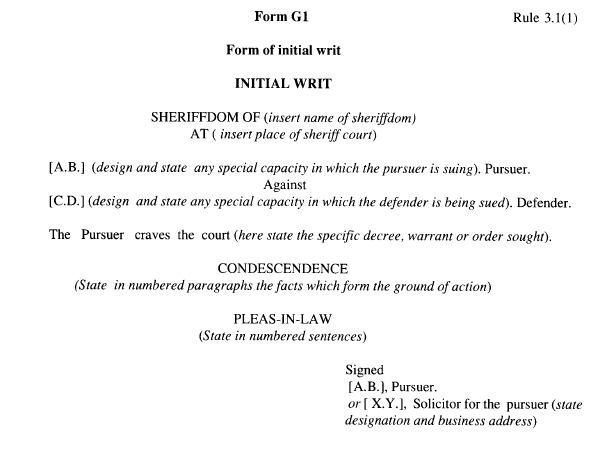
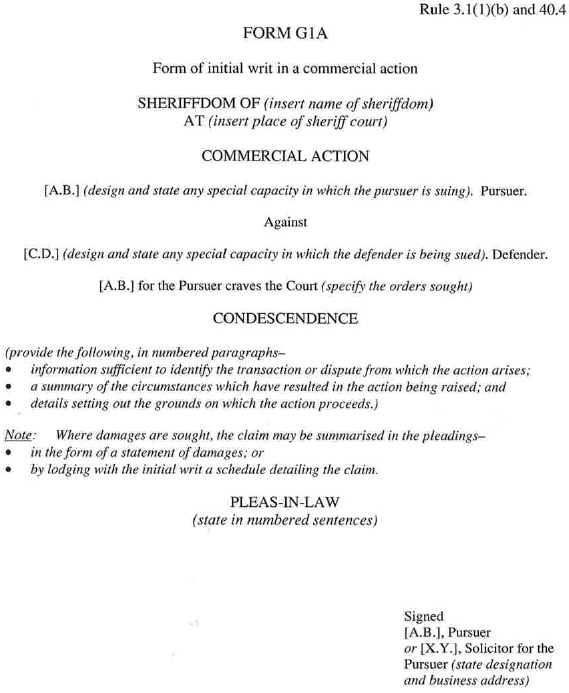
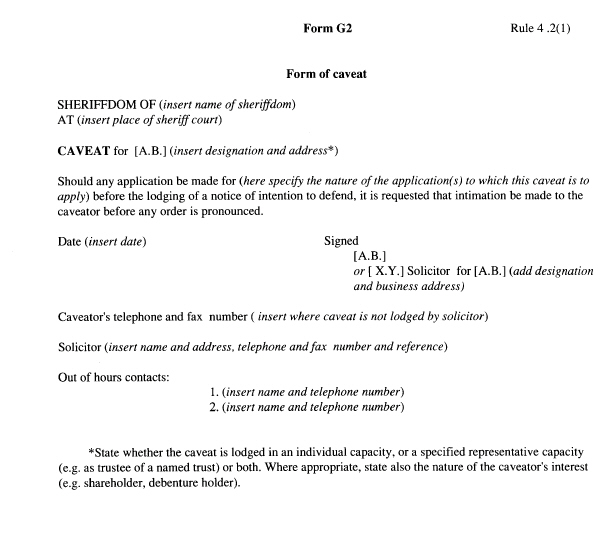
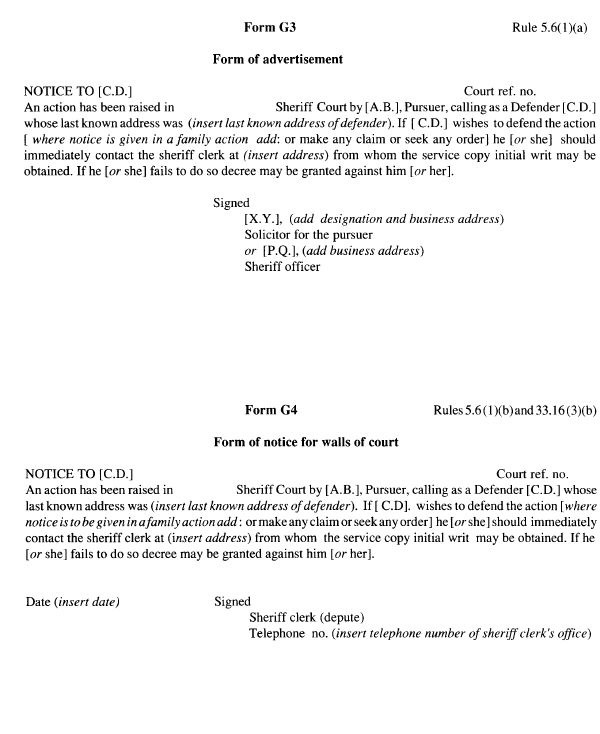
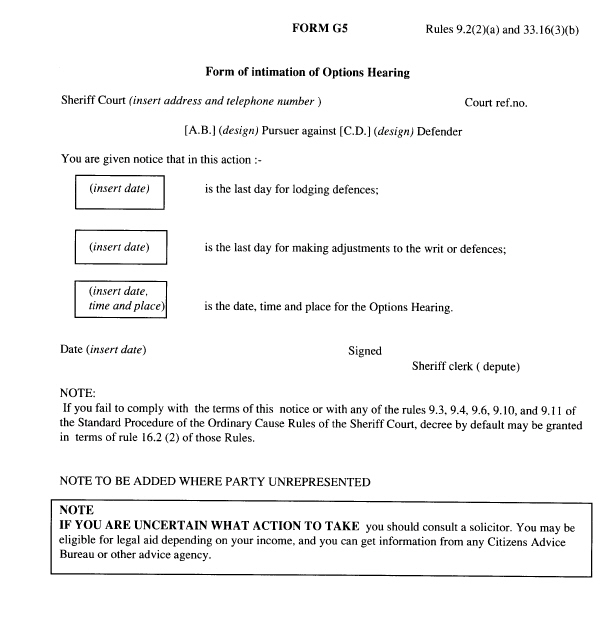
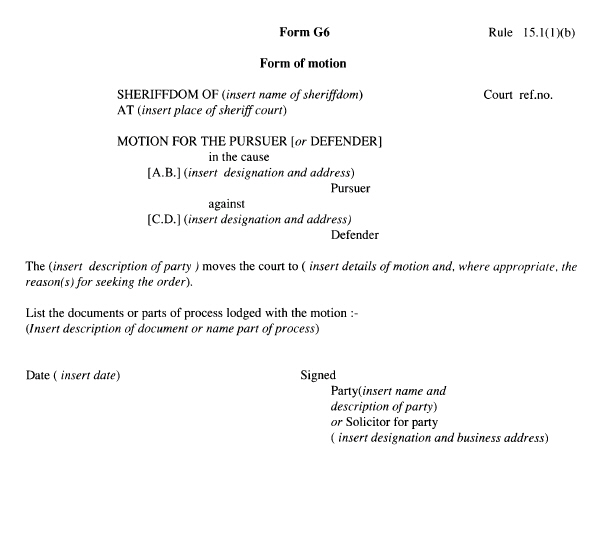
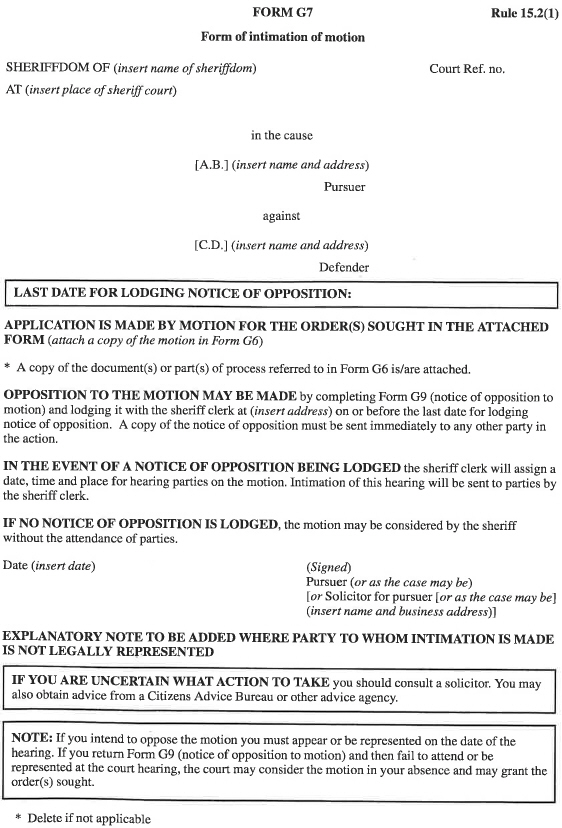
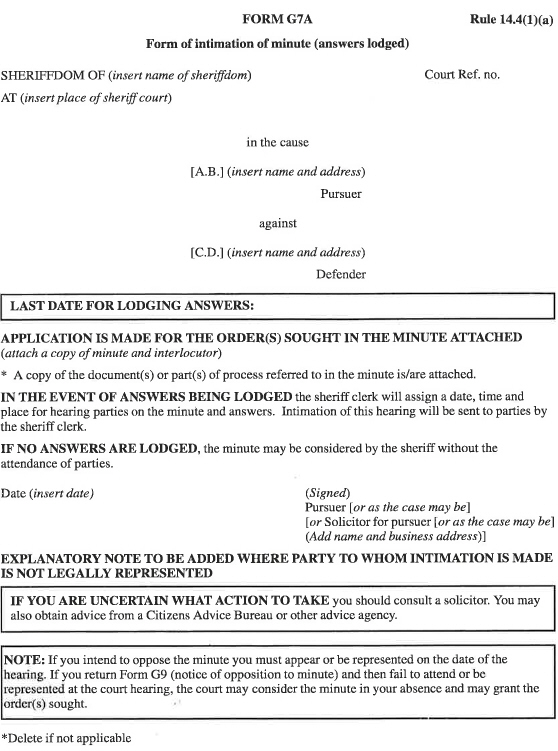
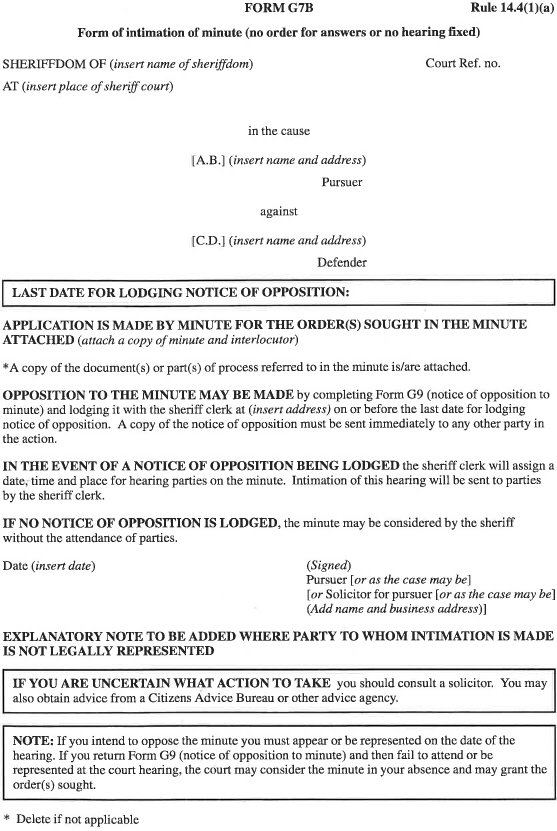
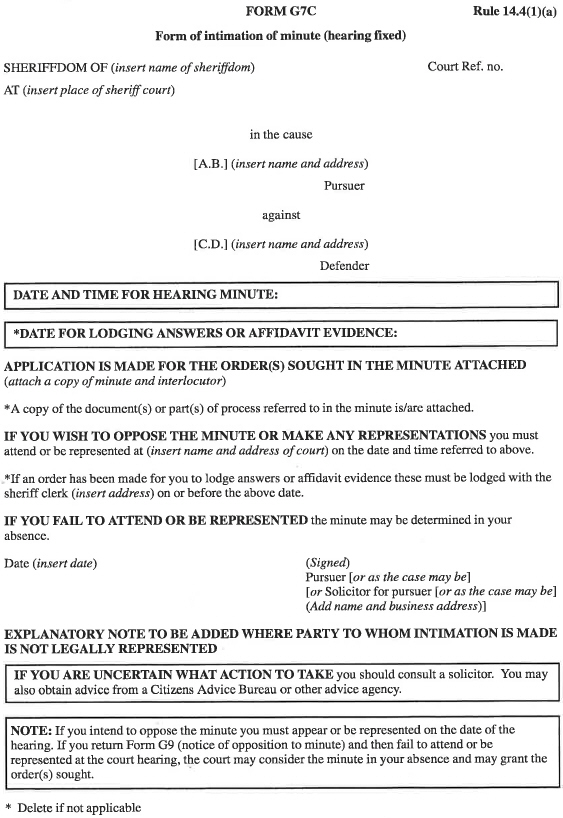
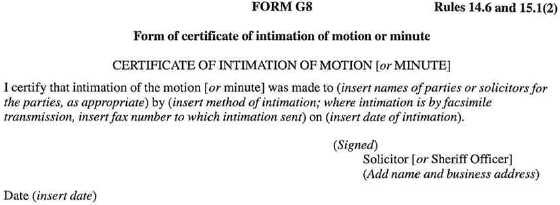
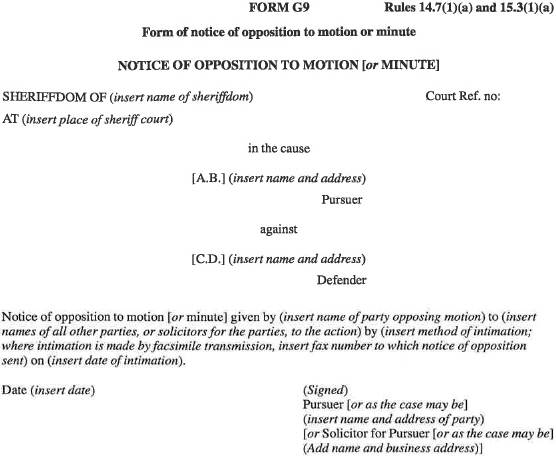
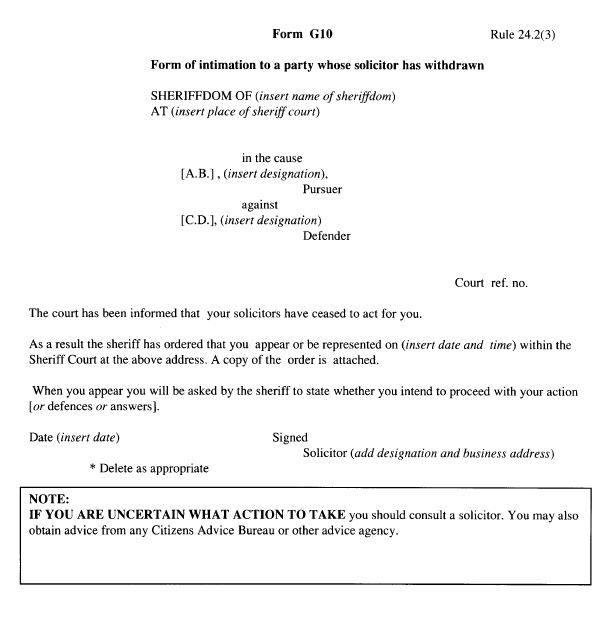
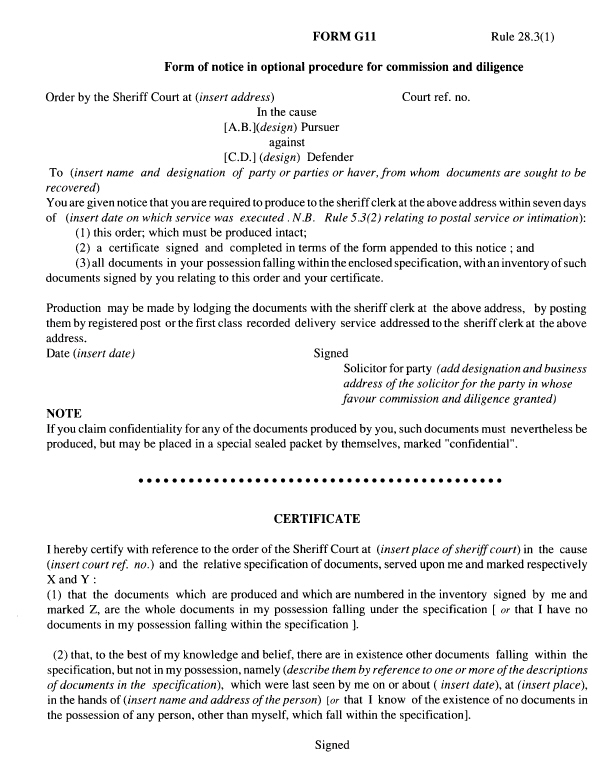
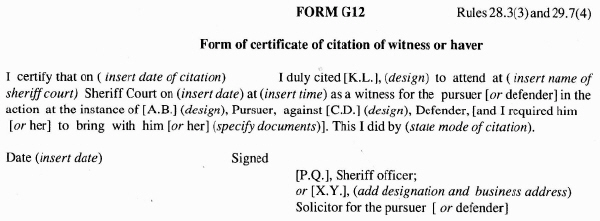
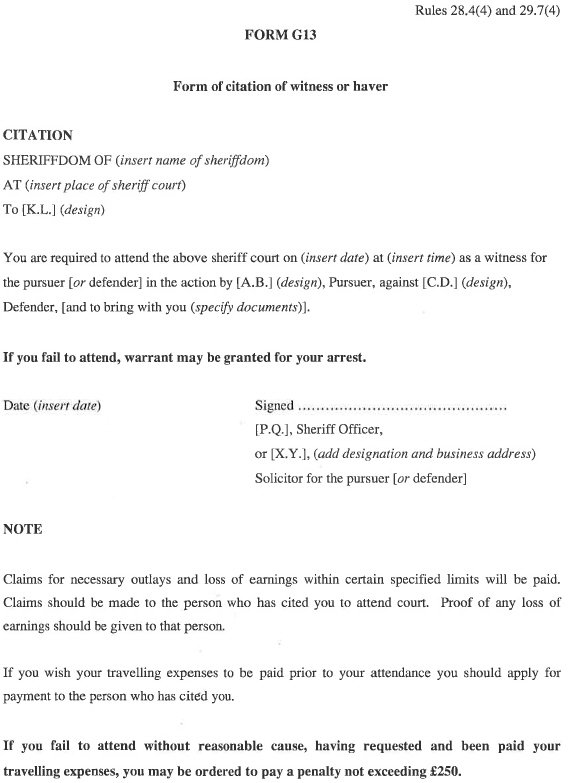
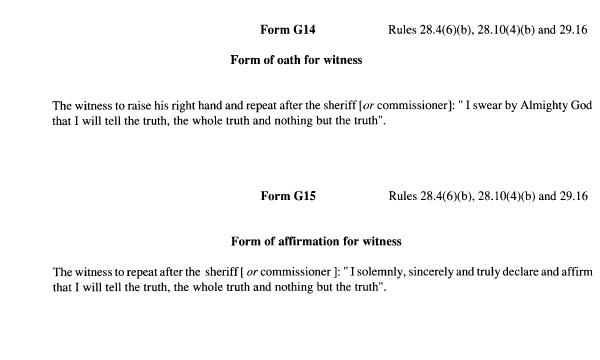
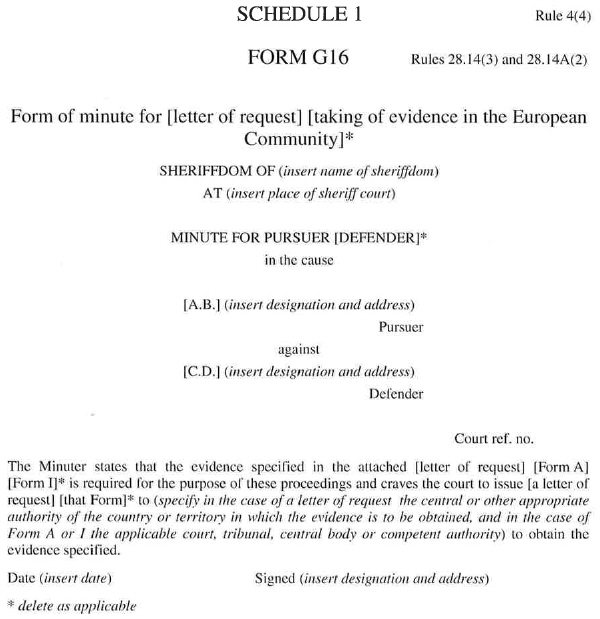
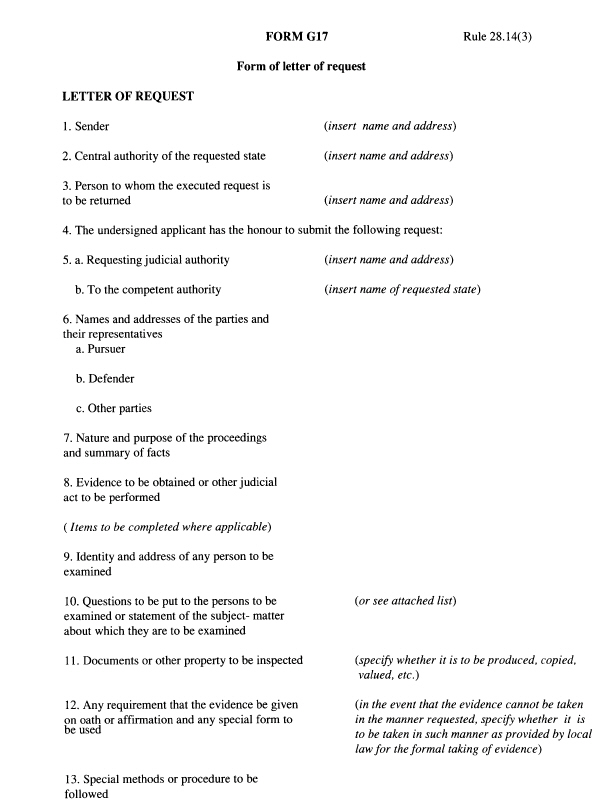
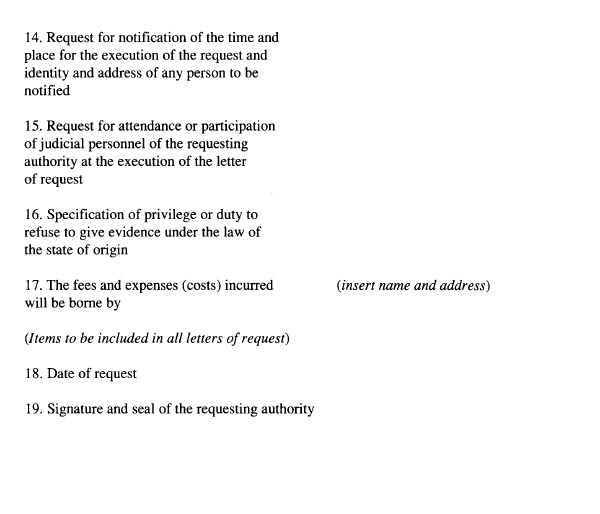
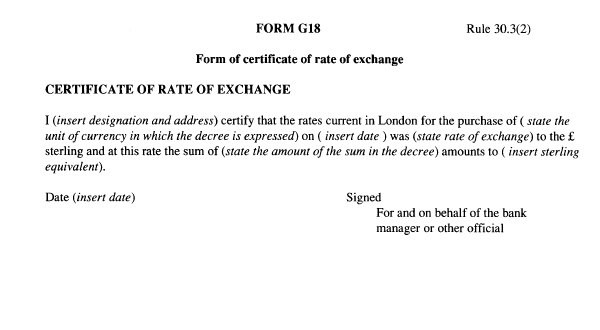
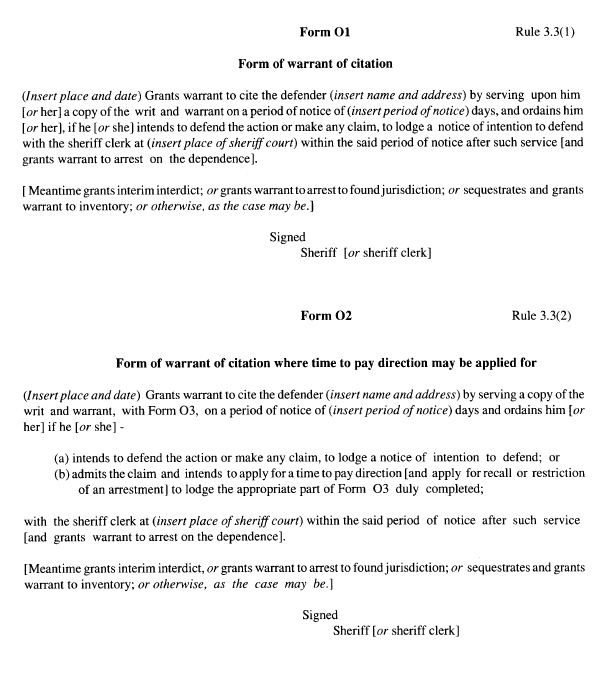
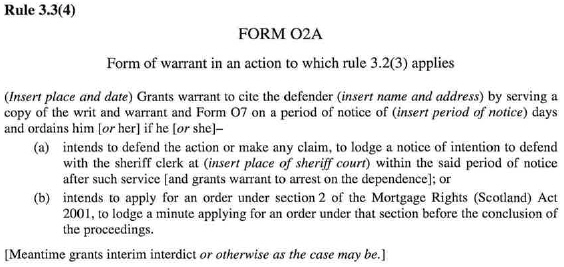
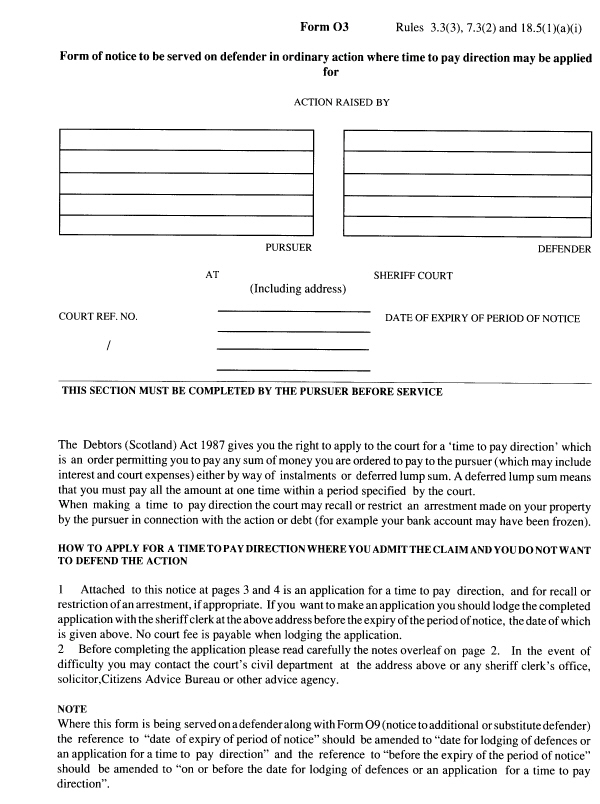
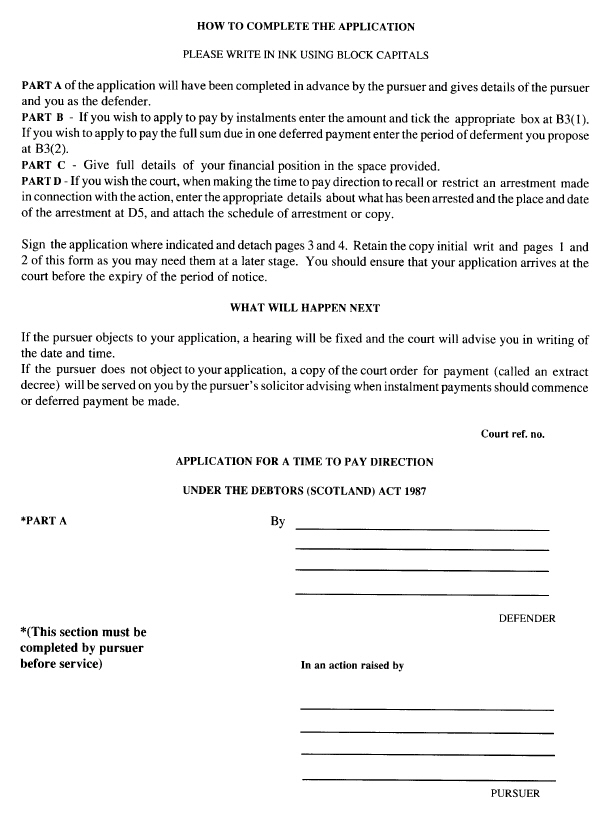
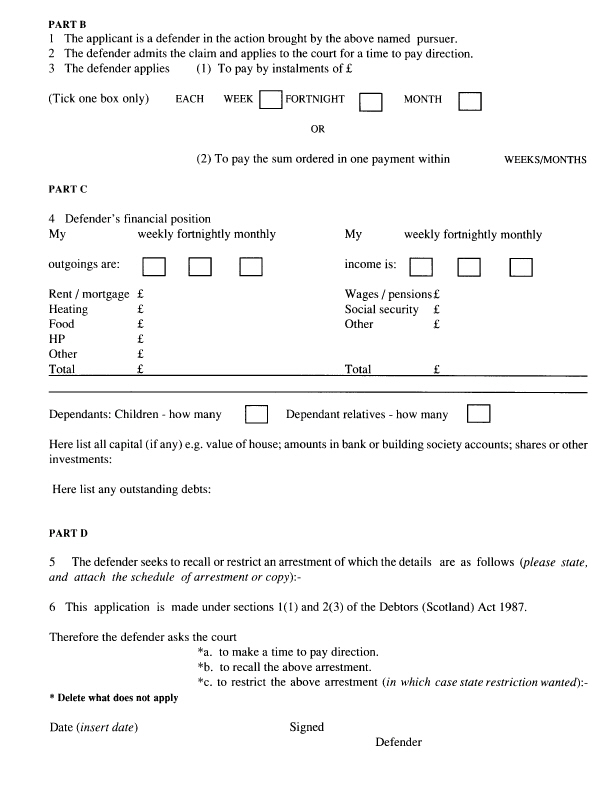
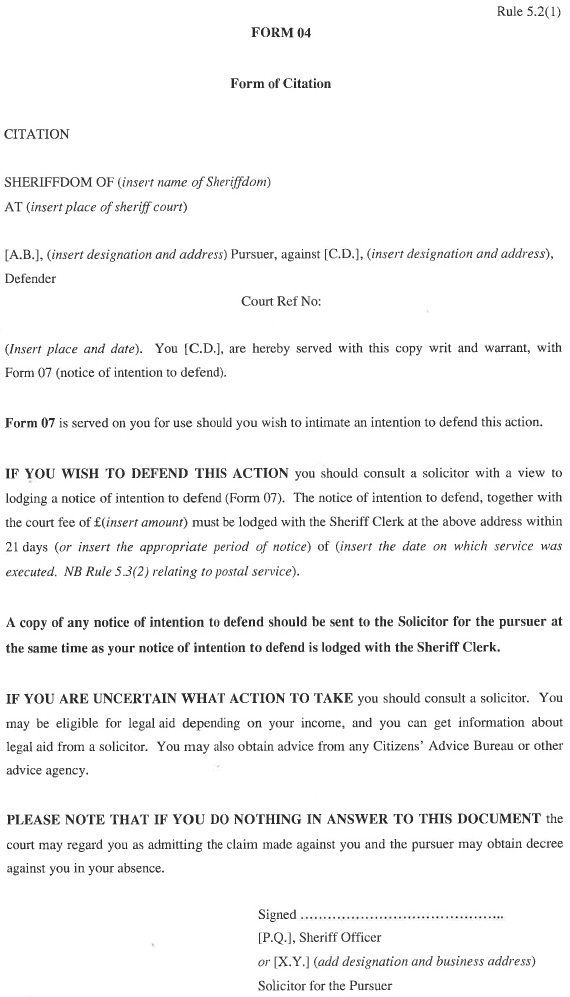
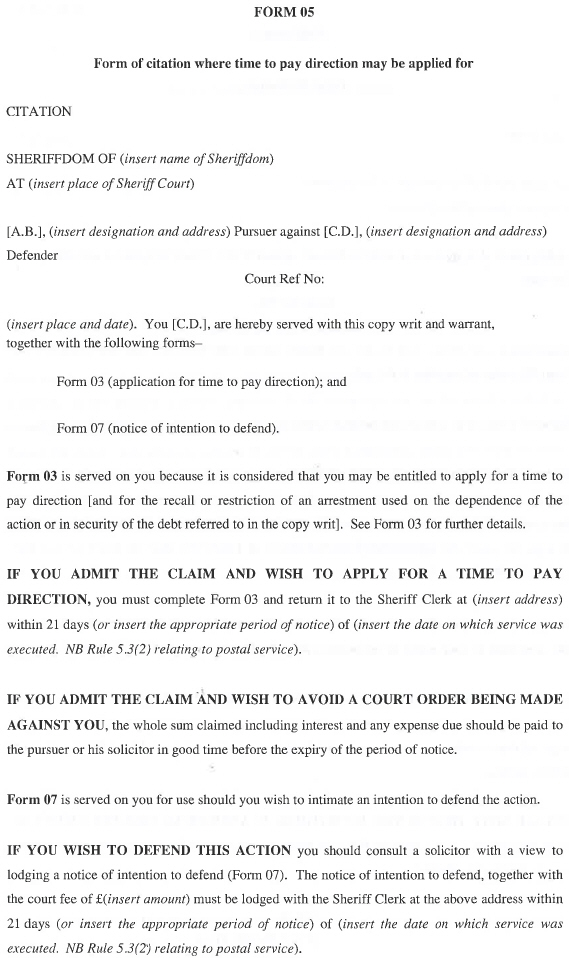
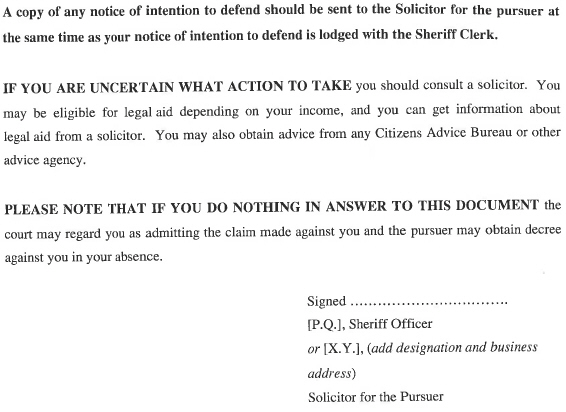
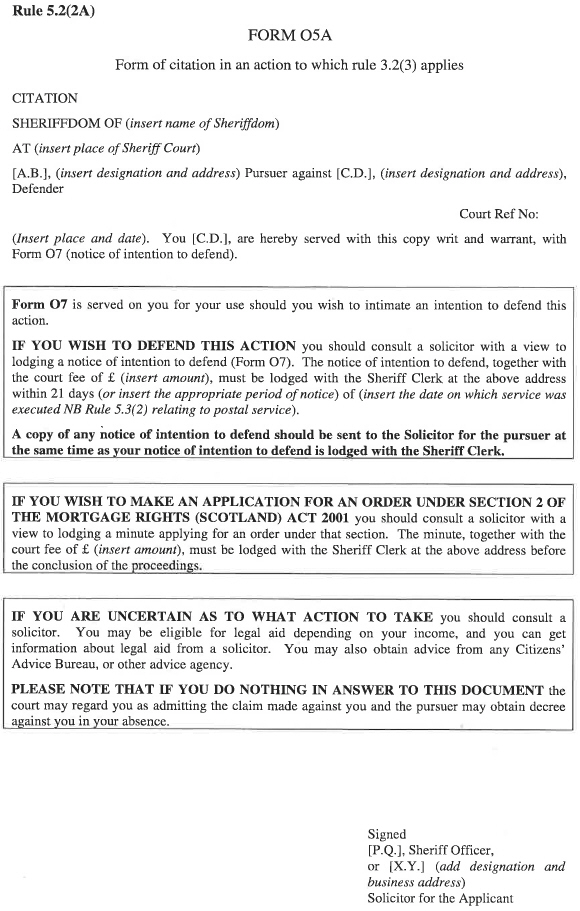
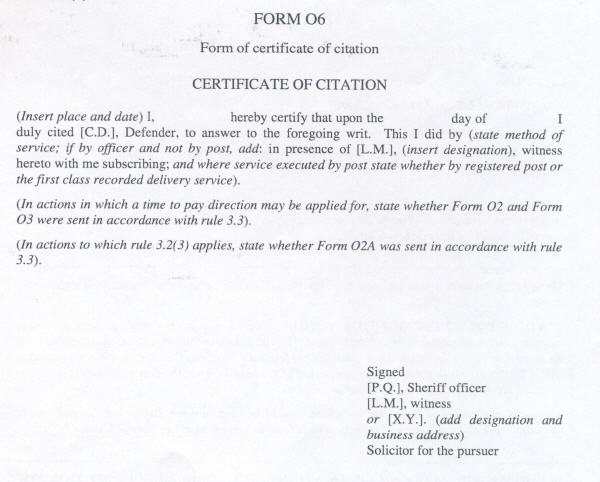
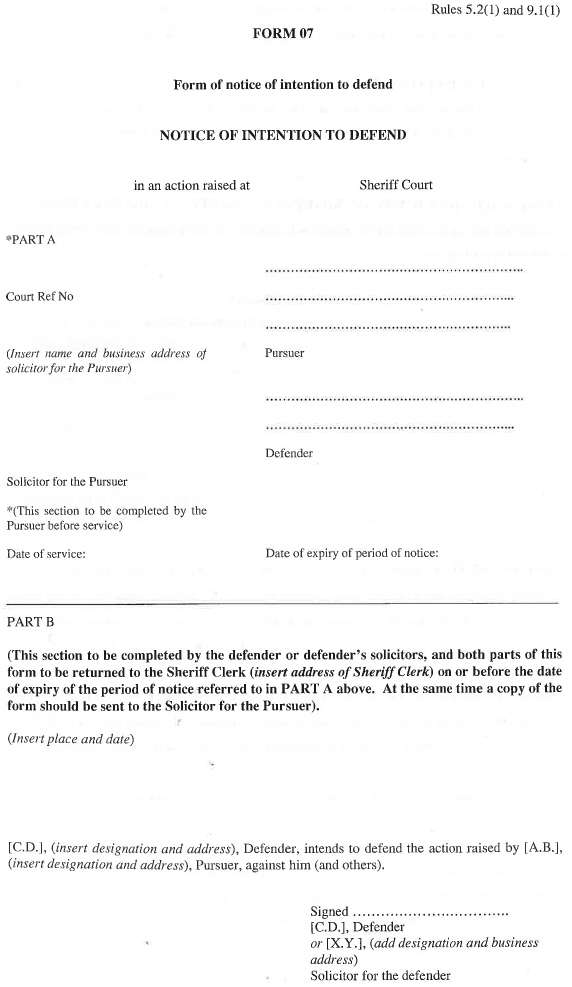
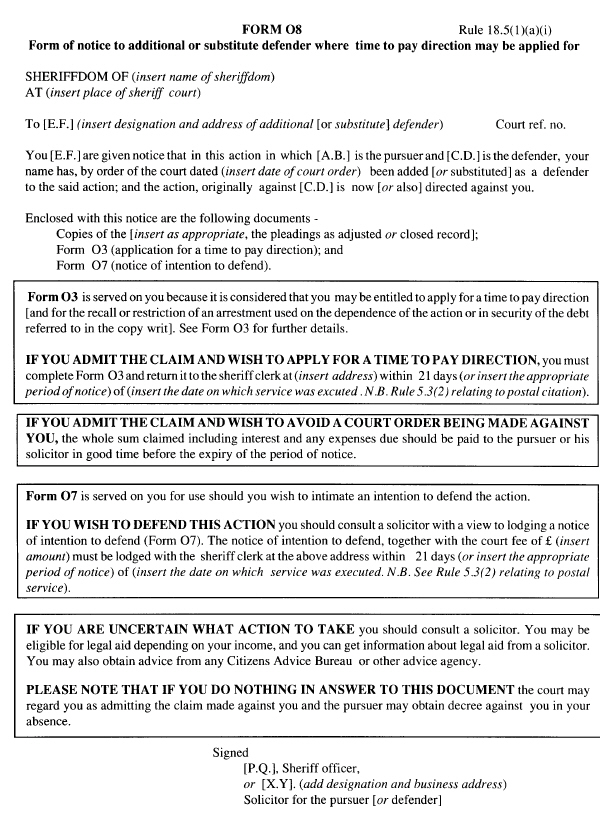
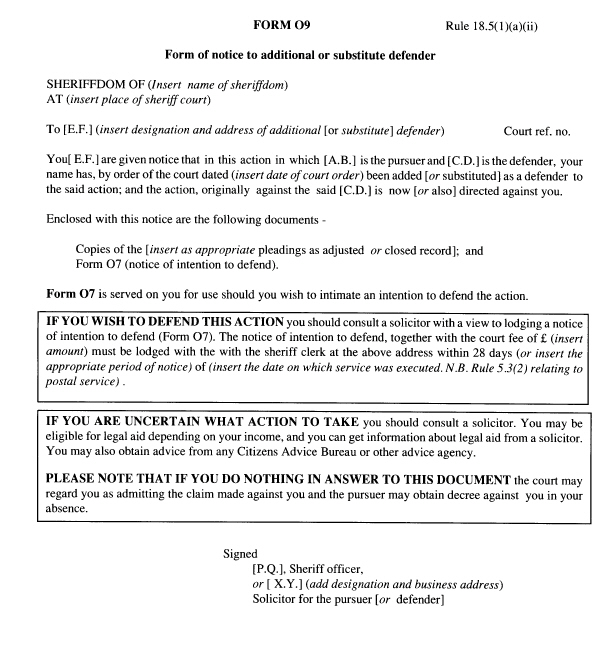
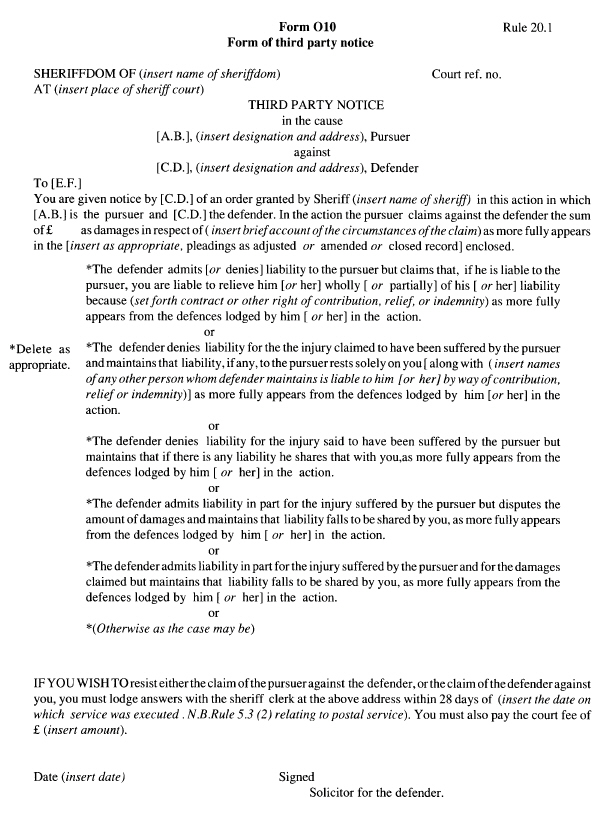
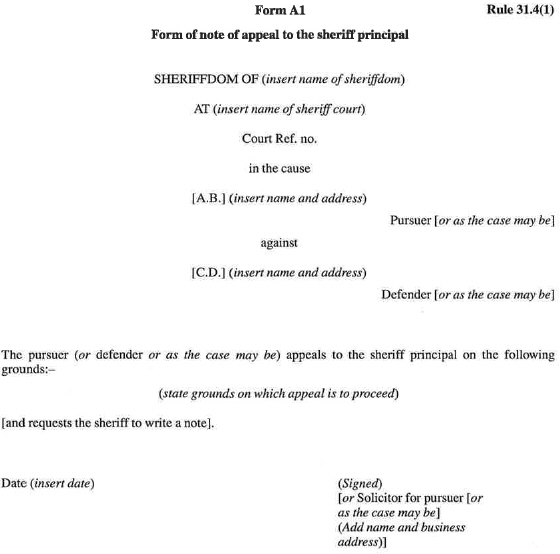
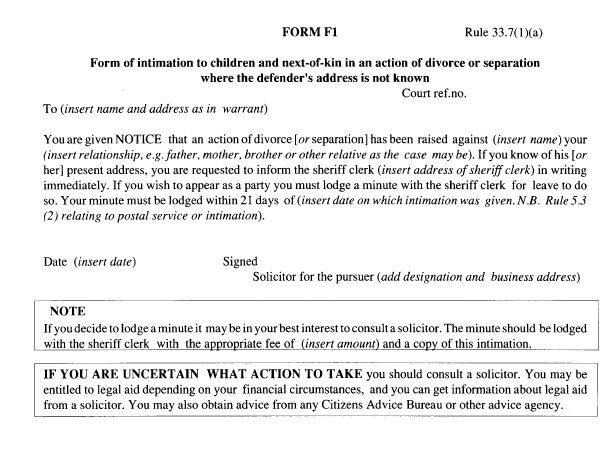
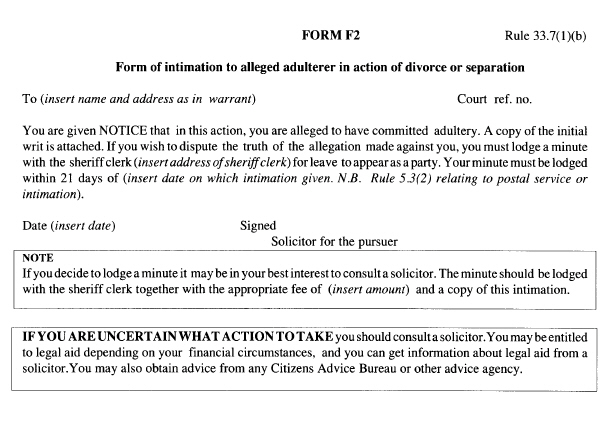
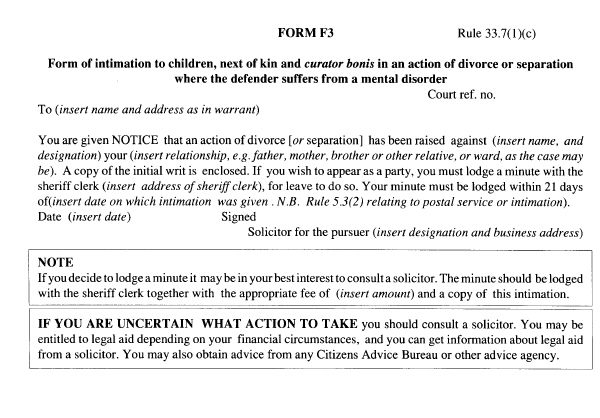
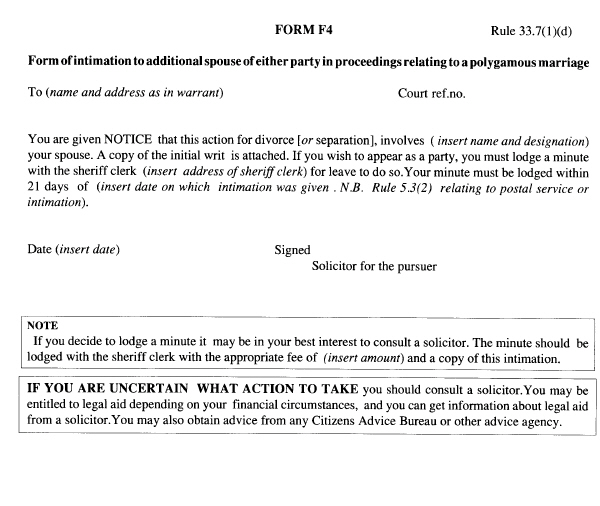
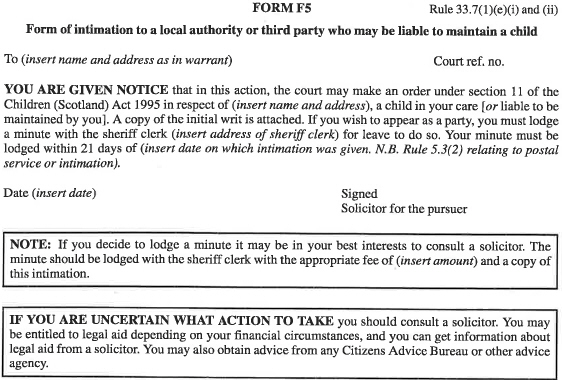
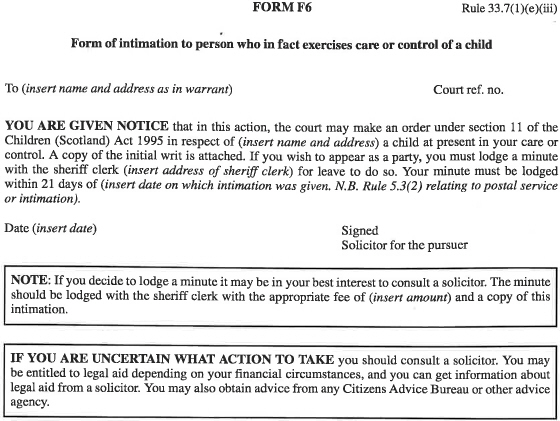
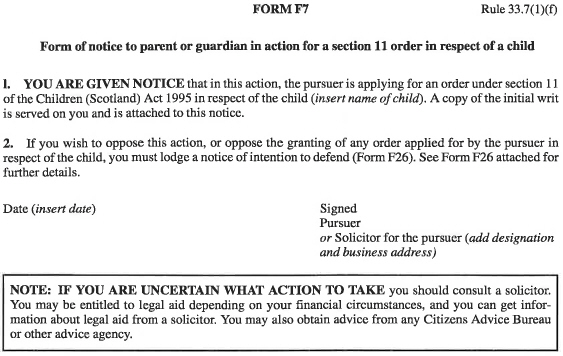
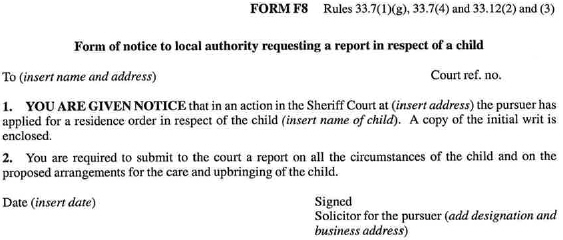
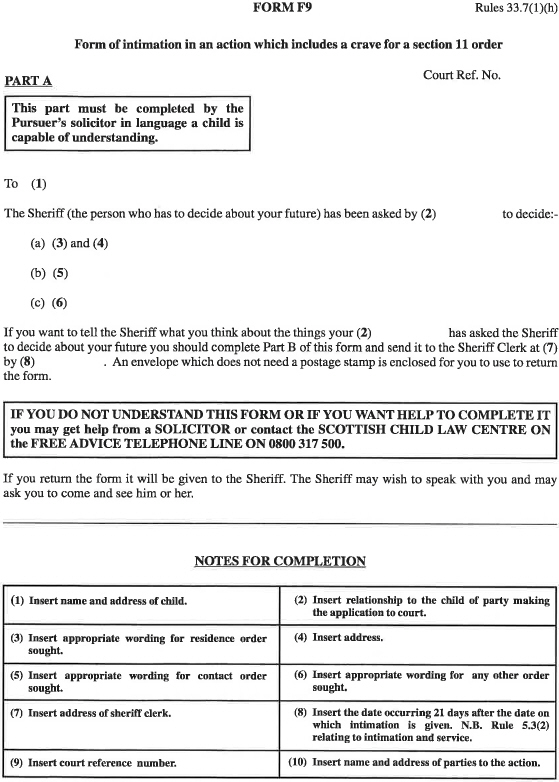
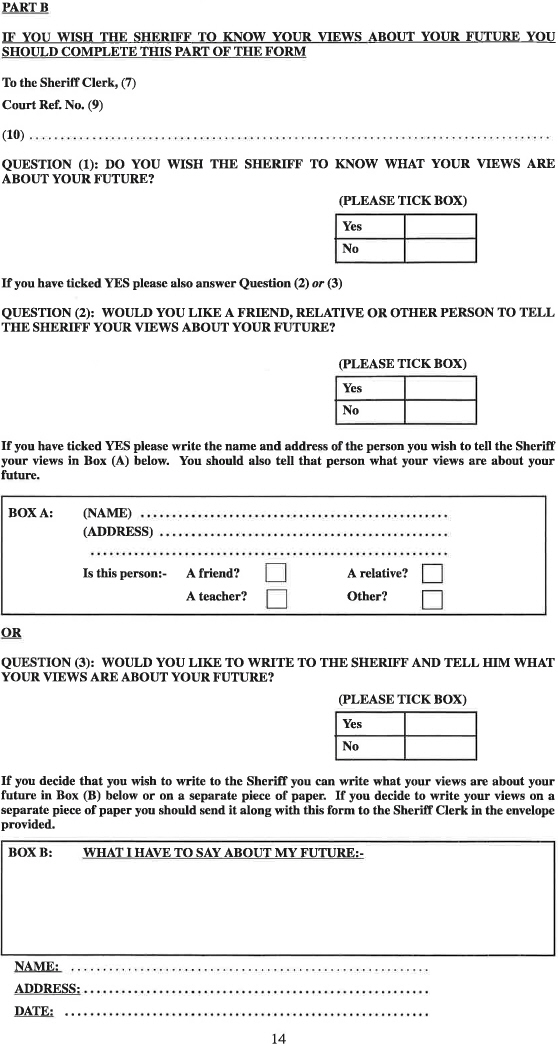
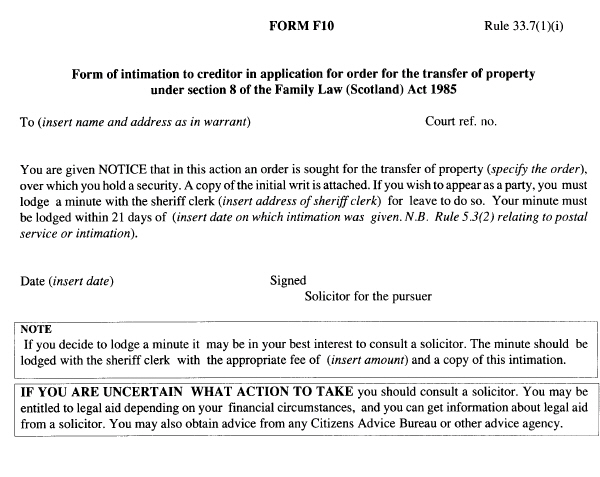
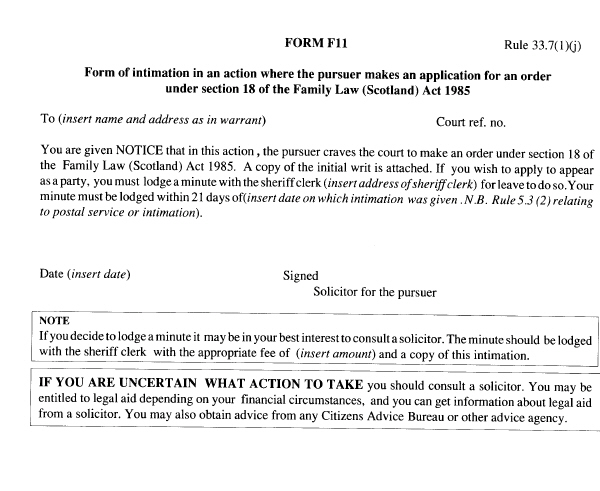
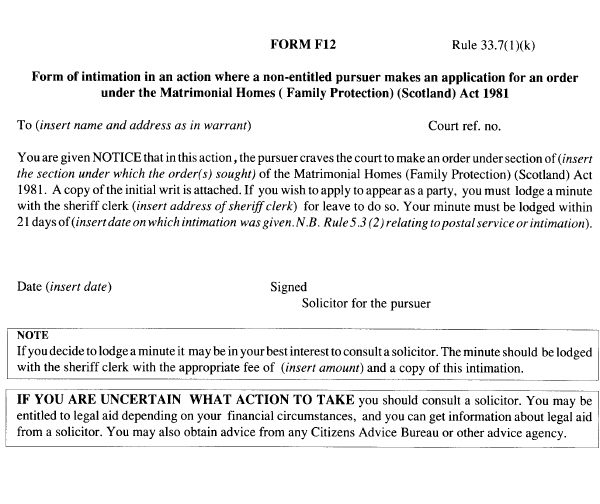
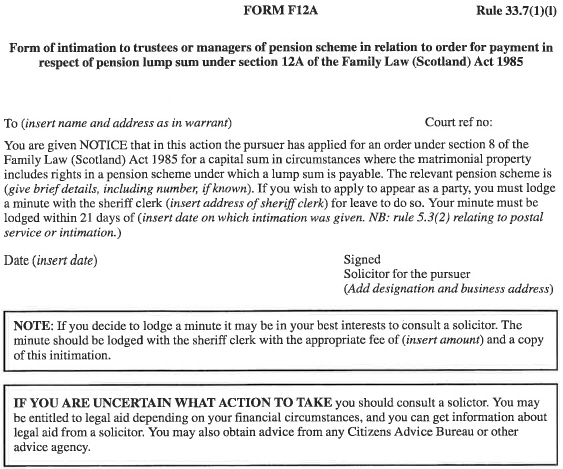
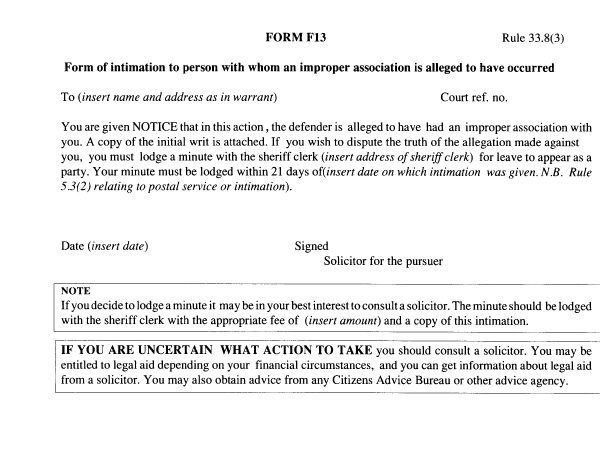
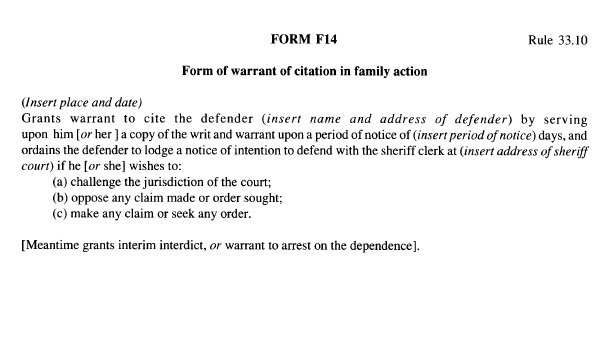
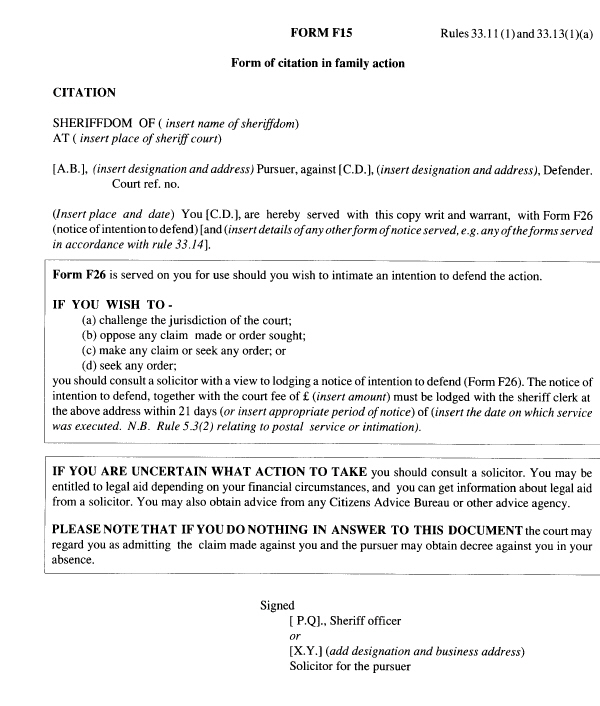
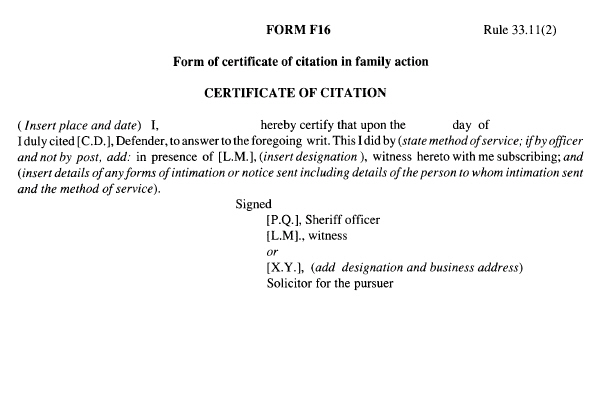
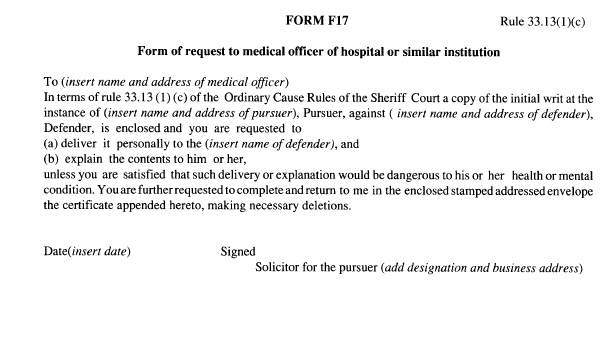
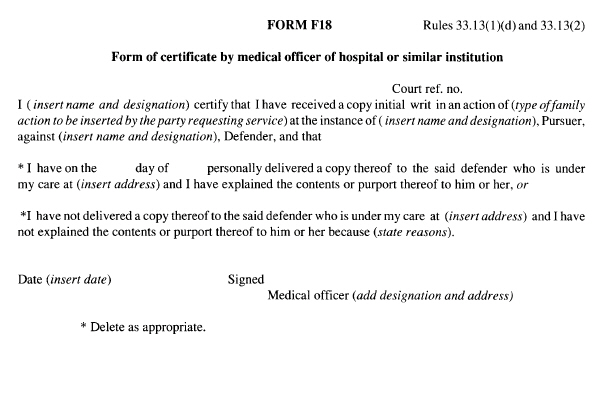
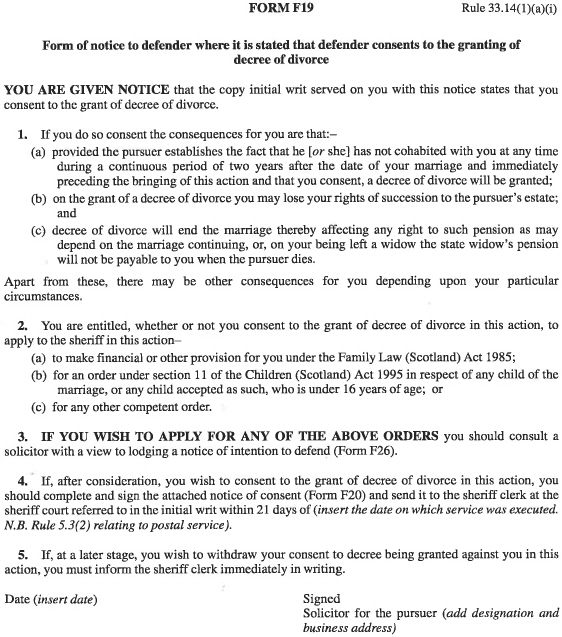
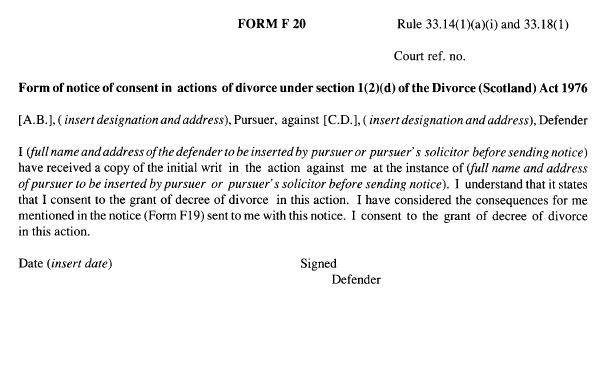

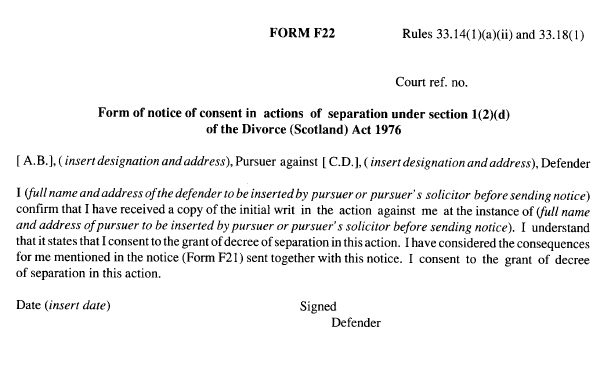
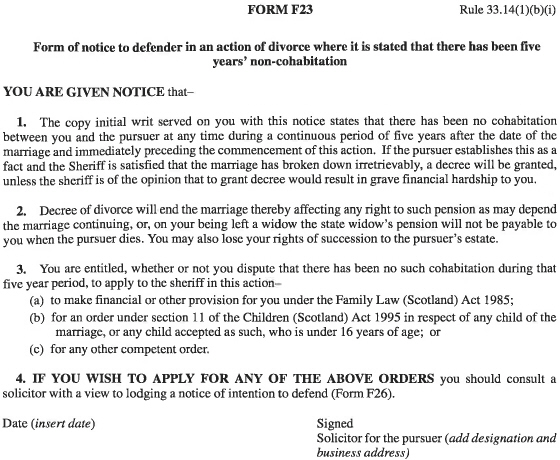
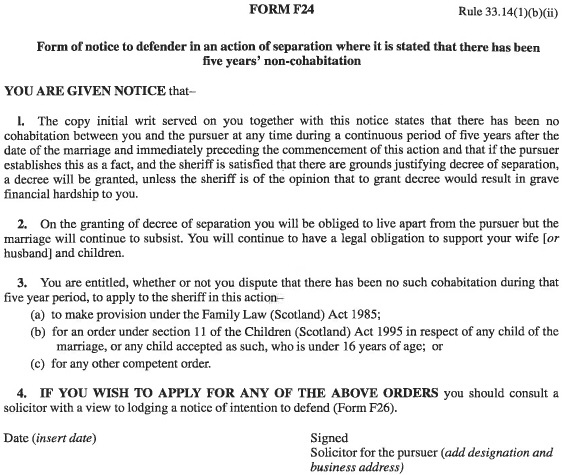
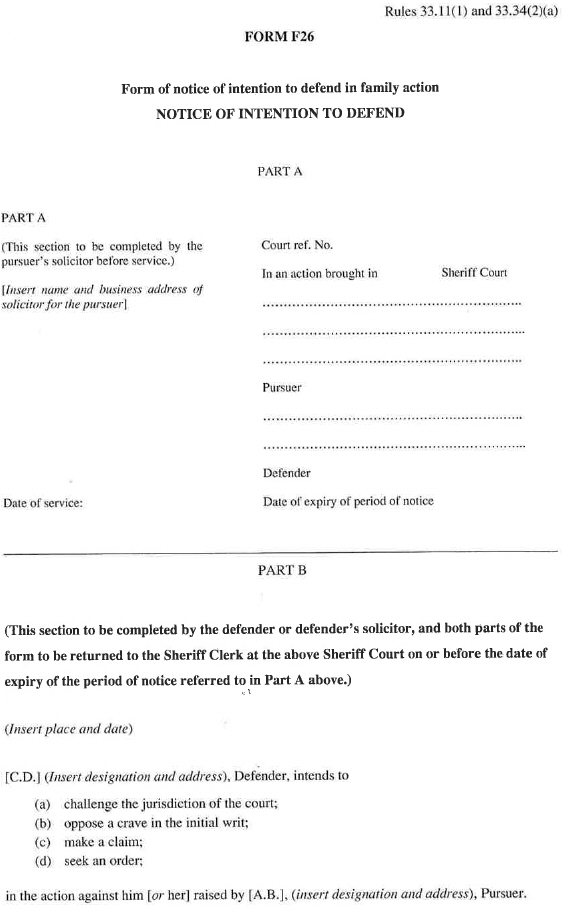
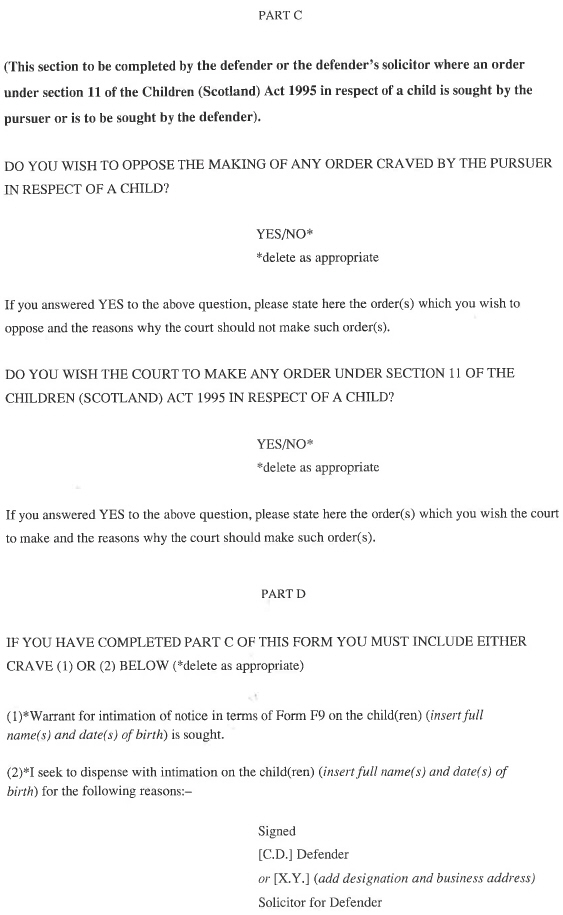
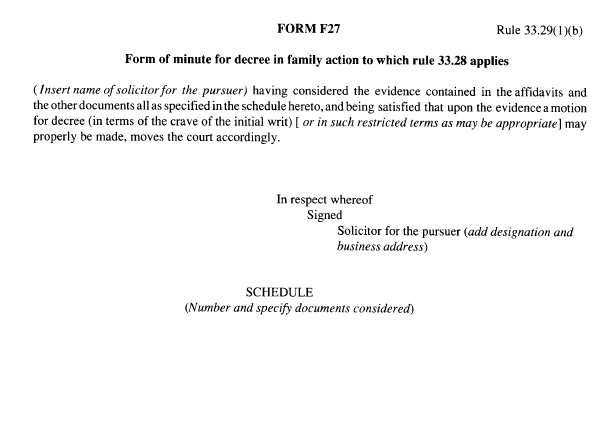
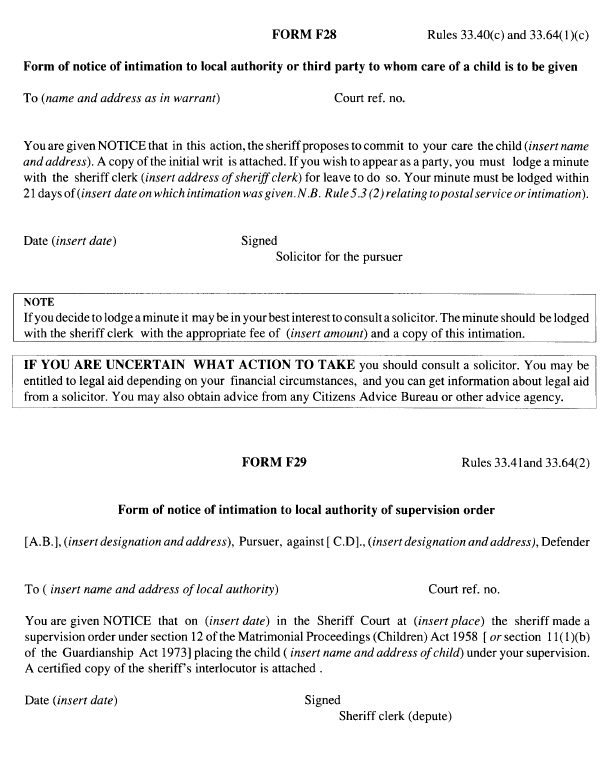
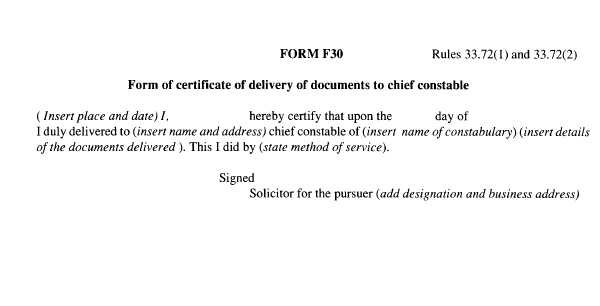

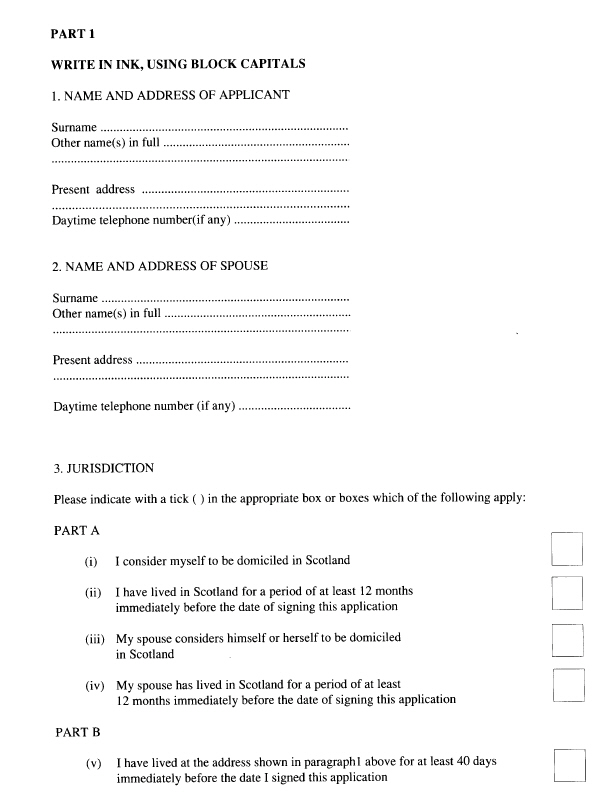
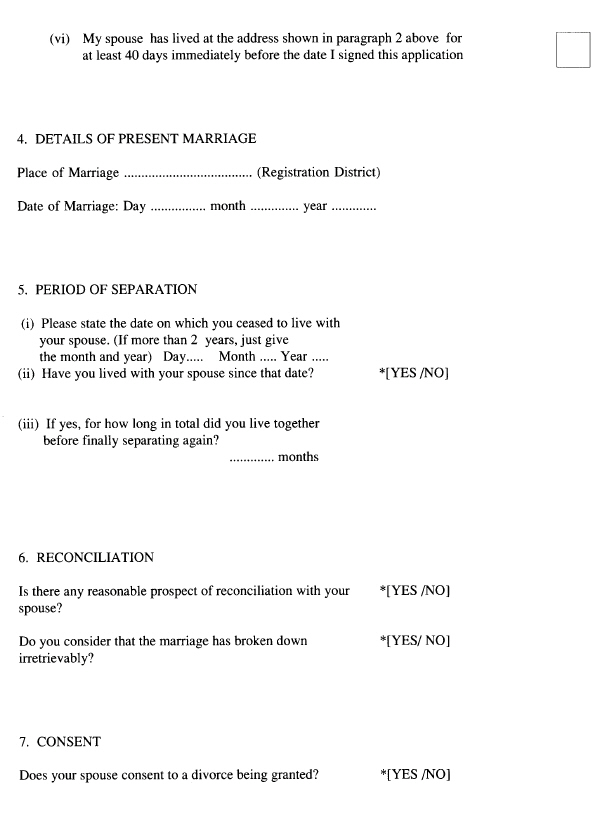
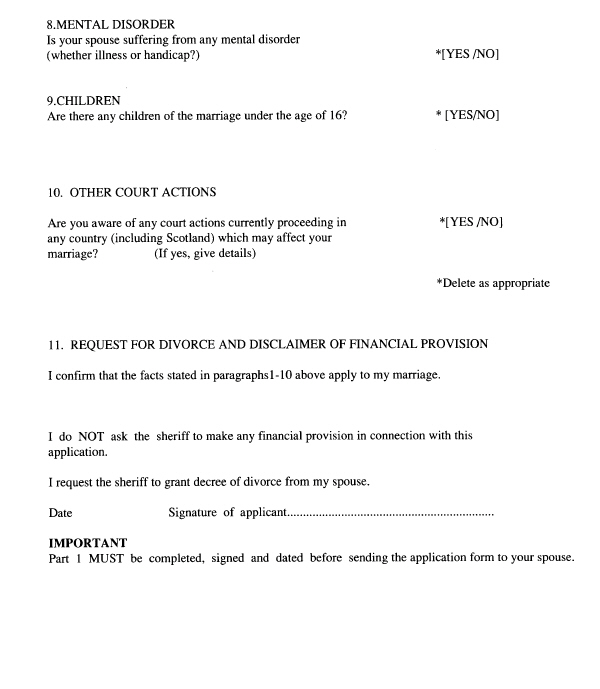
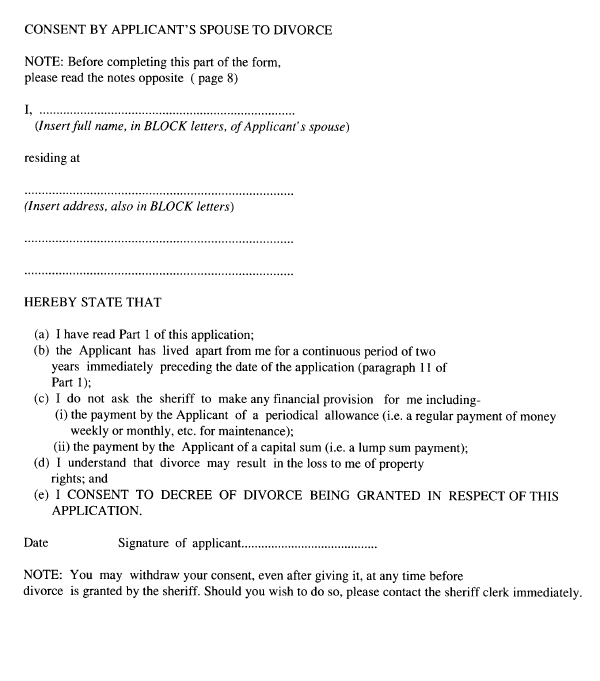
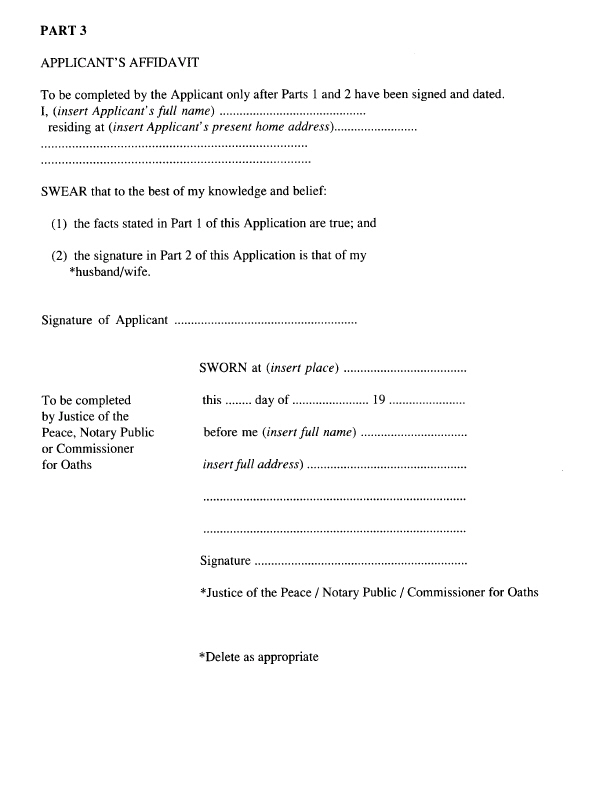
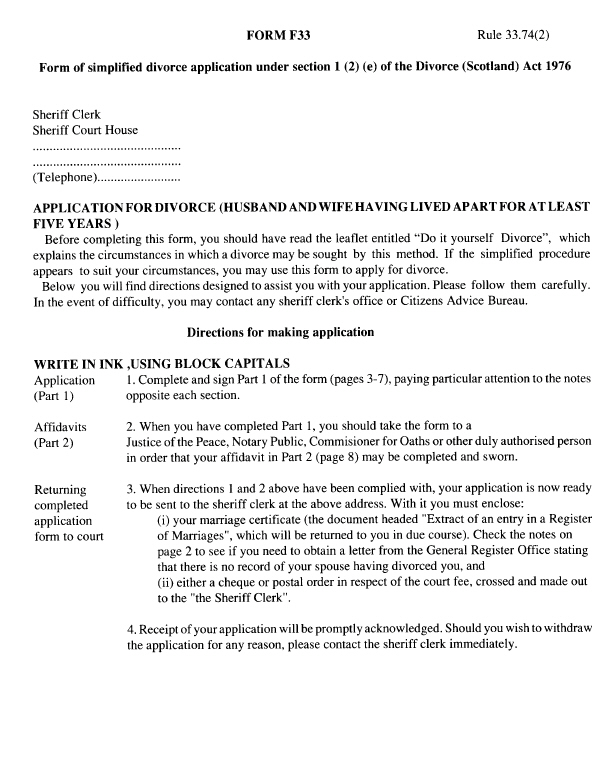
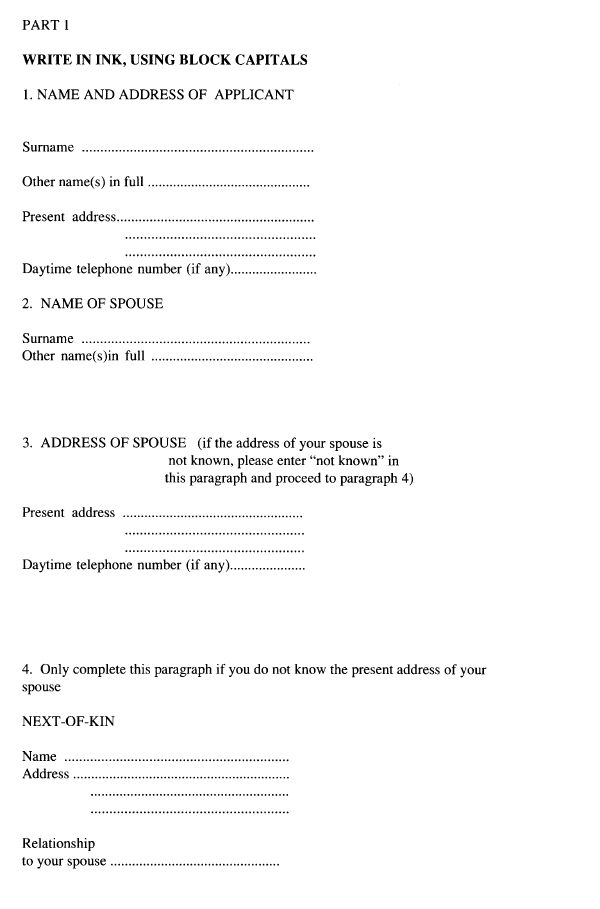
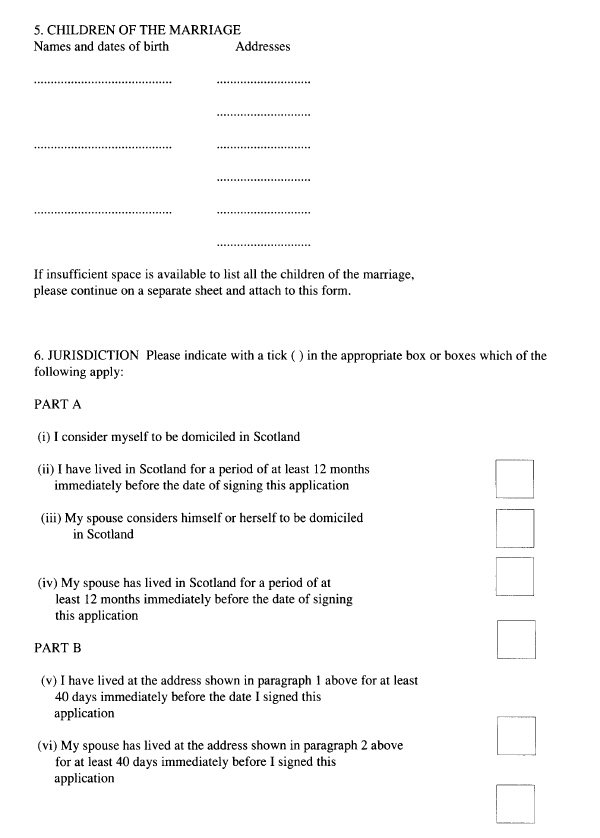
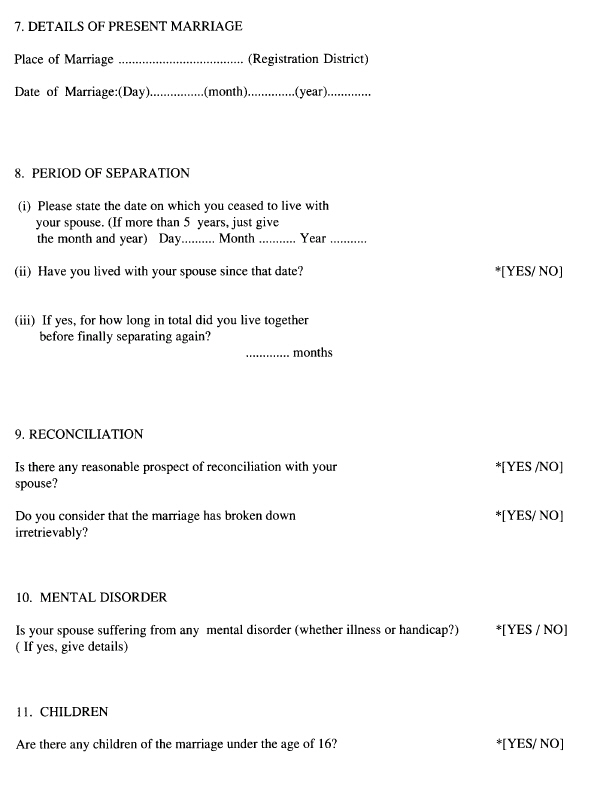
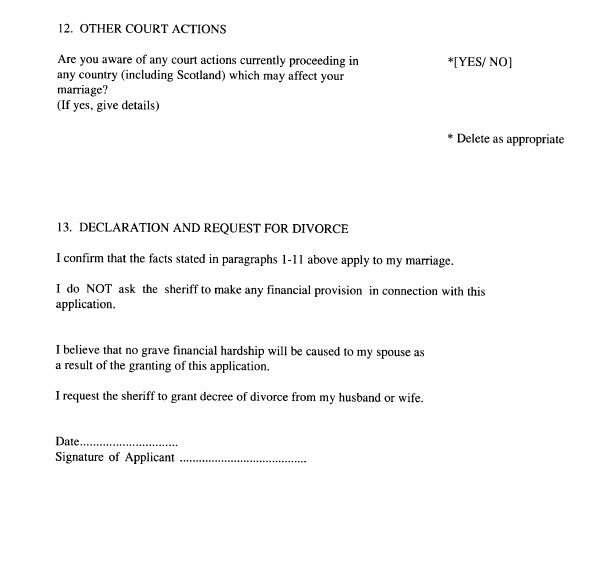
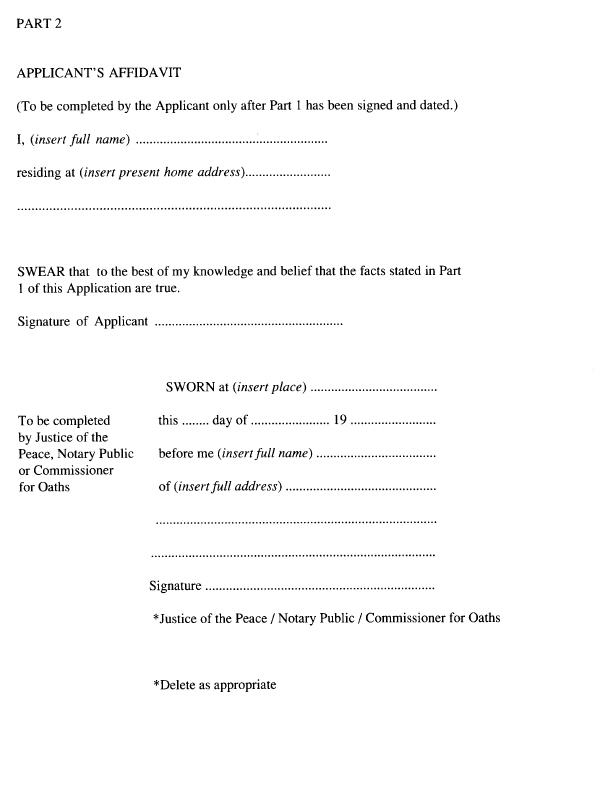
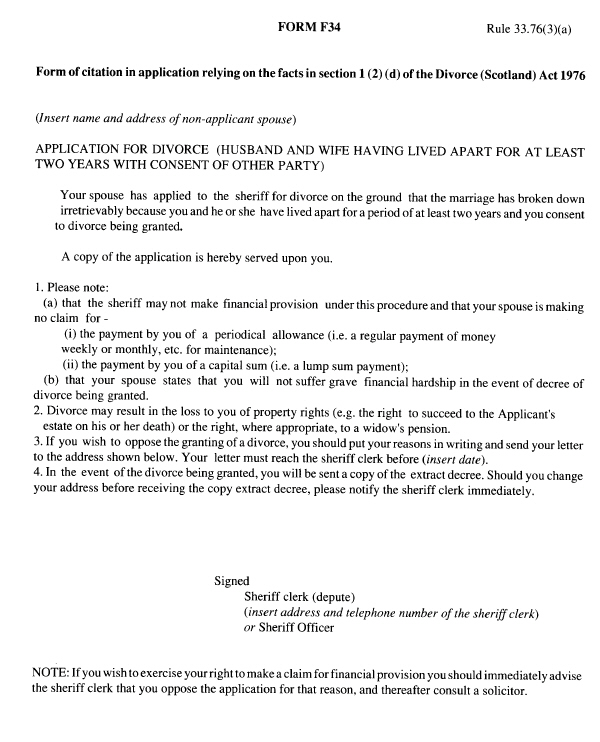
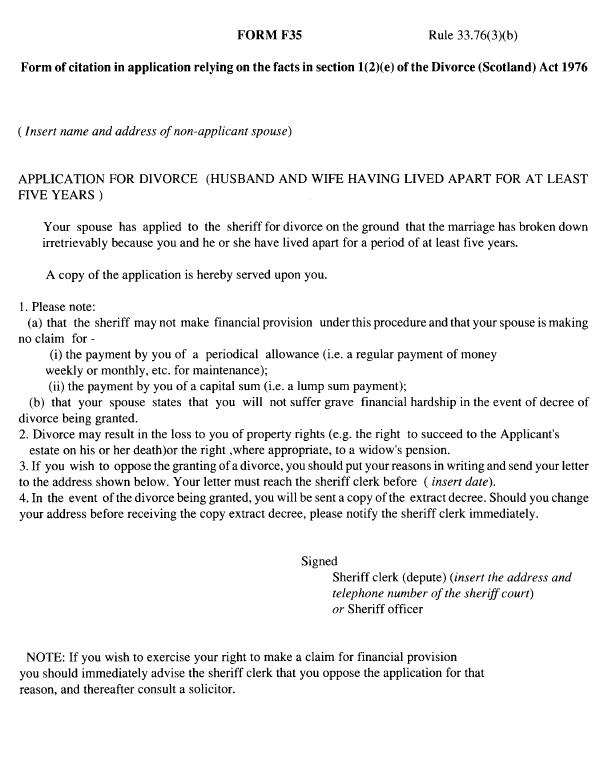
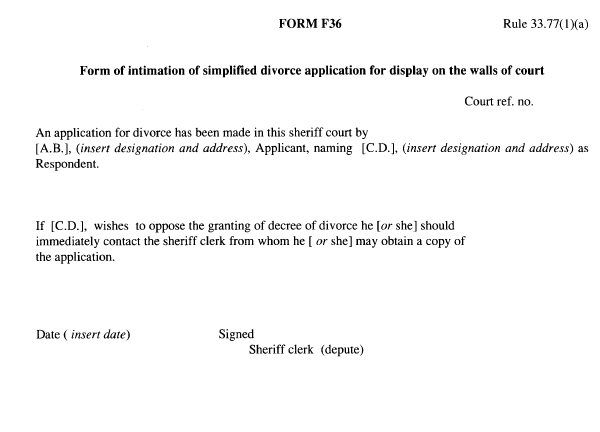
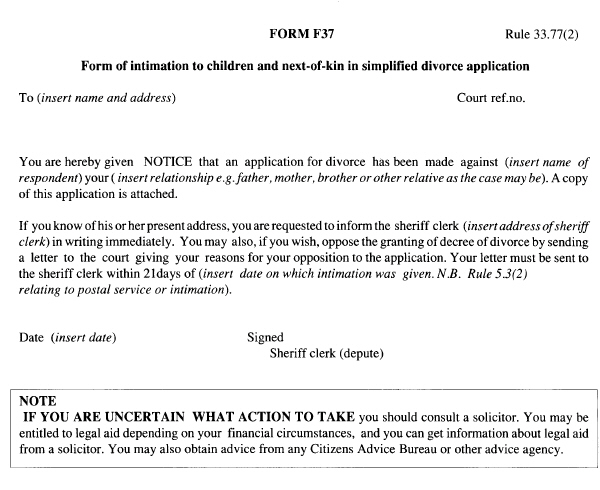
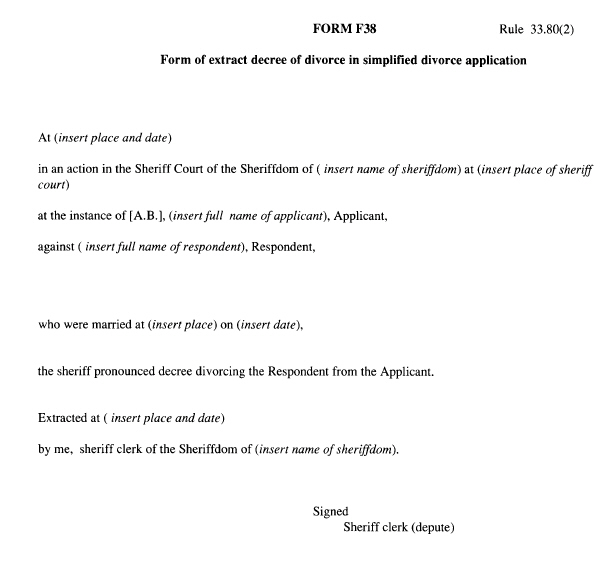
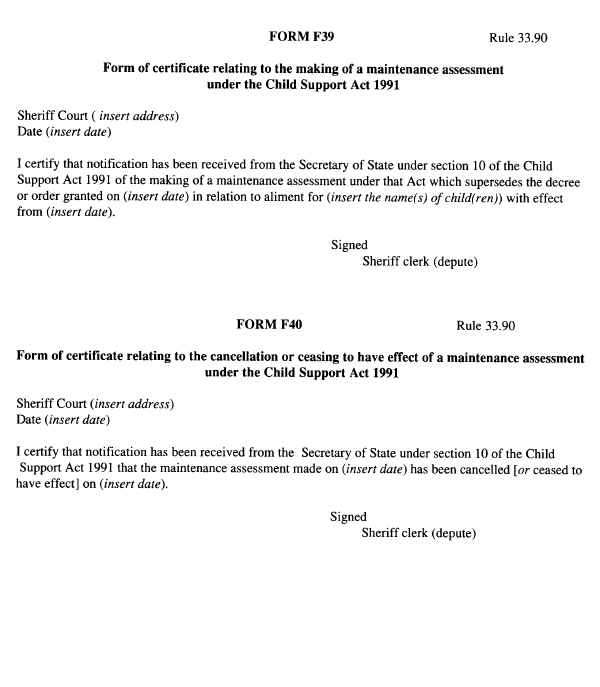
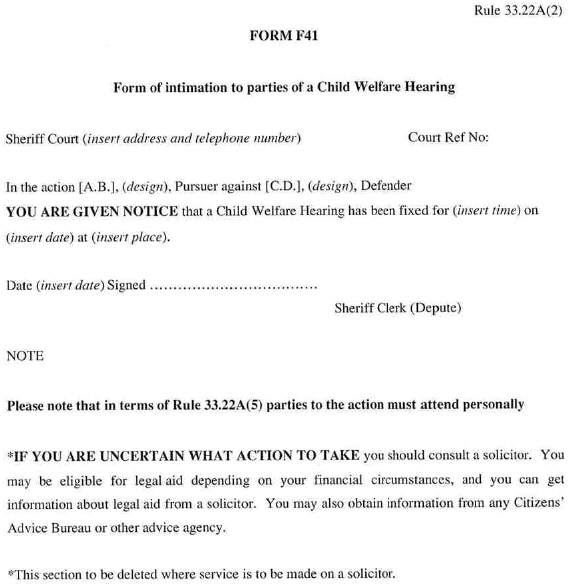
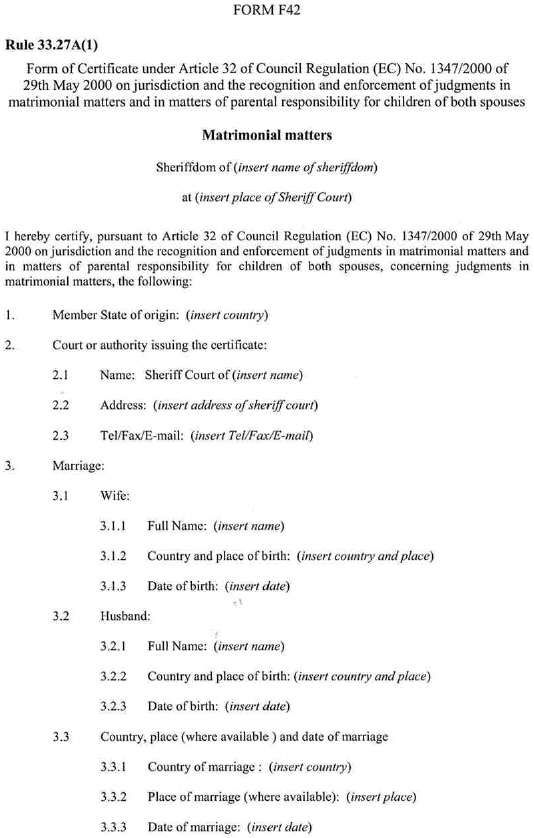
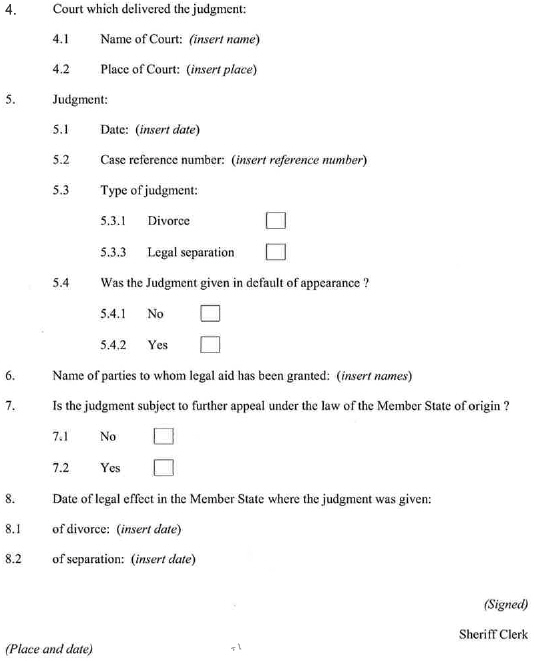
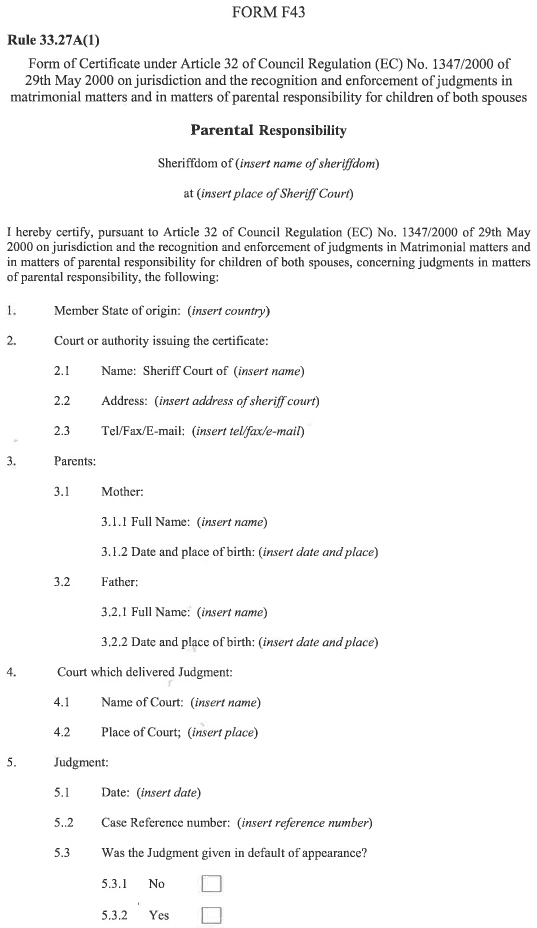
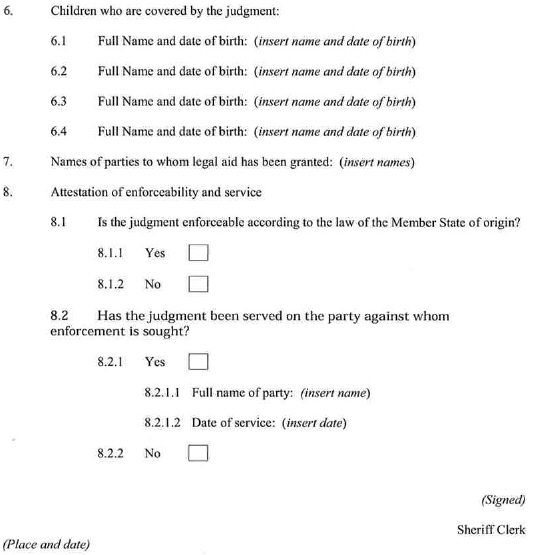
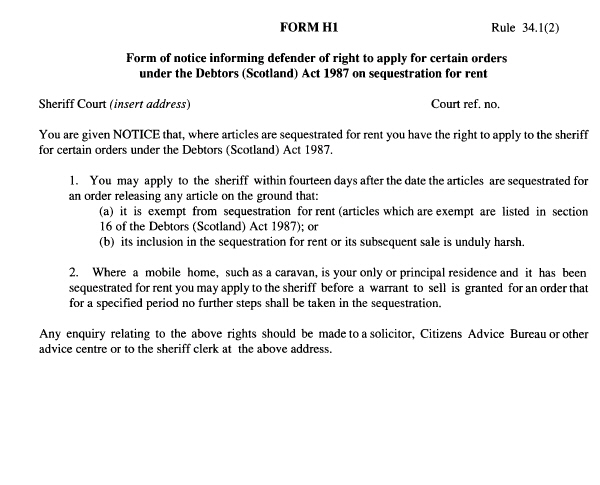
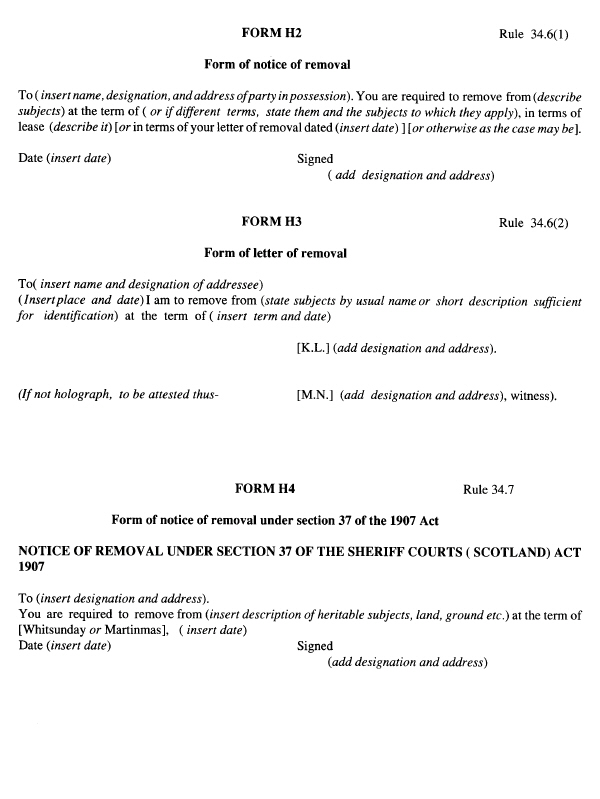
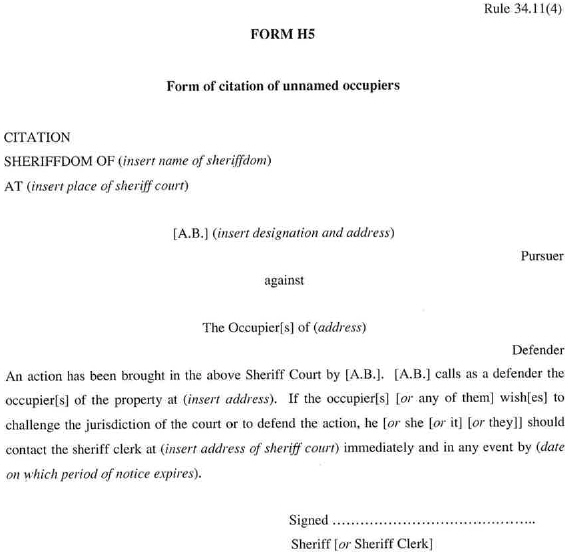
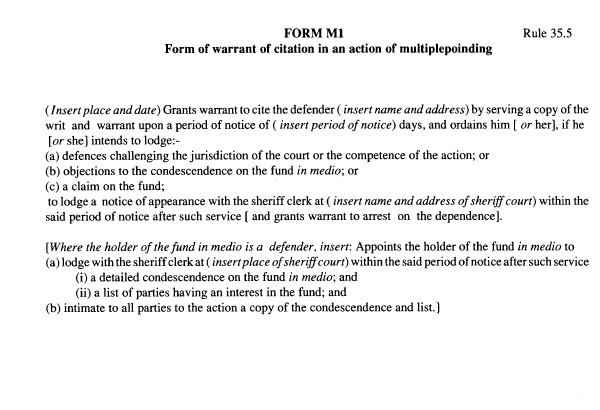
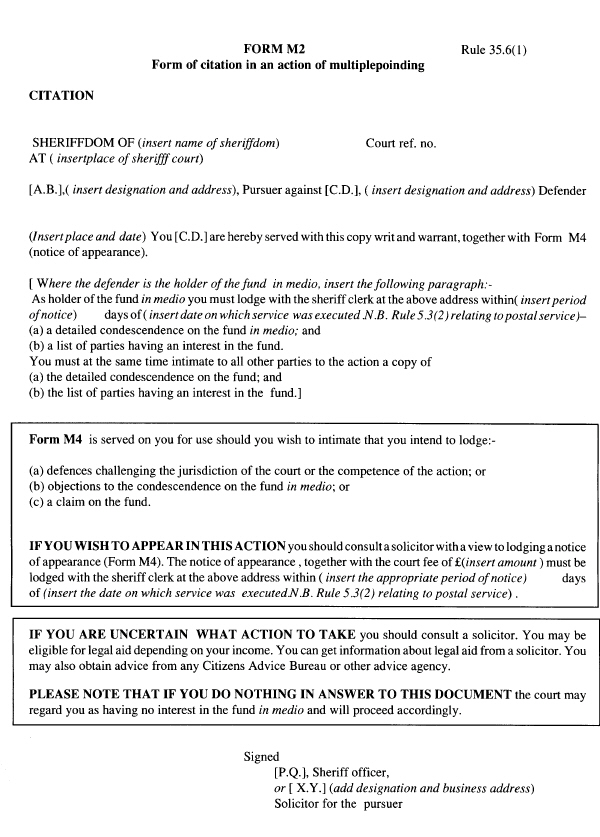
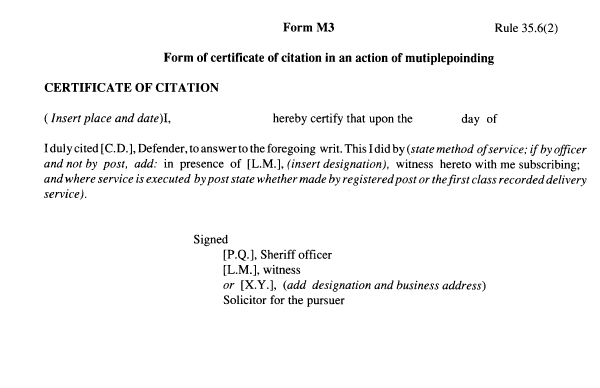
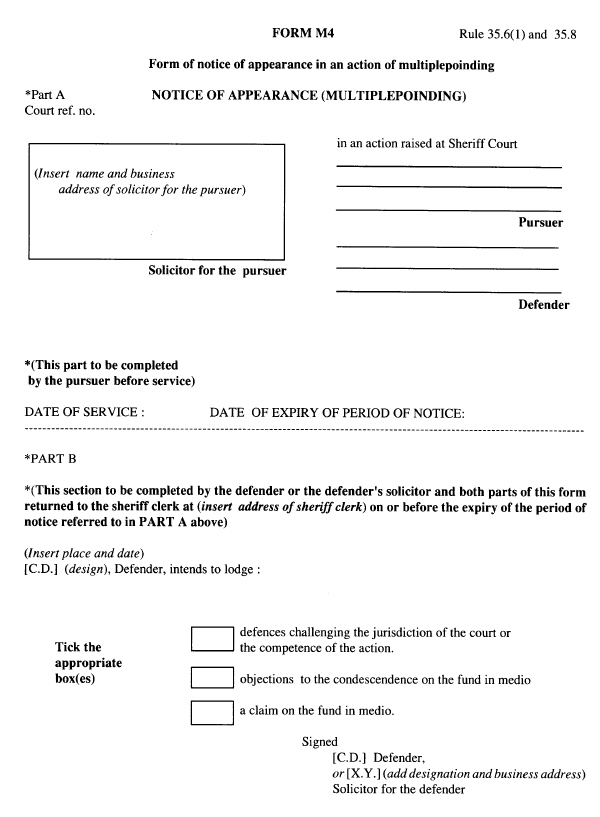
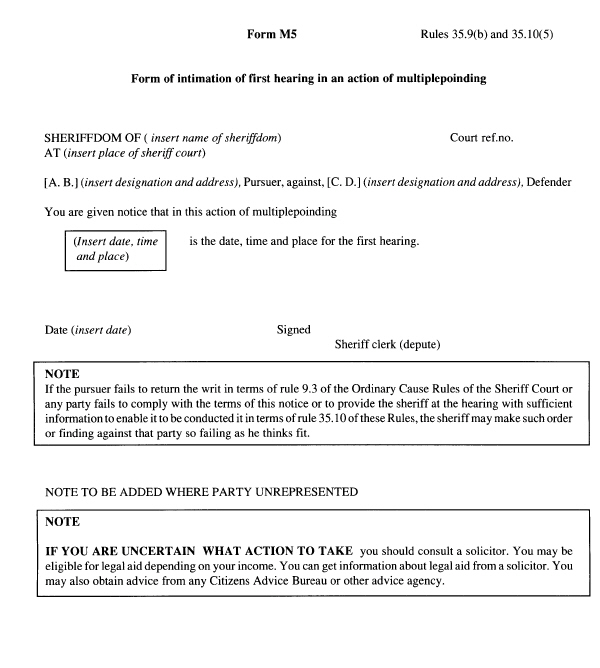
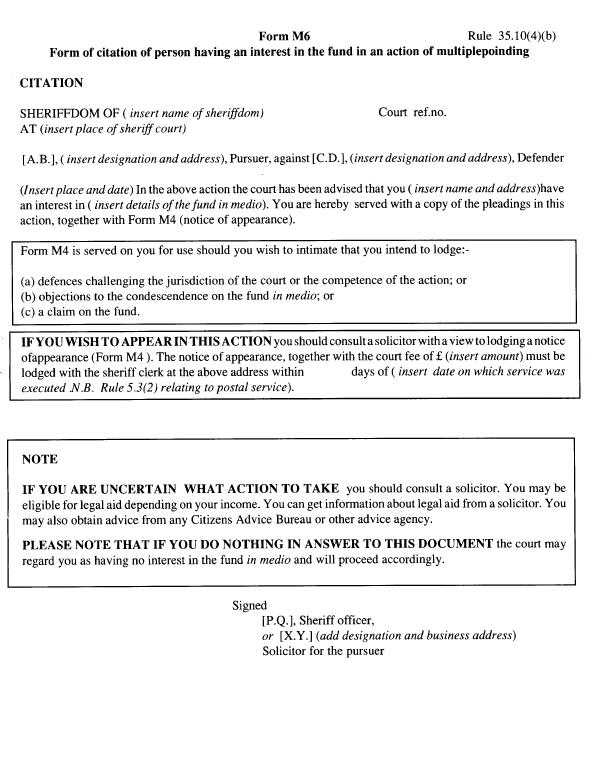
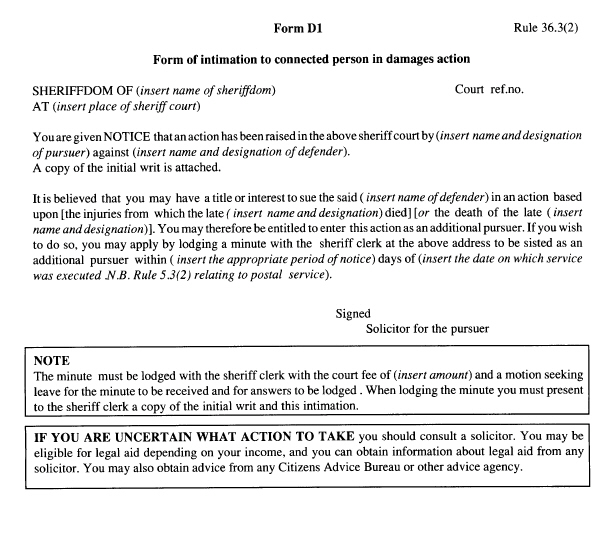
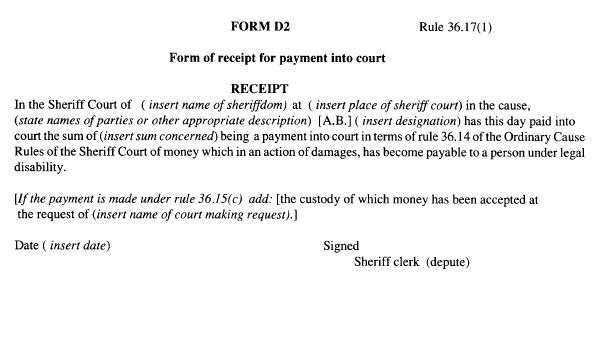
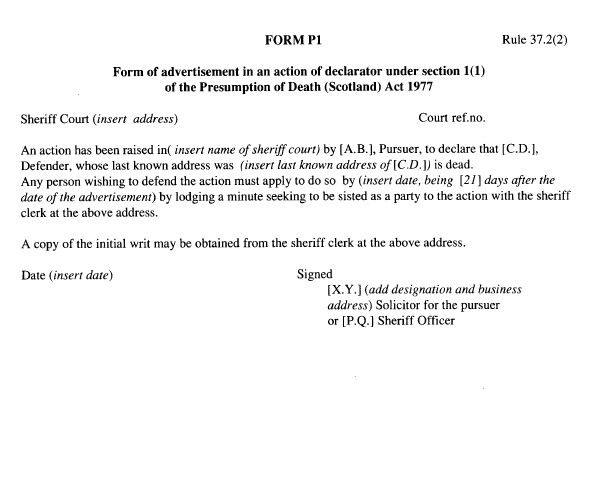
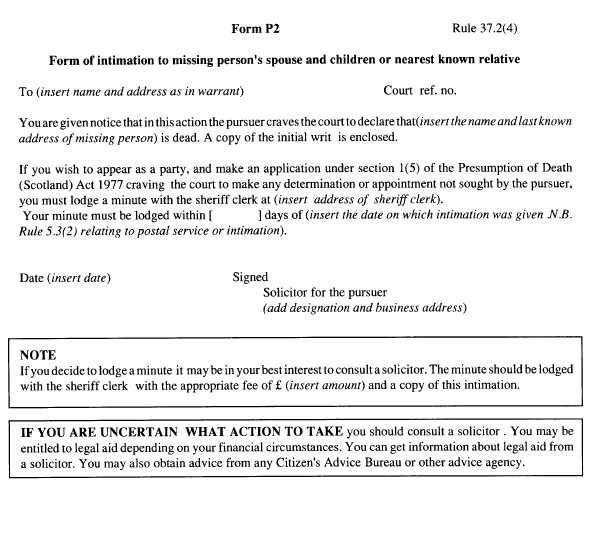
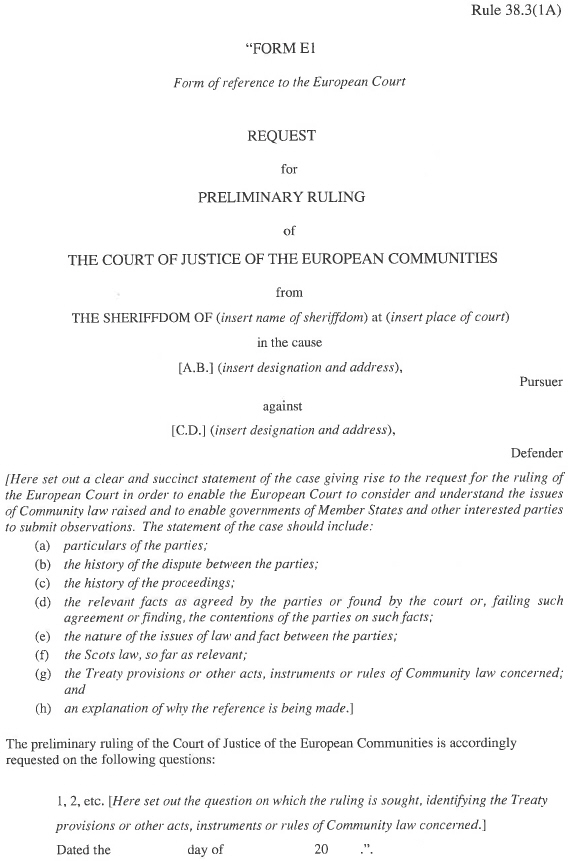
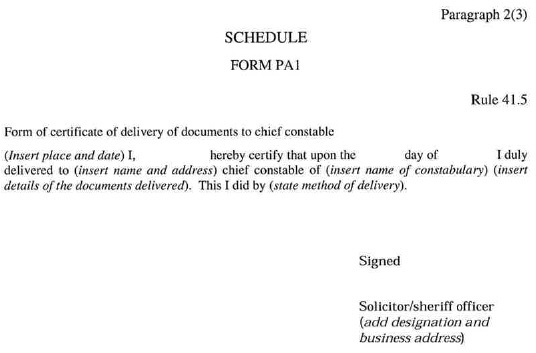
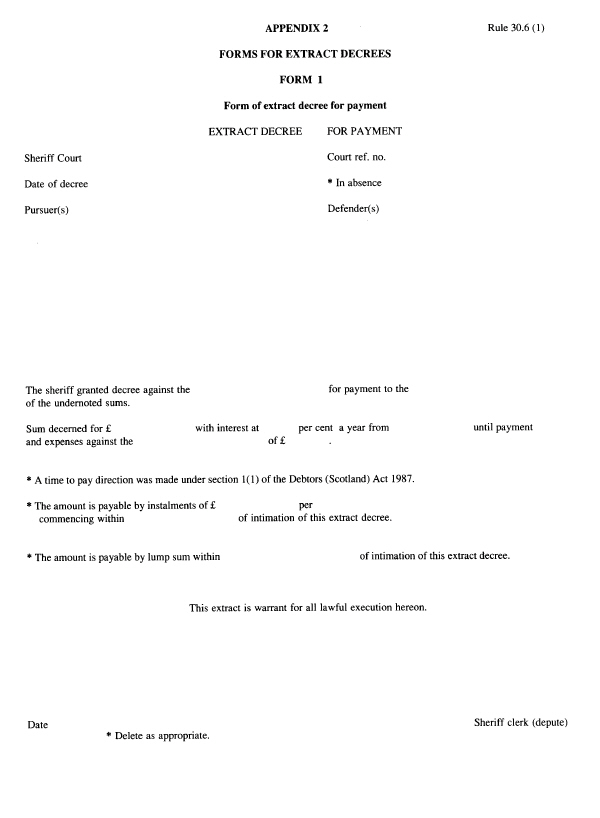
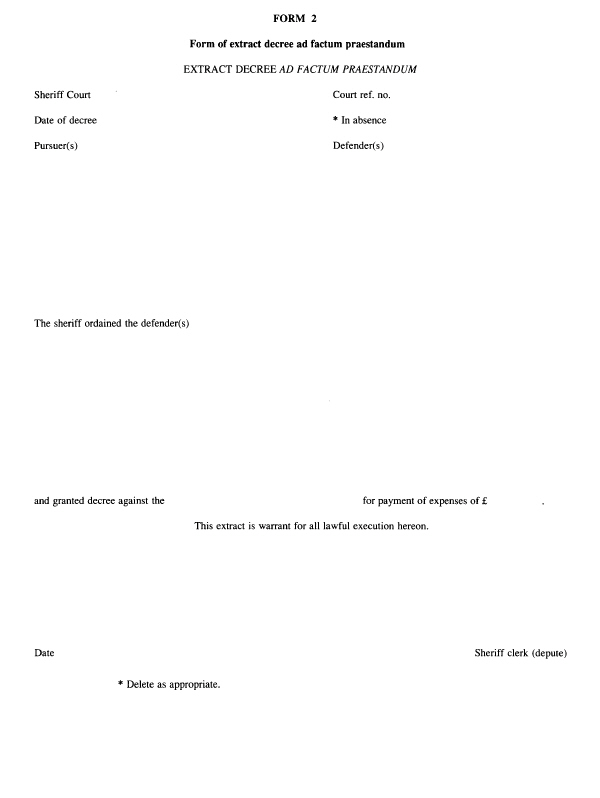
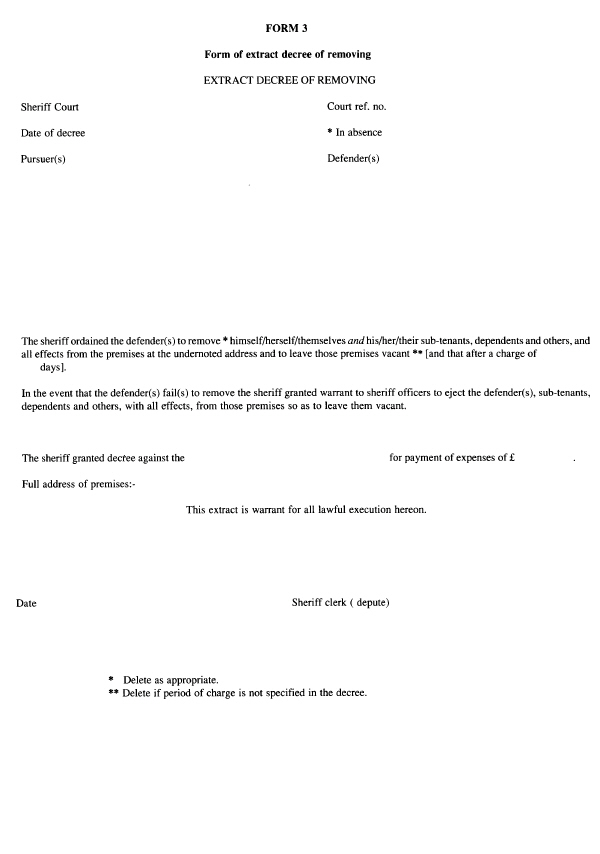
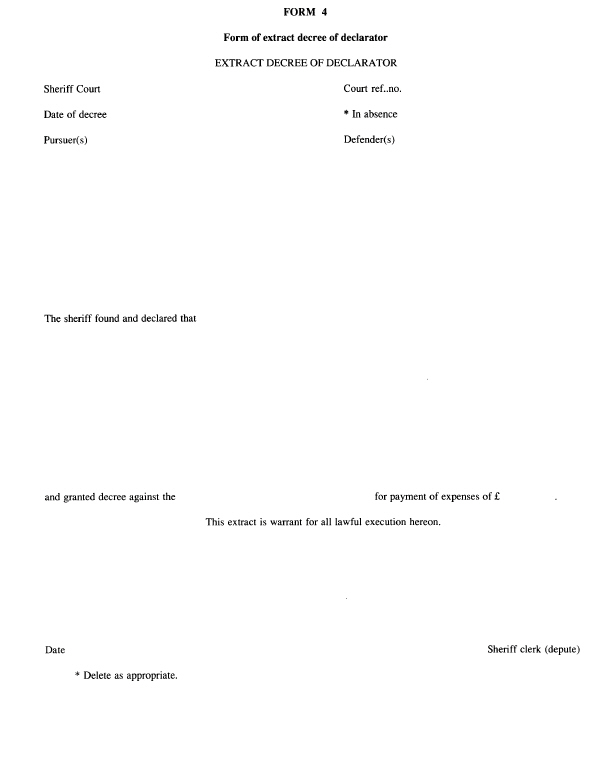
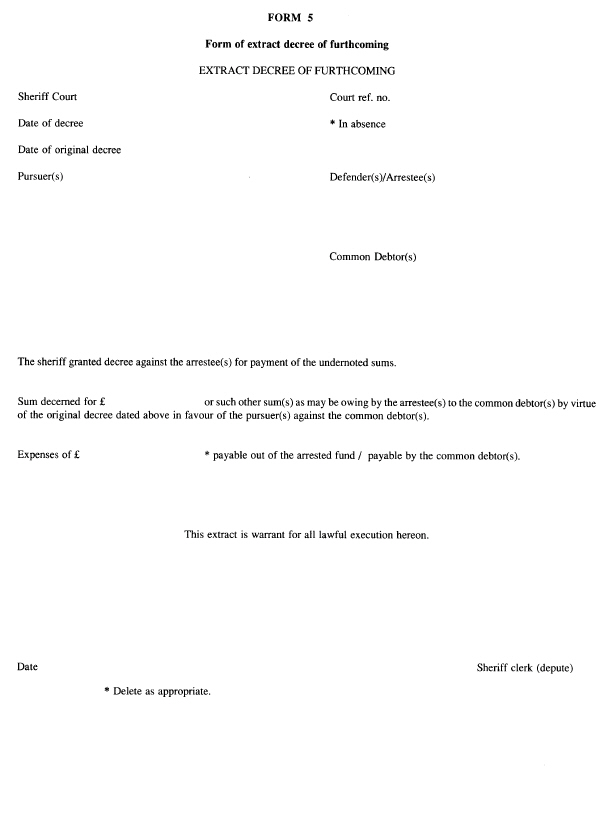
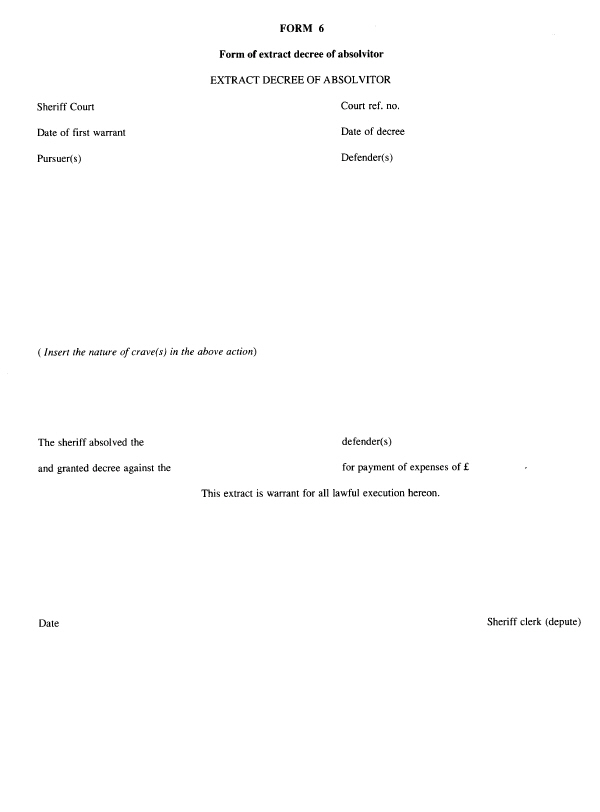
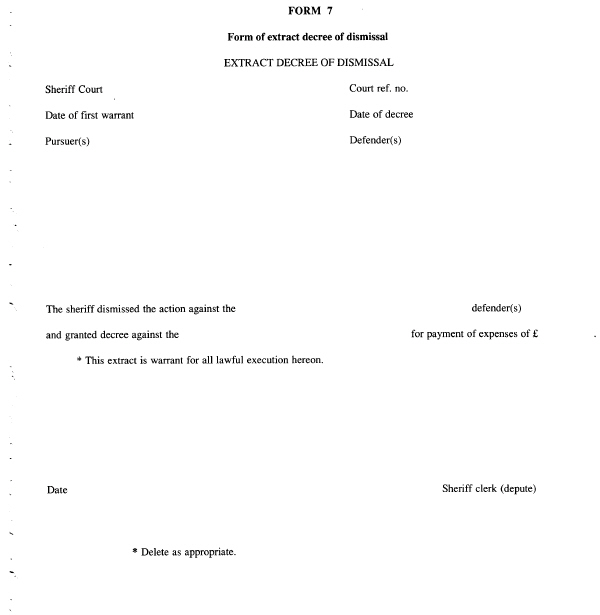
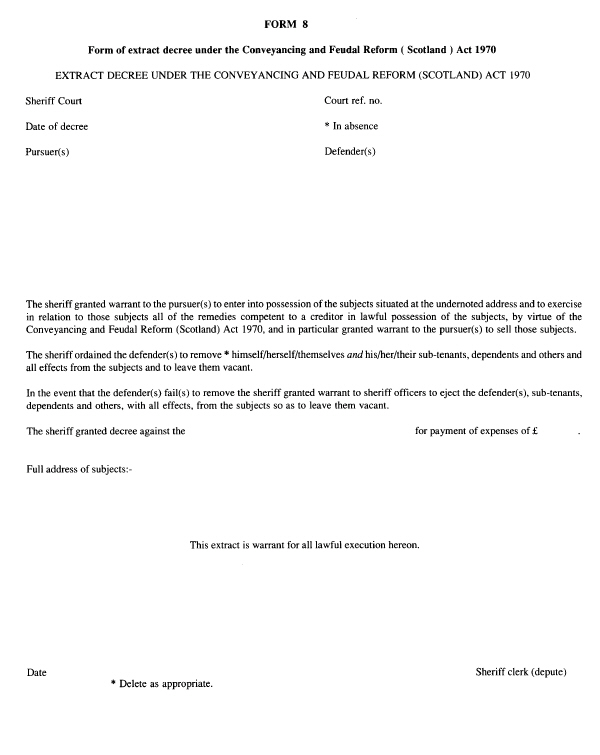
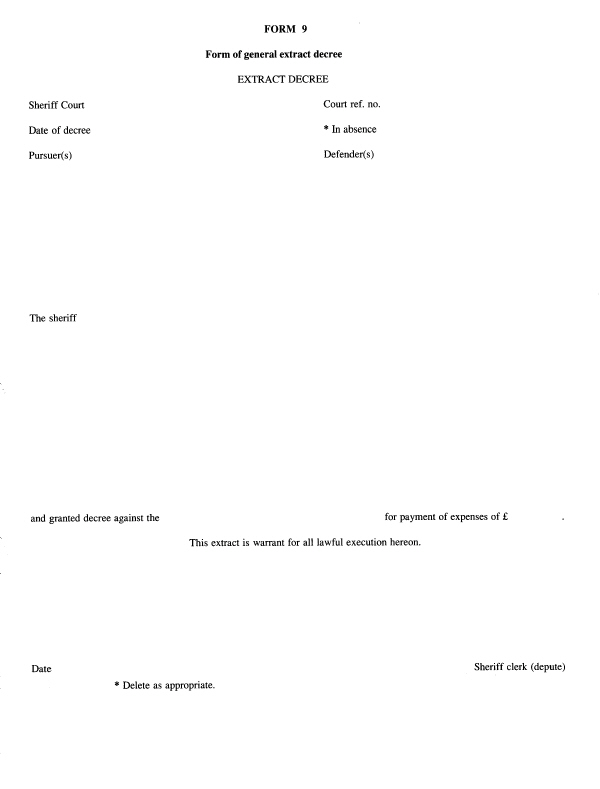
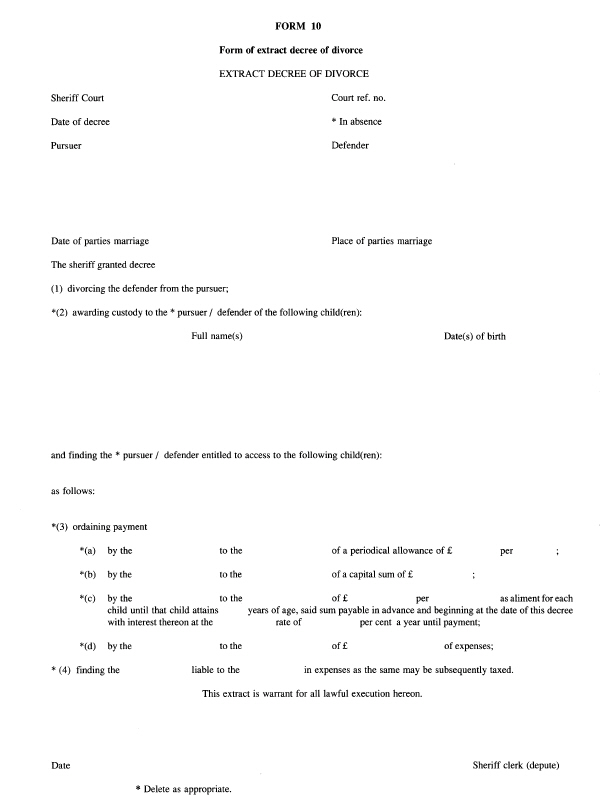
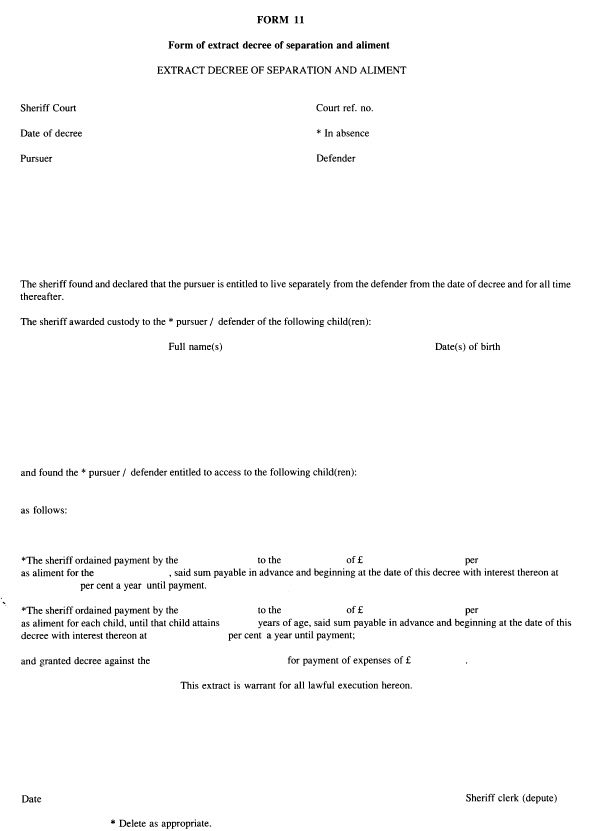
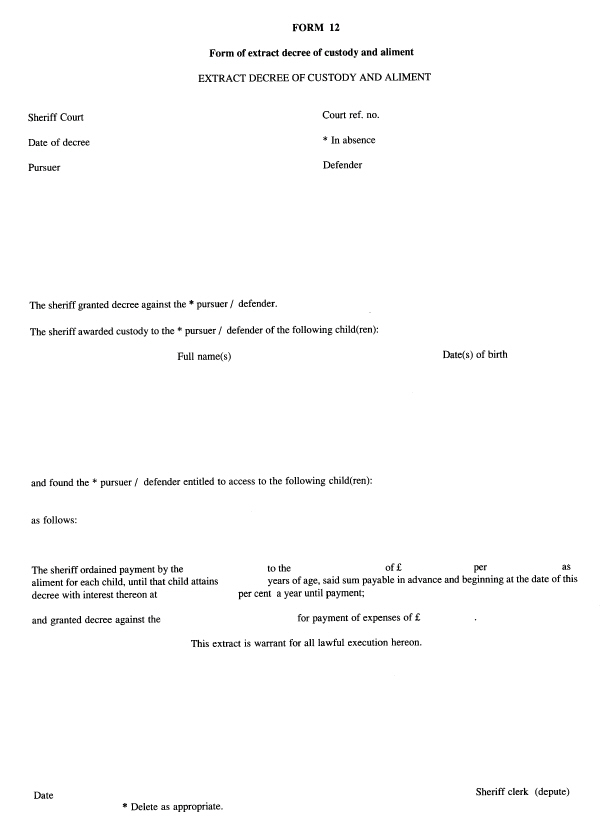
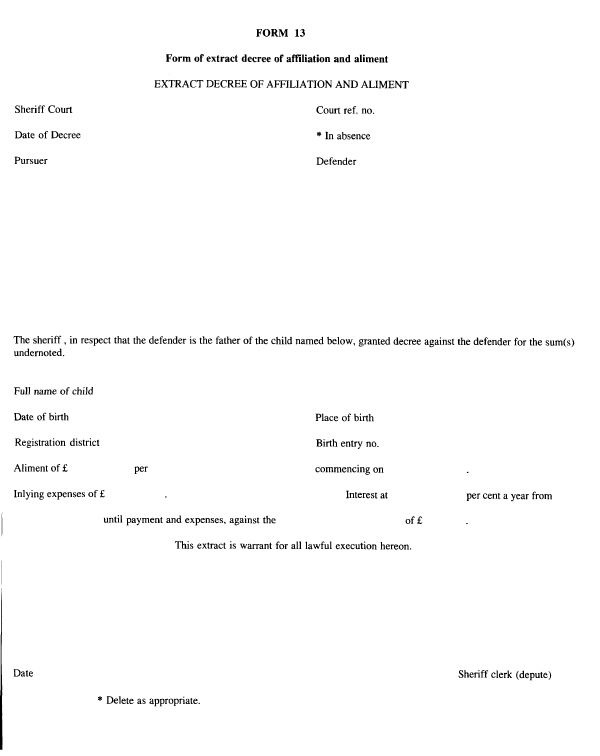
Sch. 1 (with appendices 1 and 2) substituted (1.1.1994) for Sch. 1 (with appendix) by S.I. 1993/1956, para. 2, Sch.1.
Sch. 1 (except rule 29.10) excluded (1.4.1997) by S.I. 1997/291, rule 3.24, Sch. 3
Sch. 1 extended (14.2.2000) by S.I. 2000/124, reg. 30(5)